For over thirty years Stanley Kubrick’s adaptation of “The Shining” has left perplexing questions in the minds of everyone who’s seen it; and time has been powerless to put this enigmatic movie out of our collective consciousness.
...............I hope you'll enjoy what I’ve written here.
. “The important thing is not to stop questioning” - Albert Einstein
Stanley Kubrick’s “Shining” was created with the sole purpose of leaving audiences searching for answers to a mystery that has no solution. After viewing it we end up scratching our heads over its unanswered questions and many unforgettable enigmatic images. But it’s what’s hidden in this movie that is truly fascinating. You’re going to find out that the most unbelievable aspect of “The Shining” is what you didn’t notice, right there on the screen. And it’s what you didn't notice that’s important. Everyone expects strange things to happen in a horror story but nothing like what I’m about to show you in this article has ever been seen to this extent in a movie before. It’s similar to the clues to Paul’s death on Beatles albums and Pink Floyd’s “Dark Side of the Moon” synchronizing with The Wizard of Oz. Both are suspected but have never been admitted to by the artists, both were well hidden, and both were discovered by fans. What’s different here is that most viewers never knew or were even searching for clues to anything. Something is lurking beneath the surface of this masterpiece, hidden from our view. And Stanley Kubrick fools the audience into believing everything he tells us - without question. “The Shining” is truly a unique experience.
No one in filmmaking has ever done anything like this. Even with today’s CGI and any other nonsense they can come up with no audience has ever seen anything similar to what Stanley Kubrick hid under the radar in this film. There’s never been a more enigmatic movie experience than the “The Shining” and I’ve got an interesting story to tell. My journey started on a summer day in 2005 when I was indulging in a seemingly insane hobby; hunting for common visual errors, movie mistakes, in one of my favorite movies. But it wasn’t visual errors that I ended up finding. I had “one of those pivotal moments in life that unleashes a previously unimaginable chain of events”. A moment of sheer luck where I discovered much more than I ever bargained for. Discoveries that will change everything about how you view this movie, forever. Much more than one would think possible has been purposefully hidden in “The Shining” and the audience never realizes how Stanley Kubrick, just like any great magician, has our total attention in the palm of his hands. Directing our eyes to whatever spot on the screen he wishes. Everyone loves a great mystery and with some help knowing where to look it’ll become very obvious how much there is to notice, and how many cryptic secrets The Overlook hotel actually holds.
Many attempting to explain this film see things that aren’t there and wonder, why? I’m saying ‘look at it differently and see what you’ve missed’. If you’re trying to unravel the greatest enigma in film history you need to use a microscope, not a magnifying glass from a Cracker Jack’s box to look at it? In attempting to understand Stanley Kubrick’s “Shining” we have to separate fact from conjecture and two things must temper any discussion; what we know and what we don’t know. A theory is a supposition or a system of ideas intended to explain something based on general principles independent of the thing to be explained. There are a lot of "theories" about this movie but the key to everything that’s hidden here is in three things that are not "independent" of it. Three things we know that cannot be changed or disputed; 1) the images that Stanley Kubrick placed in his finished product, 2) the dialogue in the finished product, and 3) the exact way he used and altered Stephen King’s source novel to make it his own. I use all three in this blog and they can’t be altered, debated, or ignored. This is the starting point that must precede any attempt at explaining the mysteries held in this work. We start with what we know for sure and move forward, and this is what I’ve done.
I didn’t come up with what you’re going to be reading off the top of my head. I’ve used un-doctored pictures, correct dialogue and exact alterations of the source novel and for some there may be a certain frustration with not being able to change the unchangeable but they are what they are. Stanley Kubrick created it that way. All that’s needed is a little help knowing exactly where to look. What I’ll show you in this blog is not a theory, it’s simple and accurate observation. It’ll be clear to you after reading this that I work as well as think well "outside the box" but thanks to Stanley Kubrick’s intense perfectionism it's all there; unless you choose to ‘overlook’ what you don’t like. He placed everything needed to understand this film up there on the screen.
Did you ever notice in watching Stanley Kubrick’s “Shining” that you never hear any classic horror film noises? A door never squeaks, a window never slams, the floor never creaks, no chimes, elevators don’t clang, loud winds don’t howl through the halls blowing out candles. There’s never a moan or a ghostly whine and we never hear a clock tick; The Overlook never makes so much as a single sound. Yet because of this film everyone knows the name of the most famous haunted hotel in history. No shadows, no laughter, no crying either, and very little physical contact, Jack rarely touches Wendy throughout the entire movie. It’s a very different experience than what we’re used to! In this visually enigmatic masterpiece we’re left with many unanswered questions, some of which I'll attempt to shed new light on in this article.
... Is The Overlook as haunted as people think?
... Why does he want us to notice a certain set of numbers?
... Why was so much changed from Stephen King’s novel?
... What’s significant about cast members being filmed entirely in the ... reflection of a mirror?
... Why are there so many hard to notice items that visually
... disappear, re-appear, move around and change color
... throughout the movie?
... What's the significance in his use of color?
... Why did he place a crushed red VW in one scene?
... Which cast members actually have this very special supernatural
... ability to “Shine”?
... Where did Jack Torrance go in the end?
... Why so many hidden Indians?
... Why did he delete a scene at the end?
... And the biggest mystery of all, what are we being pointed to in
... the date at the end of the movie?
Stanley Kubrick brings ‘hidden in plain sight’ to a brand new level in "The Shining" and just like the reason for the extinction of the dinosaurs or the exact age and size of the universe, as new things are discovered old explanations that do not include these new discoveries don’t work anymore. He’s controlling what we're looking at and he’s also controlling the exact point where our eyes are focused on the screen. “The Shining” operates on more than one level as the director holds blatantly obvious tidbits in front of us to peek our curiosity then lets another hidden image, you may not have noticed, contain the real meaning. He wants us to enter a special room. A place that holds our deepest fears. Our own room 237, a place that frightens us to the core. He places the key in the door for us and turns it. All we need to do is walk in. It’s like experiencing a Jackson Pollock masterpiece. On the surface it appears to be simple paint splatter, “just the story of one man’s family quietly going insane together” but if you look closer “The Shining” becomes a cinematic maze of hidden clues and purposeful visual anomalies just begging to be discovered by viewers. It’s an exercise in visual manipulation by the master that eventually leads us to a mystery outside of the movie itself. I’m no sycophant but I find Stanley Kubrick’s “Shining” intriguing and I’m going to attempt to show you just how great a genius Kubrick was. So be warned. Sounding a lot like Jack, “You got a big surprise coming to you.” If you read this to the end you’ll never be able to look at this movie the same way again as I've written one of the most in-depth visual studies on "The Shining" that has ever been done, and I've included almost 500 pictures to back it up. Turn back now or you may discover how brutally easy it was for Stanley Kubrick to fool us.
Can you imagine what it would be like if the audience were able to watch "The Shining" and then leave comments for Stanley Kubrick to look at? I like reading the comments people leave at the end of this blog but it seems that most people skim and don’t really understand the point I’m trying to get across. I’ve tried to present all this in an easy to read fashion. But my problem was that I discovered just about everything you’re going to read at different times. The hardest job was tying everything together and attempting to present it in a logical sequence. Unfortunately many things are mentioned several times. One thing I think we all can agree on is that Stanley Kubrick didn’t explain his movies, he leaves that up to you. At first I was a little perplexed because the pictures from the film and alterations he made to the novel are so obvious but I still get nonsensical comments posted. Then I heard something on the news that made me feel a little better; a third of those polled don’t believe that global warming exists and almost fifty percent don’t believe its cause has anything to do with the human race. At his first trial almost a third of people polled believed that O.J. was actually innocent. “Oswald's Tale: An American Mystery” By Norman Mailer is an excellent book, but if you believe in an assassination conspiracy you probably won’t agree with his assumptions no matter what he proves in it. Showing what’s obvious really means nothing, as some will not alter their beliefs even when proof of the opposite is right in front of them. Challenging a person’s core belief system is almost impossible. I’ve discovered in writing about “The Shining” that people who love this movie and have no agenda are fascinated by what I’m going to show you. But if someone has strong beliefs about this film and my proofs don’t fit with their particular ‘theory’ they’ll probably try and trash me and what I’ve written (but at least we can all agree on one thing; Pluto should be reinstated as a planet again).
This was a massive undertaking on my part and as the blog grew I had an increasing problem finding certain ideas that I had written. So I recently added this; you can click here and take a peek at my Frequently Asked Questions / Resource Page. It’s a topical table of contents in question form. But if you jump around to much you’ll miss a lot and things will not make sense. In an attempt to make this an interesting read as much information as I could is crammed into the first few paragraphs of each section.
I could never have done this without Google, word searches and our computer. I’m not sure if this is a good thing though. In our new age they’ll be no more Beatles, no more Kubrick’s. The age of genius like theirs is over. We live in the era of reality TV where inability rules and rock stars have to be spoon fed to us on American Idol. A show where the writers and performers of the original music the contestants sing could probably never get past the first auditions. In the future there may be no more than 15 seconds of fame, with just a computer terminal linking everyone; shrinking all our minds together into one.
With the photos I’ve included I'll attempt to bring you inside this fascinating movie in a way you've never experienced a film before. They're from my Warner Brothers DVD. I also add many interesting links; Here’s a classic British TV commercial for “The Shining” that aired in 1980. And for the perfect background ambience as you read just open this blog in two browser windows and click on the Music Link in the second window at the end of each section for a You Tube link to the great music from “The Shining”.
................................Music
And now “What You May (or may not) Have Seen
................Hidden In The Shining”.
Where Are The Special Numbers Stanley Kubrick Wants Us to Notice?
............."I see it, but I don't believe it" - Georg Cantor
It wasn’t just a room number (217 in the novel becoming 237 in the film) that Stanley Kubrick altered, he changed almost every number mentioned in Stephen King’s novel and added quite a few of his own – for no apparent reason.
I saw “The Shining” in it’s first theatrical run in 1980 and I’ve loved it ever since. My only minor criticism was that I felt the final chase scene didn’t look real enough. The sprayed on snow and well above freezing temperatures noticeable in their breath were a distraction to me. That aside it’s been one of my all-time favorite moves ever since. But I never imagined I would be writing about something trivial that I noticed in 1980 and remembered in the back of my mind ever since. Stanley Kubrick may have somehow done something to us here. I went to a hypnotist once and in the last session he tried to plant a sneaky suggestion in my mind that I would return to him at a later date and I feel the same thing has been done to me with this film. Maybe some form of autosuggestion has been placed into our minds that draws us back to watch time and time again. It could have something to do with what I accidentally noticed on the screen. I remembered through the years that Danny wore 2 sweaters with numbers on them. Danny's sweater in the bathroom scene is obvious, number 42. But I remembered something else; a second sweater with the number 11 on it.
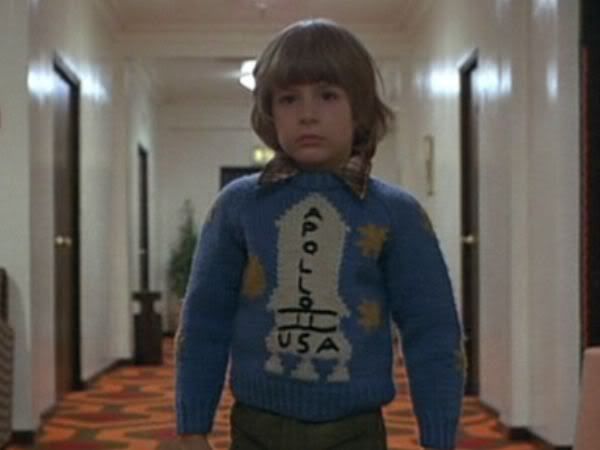
Few noticed this because it’s a mistake on my part caused by ADD. I’m always looking at something other than where the master illusionist wants me to be looking; it’s actually a design that’s made to look like the number 11 but had I not made this little mistake in 1980 you wouldn’t be reading this today.
I decided to start my blog out with the numbers, as he made certain ones so easy to spot, and I will tell you ahead of time that I believe Stanley Kubrick wants us to notice these numbers. The end of this blog is littered with the comments of those who do not agree but they will never convince me they aren't there on purpose (and interested posters are continuously finding new ones). What he's done is just to obvious and when you look at the 42 on Danny's sweater,

than look at them watching “Summer of 42” on the TV,

and think of Jack’s line in the beginning of the movie, “See, it's okay. He saw it all on the television.” It’s obvious that Stanley Kubrick is gently whispering something in our ears. Just look at your moving index finger and say this in a voice like Tony, “There’s something in the numbers Mrs. Torrance, did you notice?" The same ones keep popping up, over, and over, and over. Readers of the novel notice and comment on the biggest departures Stanley Kubrick chose to make in the movie. Changing the topiary into a hedge maze, a Roque mallet into an ax, one boiler into two, Dick Hallorann’s death, etc. A less obvious but nonetheless fascinating alteration is that almost all of the numbers mentioned in the novel are different in the movie. It’s not just the obvious one I mentioned before, Room 217 changing to Room 237. Most have been changed for no apparent reason. Stanley Kubrick points us to the same set of mysterious numbers, beckoning us to notice them. People comment a lot about what I’m going to show you but there are 2 camps when it comes to seeing them. For me there are just too many instances where they pop up and they’re way to obvious. When I point them out you’ll either believe it or you won’t. From the very first shot to the last, Stanley Kubrick includes far too many obvious references to the same special numbers to be just a coincidence. Everywhere you look in the major scenes of the film through casual observation or simple math the same set of numbers turn up in some fashion. 12, 24 their inverted images 21, 42 and component numbers can be easily spotted in character actions, sounds, dates, props, possessions, time codes, durations of shots and scenes, and even the music we hear. Again many have been changed from what they were in Stephen King’s novel for no apparent reason.
I’ve looked at and noted major occurrences in the movie and this doesn’t mean other numbers can’t be found in actions and props. What I’m saying is, it’s clear Stanley Kubrick wants us to notice these specific numbers and knowing this led me to the last shot of the movie, and what I believe is part of it’s explanation.
Where are some of the most obvious occurrences of the numbers Stanley Kubrick wants us to notice?
Where are some of the most obvious occurrences of the numbers Stanley Kubrick wants us to notice?
12
There is only one enigmatic room in the movie that Danny isn't supposed to go into, Room 237, and its individual numbers add up to 12.

The Overlook has only one call number; it's KDK 12 (“KDK 12 calling KDK 1”).
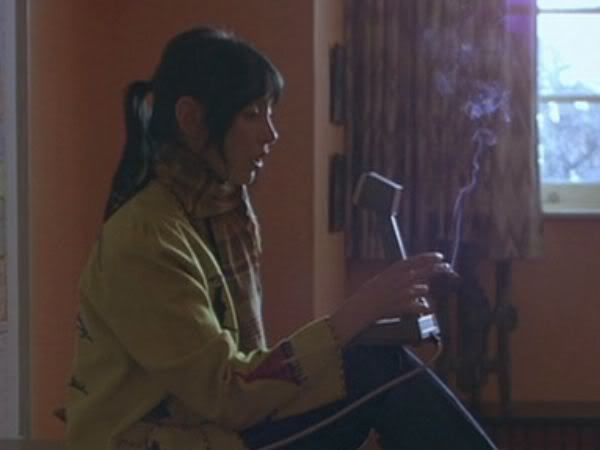
There is only one set of bloody elevators and they're always stopped on floor 1 and 2.
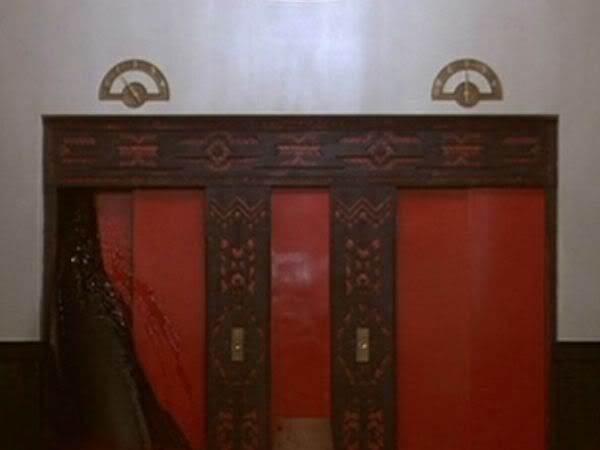
Only two times are given in the movie's black frames, add them together (8 + 4) and you get 12.
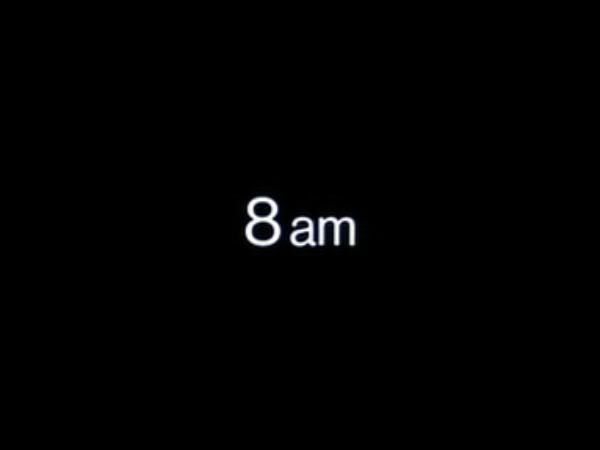

There's only one song playing over the final credits and it's "Midnight, The Stars and You" by The Ray Noble Band.
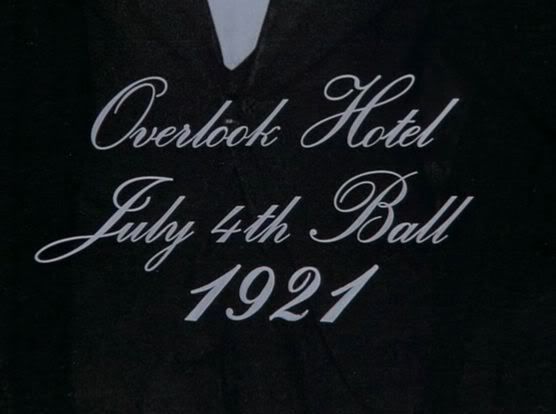
....and Stanley Kubrick doubled only one name from Stephen King's novel, Grady. In the movie he has 2 names and they both contain the same number of letters; Charles Grady = 12 Letters and Delbert Grady = 12 Letters.
21
There's only one enigmatic final shot in the film and there are 21 pictures on the wall with a 21 in the date and a :21 in the time code. And as a very astute anonymous poster noted there are 2 candles and 1 shadow visible on the wall.
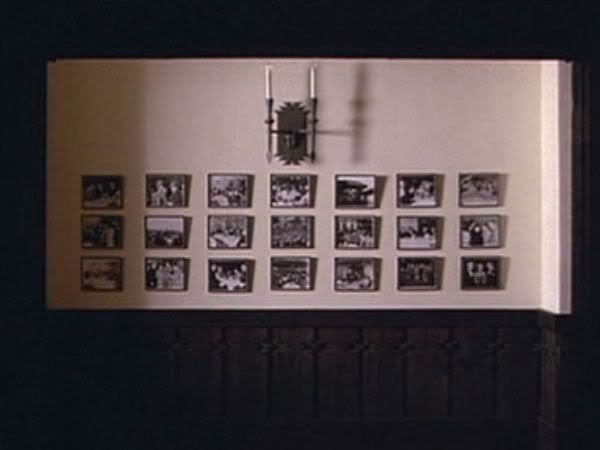
Jack only works on one novel and Wendy stops at line 21 as she pulls the page out of the carriage of his typewriter. When she first spots it, we hear her thumb through 24 pages of the novel in the box.
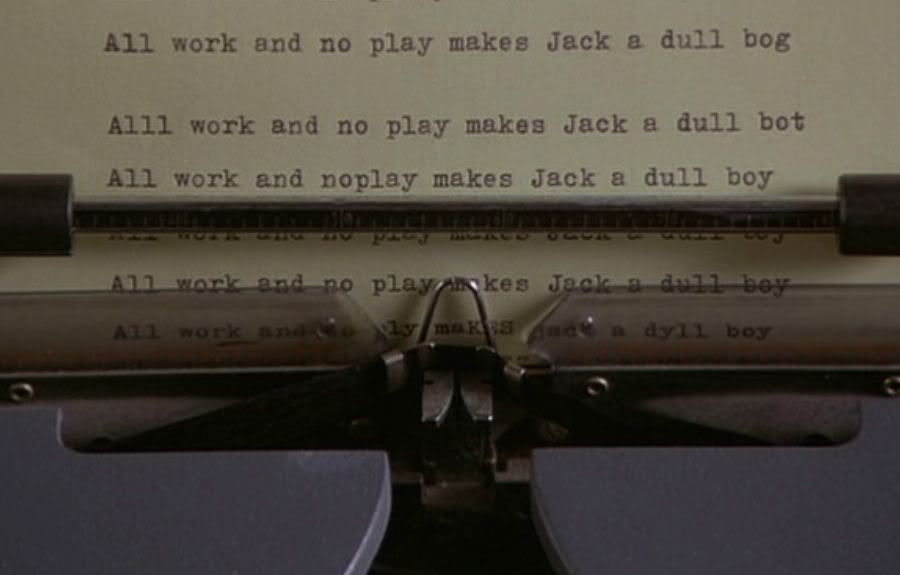
The money shot in the Hedge Maze is when Danny fools Jack and there are 21 full footprints in the snow in this scene.
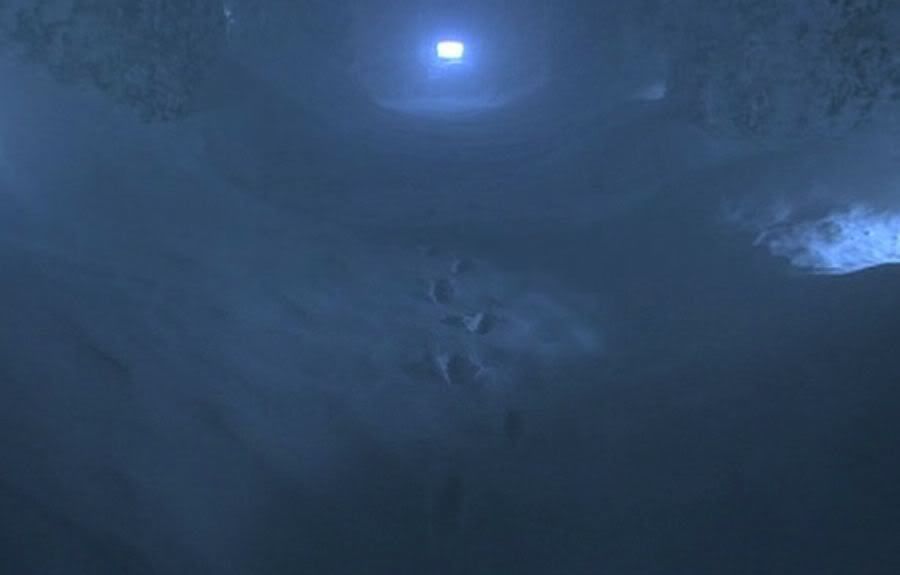
... And as Trevor an astute commenter noticed, there are 21 pieces of mail behind the receptionist when Jack walks into The Overlook for the first time.

24
There's only one mysterious date in "The Shining" and the numbers of that date 7/4/1921 added together equals 24.

There's only one master staircase in The Overlook's Colorado Lounge where Wendy clobbers Jack, and counting the platform which is also a large step there are a total of 24 steps to the top of it and 6 steps on each side.
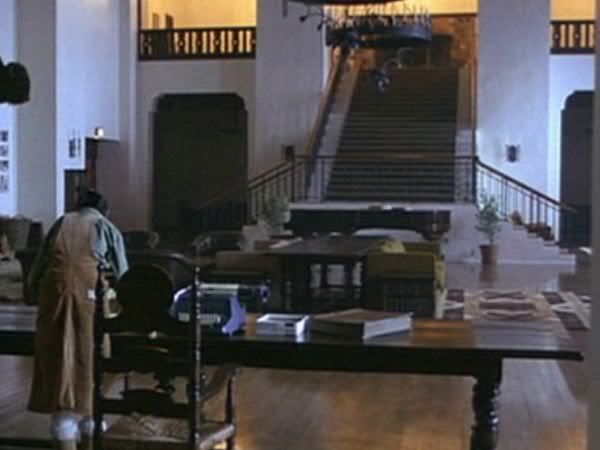
Wendy pulls on the storeroom latch 24 times.
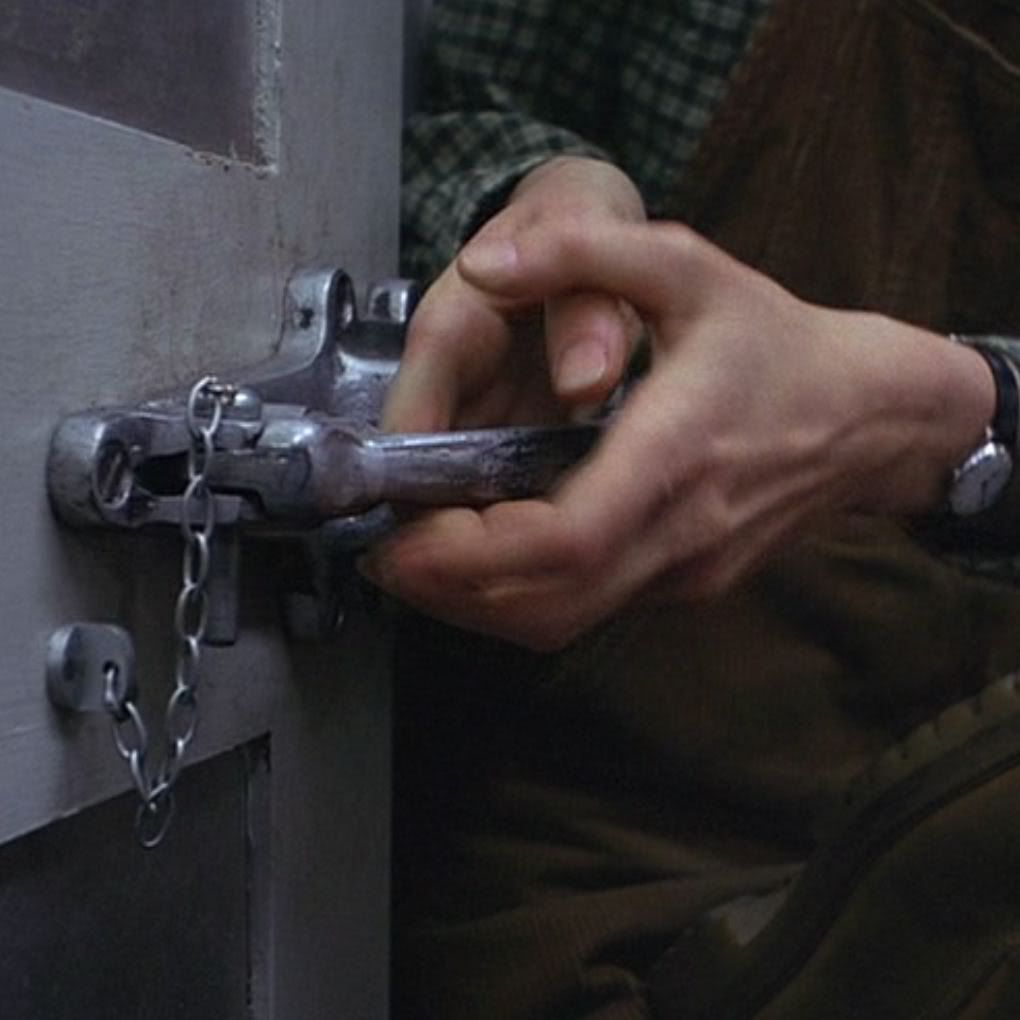
Danny’s first vision of the blood coming out of the elevator happens only once and it's exactly :24 seconds long, to the frame.
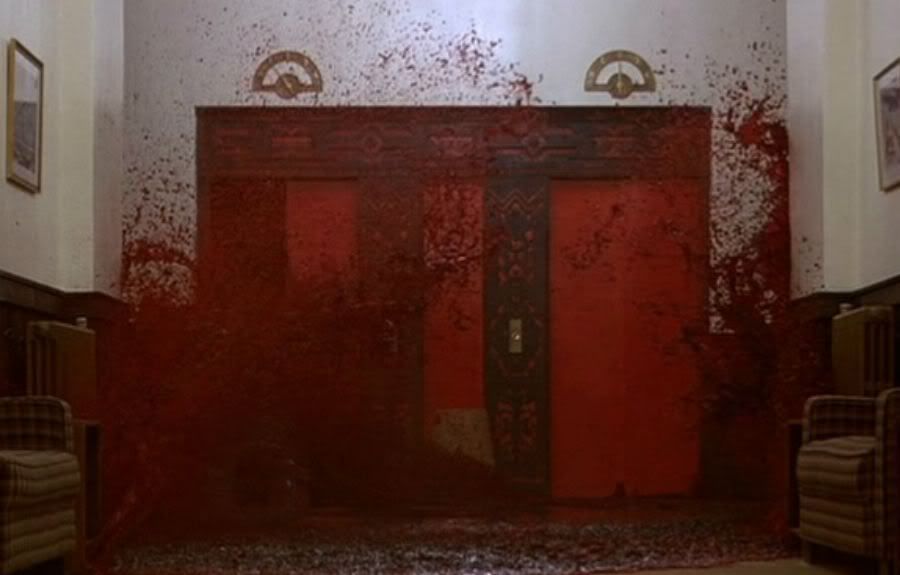
42
Room 2 x 3 x 7 = 42.
There's only one recognizable movie clip we see and it's from the “Summer of 42”. It also just happens to be the scene at :24 minutes into that movie.

Danny wears the number 42 once on his T-shirt in their bathroom.

Jack breaks down their apartment door with his ax only once and it takes him exactly :42 seconds, from first frame to last to do it (when we see him first hit it with the ax to when he pulls the ax out before opening the door). We also hear Jack hit the bathroom door 12 times with his ax.
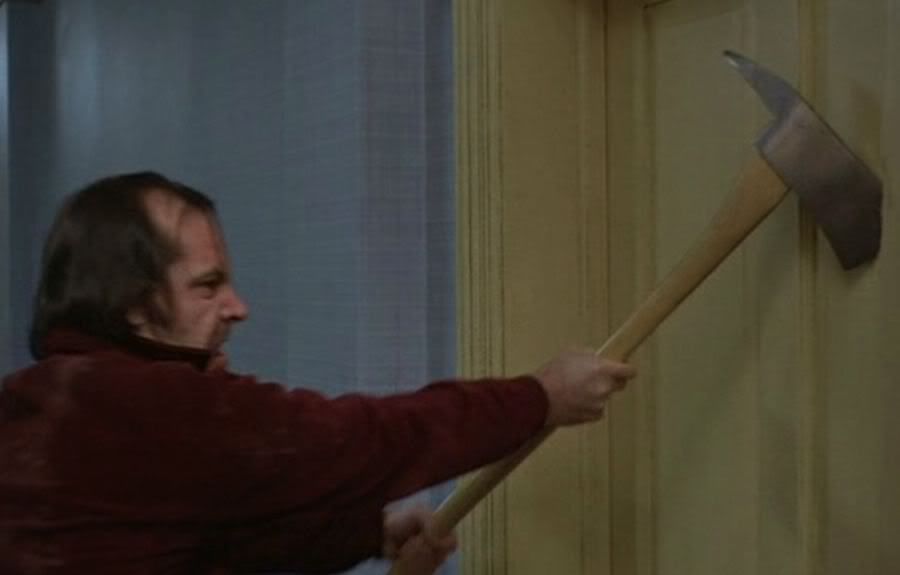
And don't forget Stanley Kubrick edited it so that Wendy swings the bat 42 times. With the first swing being in this shot right after Jack says, "How do you like it".
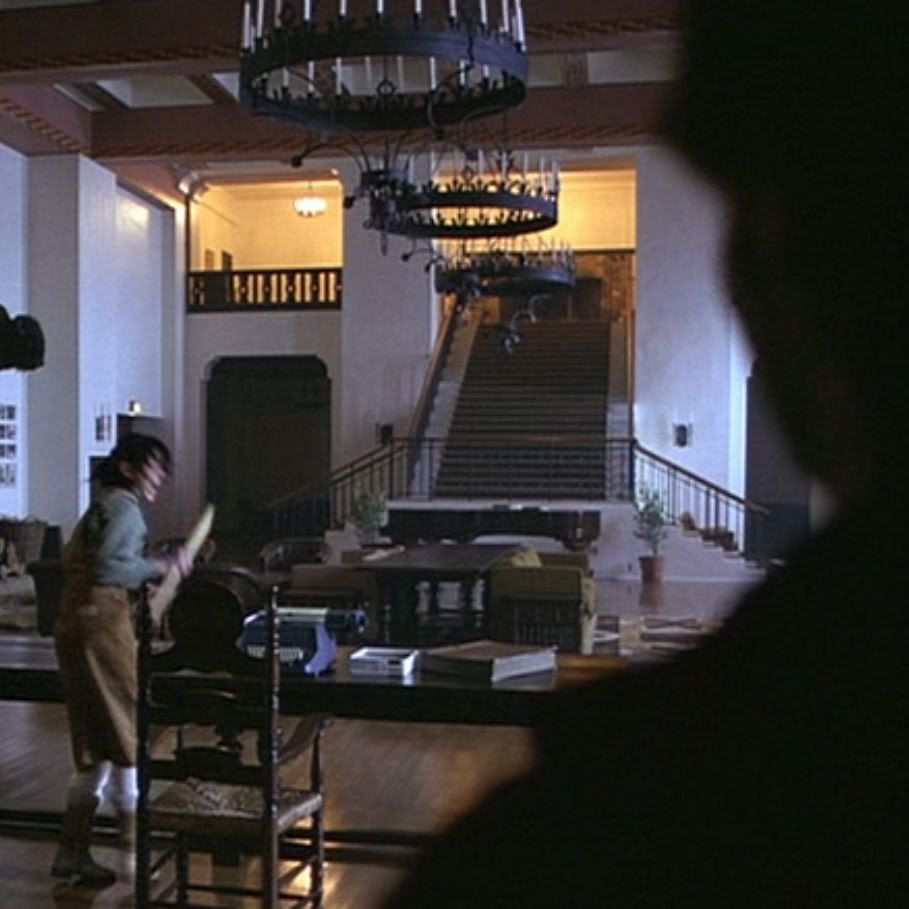
Why in the credits did Stanley Kubrick place 21 double letters in the cast’s names?
The movie was created and edited this way and Stanley Kubrick did it for a reason. All these things happen only once; one room Danny's not supposed to go into, one recognizable movie clip, one doubled name from Stephen King's novel. One mysterious date, one set of bloody elevators, one song playing over the final credits. There’s only one master staircase in The Overlook's Colorado Lounge, one novel Jack works on and one time that Wendy reads it, one set of call numbers. And Jack breaks down their apartment door only once. These are all major scenes in the movie and the same set of numbers keep popping up where probability tells us they shouldn't. You're not seeing things. Like the 21 pictures in the last shot and the year in the date having the same number in it, 1921, and the time code on your DVD player indicating 2 hours and 21 minutes. But if you're skeptical explain this from the credits? It's the most famous deleted scene in movie history; the mysterious deleted hospital scene at the end of "The Shining". We would never know anything about this important scene if it weren’t for the movie’s credits. I'm not exaggerating, it’s quite possibly the most famous deleted scene in movie history as it was part of the finished work and was actually shown to audiences for a few days before being excised from the film by Stanley Kubrick. How many other deleted scenes were taken out after the theatrical release of a film? What’s a little odd is the names of the cast members from that final deleted scene are still shown at the end of the movie. Considering Stanley Kubrick is one of the most renowned perfectionists in the history of movie making, this is very sloppy indeed; unbelievably sloppy unless that deleted scene is actually an important and intentional part of the movie and we're supposed to notice it. Could it be because there were already 21 double letters in the cast’s names in the credits that he didn’t want to take the time to change? I don't think so. What other movie contains a deleted scene that becomes part of the folklore of the finished product (as all Kubrick aficionados know about it)? A perfectionist would die rather than have something like this obvious and horrendous movie mistake staring them in the face; "forever, and ever, and ever". You’ll have to forgive me for not taking everything in the "Shining" saga at face value but Stanley Kubrick knew exactly what he was doing. If he was contemplating the removal of that scene he would have also had a different set of credits ready to be inserted. He worked on the film for 5 years and had plenty of time to think about this problem. He also had plenty of eager help to do it for him. It’s the same as the numbers on Danny’s sweaters. He’s pointing us to something contained in the credits. He wants us to notice and think about the double letters (the 21 double letters) and ponder over just exactly what's contained in that now lost scene. It's all just another part of the show, something else for us to try and figure out. Deliberate and obvious. Some websites indicate that all the deleted scenes added together equal 3 minutes which would have made the running time of the story from the original final cut 2:24 rather than 2:21 in duration as it is now. Both durations still contain one of the numbers he wants us to notice. Look at how, for no apparent reason, (Larry) Durkin and (Bill) Watson's first names were left out of the credits yet the deleted actors names remain. He’s toying with us, beckoning anyone to notice these anomalies and wonder what it all means. He's almost hitting us over the head with them.
Jack To(rr)ance.................Jack Nicholson
Wendy To(rr)ance...............She(ll)ey Duva(ll)
Da(nn)y............................Da(nn)y (Ll)oyd
Ha(ll)ora(nn).....................Scatman Crothers
U(ll)man..........................Ba(rr)y Nelson
Grady..............................Philip Stone
(Ll)oyd............................Joe Turkel
Doctor.............................A(nn)e Jackson
Durkin.............................Tony Burton
Young woman in bath...........Lia Beldam
Old woman in bath..............Bi(ll)ie Gibson
Watson............................Ba(rr)y De(nn)en
Forest Ranger 1 .................David Baxt
Forest Ranger 2 ................Ma(nn)ing Redw(oo)d
Grady Daughter.................Lisa Burns
Grady Daughter.................Louise Burns
Nurse.............................Robin Pa(pp)as
Secretary........................Alison Coleridge
Policeman.......................Burne(ll) Tucker
Stewarde(ss)....................Jana Sheldon
Receptionist.....................Kate Phelps
Injured guest ...................Norman Gay
Skeptics think this all had to have happened by chance. But there’s much more than just the cast member’s names. There are other numerical anomalies. He didn't just do this to the names in the credits. Look at some of the items that Stanley Kubrick doubled from Stephen King's novel for no apparent reason; 1 furnace becomes 2 furnaces, 1 elevator becomes 2 elevators, 1 typewriter becomes 2 typewriters, 1 Grady becomes 2 Grady’s, 1 woman in the bathroom becomes 2 women in the bathroom, 1 Overlook becomes 2 Overlooks, two unseen Grady sisters from the novel (aged 8 and 10) become twins that appear to Danny. Also all the children have 2 years added to their ages; Danny is 5 years old in the novel and becomes 7 years old in the movie, Grady’s girls are 6 and 8 in the novel and they become 8 and 10 in the movie. I talk much more about doubling in "The Shining" in this later section, "What Do Delbert Grady and Danny's Friend Tony Have in common?". Clues are in just about anything you can imagine and almost everywhere you look. He's doing everything except belting us over the head with them.
To look at more examples of how these numbers show up in the movie click here.
Where are some examples of how Stanley Kubrick edited “The Shining” so that specific scenes would have specific time codes?
I've shown major and important images from "The Shining" but what's happening visually is just the tip of an iceberg. You may think this is nothing more than playfulness on Stanley Kubrick’s part but there’s something else that you could never possibly perceive while enjoying this masterpiece. It's what you can't see, what's invisible, that's truly amazing. They must be important, because for some reason the same set of numbers have been invisibly embedded into the very structure of the film. The four things I'm going to bring up now are absolute proof that Stanley Kubrick edited "The Shining" so that the time codes and the positioning of specific shots would come out in precise ways. I’ll show them now but discuss them in detail later in more pertinent sections.
1) The 4 shots filmed in the reflection of a mirror have specific numerical time codes that include this same set of numbers - 11, 11+24, 11+42, and 11+1:10 which are also found on Danny’s sweaters (remember that we see an 11, another double, on Danny's Apollo sweater). I discuss these 4 shots in the section, "The Significance of Mirror Shots".
2) The shot when Jack gulps down his drink in front of Lloyd has a specific numerical time code of 666 (66 minutes and 6 seconds into the film) and I'll discuss it in this section, "What Happened To Jack At The End Of The Movie?"
3) The shot of Jack entering room 237 has a specific time code that places it exactly half way between the beginning and the end of the story. I'll discuss it later in this section and also in the section, "Is The Overlook Haunted or does it "Shine"?".
4) The 2 words filmed in the reflection of Wendy’s mirror (the words murder and Stovington both seen in reverse) have specific time codes and among other times we also see them exactly one quarter of the way from the beginning and three quarters of the way from the end of the story. I’ll discuss these later in this section, “The Significance of the Mirror Shots”.
In the US DVD version Stanley Kubrick has the same numbers we see on Danny's sweaters, dates, and room keys pop up in the time codes of major shots in the movie. In each instance when the time code hits :12 or :21 minutes someone sees a vision and all have a duration of exactly to the second of :12 or :24 seconds. In each instance when the time code hits :24 or :42 minutes a cast member comes to a pivotal spot where they make an important discovery and each has a duration of exactly to the second of :12, :21, or :24 seconds.
Where are some examples of how Stanley Kubrick edited “The Shining” so that certain shots would have a specific elapsed time?
Having so many major shots precisely timed out to the second (and having durations of the same peculiar numbers :12, :21, :24, or :42) cannot happen by chance. The odds of 4 individual shots filmed in the reflection of a mirror (that I will talk about in a later section) having the same number also included in each of their time codes are astronomical (more than 141 cubed). Its obvious; we’re being pointed to these numbers throughout the movie on Danny’s sweatshirt, room numbers, movie tiles, dates, etc. Time codes are only half of what’s going on here. Look at how the numbers figure in each time, not only in the time code but also in long durations of scenes or short durations of individual shots (the odds of this happening by chance are astronomical). "The Shining" is Stanley Kubrick's mathematical maze. He edited it so it would come out that way.
00:12 minutes into the film. The end of Danny’s first vision of the blood coming out of the elevator (exactly :24 seconds in duration from when he sees it to the last bit of blood).

00:21 minutes into the film. “Kids can scare you to death.” Danny’s first vision of the two girls from when we see them to when they go out of his view (exactly :24 seconds in duration).

1:12 minutes into the film. Jack’s first and only vision of the woman in the bathroom. From seeing the tub to when he slams the door of room 237 (exactly 3:24 minutes in duration).

1:21 minutes into the film. Jack’s vision of balloons during the party (exactly :24 seconds from when he first sees the balloons, and they are in our view for exactly :12 seconds).

2:12 minutes into the film. Wendy's vision of the old bloodied gentleman saying, “Great party, isn’t it” (exactly :12 seconds in duration).

2:21 minutes into the film. The very last and most perplexing vision in the whole movie “Overlook Hotel July 4th Ball 1921”. Where there is an interesting problem, as everyone with the ability to see visions is either dead or has left the building (exactly :24 seconds in duration).

00:24 minutes into the film. Jack discovers the Gold Room for the first time (exactly 1:24 minutes in duration).

00:42 minutes into the film. Danny turns the doorknob as he discovers room 237 (when he looks up and we see the door to the end of the scene exactly 1:12 minutes).

1:24 minutes into the film. The Party scene when Jack meets Delbert Grady for the first time (the entire scene lasts exactly 9:21 minutes).

1:42 minutes into the film. The first time Wendy discovers what's in Jack’s novel (exactly :24 seconds from when we first see “All work and no play makes Jack a dull boy” to when she looks at the entire novel in the box).

Precise time codes of major shots ending in the same set of numbers like these do not occur by chance. Here's more proof that Stanley Kubrick has edited scenes so that time codes come out as precise numbers. At first I didn’t read Stephen King’s novel but listened to it on my I-Pod and the spot where Danny enters room 217 is almost exactly at the halfway point of the story Chapter 25 (Page 148). In the movie the opposite happens as now Jack enters room 237 at precisely the same spot, 1:11, exactly at the halfway point of the movie and this happened because Stanley Kubrick edited the movie so that the first half is a mirror image of the second half.

At exactly one quarter into the film, :35 minutes, we see Jack’s reflection in Wendy’s bedroom mirror and the word “Stovington” is inverted on his shirt.
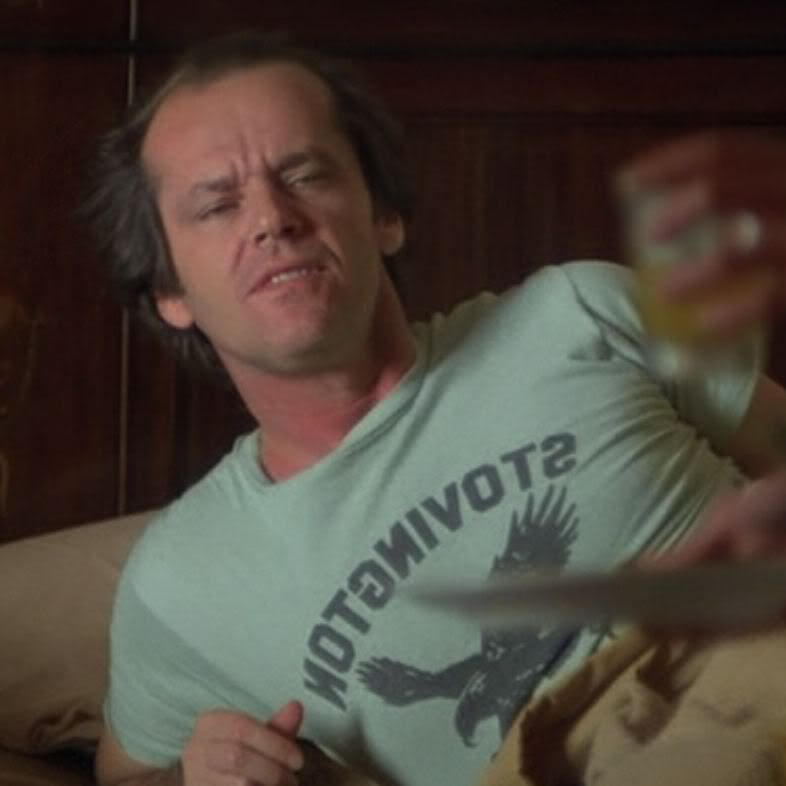
Than at exactly three quarters through the film, 1:45 minutes :35 minutes from the end, Tony sees another inverted word, “Redrum” for the first time in a vision.
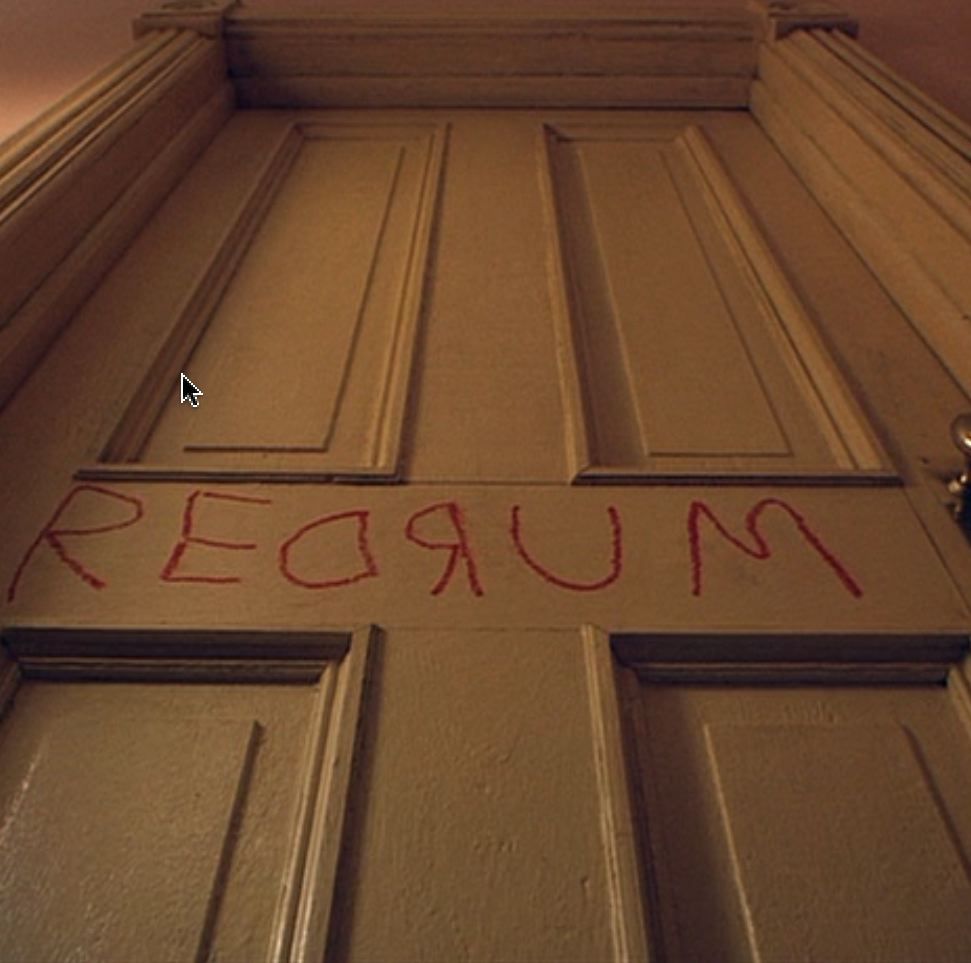
Is there any outside proof that Stanley Kubrick planed a numerical substructure in “The Shining”?
It would be ludicrous to entertain any idea that Stanley Kubrick would never hide numerical clues (or anything else) in one of his movies. I get a lot of negative comments about this but how could anyone possibly know something like this, and if you do please enlighten me at the end of this blog? I watched the movie “Stanley Kubrick: A Life In Pictures” and they show something interesting; the first page of his copy of the script and we see 2 examples of how he was thinking about embedding Stephen King’s room number 217 somewhere in the movie. Among several other numbers on the cover he prints these that were never used, “Their address - 217 N. Elm”, and “Feb 17, 2/17”. This is more proof. The point I’ve made is obvious.
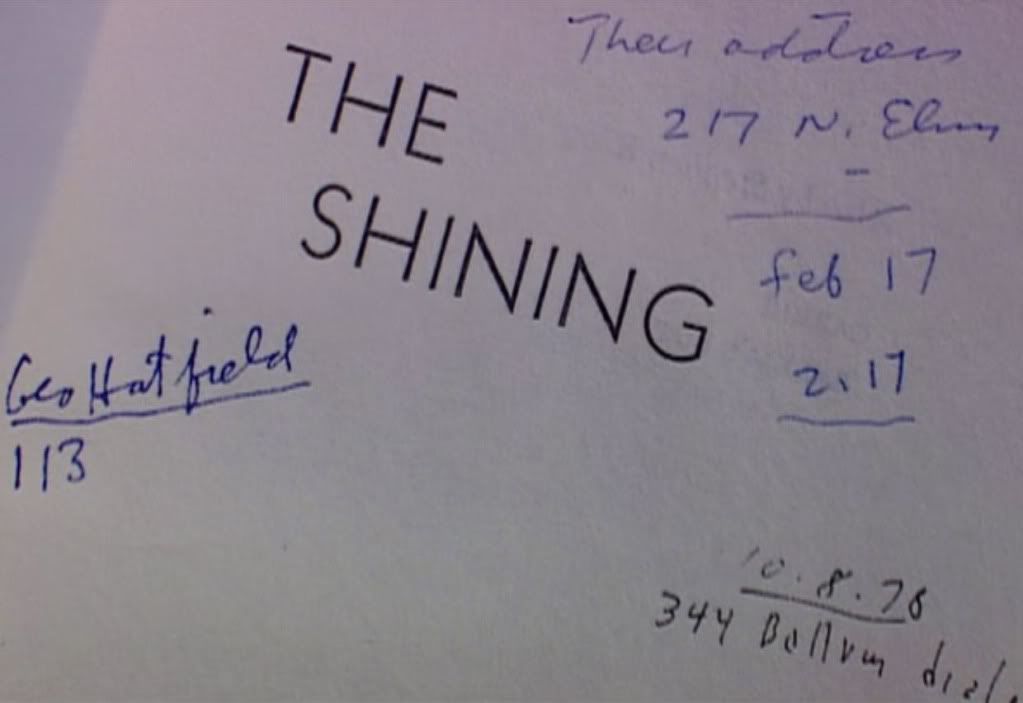
To look at more time codes and durations containing these numbers click here.
Stanley Kubrick didn't put up a sign in the reflection of a mirror telling us, "I hid something in The Shining". That doesn't mean any of this is wrong. The numbers :12, :21, :24, or :42 are showing up way to much to have happened by chance. Their appearance in character actions, on Danny’s sweaters, names of other movies, room numbers, radio call numbers, the number of pictures on the walls, and elevator floors makes you wonder and absolutely cannot be explained away. Stanley Kubrick wanted us to notice them for a reason. Something’s going on in “The Shining” on a massive scale and I’ve only scratched the surface. He creates an elaborate mathematical maze in the editing of this film. We may never know exactly how it all fits together unless each scene is plotted, and each shot is counted out second by second. Scenes (like the 2 shots I just showed you in Wendy's dresser mirror) at the end of the movie may have a mathematical relationship with scenes in the beginning of the movie. There may be a symmetry going on that no one has dreamed of that may even involve other movies. It's silly to think this wasn’t done on purpose and, as you’ll see if you read this article to the end, the numbers have a meaning and point to something outside of the movie. If you're still skeptical about whether Stanley Kubrick actually did this on purpose take a crack at explaining the duration in seconds on these three shots. The pictures are taken on the first and last frames and the values are exact to the frame. How can they all end up with the same odd duration of :21 seconds?
Jack enters The Gold Room
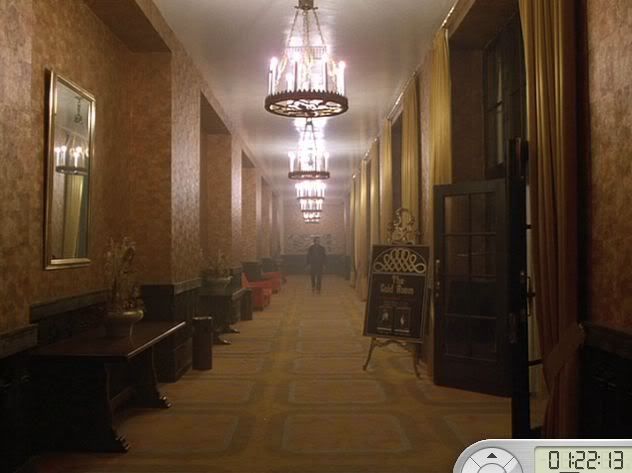
We see Grady for the first time exactly 2 minutes and 21 seconds later.

The very last frame of this scene is exactly 9 minutes and 21 seconds after the first frame.
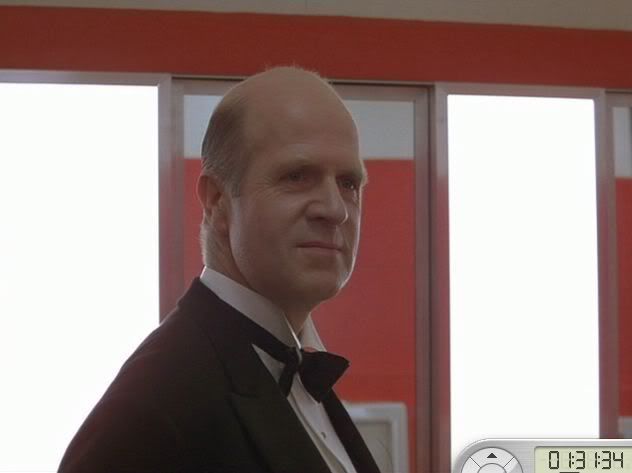
Finding these numerical occurrences was not a difficult task. All I did was look at the important scenes in the movie. After all there's only one mysterious room in the movie, there's only one time Danny discovers it and there's only one time Jack goes into it. The first time Danny sees the twins happens only once and the same with the bloody elevators. Well over 95% of every time code I looked at amounted to something. It was actually quite easy once I realized what Stanley Kubrick was doing. There was one annoying thing I couldn’t find though. The song over the final credits is an obvious reference to the number 12, "Midnight, The Stars and You" and I thought for sure the western that Wendy was watching when Jack calls her at the beginning of the movie would be another reference to the number 12, “High Noon”, but it isn’t. It’s from the 1952 film, “Carson City”. It references the number 21 as the newspaper shown to Kincaid several scenes earlier is issue 21.
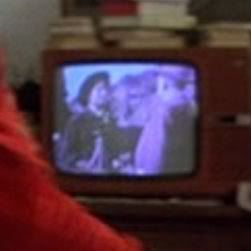
What I’ve noted here is quite accurate. The time durations he used are exact to the second (even though some are exact to the frame). The numbers were easy to spot because I knew what I was looking for. I know how tempting it is to go right to the end of this blog and post a comment about how wrong I am, or how you just disagree. Or my favorite nonsense comment; how "you can make a set of numbers mean anything you want". The director himself is pointing us to them; I didn't create any of this, it's an observation. And an accurate observation at that. These numbers popping up on sweaters, movie titles, and time codes cannot be altered or debated; they are what they are and the movie was created that way. You can have any opinion you like as to why or how all this happened but please mull it over for a while before you come to the inaccurate conclusion that it didn’t happen. Disagreeing with me is not enough, you should be able to show some proof of how you know Stanley Kubrick didn’t purposely edit “The Shining” so that certain scenes and shots would have the same numerical time durations as the numbers we see on Danny’s sweaters. Everything I’ve written in this blog must be taken as a whole in order to see the full magnitude of what he’s done here, and you should read on.
I’ve put a special place here for you to post if you’ve noticed secret numbers in other movies.
Anything you notice in "The Shining” put here.
Anything you notice in another movie or anywhere else put here.
................................ Music
The Differences Between The Novel And The Movie.
..........“A film is not a book.” - Roger Vadim
What important visual message was Stanley Kubrick showing us in this shot filmed in the same mirror that Wendy later sees "Redrum" in?

I bet you never thought about how important this is before. 2 words are seen in the reflection of Wendy’s bedroom mirror; not just “Redrum”. Stanley Kubrick takes seemingly insignificant words and sentences from Stephen King's novel and makes them come alive in his movie. The fictitious town of Stovington, Vermont is mentioned in 4 of Stephen King’s novels, and it’s the only direct visual link in the movie to his novel. What’s printed on Jack’s t-shirt is meaningless to moviegoers but it’s a well-known name in Stephen King circles. It’s interesting. For some strange reason Stanley Kubrick chose to show it to us backwards, “NOTGNIVOTS”. This is his sign post on the road that’s telling us exactly what’s been done to Stephen King’s story. Stovington is reversed because we’re looking at its reflection filmed in Wendy's mirror. The very same mirror we'll see the reflection of "Redrum" in later in the film. The inverted word is placed there as a metaphor and as I’ll prove to you we’re viewing Stephen King’s entire novel the same way, in a mirror; Stanley Kubrick’s special mirror, his version of “The Shining” where everything turns out to be an inversion of what you think.
I can’t think of any other movie where reading the source novel was so enlightening and my blogsite is the only one I’ve ever seen that successfully connects the dots between the film and the novel. Many writers skim the surface when trying to compare the novel with the movie and than simply give up. You absolutely cannot have a through understanding of Stanley Kubrick’s “Shining” without looking at what he did to Stephen King’s story. Ignoring the novel is crazy. Readers often wonder why certain things were changed but no one spends the time to understand just exactly what he did when he altered the original story. I thought it would be a good idea but I read the novel only after I’d been well absorbed into this project. I had no idea what I was looking for but upon reading it I quickly noticed one simple three letter word that opened up the entire film for me. Something else has been cleverly hidden in the same fashion as the numbers I spoke about in the last section. Something Stephen King has never said anything about even though he had to have noticed right away. Stanley Kubrick, being one of the most intense perfectionists in modern cinema, didn’t randomly alter things from the novel as many readers think. He’s inverted them. Like looking at the image of Jack I just showed you in the mirror. The image we see is the reverse of what’s real. In the next section I discuss how important mirrors are and much of the film is not just changed (like the numbers 12 and 21, 24 and 42, and 11) from the novel but is actually an inverted mirror image (the opposite) of what happens in the novel. It’s hard for readers to remember the color of “Daddy's battered red bug” as it’s only mentioned once on page 25 of the novel. The word “red” jumped right out at me. In the novel they’re brought to The Overlook in a red VW and have a yellow snowmobile up at the hotel. In the movie they’re brought to The Overlook in a yellow VW and have a red Sno-cat up at the hotel. They're also saved in a red Sno-cat. In the movie Jack throws his yellow ball and in the novel Danny plays with his red ball. Stanley Kubrick didn't just change the colors, he inverted the colors Stephen King uses in the novel for these major props. Look once at the VW in the opening credits of the movie; you’ll never forget that yellow color. Ask anyone who’s seen the film, they will be able to tell you what color the VW is. Ask anyone who’s read the novel and they probably won’t. The color changes are obvious and are a crucial part of the explanation of what’s happening in his movie.The colors of the two main vehicles in the story are just the beginning.
How did Stanley Kubrick alter Stephen King’s novel?
Stanley Kubrick altered something about every single aspect of the novel. Everything! Nothing was left untouched. You may be thinking that I’m incorrect in assuming that the film is a mirror image of the novel because he didn’t invert everything; he couldn’t. He couldn’t invert the title or the names. It wouldn’t have remained “The Shining”. He couldn’t invert room 217 to 712. There is no seventh floor in the hotel. He couldn’t invert time. What he didn’t invert he simply altered in some other fashion. He couldn’t literally invert the rooms where the story takes place so he did something different. Except that they seem to be in the same hotel (are you sure they are?) Stanley Kubrick was very meticulous in changing all the places from the novel where the scenes in the movie occur. Not one major thing happens in the movie’s Overlook in the same place it did in the novel’s Overlook. It’s unbelievable that no one seemed to noticed this or comment about it!
What happens in room 217 in the novel happens in room 237 in the film.
What happens in a red VW in the novel happens in a yellow VW in the film.
In the film Danny has his seizure at their apartment outside The Overlook. In the novel it’s inside The Overlook.
Hedges in front in the novel. Hedges in back in the film.
Jack works in the basement in the novel and in the movie he works upstairs and never goes into the basement.
There’s no Gold Room in the novel. Jack meets Grady and Lloyd in the Colorado Lounge not The Gold Room.
In the end of the novel Wendy and Jack have their knock down fight in the hallway outside their apartment.
“Redrum” appears in the novel inside their bathroom. In the film it appears outside their bathroom.
The final chase takes place inside The Overlook in the novel, not outside like the film.
Wendy is also severely beaten in the novel. In the end of the film she’s never touched by Jack at all.
Even Mr. Ullman's office was changed. In the novel Jack has his interview in the Manager's office at the beginning of the story, in the movie Mr. Ullman has been changed to the General Manager.
In the film the shed where the snowmobile is stored is attached to The Overlook. In the novel it isn’t.
The movie starts in Jack's VW. The novel starts in Mr. Ullman’s office.
In the film Dick Hallorann talks to Danny inside The Overlook. In the novel they’re talking outside in his car.
In the movie the doctor is a woman who sees Danny at their apartment. In the novel the doctor is a man who sees him in his office.
In the novel “Redrum” is seen by Danny before entering The Overlook. In the movie he sees it after they are at the hotel.
If he didn’t change the exact location he alters something else about it. Like Larry Durkin’s Conoco becoming Durkin’s Auto Supply or the cold pantry becoming a common storeroom.
The location of The Overlook has even been altered. In the novel the Torrance’s are in Colorado. In the movie The Overlook is in Oregon as we see early on when we’re shown The Timberline Lodge, which is located on Mount Hood in Oregon. Don’t let the Colorado State Flags all over the Colorado Lounge fool you. What we see in the beginning of the movie, when Dick Hallorann returns near the end, and every time there's a long shot of the hotel is located in the state of Oregon; not Colorado. Stanley Kubrick even hints at this in the dialogue when Jack talks to Lloyd, “Best God damned bartender from Timbuktu to Portland Maine, Portland Oregon for that matter.” I try to prove everything that I’ve written in this blog. If you don’t agree that Stanley Kubrick’s Overlook is in Oregon - click here.
He did a perfect job and none of these alterations can be ignored. As I’ll discuss later, he’s also done this with the dialogue and the plot. He’s turned the novel inside out and no one ever realized to what extent he accomplished this. Stanley Kubrick has taken Stephen King’s work and held it up to a mirror, and what we’re seeing in the movie is that reflection. A reflection where, in typical Kubrick fashion, just enough obvious changes are puzzlingly noticeable (The Hedge Maze and colors) and just enough, like the title, is left alone so as to not give it all away. He didn’t even leave the names alone as 3 were altered. Charles Grady exists only in the movie and not in the novel where Delbert Grady is both the “caretaker” who kills his family and the ghost who lets Jack out of the cold pantry. In the novel the main character’s name is John Daniel Torrance (page 22 chapter 4) and his nickname is Jack. In the credits we see that in the movie his real name is simply Jack Torrance. Danny's pediatrician is named in the novel and not in the movie. And was this an accident? Jack Nicholson and Danny Lloyd; Jack Daniel’s. Stanley Kubrick left nothing untouched and the alterations are hidden exactly like the numbers he dares us to notice. Even the credits are reversed as Stanley Kubrick’s name only appears in the beginning and not at the end of the film.
If you're interested in looking at more of the differences I've noticed between the novel and the movie, and how closely they relate to each other click here.
If you have preconceived ideas the reversals he made to the novel that I discuss are shocking. Especially when you think of how he was able to hide all this in plain site. But if you “go check it out” what I’ve written is quite correct. It’s not only correct but it can’t be debated, altered or most importantly dismissed. It is what it is. In the novel he noted that readers would never know what “Redrum” meant without looking at the word in a mirror and he created a movie that can’t be truly explained without looking at it in a mirror. A stroke of pure brilliance. Red is yellow and yellow is red, a true reversal of the source material and, as I show throughout this article, these reversals are crucial to understanding all of the mysteries this movie holds.
Perfectionism without attention to detail can be a real train wreck but when a true perfectionist works we average people look on in wonder at the world wind of intensity they create. When you think about the scope of the reversals here, the minute details that were altered and the time it must have taken, it’s a marvel to see and should be appreciated by all. Stanley Kubrick’s “Shining” may truly be The Eighth Wonder of the world of cinema. Here’s an interesting example of the inversions (and doubling) Stanley Kubrick made to the novel. The Grady girls, the most famous twins in history, aren’t twins and never appear in the novel. This is a huge reversal and can't be ignored. Danny only meets up with the lonely invisible spirit of a single child in the playground in Chapter 34 (page 197). “... Now, in spite of the snow-dazzle, he thought he could see something there. Something moving. A hand. The waving hand of some desperately unhappy child, waving hand, pleading hand, drowning hand. (Save me O please save me. If you can't save me at least come play with me... forever, and forever, and forever.)” In the movie instead of one unseen child we now see two children who repeat the line together, twice, “Come and play with us. Come and play with us, Danny, For ever and ever, and ever.” Here’s another interesting example of his inversions. In the novel Danny sees but doesn’t understand what “Redrum” means and he mentions it to several people throughout the story. In the movie this is all reversed and Danny never sees “Redrum”. If you look closely during that moment in the story it’s Tony that sees it, keeps repeating it, and writes it on the bathroom door, “Danny’s not here Mrs. Torrance”. Totally reversed; and Stephen King’s fans never noticed. The chapters and page numbers I’ve included in my blog are all from Stephen King’s 307-page version.
How did Stanley Kubrick invert Stephen King’s scene with the old woman in the bathroom?
It’s impossible to pinpoint when Stanley Kubrick decided to alter the novel the way he did but Stephen King’s style of adding many details to his work may have been part of it’s appeal to him. He definitely had a brilliant source novel providing him a lot to work with. Here’s another great example indicating how Stanley Kubrick shows us inverted mirror images of plot points from the novel. Take a look at the entire scene with the old woman in the bathroom. In the novel it’s Danny who disobeys Jack and Dick Hallorann by stealing the master pass key and going into room 217 where he sees a dead women in the bathtub. In the movie we’re shown an entire reversal of this. First of all it’s not a pass key and it’s all ready in the lock, and if you look very closely Danny never disobeys anyone as he doesn’t walk into the room. It’s Jack that walks in and sees not 1 but 2 women in the bathroom of room 237. It’s just like Grimm’s fairy tail “Hansel and Gretel”, where the old woman entices the children only to eventually turn into a witch. In the novel Jack never sees anyone as he enters the bathroom only to find an empty tub with no woman in it. He only thinks he hears her after shutting the front door, and she rattles the doorknob. He never sees her, never embraces her and never kisses her. It’s obvious everything in this scene except the names of the characters has been inverted. Don’t forget the bathrooms are in different rooms. In the novel it’s 217, but in the movie they’re in 237. It’s so subtle and barely noticeable unless you stop and really think about it, and the entire movie is like this from beginning to end. Stanley Kubrick is beyond meticulous, even the person who pulls the shower curtain in the bathroom is reversed, in the novel it’s Danny but in the movie he never touches it, it’s the woman who does. Much of the film’s dialogue is also inverted. In the novel Dick Hallorann says this, “People who shine can sometimes see things that are gonna happen, and I think sometimes they can see things that did happen. But they're just like pictures in a book.” (page 60, chapter 11) and he says later (page 150 chapter 25) “I don't think they can hurt you ... they're like pictures in a book ... close your eyes and they'll be gone.” If you notice what he says is not definite, “I don't think…” In the movie this line is very cleverly reversed because when Danny, after seeing a vision of the twins hacked to death, talks to his finger it’s Tony who repeats the line they both heard, “Remember what Mr. Hallorann said. It's just like pictures in a book, Danny. It isn't real.”, and Stanley Kubrick now makes this statement quite definite. And remember we never actually hear Dick Hallorann speak this line in the movie Overlook’s kitchen, it’s Tony that says it. In the novel the place where Danny and Dick Hallorann have this conversation is outside of The Overlook in Dick’s car, this has also been reversed to inside the Overlook’s kitchen while Danny has ice cream. The reversals just go on and on.
Who is Tony in the film?
Tony is explained much better in the novel. He’s Danny’s subconscious mind that protects him just like any other normal person’s subconscious does. Tony is part of him. Some believe that Tony is actually Danny from the future because of this line at the end of the novel, “And now Tony stood directly in front of him, and looking at Tony was like looking into a magic mirror and seeing himself in ten years, the eyes widely spaced and very dark, the chin firm, the mouth handsomely molded. The hair was light blond like his mother's, and yet the stamp on his features was that of his father, as if Tony — as if the Daniel Anthony Torrance that would someday be — was a Halfling caught between father and son, a ghost of both, a fusion.” But he isn't, Danny sees Tony that way only once at the end of the novel. Only when Danny actually has a future after his ordeal at the hotel is over. Stephen King is telling us that he's going to live. What’s unusual in this story is that Danny has the ability to “Shine” therefore his subconscious also has that special power. Stanley Kubrick made a huge inversion here as now Tony can’t be seen, in Stephen King’s novel he could be seen by Danny. Tony evolves in the novel and physically gets closer and closer to Danny as the story progresses. The film’s Tony is a mirror image of Tony in the novel, and stays the same throughout the whole story. Stanley Kubrick alters something special about the other ‘spooks’ in his film. In the novel mirrors are only important referring to the word “Redrum” and Lloyd the bartender and Grady never speak to Jack with a mirror present. In the movie this is altered as Jack speaks to both while looking directly at himself in a mirror. We never see Jack and any of The Overlook’s other ‘spooks’ together without a mirror being present. When he talks to Grady in the storeroom Jack doesn’t see him because there’s no mirror present. Stanley Kubrick’s attention to detail is unbelievable.
It may take a while for all this to sink in. Many do not agree that the movie is an inversion of the novel but (click here) take a look at how meticulous Stanley Kubrick is as he inverts the entire scene with Danny and the pediatrician. It’s from chapter 17 “The Doctor’s Office”. Side by side with the novel it’s easy to spot how the details are reversed.
Not only did he alter Stephen King’s novel but it appears that Stanley Kubrick may have left a special message just for him in the middle of the movie. Click here for one of the more interesting hidden shots you’ll ever come across in any movie.
Does Stanley Kubrick “Shine” a special word into the minds of Stephen King’s readers?

This inverted word is a very special visual message “Shined” from Stanley Kubrick to the readers of Stephen King’s novel. He’s telling you what he did to ‘The Shining”. Just like “Redrum” only makes sense when seen in the reflection of Wendy’s mirror, Stanley Kubrick created a movie that’s the same as the word “Redrum”; it will never truly make sense unless viewed in the genius director’s special mirror”. “The Shining” is a mirror image of “The Shining”. Just to show how confident he was in what he was doing he placed that reverse image of Stovington, as viewed by us, in the opposite side of the exact same mirror where we later see "Redrum" as the word murder. And don’t forget we see the inverted word “Stovington” at exactly one quarter into the film, :35 minutes, and we see the word “Redrum” for the first time exactly three quarters through the film, 1:45 minutes - :35 minutes from the end of the story. If you fold the time line of the movie at its center the two shots are mirror images facing each other at precisely the same spot, like visual bookends. How interestingly obvious; he placed mirror images in the same mirror at mirrored points in his film. It's clear; he’s pointing us to the movie's mirrors. Something important is hidden in their reflection and I'll discuss this later.
.......“Words of wisdom, Lloyd, my man. Words of wisdom.”
“Redrum” is the most important word in the story and it’s probably where Stanley Kubrick got the idea to invert Stephen King’s novel in the first place. I just mentioned that in the novel Danny sees, but doesn’t understand what “Redrum” means. It’s an enigma like “Rosebud” in “Citizen Kane”. The most famous single word in movie history. In fact “The Shining” is the exact opposite of “Citizen Kane” where the enigmatic word “Rosebud” is given to us to ponder throughout the film, only to be explained at the end. In “The Shining” nothing but a mirrored lake is shown in the beginning and the iconic July 4th photo at the end answers nothing at all. In the novel the first time we read “Redrum” is near the beginning on page 23 (Chapter 4) where Danny “Shines” and Tony shows him what the future holds. Before they leave for the hotel, he shows him the word in a vision from the bathroom mirror of their future home, The Overlook; “He couldn't read! But got a sense of all, and a dreamy terror floated into the dark hollows of his body… Now he was in a room filled with strange furniture, a room that was dark. Snow spattered against the windows like thrown sand... Outside there was a hollow booming noise, like a dreadful door being thrown wide... Across the room was a mirror, and deep down in its silver bubble a single word appeared in green fire and that word was: REDRUM… A shaft of light coming from another room, the bathroom, harsh white light and a word flickering on and off in the medicine cabinet mirror like a red eye, REDRUM, REDRUM, REDRUM…"
Stanley Kubrick inverts all this and as I mentioned before Danny never sees the word “Redrum”. Don’t forget what Tony tells us in the film’s dialogue, “Danny's not here, Mrs. Torrance.” In his catatonic state after being beat up it’s Tony speaking through Danny that sees the word, keeps repeating it, and writes it on the opposite side of the bathroom door. In the novel it just appears in the mirror, and (Chapter 37 - Page 210) Wendy is not even present when Danny sees the word in the flesh. “Redrum’s” position is also a total reversal as he sees it on the inside of the bathroom, in the medicine cabinet mirror. When we see it in the movie it’s now Wendy in bed who sees “Redrum” on the outside of the bathroom door in her vanity mirror. Don’t forget one really important thing; when Danny looks at “Redrum” in the novel's mirror he sees it backwards. The word in his mirror is still inverted and it’s not until the end of the novel, in another reflection in a clock, that Danny sees the real word and realizes that it's “murder”. In the novel he sees a reflection of a reflection. In the movie we see it first on the bathroom door than it must be seen in the mirror before it makes any sense. Stanley Kubrick’s masterpiece must be viewed in a mirror before making any sense. Everything is the reverse of what it appears to be.
Where is the obvious symmetry that Stanley Kubrick created with “The Shining’s” time codes?
Stephen King has “Redrum” appear right at the beginning of the novel (Chapter 4 - Page 23), but Stanley Kubrick places “Redrum” in a very special spot. As I mentioned before, it’s precisely three quarters of the way through the film, to the minute. As Jack questions Wendy after she looks at his novel, Tony visions “Redrum” on the door. But the word is not seen in the flesh until later on their bathroom door. If you divide the running time of the movie (2:21 after Warner Brothers logo to the July 4th photo) into equal quarters you get :35 minutes and a few seconds. In fact several major inversions to the novel occur precisely at :35 minute intervals. Just in case you’re into numbers that’s two of the special numbers he wants us to notice added together, :24 + :11. Stanley Kubrick has created a movie where the running time is obviously symmetrical.
:00 minutes – The very first thing we see, the yellow VW, reversed from the red VW in the novel.
:35 minutes, one quarter into the film - We see Jack‘s reflection from the left side of Wendy’s bedroom mirror and “Stovington” is in reverse on his shirt (In the novel it’s Danny, not Jack, who wears a green sweatshirt with “Stovington” on it - Chapter 2 - Page 12).
1:10 minutes, exactly half way through the film – As he walks into room 237 Jack “Shines” that image into Dick Hallorann’s mind causing his return to The Overlook. The reverse of the novel where Danny walks into the room and sees the woman and Jack never sees her at all.
1:45 minutes, three quarters into the film – “Danny’s not here Mrs. Torrance” and Tony sees “Redrum” on the bathroom door. Tony never sees “Redrum” in the novel and it doesn’t appear on a door but in a reflection in the bathroom mirror.
2:21 minutes - An inversion of the novel where The Overlook is destroyed, Jack burns to death, and the party is over. In the movie The Overlook survives, Jack is frozen to death and the party seems to go on as he remains frozen for a second time on the wall as the Manager “for ever, and ever, and ever”. The very last thing from the story that we see. Even the July 4 photo is a mirror image of something in the novel as I’ll explain later.
The 2 words “NOTGNIVOTS” and “Redrum” are both precisely positioned reflections eventually seen from opposite sides of Wendy’s mirror, equidistant (:35 minutes) from the center of the movie. Stanley Kubrick shows us with precision that he has indeed edited the time codes to come out the way he wished and that he has indeed inverted Stephen King’s novel. This must have been the most difficult cinematic feat for Stanley Kubrick to accomplish. It was a lot of work to set up similar scenes at equidistant spots in this film. There are several other occurrences that are time symmetrical in “The Shining” and I’ll mention them again at appropriate times in this article. The red Calumet can appears behind Dick Hallorann’s head as Danny “Shines” to him in the storeroom :27 minutes from the beginning of the film. The same cans appear behind Jack’s head at precisely :27 minutes from the end of the film as he “Shines” and talks to Grady. The visions of the bloody elevators are an omen of death. When Danny sees his vision of the bloody elevators it’s :11 minutes into the film and Wendy sees Dick Hallorann’s dead body at precisely :11 minutes from the end of the film. Wendy has the exact same vision of the bloody elevators :08 minutes from the end of the film and at precisely :08 minutes into the film Mr. Ullman tells Jack about the Grady murder suicide. At :59 minutes into the film Jack has a dream about killing his family and at :59 minutes from the end of the film we first see Grady who tells Jack to kill his family. Jack looks into the Hedge Maze miniature at :40 minutes into the film and Wendy looks into “All Work and No Play Makes Jack a Dull Boy” at :40 minutes from the end. Wendy uses the radio at :49 minutes into the film and Jack destroys the radio :49 minutes from the end. Jack throws the ball :37 minutes into the film and Wendy holds the bat :37 minutes from the end. 1:09 minutes into the film Wendy tells Jack about the woman and at : 1:09 minutes from the end of the film the woman touches Jack. :13 minutes from the end of the film Wendy has a vision of the 2 gentlemen in the room and at :13 minutes from the begining of the film Danny talks to the pediatrician.
This is no “theory” on my part, it’s a fact. But he’s beckoning us to notice something else. There’s one perplexing image in the movie that’s symmetrical in exactly the same way. Stephen King wrote this, “He was reminded of the 3-D movies he'd seen as a kid. If you looked at the screen without the special glasses, you saw a double image — the sort of thing he was feeling now. But when you put the glasses on, it made sense” (page 233, chapter 43). It’s the 3-D daydream that Jack has of the Hedge Maze and as you’ll find out in "The End" of this article, much has been hidden by the director inside that image.
How was dialogue from the novel altered?
I’d only looked into this recently, but Stanley Kubrick ever so slightly alters the character’s lines that were taken directly from the novel - for no apparent reason. Like;
The novel’s, "I think I'll have to leave a trail of breadcrumbs every time I come in," Becomes, “I feel I'll have to leave a trail of breadcrumbs every time I come in.”
The novel’s, "Looks sort of like a doc, doesn't he?" Becomes, “Well anyway, he looks like a Doc, doesn't he?”
The novel’s, “... there until sometime next April." Becomes, “they were going to be there until next April.”
The novel’s, "Now I'm really glad you asked me that, really glad.” Becomes, “Now I'm awfully glad you asked me that, Lloyd...”
The novel’s, “White man's burden, Lloyd my man.” Becomes, “White man's burden, Lloyd my man. White man's burden."
The novel’s, "And a pleasure it was. Ma'am, are you a Winnie or a Freddie?" Becomes, “Mrs. Torrance, your husband introduced you as Winifred. Now are you a Winnie or a Freddie?
The novel’s definition of cabin fever, "It's a slang term for the claustrophobic reaction that can occur when people are shut in together over long periods of time.” Becomes, “a kind of claustrophobic reaction which can occur when people are shut in together over long periods of time.”
When a line from the novel is exact he simply has a different character saying it;
“How did you know we called him 'Doc'?” In the film Wendy says this line. In the novel Jack says it.
"Great party, isn't it?" In the novel it’s a partygoer, “a man with a green ghoul mask on.”, not an injured employee that says this line (if you look closely the old British gentleman with the injured head is the Gold Room’s Maître d'). These alterations may seem trivial but they’re part of a much bigger picture.
Stanley Kubrick subtly does something else that helps explain much of the movie. In the film Jack speaks 2 of the ghost’s lines from the novel;
In the novel Dogman says (Chapter 41 page 228), “Not by the hair of my chiny-chin-chin," In the film it’s now Jack that recites from The Three Little Pigs, “Come out, come out, wherever you are! Little pigs, little pigs, let me come in! Not by the hair on your chiny, chin, chin. Then I'll huff, and I'll puff and I'll blow your house in.”
In the novel Danny only meets up with one ghost that’s a child (he never sees the Grady girls in the novel). He sees a hand waving and the child says (Chapter 34 Page 197), “Save me O please save me If you can't save me at least come play with me... Forever. And Forever. And Forever.” In the film the Grady girls say this, “Come and play with us. Come and play with us, Danny, forever and ever, and ever.” But later in their bedroom Jack repeats the end of it, “I wish we could stay here forever... and ever... and ever.”
Sometimes it’s shocking to see how a screenwriter changes your favorite novel for the big screen. I remember reading “To Kill A Mockingbird” and being surprised to find out that Arthur 'Boo' Radley talked to the children. They changed this in the screenplay and I believe not having him speak throughout the story created a mystery that added much to the movie’s appeal. I can see how fans of the novel could be a little perplexed at what Stanley Kubrick did but you must admit he did an unbelievable job and Stephen King really couldn’t say much about the alterations as he gave his permission to the director Warner Brothers chose to film it.
Here’s a great clip of Stephen King talking about Stanley Kubrick on You Tube. Again after seeing the film he described Kubrick’s film as “a big beautiful Cadillac, with no engine.” Several years ago a question was posed to Stephen King in USA Weekend (March 6-8 2009); I have always heard that you never really liked Stanley Kubrick’s version of “The Shining”. He answered; “My problem with ‘The Shining’ was never the adaptation. I certainly didn’t mind the idea that it was more psychological than supernatural. What I didn’t like was that I thought it was cold, and I always resented that. I’m an emotional writer. I think that’s why I’ve written so many things that people term “scary” or “horror”. I’m not that interested in what you think all the time, but I am interested in what you feel.” I feel both stories are brilliant in their own special ways. But what could he be insinuating here, “more psychological than supernatural”. I’ll discuss his interesting choice of words in a later section.
I’ve looked into the rumors of where the actual Overlook Hotel that inspired Stephen King’s novel is located? Click here.
................................ Music
The Significance Of Mirrors In The Film.
................. “Look in a mirror and one thing's sure;
..................... what we see is not who we are.”
................................ Richard Bach
The very first thing Stanley Kubrick shows us in “The Shining” is a mirror reflection. We see a beautiful mountain range but only half of it is real, the other half is a beautiful inverted mirror image seen on the surface of a peaceful calm lake. While pondering the July 4, 1921 photo in the last shot of the film I was looking at the 21 pictures on the wall when I just happened to glance down at the time code underneath 2:21. That's how I quickly discovered that something was hidden in the time codes of this movie. Mirrors do not play a large roll in the novel and if Stanley Kubrick is showing us his special mirror image of Stephen King’s novel there must also be tremendous importance in his use of mirrors in the movie. The key to the puzzling date is hidden in the mirrors. 12 and 24 are the mirror images of 21 and 42, and just as "Redrum" is the mirror image of murder. Wendy gives Jack breakfast in bed and his reflection in the bedroom mirror may be the spot when we are first shown the true reverse image of his madness. Again it’s precisely one quarter of the way into the movie.
Why does Danny have 2 sweaters with numbers on them?
The numbers 12, 21, 24 and 42 are being spoon-fed to us but there is one more that isn't. I've mentioned it before and 11 is the toughest of the numerical clues to spot. The number 42 is obvious but Danny, as he plays in the hallway, also has the number 11 on another sweater below the word Apollo. And Stanley Kubrick wants us to notice it. Stephen King did his homework while writing the novel as the prophet Daniel in the Bible had a little bit of the “Shine”. Stanley Kubrick does his homework too as the ancient god Apollo (the sun god) also had the “Shine”.

4 major shots in The Shining are filmed entirely in the reflection of a mirror. Notice how the number 11 (twin ones and a mirror image of itself) figures into each time code. These numbers are Stanley Kubrick's invention and the time codes of the mirror shots shown below are, 11, 11+24, 11+42, and 11+1:10. The odds of these 4 major and unique shots (filmed in the reflection of a mirror) coming out with these specific and accurate time codes by chance are close to zero. I discovered this and they are what they are. Stanley Kubrick planned it out ahead of time and the number 11 is the most deeply hidden clue in the movie. 11 is the linchpin for understanding what the other numbers mean. Notice how he includes one of the other 4 numbers that continue to pop up in the time durations again and again. Some interesting things occur randomly in life (click here) but so many precise time codes occurring in a film in the scenes where characters are filmed in mirrors didn't happen by chance.
Danny’s reflection as he talks to Tony in the bathroom mirror (the duration is :24 seconds exactly and the time code is :11 minutes).

Jack’s reflection in the bedroom mirror as Wendy gives him breakfast (the duration is 1:21 minutes exactly and the time code is :35 minutes, :24+:11).

Jack’s reflection in the bedroom mirror as Danny comes in for his truck (the duration is :24 seconds exactly and the time code is :53 minutes, :42+:11).

Wendy sees the Redrum reflection in the bedroom mirror (the duration is :04 seconds exactly and the time code is 2 hours and :01 minute, 1:10+:11, 121 min.).
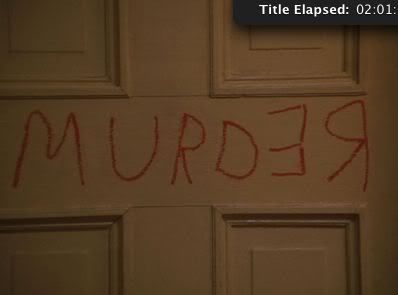
Where did Stanley Kubrick place the number 11 in the dialogue?
In the novel (Chapter 34 - Page 197), “…come play with me... forever, and forever, and forever” is nine words. In the movie the same line, “…come play with us Danny, for ever, and ever, and ever” has been changed to contain 11 words for no apparent reason. There’s an obvious emphasis on the separate words and when Jack says a similar line it’s also 11 words. “I wish we could stay here forever... and ever... and ever.”
Look closely at this picture of Jack’s vision of the Hedge Maze. Inversions and mirror images are included everywhere in this movie. I’ll show later how important this image is as it holds all the clues to the explanation of what the date in the last shot in the movie means. The number 11 is also here in this obvious Indian design where the Roman Numerals X and I can be seen. Don’t let the shadows Stanley Kubrick added fool you, notice that it's not only a left/right mirror image of itself but also a top to bottom inversion.
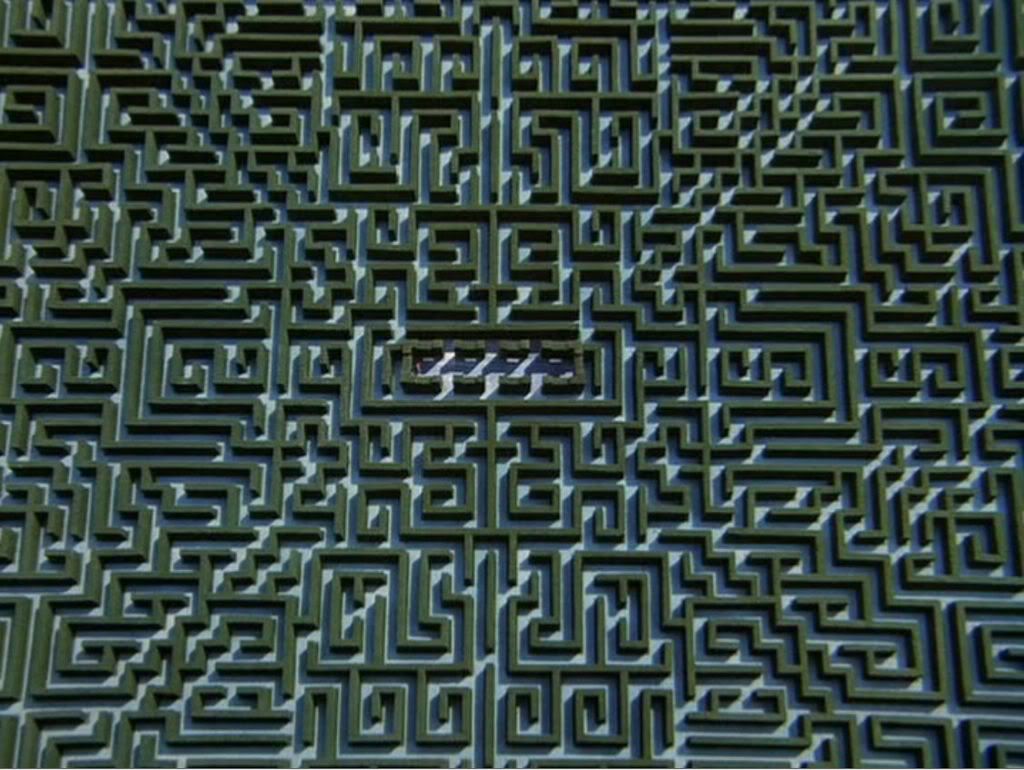
Is Jack actually speaking to himself each time he looks into a mirror?
I explain this in the next section. Scenes with mirrors directly in front of him are an indication that Jack is “Shining” and his “ghostly” visions occur when one is present. When he's with the old woman or speaking face to face with Lloyd and Grady, Jack's actually looking at himself in that mirror. Listen closely, none of the "ghosts" utters a sound without Jack looking straight into a mirror. It’s because he’s speaking to himself. This doesn’t happen with any of the other visions that Wendy or Danny see.
Don’t forget that gold, “Shines” also. Jack's visions of Lloyd at the Gold Room bar with mirrors in front of him.

Jack’s vision when he first speaks to Grady. Even though you can’t see them in the shot the Gold Room bar with all its mirrors are facing him. As Jack turns to the right and looks into them he sees his reflection as Delbert Grady spills the Advocaat on him at the party.

The vision of Grady in the bathroom with mirrors facing him on the right.
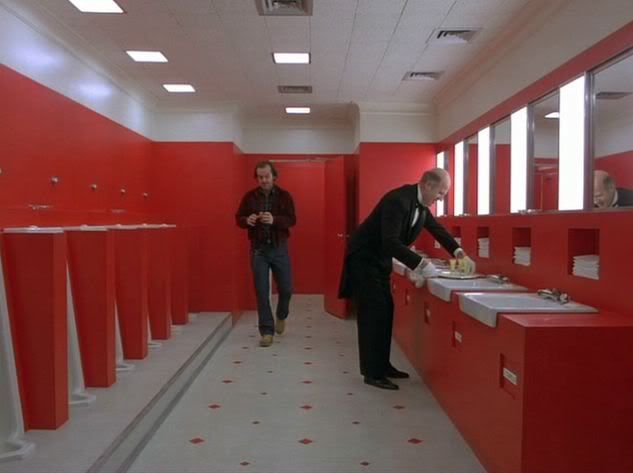
Room 237 with mirrors inside.

Room 237's bathroom, which has mirrors all around, and facing him as he sees the old woman.
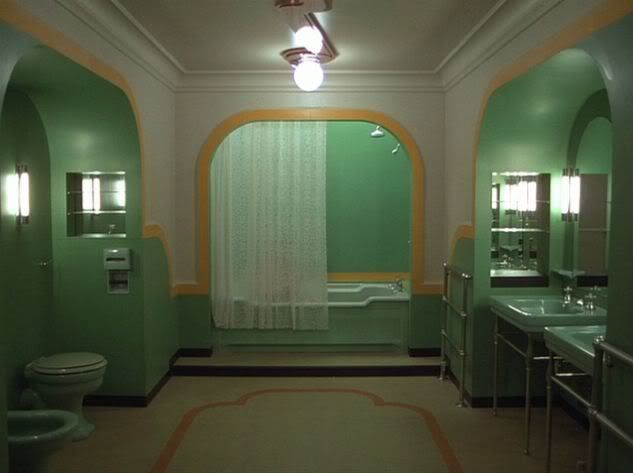
Danny’s vision in his bathroom with a mirror in front of him.
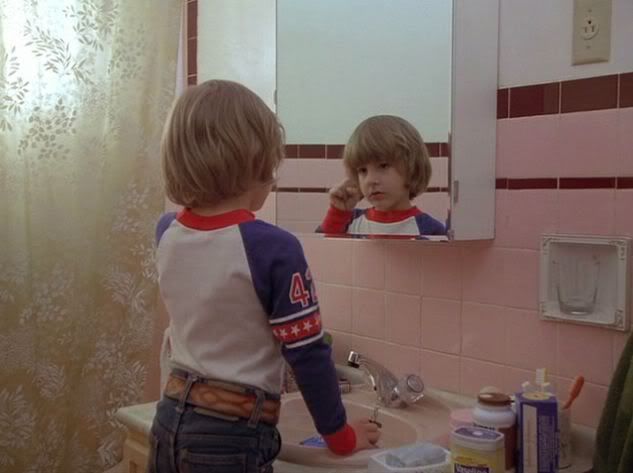
There’s more significance to the mirrors than you may think. One appears when you least expect it. In their drive up to The Overlook the mirror is not obvious. But if you look closely even though they’re alone on the road Jack constantly looks in the rear view mirror of his yellow VW,
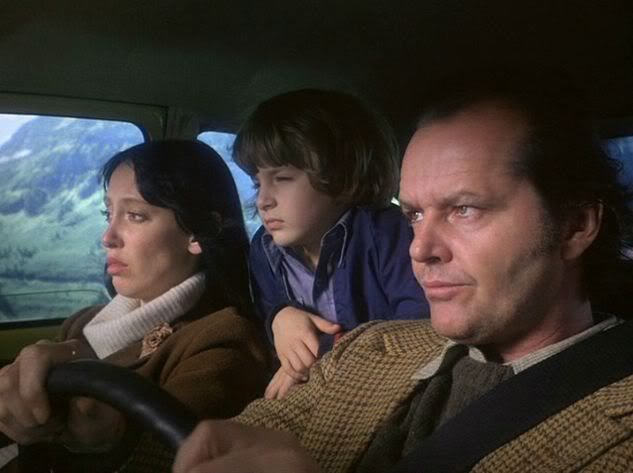
and an unnaturally large pile of luggage, that couldn't fit in a VW if the engine and all the passengers were removed, appears at the end of the journey (without a shred of luggage on or in the car or any indication of any outside help as theirs is the only vehicle heading towards the hotel.). How could this happen? In a horror movie about the supernatural. Either things are moving around by themselves or maybe Stanley Kubrick simply made a mistake. Something is moving them.
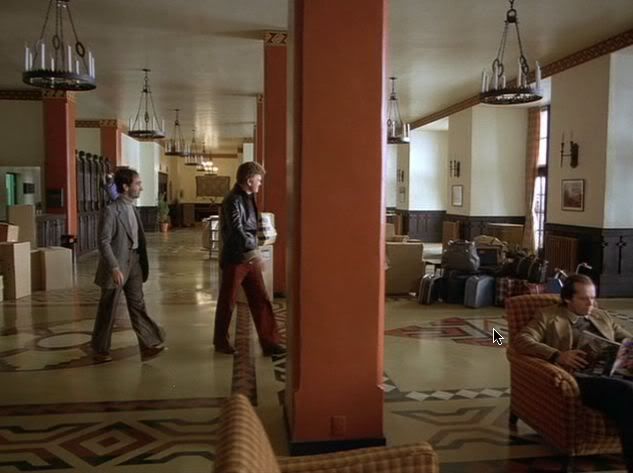
In the movie cast members who “Shine” have the power of telekinesis. They can move things with their minds. Stanley Kubrick visually shows us this and I’ll prove it with pictures in the next section. I'll also show how Jack has the ability to “Shine” but doesn’t know it (or we’re not supposed to know that he knows it) and mirrors, as well as the colors yellow or red, are present in his possessions or surroundings when he does. In the kitchen on closing day while talking about others with their special gift of “Shining”, Dick Hallorann says this to Danny, “But, there are other folks though mostly they don’t know it, or believe it”. Who do you think Stanley Kubrick is referring to when he has Dick Hallorann say this? There are only five main characters in this film.
Where does Stanley Kubrick appear in “The shining”?
Audiences used to love to spot Alfred Hitchcock when he’d make appearances in his films and Stanley Kubrick’s appearance in “The Shining” might have real significance to the story. It’s so noticeable. I’ll show you the screenshot of the spot (exactly 3:24 into the film - that’s 3:35 minus the :11 second Warner’s intro) but you’ll need to watch the film closely to actually see his face moving behind the camera in the reflection from Mr. Ullman’s window. A window that couldn’t possibly exist; as later we see the other side of the wall after Wendy sees the old bloody gentleman who says, "Great party, isn't it?" It’s interesting that Jack is also looking right at Stanley Kubrick’s reflection. The same way he looks at Lloyd’s reflection, Grady’s reflection, and the old woman’s reflection later in the film. Could this mean something?
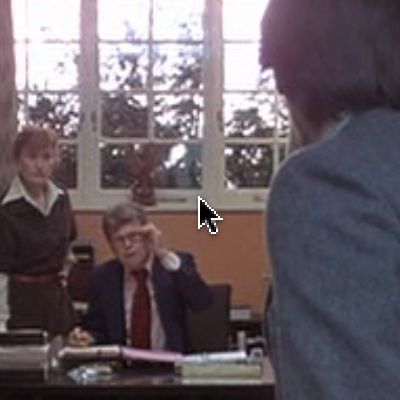
As I noted before we would never know that the word "Redrum" is murder if we didn’t see it in the reflection of Wendy's bedroom mirror. We also will never understand what "Overlook Hotel July 4th Ball 1921" means in the final black and white photo of this movie if we don’t look in the mirrors again. The most deeply hidden clue in Stanley Kubrick's “Shining” is in the mirrors and explained in The End of this article.
................................... Music
Things That Move Around, Change Color Or Just Don’t Seem Right.
“You can fool all the people some of the time…” - Abraham Lincoln
In “Sherlock Holmes and the Secret Weapon” (1943) Holmes refers to a theory of Edgar Allan Poe in his story “The Purloined Letter” that, “the best place to hide something, is where everyone can see it” and this is precisely what Stanley Kubrick does in “The Shining”. Hide in plain sight! But where did he get the idea to secretly hide something in this film? Stephen King wrote this in the novel, “But now things had been misplaced. Things were missing. Worse still, things had been added…” (page 133, chapter 21)
Something’s been “added” to the movie In a big way. The "Shine" in the film is not the same as the 'shine' in the novel, and Stanley Kubrick chooses a most ingenious device to depict this change. “Can you see the Indians in this picture?” Stephen King asks this question on page 133 of his novel. But he never shows any of them to us. Stanley Kubrick does though. He has them, “sneak up behind” a cast member twice. Anyone who doesn’t utilize the novel when trying to understand this film only knows half of the story.

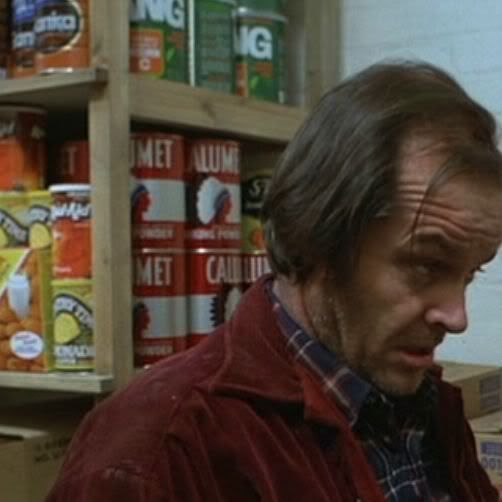
“… it was the ones you couldn't see that would sneak up behind you…” Stanley Kubrick makes this so obvious but how and why did the Indians get there? The “Shine” in the movie is not the same as the ‘shine’ in the novel. As I noted before Stanley Kubrick created a film that’s symmetrical. The red Calumet can appears behind Dick Hallorann’s head at precisely :27 minutes from the beginning of the film and the same cans appear behind Jack’s head precisely :27 minutes from the end of the film.
What is the film’s definition of the “Shine”?
This scene may not hold the record but Scatman Crothers was made to do 148 takes sitting there explaining the ‘shine’ to Danny. “Not things that anyone can notice, but things that people who 'shine' can see." We’re viewing a mirror image of the novel where Jack didn't possess the "Shine". It should come as no surprise to anyone that by the very definition Stanley Kubrick gives us of the “Shine” in his story, Jack now possesses this ability to “notice… things”. The exact same “things” Danny notices. Visions of The Overlook’s previous guests. The visions of Grady’s daughters that Danny sees are no different than the vision of their father that Jack sees. They’re seeing things that only, “people who 'shine' can see." They both possess the “Shine”. We’re told this by Stanley Kubrick, “But, there are other folks though mostly they don’t know it, or believe it.” The dialogue from the film explains why they can see certain of The Overlook’s previous guests. But there’s an even bigger secret that Stanley Kubrick’s hidden in his film. How and why did the Calumet cans appear behind Jack and Dick Hallorann’s heads? The secret lies in what the director did to the three items that move supernaturally in Stephen King’s novel.
At least once in your life you’ll notice a continuity error in a film because many items move between shots in movies without being touched by a cast member. Unless considerable effort is made in production it’s almost impossible for filmmakers to stop these visual anomalies from happening. They're all over. Any time in a movie where you see a clock, a chair, or a prop that an actor handles, watch the next shot closely as you'll probably see a movie mistake. In “The Shining” there are a lot of continuity errors but Stanley Kubrick does something unusual that I’ve never seen in a film before. He knows mistakes are going to happen and that people will notice them so he uses this to his advantage as an integral part of the story. Not only are things hidden in the alterations of the source novel, time codes, and mirrors but something’s hidden in what look like average everyday movie mistakes. Unless you’ve looked closely at the source, Stephen King’s story, it would be impossible to put all this together. We're not talking about just clocks here. This is a film about the supernatural “Shine” and many items appear out of nowhere. It’s a mistake to entertain the idea that Stanley Kubrick would never place what appear to be common continuity errors purposely into a movie. He simply doesn't advertise this fact. He's turned simple movie mistakes into an integral part of the supernatural visual aspect of his story, and I believe it's a first on any scale. It’s pure genius and it’s exactly the kind of idea you’d expect a genius to come up with. Remember; “.... things had been misplaced.... things were missing.... things had been added…”
If you’ve read the novel it’s easy to spot that the few people who “Shine” can do three things, (1) they can see visions from the past or the future, (2) they can speak to each other telepathically over any distance and (3) Danny can read minds. But with all this paranormal ability they do not supernaturally animate objects. You have to be very clear on this. Only The Overlook is able to move things supernaturally in the novel and it’s done many times to scare the Torrance’s. Stephen King gave the hotel this power but not the characters. After what I showed you in the section on the differences between the novel in the movie, it would be ridiculous to think that Stanley Kubrick would’t tamper with the very essence of Stephen King’s story, the “Shine”, in the same way he tampered with everything else. After all there were no authorities around to stop him. I can prove that just like he did with most everything else of importance from the novel Stanley Kubrick alters the abilities of the characters that “Shine”, and he does it without anyone realizing. He creates a mirror image of the the supernatural ability that’s already been established in the novel. The pictures, dialogue and alterations he made to the source novel will show that in his Overlook people who possess the “Shine”, 1) do not have the ability to read each others minds as Danny did in the novel. (2) They can supernaturally “Shine” animated vision’s into other’s minds, something that only The Overlook could do in the novel (what a chilling concept, someone in the film’s Overlook has the ability to project images of ghosts directly into the minds of the other characters). And last (3) they can supernaturally alter objects. Moving and making items and possessions disappear and re-appear (on the screen, right before our eyes). Something that was only alluded to in the novel, but never actually done. Don’t think for one minute Stanley Kubrick would pass up an opportunity to take a certain line from Stephen King’s novel and run all the way with it. Stephen King gets into our minds and electrifies our imaginations with words. Stanley Kubrick works with an entirely different set of parameters. He electrifies our imagination with images. He uses this special paranormal phenomenon of the “Shine” to spookily move things around throughout his film. It’s just to easy for him. Operating in a visual realm he took this idea I just mentioned directly from the pen of Stephen King, “But now things had been misplaced. Things were missing. Worse still, things had been added, things you couldn't quite see, like in one of those pictures that said ‘Can You See The Indians?” Reading the novel I wondered about what he was talking about but Stephen King never expanded on this sentence. In the novel’s haunted hotel he brilliantly chose to supernaturally animate the fire hose, the hedges, and the elevators rather than make other items disappear, re-appear and move around on the Torrance’s. In Stanley Kubrick’s visual arena he took this sentence and found a way to make all sorts of things move around, change color, disappear and re-appear between shots in his Overlook without the audience noticing. And the proof of this is in what he chose to do to the three items I mentioned that move supernaturally in the novel. They all remain totally motionless throughout the film. He shows us what he’s done to Stephen King’s novel by creating the mirror opposite of what occurs in the novel; those three items don’t move an inch in the film when the Torrance’s are living there.
What are some examples of continuity errors in other films?
Again anyone wishing to understand “The Shining” must realize that the visual game played here is considerable and done in such a crafty way so as to look like garden variety continuity errors seen hundreds of times in just about every movie ever made. It might be expected that things in a supernatural ghost/horror movie will move around by themselves but what a brilliant way he chose to make items secretly appear, disappear or change; have them look like common continuity errors seen in all other movies. If you happened to spot one of these how could you ever know that it's actually an integral part of the film? Look at the most famous continuity error of all time; Dorothy caught red handed not wearing the Ruby Slippers as she dances with the Scarecrow in "The Wizard Of Oz". This is a rehearsal take that I believe the editor deliberately slipped in as a joke.
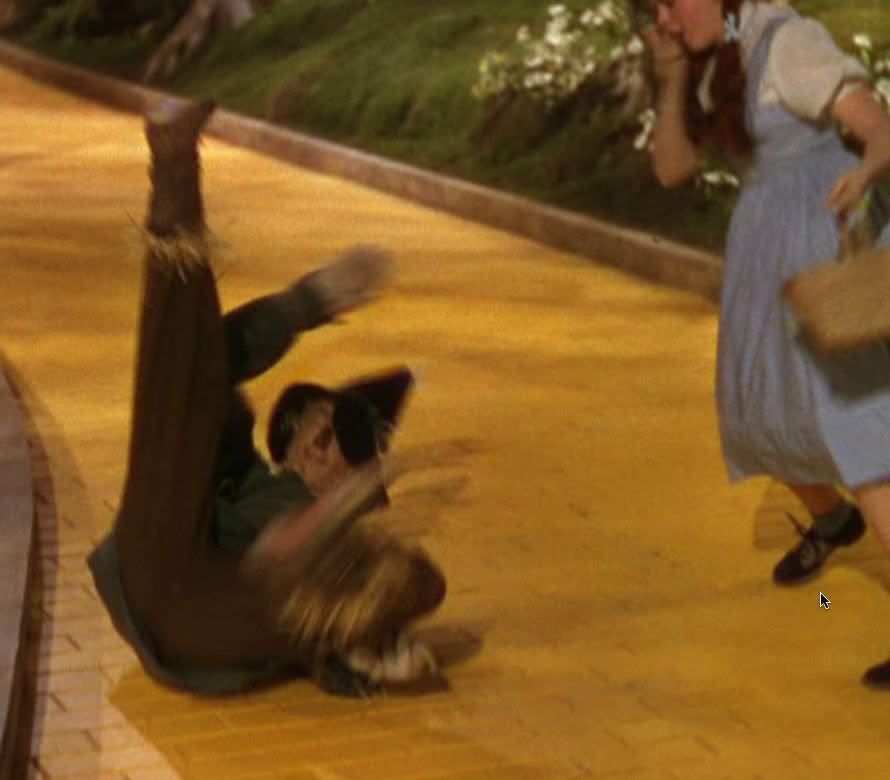
Or this rare makeup faux pas from a movie with very few continuity errors, "The Exorcist" where they forgot to paint Regan’s ears.
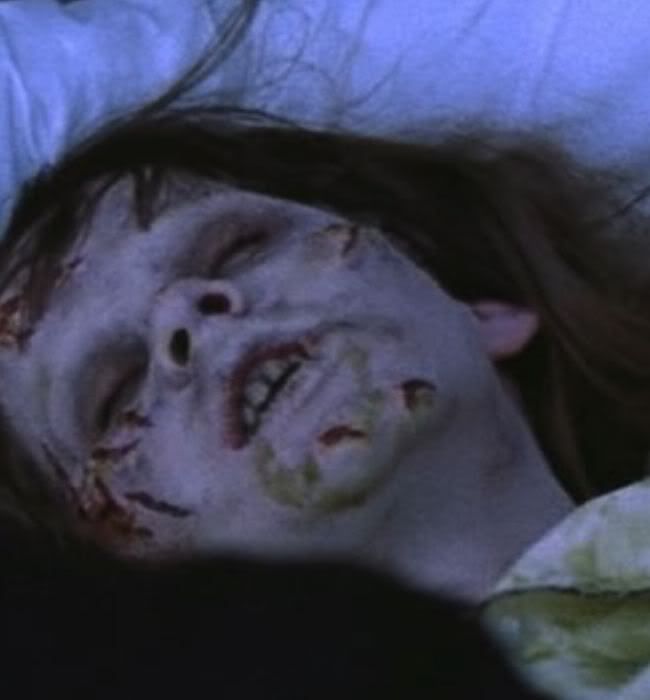
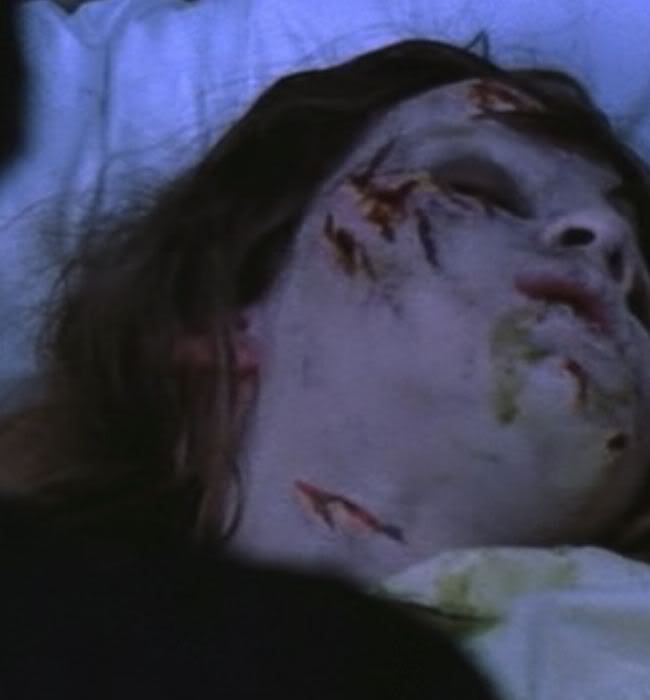
Or what could be falling out of the tree in the opening credits of “Gone With The Wind”? It took a while to figure out that it wasn’t a dead cat. What we’re seeing are live birds being deliberately dropped out of the tree in a sack so they would fly off towards the camera in the next few frames.
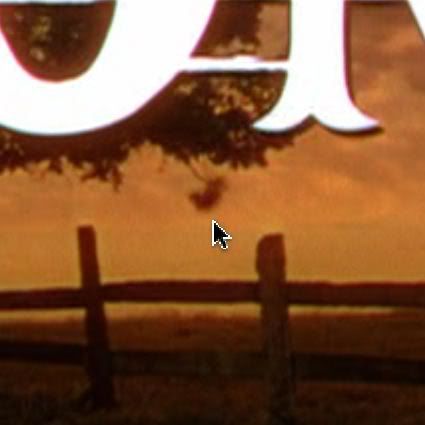
Or this scene from “Easy Rider” that will always amaze me. Dennis Hopper shows the astonishment on the little girl’s face just before she sees the old guy taking out his false teeth.
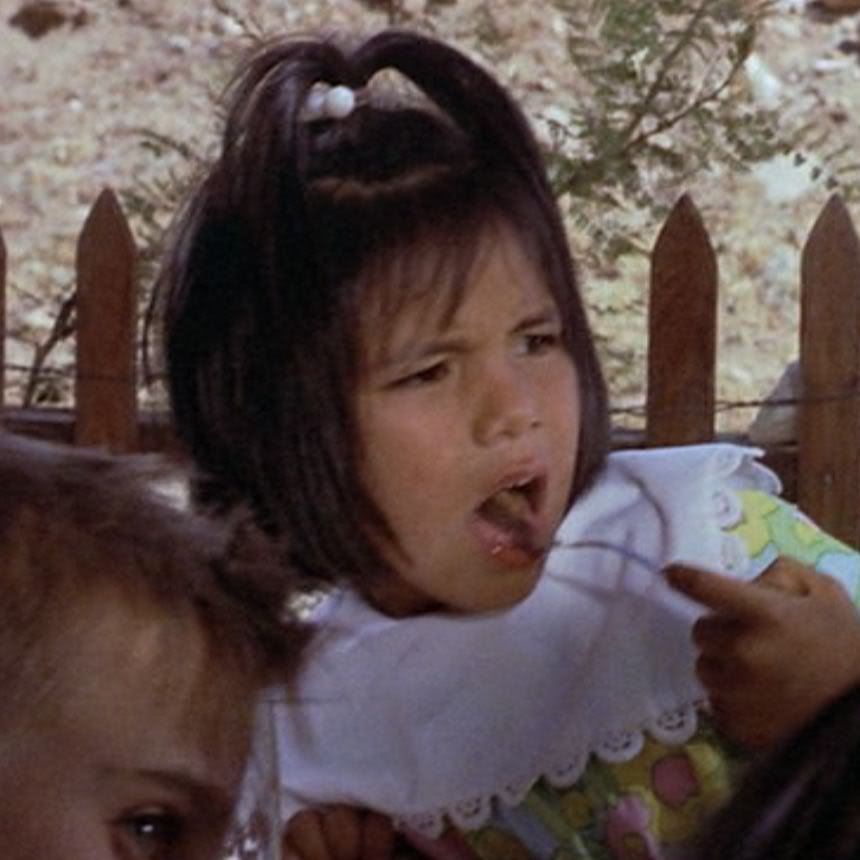
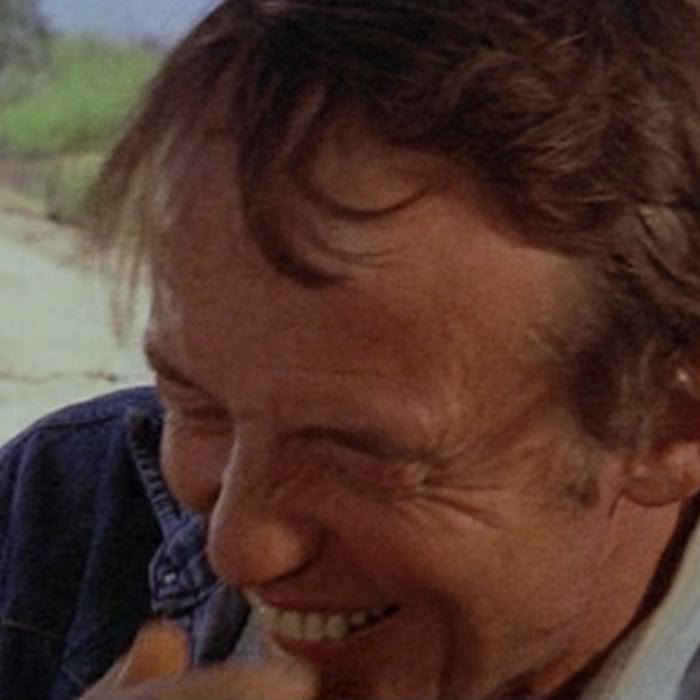
The audience doesn't know a thing. Literally, if you blink you'll miss this stuff. It's the same in "The Shining" which I believe contains the second most famous continuity error in the history of film, and you probably never noticed it. I’ll show it in a later section.
Stanley Kubrick’s clever deception is believed by some ‘experts’ to be common continuity errors like these, but they’re wrong. He’s so good at this that most wouldn’t be able to tell an actual error from what’s done on purpose. It’s impossible to prove which movements in the movie are deliberate and which aren’t but the proof that there are deliberate movements comes from what he did to the three items that The Overlook supernaturally animates in the novel. I still get a lot of variations on this comment from those who criticize my blog. They claim that what I’m going to show you later in this section, items that move between shots when they shouldn’t or change color when they shouldn’t, are only explainable as common crosscut continuity errors. They're not deliberately added for us to notice. Anything that moves between shots in a movie is an error in continuity but there’s no law in film making stating that what appear to be continuity errors cannot be purposely placed in a movie by a filmmaker. It's now Stanley Kubrick's Overlook. He knew precisely what he was doing and he released his finished product exactly the way he wanted it to look, and no one can prove that any of these movements are, in fact, errors at all.
What is the most revealing alteration Stanley Kubrick made to Stephen King’s novel?
Deliberately adding what look like common movie mistakes is precisely what Stanley Kubrick did in “The Shining” and they are truly part of the story. This is obvious to anyone that looks, but again the proof of this is found in reading Stephen King’s novel. Before looking at some of the deliberate continuity errors from the film I’d like to point this out; in the movie there’s not one major visual aspect of the novel that’s been left out. Some things just need to be searched for then you can say ‘I never noticed that’ when they’re pointed out to you. One of the best and creepiest parts of the novel was what I mentioned a few paragraphs ago; when The Overlook animates certain objects for its guests. It’s classic horror and it’s absurd to think that Stanley Kubrick would leave out such a great visual plot point from the novel. The three items I referred to from the novel that The Overlook animates were all out in the open and obvious, and “it only happens when you’re not looking” (chapter 34, page197). The Hedge Animals, the fire hose, and the elevator all moved on their own. But what Stanley Kubrick does to these three items in the movie just cannot be denied or ignored. He hits us over the head with this. He’s showing us a mirror image of what happens in Stephen King’s novel and no one can dispute that these three items glaringly, and hauntingly, remain totally motionless throughout the entire movie instead of moving by themselves at the behest of the demonically possessed Overlook. Stanley Kubrick is “Shining” something right into our minds. The Overlook is the most famous haunted hotel in history! Look at these three items all you like, because they will not move (or make a sound). "I didn't see that at all." Says Jack about the fire hose after he noticed that The Overlook made it move in the novel (page 174, chapter 30).
The motionless elevators that never change floors (when the Torrance’s are living there the elevator doors only move in their visions - not in the hotel itself)
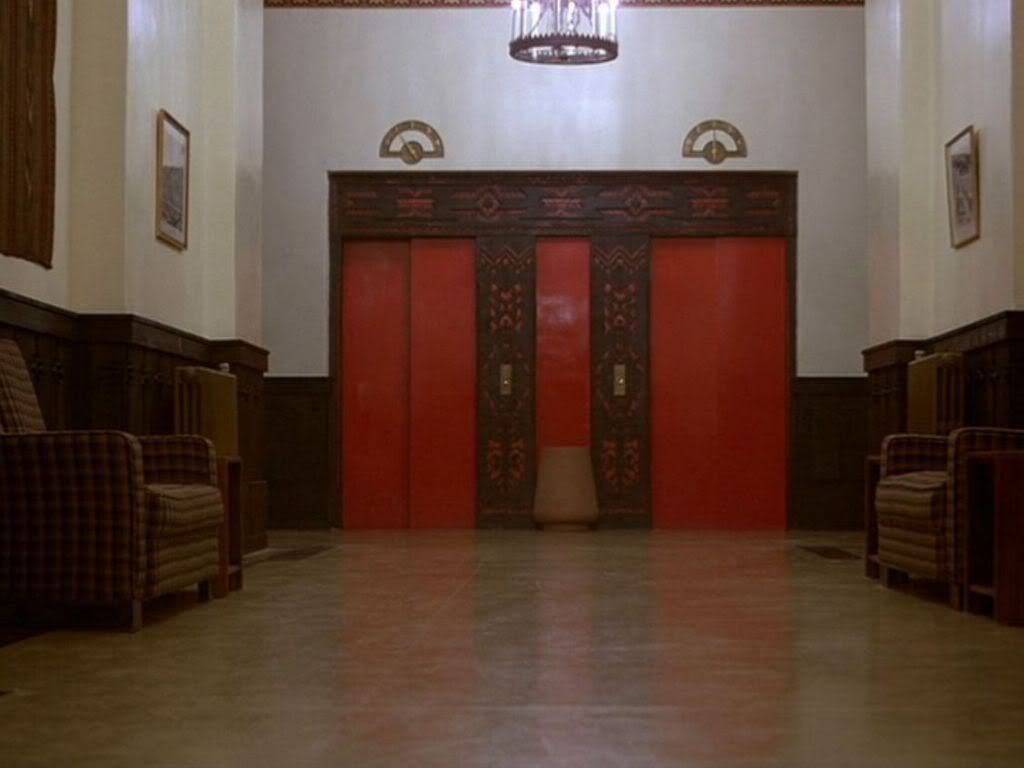
... and hedge maze are obvious,
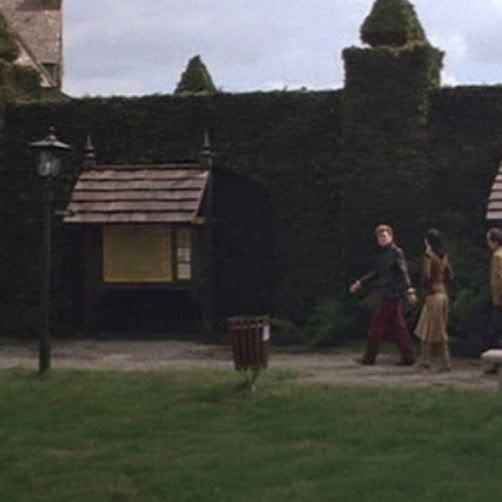
but here’s the fire hose. You may not have noticed it but Stanley Kubrick didn't forget it, and it doesn’t move either.
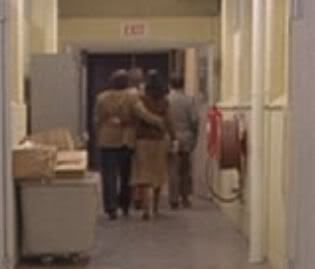
None of the three budges an inch. Look closely at the elevator’s floor indicators. They don’t even change when we’re not looking as you might expect in the most famous "haunted hotel" in history. Rugs, light switches, clocks, artwork, and sofas all move by themselves or just disappear throughout the film but the elevators don’t budge. The elevator in the novel was surely possessed. Now it appears clear that we’re looking at a mirror image of Stephen King’s story. What The Overlook moves supernaturally in the novel doesn’t move an inch in the movie. What The Overlook possesses in the novel it does not possess in the movie. This is obvious and done purposefully. He’s pointing us right to it, and anyone attempting to explain “The Shining” must mention this obvious inversion of the novel. It cannot be ignored.
Now that you’re aware of this it’s clear that looking at the way he reversed so much from Stephen King’s novel, it’s left open for Stanley Kubrick to mysteriously move any other object that’s not one of the three that move in the novel; as unbelievable as this sounds, it’s precisely what he did. Something disappears reappears or changes color in almost every scene in the movie. And things in the film move when you’re looking right at them not, as in the novel, “when you’re not looking”. We’re to busy looking at a nude woman that we missed the playfully disappearing shower head behind the love birds.
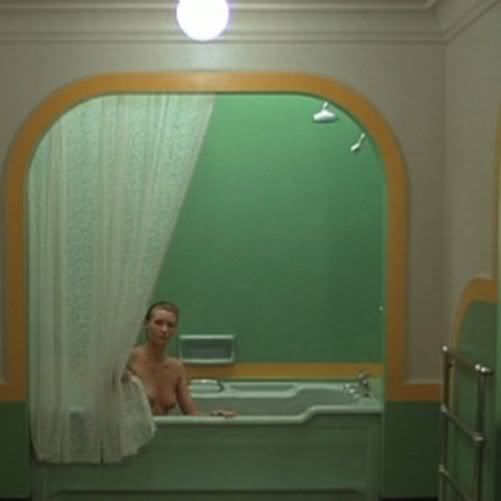
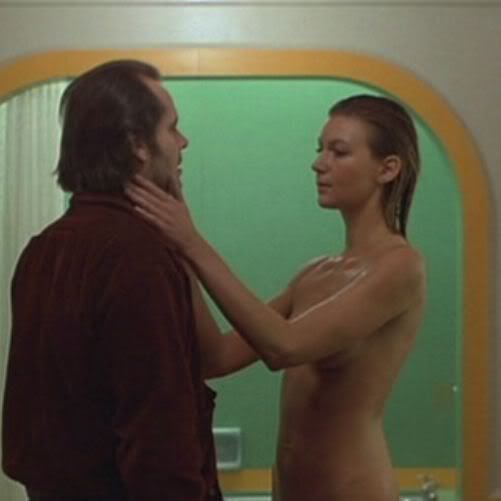
Skeptics come up with all sorts of explanations as to what's going on here. It's a mistake, he took the nozzle out because it didn't look right in the shot, ‘blah blah blah’. But this is what you would actually expect to happen in the most famous haunted hotel in history; things moving around by themselves caused by a paranormal supernatural power. Can you prove which is the right explanation? Stanley Kubrick didn't overdo it but the pictures of what happens around the main characters do have an explanation.
It’s very important to realize that the power that moves the objects in the novel, possession by The Overlook itself, has been changed in the film. What moves around supernaturally in Stanley Kubrick’s film is the product of characters that have the very special ability to “Shine”. That’s what this movie is about; “Shining”, and just like the numbers Stanley Kubrick wants us to notice, the movements I’m speaking about are easy to spot when someone points them out to you. Readers of this blog will believe what they want but what Stanley Kubrick did here is obvious. We can expect things in his movie, other than the three items mentioned from the novel that remain totally motionless, to move by supernatural means. This is precisely what he does. Again that supernatural power is "The Shine”.
What moves around supernaturally in “The Shining”?
The first item I ever noticed that moves when it shouldn’t happens after Jack scolds Wendy. He’s looking right at her and a second sheet of paper reappears back in the typewriter carriage after he pulls the first one out and rips it up (an Adler; the same brand used by “the fuhrer” and changed from an Underwood in the novel). Watch the movie after he finishes scolding her as another sheet appears right out of thin air back in the typewriter again ready to be typed on. Jack never touched it and more importantly the audience never hears a thing. This appears to be magic and it’s just the beginning.
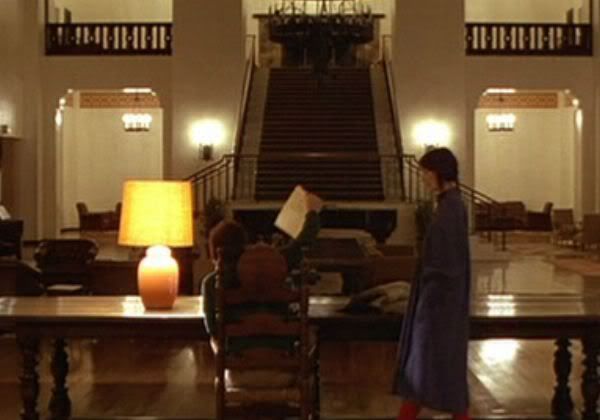
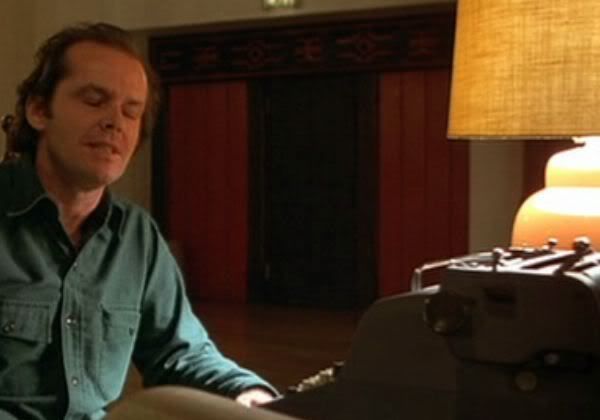
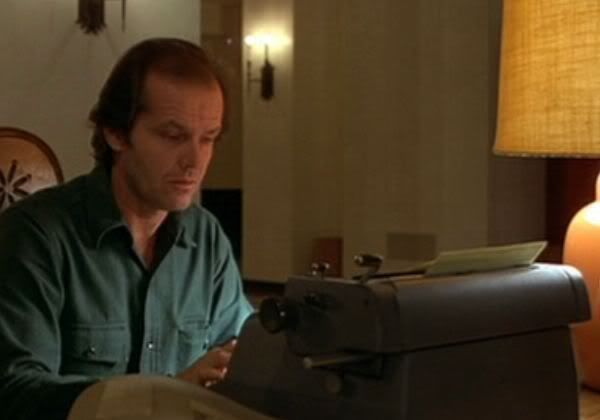
The piece of paper reappearing in the typewriter can have only three possible explanations. It’s a mistake, The Overlook did it, or Jack did it. There are no other explanations. It can be ruled out that Stanley Kubrick didn’t notice this obvious mistake as he precisely edited the shot that way for a reason and we all saw it happen. If you think The Overlook did it you’ll have to explain how the same strange movements, that I'll show you, also happen to Danny before he ever enters the hotel. And also happens to Dick Hallorann well outside of the hotel's influence as he sits in bed in Florida. If Jack is the one that put the piece of paper back in the typewriter, as he’s the only one there, then he must possess a supernatural ability enabling him to do it without making a sound. There is no other explanation. The piece of paper appears back in the typewriter as if by magic. This is by no means a stretch of the movie’s reality as it's in the title of the story and if you don't agree with me - proceed to the end of this blog and prove it to me.
Where is visual proof that Jack also possesses the “Shine”?
There’s no question that Dick Hallorann has a special supernatural ability. They both “Shine” as he communicates telepathically with Danny in the storeroom (:27 minutes from the beginning of the film). As he does something moves again as if by magic, and we all saw it happen this time also. During the thought transfer a red Calumet can appears out of nowhere on the left next to and behind his head, only to disappear in the very next shot when he stops "Shining". It happens because he's "Shining" with Danny.

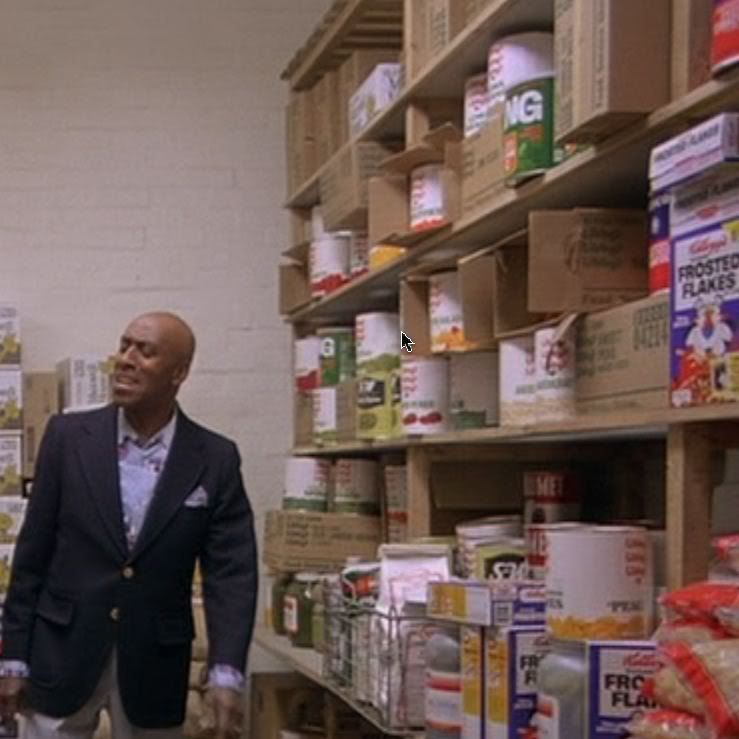
When Jack talks to Delbert Grady (:27 minutes from the end of the film) the exact same thing happens again as we now see several red Calumet cans appear out of nowhere. Now the can’s positions are reversed being on the right side behind his head. They also weren’t there when Wendy dragged him in. They just appear out of thin air.

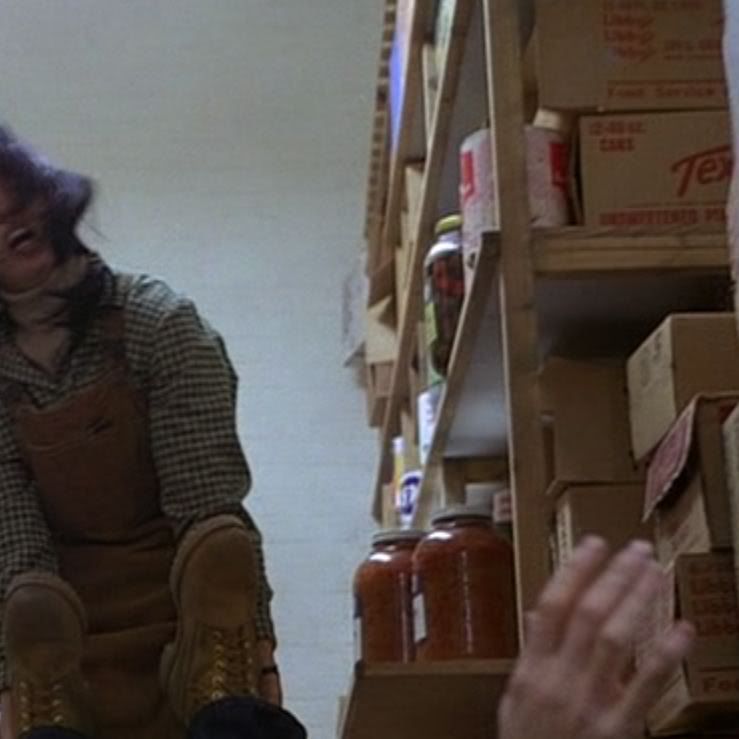
Look at the similarities in the two scenes;
They’re both in the same place.
They’re both talking to someone in a supernatural way.
And the same red Calumet cans appear out of nowhere on the reverse side of the shelves. Behind their heads and out of their view.
The red Calumet cans are not a common run of the mill movie mistake; they’re part of the film. They are there. We can all see them and they’re important for understanding the story. You simply can’t say Dick Hallorann is “Shining” and Jack is not when the exact same bizarre thing happens behind both of them. They’re both doing the same thing, producing the same result and Stanley Kubrick is hiding something in these movements. It should be no surprise that Jack also has the ability to “Shine” as Danny is his son (Dick Hallorann and his Grandmother both had the “Shine” also). But Stanley Kubrick also tells this to us in the dialogue. I use this sentence a lot in my blog because it explains so much. “But, there are other folks though mostly they don’t know it, or believe it”. This sentence is crystal clear and can’t be un-explained. If you don’t believe me answer these two questions; who do you think Dick is talking about in that last quote and what other paranormal phenomenon can you come up with that made the Calumet cans appear out of nowhere? The film is about “Shining”.
They both have the same ability. It’s no stretch of the movie's reality that Jack also “Shines” in the storeroom. The increase in the number of cans indicates how much more of this ability he has over Dick Hallorann. This helps answer one of the most perplexing plot errors of this movie. How is it that Dick Hallorann who can see visions, inexplicably doesn’t know that Jack is hiding around the corner with an ax at the end of the film? Jack can simply out ”Shine” Dick Hallorann who is unable at that moment to utilize his special ability to foresee the end of his life.
As he speaks to his vision of Grady (he’s actually speaking to himself) notice the red box of (24) "Golden Rey" pimentos that also move between shots just like the Red Indian did earlier. "Golden Rey", an obvious play on the word shine where Rey (a word the Spanish used for the Mayan Indian's kings) is pronounced ray (like a ray of sunshine). Stanley Kubrick is giving us obvious clues that Jack has and uses his special hidden ability to “Shine” to unlatch that storeroom door. We see another play on the word ‘shine’ earlier in the film when Danny stands in front of two red "Texsun" boxes as well as two red "Golden Rey" boxes as Dick Hallorann speaks telepathically to him. After Wendy brings Jack breakfast in bed we hear another play on the word shine, “I made ‘em just the way you like ‘em, sunny side up.” Or how about the place where Jack meets his first so called ‘ghost’, The Gold Room with its ceiling that looks like rays of sunlight emanating from the stage area. Gold, like the characters in this film, without a doubt, “Shines”.
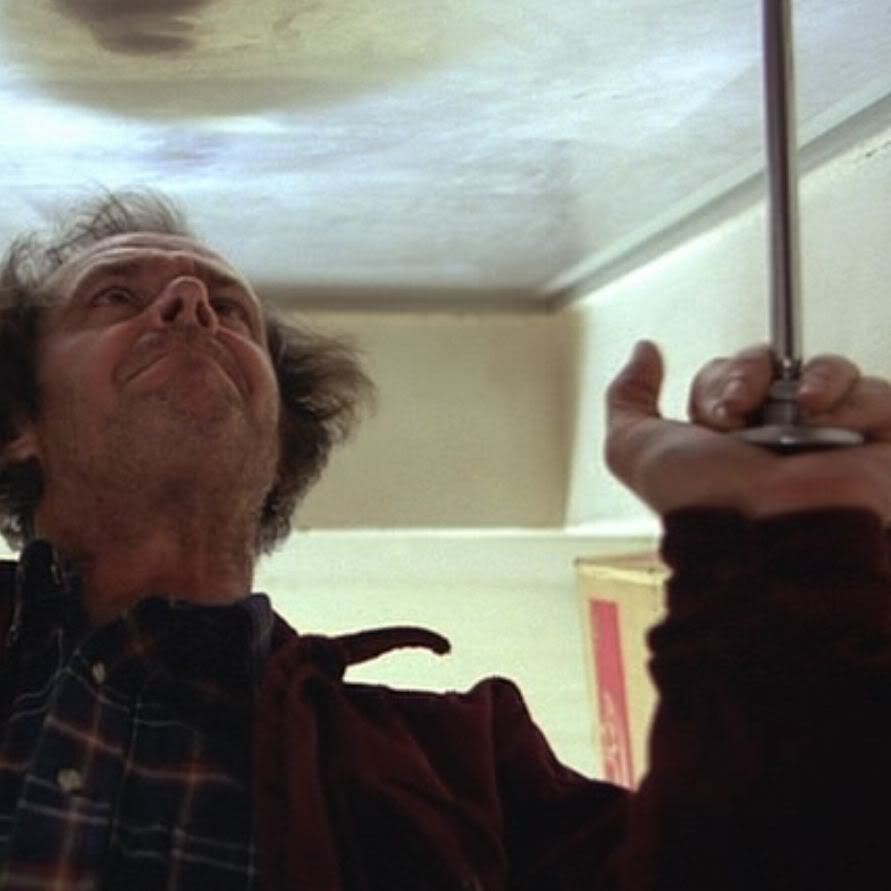
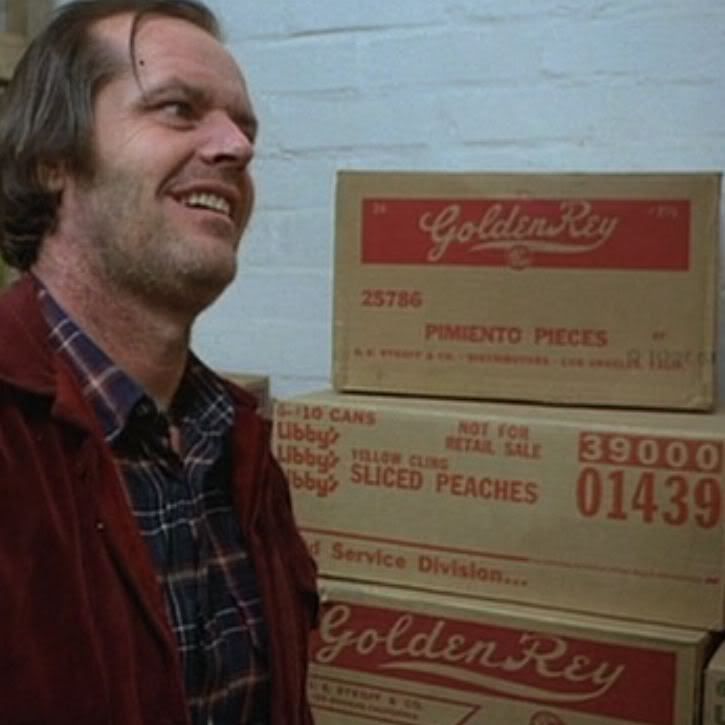
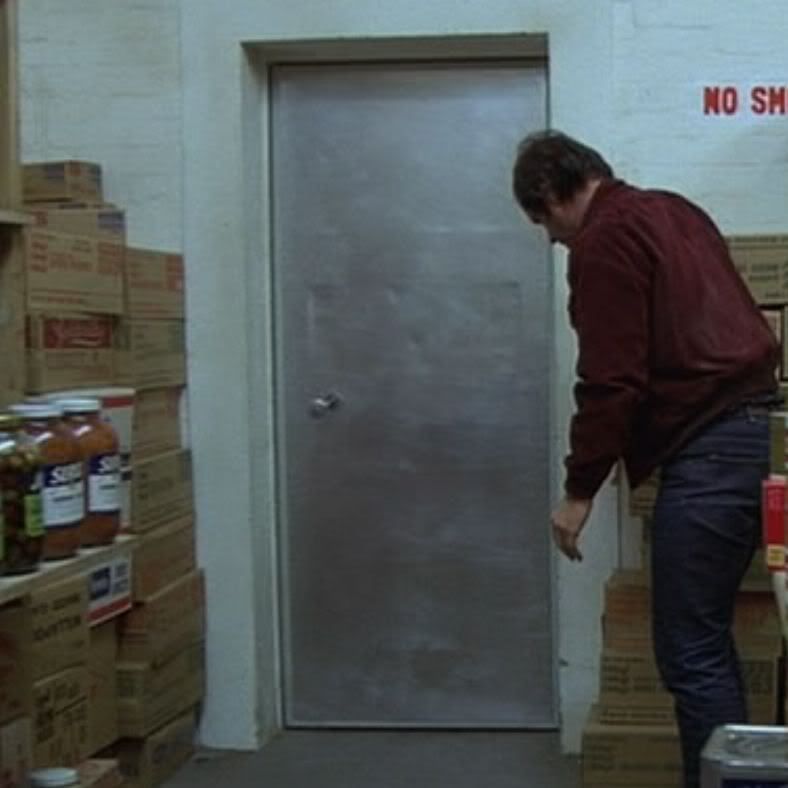
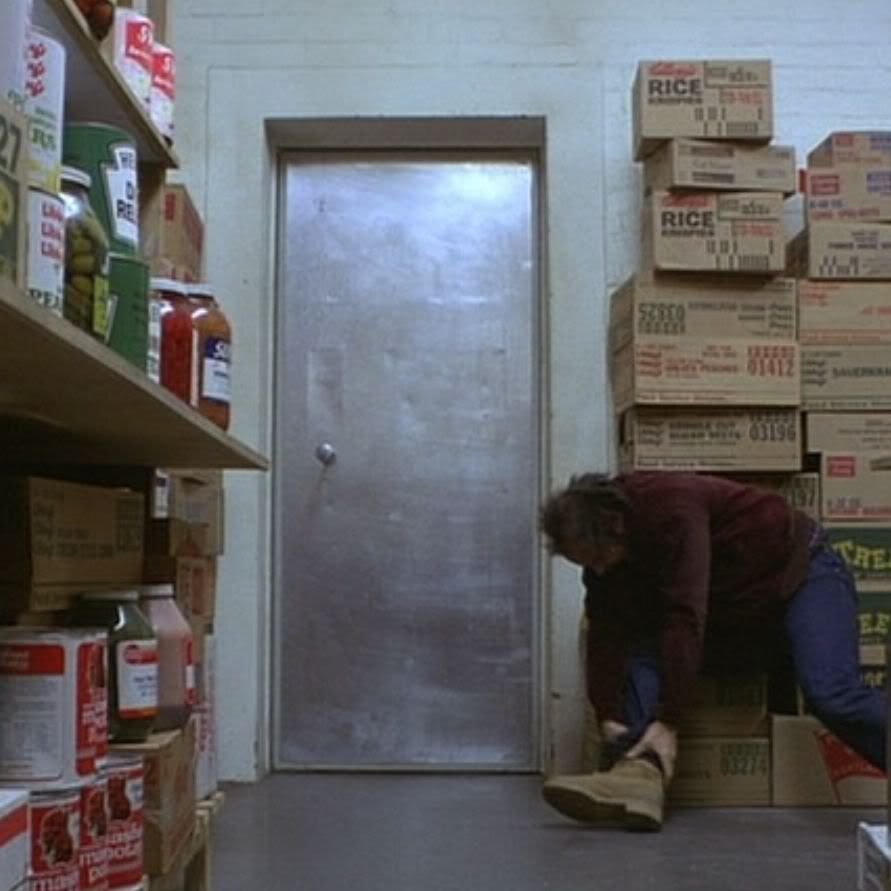
Where is proof in the audio that Jack possesses the “Shine”?
There’s something else in this scene that lets us know that Jack has the ability to “Shine”. As we look at Danny obviously posed next to a different red “Golden Rey” box of sliced pineapples, get out your copy of the movie and listen to the sound we here during this scene (:27 into the movie).
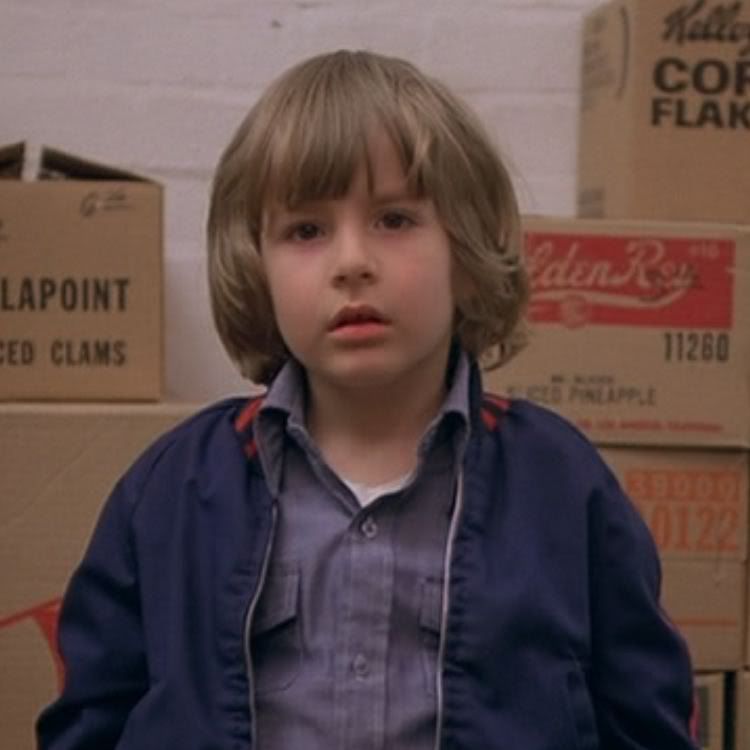
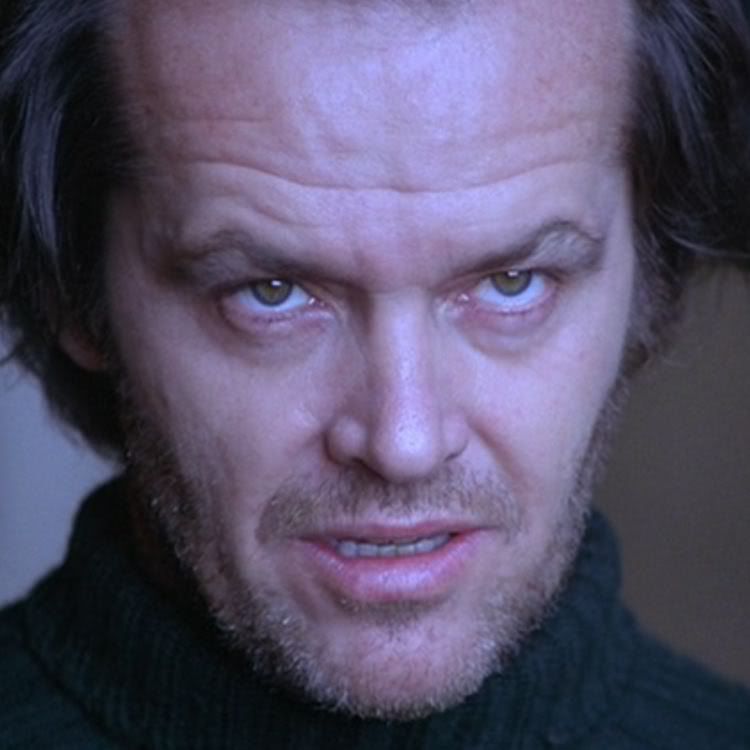
There’s no doubt that Danny is “Shining" as he talks telepathically with Dick Hallorann in the storeroom. The weird sound effect we hear is also part of the scene and alerts us to this as well as the moving Calumet can I just showed you. How can you say that Jack is not doing the same thing when Stanley Kubrick has us hear the exact same weird sound effect as he visions Wendy and Danny playing outside throwing snowballs at each other in the snow (:46 into the movie)? When Dick Hallorann "Shines" and sees the vision of room 237 again we hear a similar sound effect (1:11 into the movie).
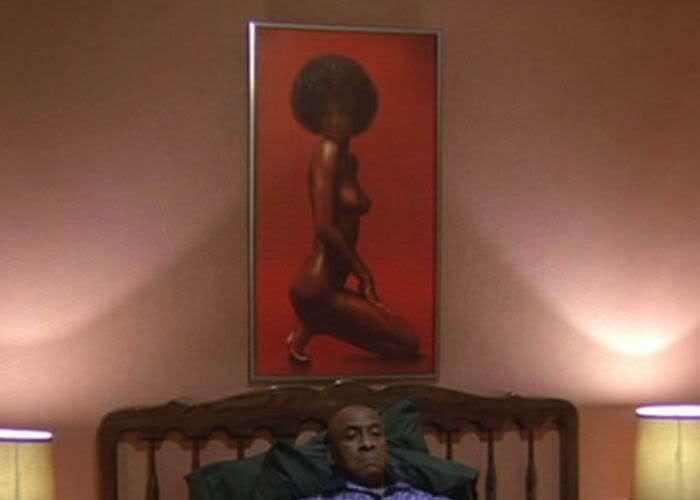
Listen when Jack walks into The Gold Room (1:03), “Shines” and has his first vision of Lloyd. We hear a similar sound again.
Are Danny and Wendy actually seeing the same vision of the bloody elevator?
Again, he doesn't overdo this but each character has at least one scene where Stanley Kubrick intentionally does something that tips us off to their special ability. When Danny sees his vision of the bloody elevators we know it’s a product of his “Shine” (:11 min. into the film). This is never disputed. Then how can it be any different when Wendy has frame for frame the exact same vision of the bloody elevators at the end of the movie - 2:14 into the film (:11 min. from the end). If this happened just once there would be no way to use it as proof of the characters special ability. But when it happens to all of them what Stanley Kubrick has done becomes obvious. The symmetrical placement of these two scenes can't be ignored (:11 seconds from the beginning of the film and :11 seconds from the end).


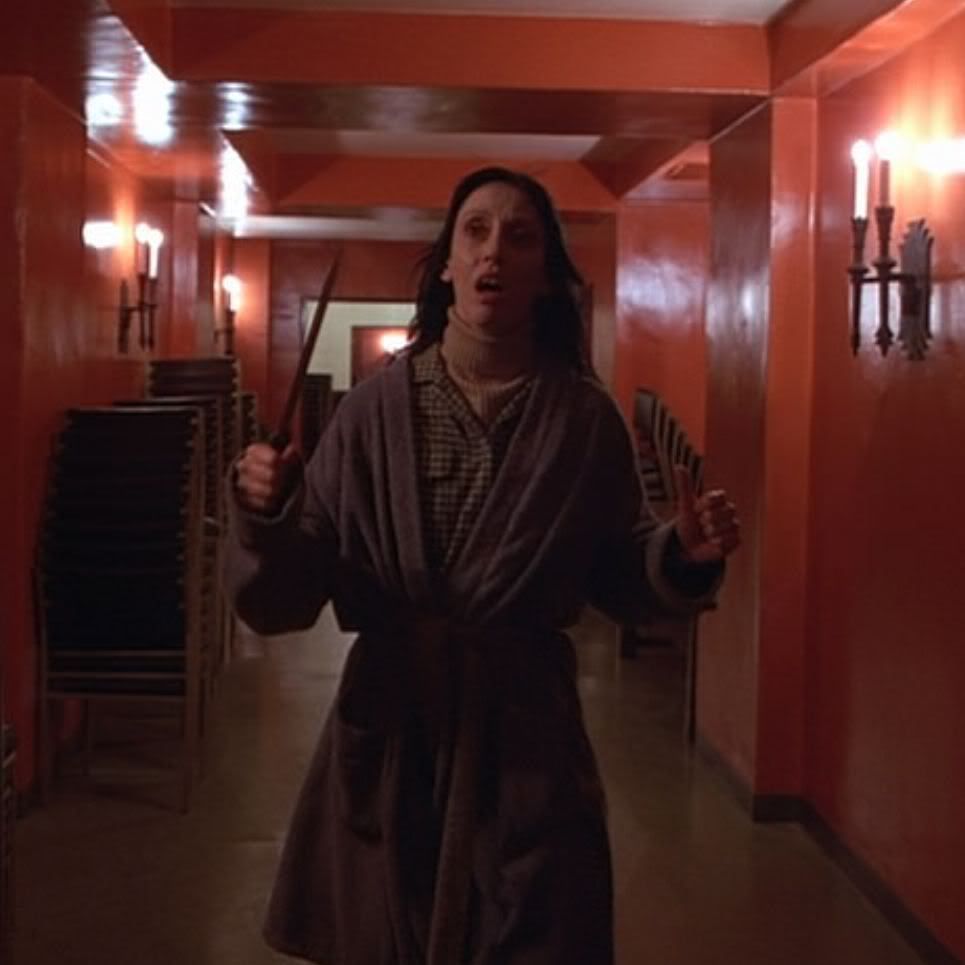
They're both seeing exactly the same vision of the bloody elevators and you cannot say that Danny is “Shining” when he sees his vision and Wendy is not “Shining” when she sees her vision. They're exactly the same. Danny doesn't "Shine" it into her head either. Stanley Kubrick goes way beyond meticulous to show us that this just doesn't happen here because the scuff marks on the floor in front of the elevators point us to something important. The point of view is different each time they see the bloody elevators so even though both are seeing the same thing frame for frame each vision is totally unique to that character. The scene was shot with two adjacent cameras (Wendy’s on the right and Danny’s on the left) giving each character their own unique point of view of the same event. What thought Stanley Kubrick put into this project.
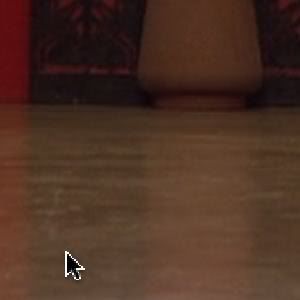
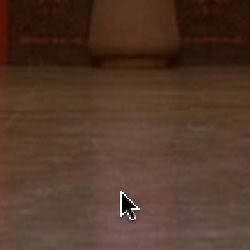
Is it Tony, or someone else that shows Danny his first vision of The Overlook?
This is how I knew Jack was “Shining” images into the other’s minds. Stanley Kubrick puts it in the dialogue. Look closely at what Danny says just before the first vision in the film;
Danny; Tony, why don't you want to go to the hotel?
Tony; I don't know.
Danny; You do too know, now come on tell me.
Tony; I don't want to.
Danny; Please....
Tony; No.
Tony says a definite, “No” and in this situation “No” means “No”. It’s crystal clear. He refuses to show Danny anything about the Overlook when asked. The vision of the twin elevators that Danny sees in his mind is coming from somewhere else. It’s coming directly from someone that is looking at something inside The Overlook at that very moment. The vision is coming from his father.
I’m going to use this quote a lot, “Not things that anyone can notice, but things that people who 'shine' can see." Stanley Kubrick is explaining to us that the visions the Torrance’s see inside The Overlook can only be experienced by those who possess the “Shine”. Well Wendy and Jack both see visions. From the very definition we’re given by Stanley Kubrick; they both posses the “Shine”. Wendy's ability becomes more apparent in the film in direct proportion to her state of mind. But just like with Jack, it happens only after they both see something inside The Overlook. It’s something on Jack's desk. Just like Dick Hallorann and Jack in the storeroom, Wendy’s doing the exact same thing. The pictures Stanley Kubrick placed in his film can’t be changed. They all prove the same thing. Wendy can “Shine”; she sees the same visions as Danny, “Not things that anyone can notice, but things that people who 'shine' can see."
Why does Dick Hallorann return to The Overlook?
Stanley Kubrick has Mr. Ullman’s tie changes color right before our eyes for a reason in these two sections of the same scene.
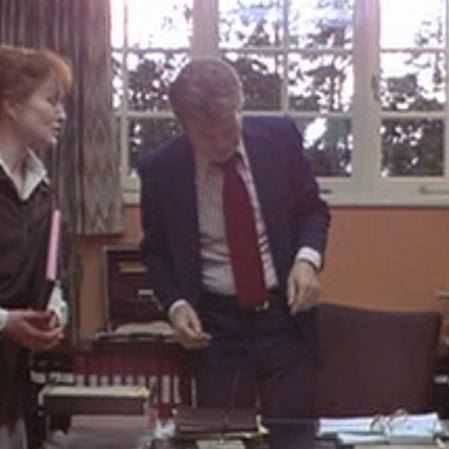
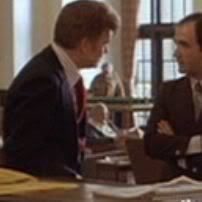
In the novel Dick Hallorann says this to Danny, "If there is trouble ... you give a call.” and Danny calls him several times. In the movie Dick Hallorann never says this line and Danny never calls him for help. There’s another reason why Dick returns to The Overlook from sunny Florida. Here’s the explanation he gives on the phone to Larry Durkin at the gas station, “They've turned out to be completely unreliable assholes. Ullman phoned me last night, and I'm supposed to go up there and find out if they have to be replaced.” We can only go on the information that Stanley Kubrick has given to us and it’s the only explanation there is. Any other interpretation is just a guess, or wishful thinking on the part of those who don't agree with me. What’s in the dialogue is crystal clear as Dick Hallorann’s character never lies or exaggerates anything to anyone in the film. How can this statement be true? He explicitly says that Mr. Ullman ordered him to go back to The Overlook and it’s the only reason given by Stanley Kubrick for his return. But how on earth does his boss know what’s happening at the hotel as we know that Wendy tells the ranger the phones are out before the scene in the airport? Mr. Ullman knows because he has the same ability to see visions as the others. There’s absolutely no violation of the movies reality here. Stanley Kubrick simply has another person viewing the same vision of Jack walking into room 237 as Dick Hallorann is seeing, and Mr. Ullman is viewing it at the exact same time. Jack “Shines” the image into their minds and now they know at that moment that Jack's seen something inside the hotel that he shouldn’t have been looking at. He’s slipping into insanity; it’s been cleverly hidden from the audience that Mr. Ullman obviously knows this also. He’s a good general manager and Mr. Ullman got on the phone immediately after seeing the vision of Jack in room 237. It really isn’t very important but Stanley Kubrick being the ultimate perfectionist gives us solid information that this is what happens. We know how much time passes between Jack going into room 237 and Dick Hallorann’s flight. Stanley Kubrick shows us the time in black frames and it’s 8 AM the next morning when Dick Hallorann flies back to The Overlook. According to the previous black frame Jack “Shines” in room 237 on Wednesday night. So when he says this to Larry the next day, “Ullman phoned me last night” we know he isn’t lying about the time he received the call.
Like John Lennon sang in the song, "Instant Karma", that inspired the title of Stephen King’s novel.... “We all ‘shine’ on”! Those words from the song have been turned into the movie's reality. In Stanley Kubrick's Overlook that means Mr. Ullman too. He “Shines” and watches the exact same freak show image of Jack in room 237 with the old woman that Dick Hallorann is seeing. It has to be the supernatural; in "The Shining's" reality there’s no other explanation as to how his boss would know something was wrong and order Dick Hallorann back to The Overlook. It’s now Stanley Kubrick’s "Overlook" and he can give the special supernatural ability to "Shine" to any character he wishes. Again, Stanley Kubrick puts this in the dialogue so there’s no confusion to the fact that he’s doing it, “But, there are other folks though mostly they don’t know it, or believe it”. When Grady says this line to Jack in the bathroom, “Did you know, Mr. Torrance, that your son... is attempting to bring an outside party into this situation? Did you know that?” Jack is speaking to his subconscious, Grady, who already knows that Dick Hallorann is on his way back to The Overlook because he “Shined” to him. The proof that Danny doesn't call for help is in this fact; Dick isn’t alerted when you would expect, after Danny is strangled. It happens only when Jack walks into room 237 because he’s the one, not Danny, who “Shines” the vision into the others minds. Dick Hallorann is truly the hero of this story as Wendy and Danny would have still been stranded at the hotel if he hadn’t come back with another Sno-cat. It makes no difference whether his return to The Overlook was because he was ordered back by his boss or because of genuine concern for the Torrance’s. Heroes are ordered to do things by their bosses on an everyday basis. It doesn’t make them any less of a hero.
Stanley Kubrick's deception here is that the audience is supposed to think that Danny is “Shining” the vision of Jack walking into room 237 into Dick Hallorann’s (and Mr. Ullman’s) mind; but he isn’t. In the film he doesn’t use his “Shine” to get Dick Hallorann to come back to The Overlook and he never asks anyone for help. In fact the only time he ever says anything that could even remotely be interpreted as a call for help is when he says this, “Tony, I’m scared” after seeing the vision of the hacked up Grady twins in the hallway. In Stephen King’s novel he loudly calls for help several times but Stanley Kubrick shows us a mirror image of this and in his Overlook Danny never seeks help from anyone at any time.
How is it that in their discussion in the kitchen Danny knows about room 237, and Dick Hallorann doesn’t?
“What about Room 237?”
“Room 237?”
“You're scared of Room 237, ain'tcha?”
“No I ain't.”
“Mr. Hallorann, what is in Room 237?”
“Nothing, there ain't nothing in Room 237”
Dick Hallorann knows nothing about that room, and Danny brings it up in their discussion in the kitchen. Look closely again at what happens in the scene just before Jack walks into room 237. Dick Hallorann “Shines” as he lies in bed in Florida and what he sees is not Danny frothing in his bed but the open door with the red 237 room key in the lock. We the audience, not Dick Hallorann, are the ones who see Danny shaking and spitting as he sits in his bed. Then Stanley Kubrick quickly cuts back to what Dick Hallorann is seeing in his vision, Jack inside of room 237. You may be wondering how I’m so sure about all this? Look very closely at what happens next in the scene and you’ll realize Stanley Kubrick is showing us that Dick and Danny are seeing two entirely different visions. This is exactly the same as what I showed several paragraphs ago with the bloody elevators. Each character is seeing their own unique vision from their own perspective. Through most of this scene we’re watching what’s happening to Jack, from his point of view. He enters the bathroom, the young woman gets out of the tub, they walk towards each other, embrace, kiss, and ultimately Jack sees the old hag facing him in the mirror - laughing. Then Stanley Kubrick cuts back to Danny as he sits in bed scared out of his wits. Danny's now remembering the vision that he experienced earlier and told Wendy about; the old hag rising out of the tub. It’s obvious they’re both seeing something entirely different here as we watch her get out of the tub twice. Just to make sure there’s no confusion about this Stanley Kubrick has different makeup on the woman in each of the visions. It’s two separate visions they're both looking at. Danny is reliving the vision he saw earlier when he was strangled during Jack’s nightmare. But being strangled by the old woman was all a vision. It wasn't what really happened. Jack tricked him and made him think that it was her and not his own loving father that was doing it. I know what you're thinking. How could Danny have marks on his neck? Jack has the ability to "Shine" visions into the other's minds. He also has the ability to move things with his mind. Anything could have been wrapped around Danny's throat when he was tricked into believing he was in room 237 by his father. Danny never actually entered room 237, Jack made him think he went in it. In the novel at first Wendy thinks it’s Jack that hurts Danny but she’s wrong. In the film Stanley Kubrick reverses this and she thinks it’s the old woman. But here it’s Jack that did it.


If Danny was trying to contact Dick Hallorann both would have to be seeing the exact same vision, yet the perfectionist director cleverly hides it so well; they obviously aren’t seeing the same thing. Again, it’s Jack who “Shines” that vision of room 237 into Dick Hallorann’s (and Mr. Ullman’s) mind. He possesses the strongest “Shine” and again that’s why Dick Hallorann is unable to use his special ability to foresee what’s going to happen to him back at The Overlook, as he walks right into an ax. Look closely as there are two other things that should be noted about Room 237. It has no windows, only mirrors for Jack to see himself in, and the most important thing to notice; Room 237 has no TV.
But what if you believe Dick Hallorann is lying to Larry Durkin about Mr. Ullman calling him, or lying or exaggerating about anything else in the movie (click here if you believe this could be true)?
How do we know it’s not spooks, ghosts, or The Overlook itself that’s causing the paranormal movements that we all see when someone “Shines”?
Over ninety five percent of the movie is shot inside the hotel yet there are several scenes that take place outside of the hotel and these supernatural movements also happen in them. This can't be ignored. We know for sure Danny has a supernatural ability. After he "Shines" and sees the vision of the bloody elevators watch the yellow and red dwarf Dopey as he makes it disappear from his bedroom door long before he’s under the influence of or ever enters the hotel.

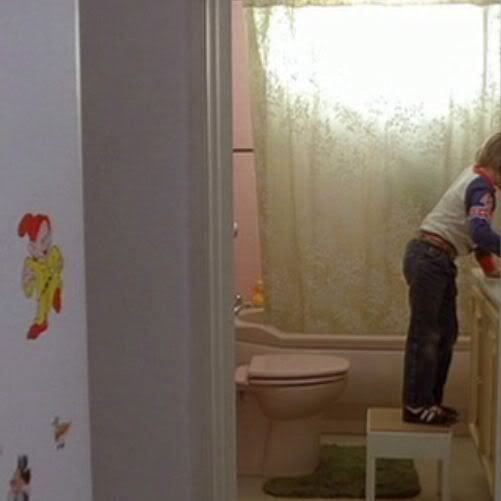
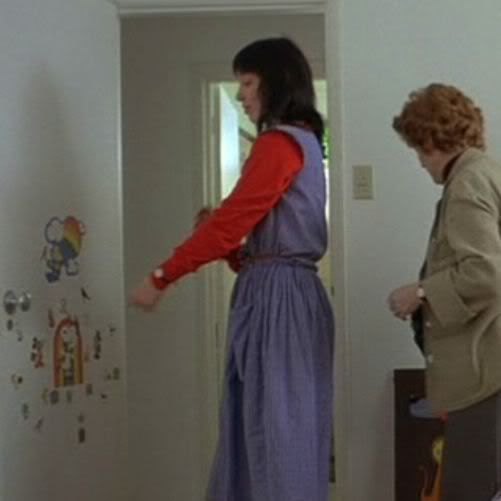
In sunny Florida, Dick Hallorann "Shines" when he sees room 237 and makes the red painting above his headboard disappear.

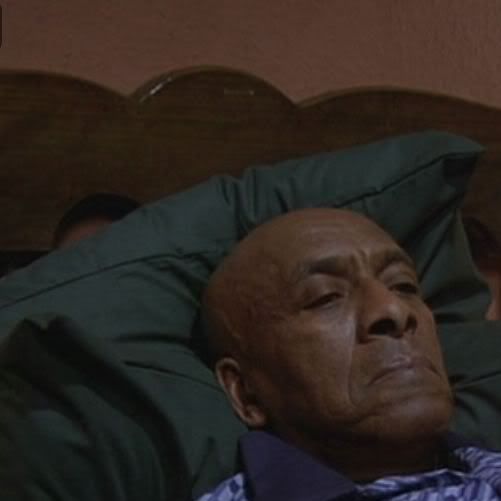
There's no other explanation! The exact same thing happens outside of the hotel and well before Danny ever gets there. The characters posses a supernatural ability that enables them to see visions and talk to each other telepathically; it also enables them to alter their surroundings. This is what the movie is about a supernatural ability; "The Shining", and the "Shine" is the only supernatural ability in the film. What a brilliant way Stanley Kubrick chose to alter their special ability from the novel (where they weren't able to influence their surroundings). In his visual realm he made the character’s supernatural ability look like a common movie mistake. Other characters also have this ability to “Shine”; it’s in the dialogue. Stanley Kubrick’s talking about someone!
“But, there are other folks though mostly they don’t know it,
............................ or believe it”.
.....................And one of them is going completely insane.
How could the characters in the film not know what’s happening if things are disappearing, reappearing, moving around or changing color around them?
You might be wondering about this; how could the characters not know it when something changes around them? The answer is found in a line I quoted before from Stephen King's novel when Danny talks about what he noticed (the moving Hedge Animals) and says this, "It only happens when you're not looking.” (chapter 34 page197). Stanley Kubrick takes this seemingly insignificant sentence and makes it come alive in his movie. If you observe the characters closely they're never looking directly at the object that moves. Most, like the Calumet cans, are directly behind their heads. Remember “The Shining” is a movie about a supernatural power, stuff happens. In Stanley Kubrick's visual realm the movements are intended for the audience not the characters. He reverses the sentence from the novel and now in the movie, "It only happens when [the audience is] looking.” But you do have to know exactly where to look. What's happening here couldn't be more obvious. In the reality of the movie this must have an explanation. The definition of psychokinesis (a.k.a. telekinesis) is: the power to move a physical object by thinking about it without the application of physical force. Stanley Kubrick has made it quite obvious that when they "Shine" cast members in his film also possess the ability to supernaturally move or change the color of items. There are 4 main characters in this story and Stanley Kubrick changes the number who can "Shine" along with altering their abilities.
But Dick Hallorann never says anything to Danny about telekinesis as they speak about the “Shine” in the hotel’s kitchen?
This means nothing – he doesn’t talk about “ghosts” either! Hiding things from the audience was something Stanley Kubrick definitely achieved and making what he was doing overly obvious would have spoiled the deception. The telekinesis they possess has been hidden, even from the character’s themselves. In fact as you will see later on Dick Hallorann simply doesn’t talk about anything he doesn’t know about. Again, "It only happens when you're not looking.” If he knew everything there would be no movie and the fact that he doesn't know everything means nothing. This is discussed by Stanley Kubrick in his interview about the novel with Michel Ciment. "If Danny had perfect ESP, there could be no story. He would anticipate everything, warn everybody and solve every problem. So his perception of the paranormal must be imperfect and fragmentary. This also happens to be consistent with most of the reports of telepathic experiences." The same applies to Dick Hallorann. Again we must realize that most of the characters don't know they possess the "Shine". Dick Hallorann and Danny seem to be the only ones who know. Stanley Kubrick tells us this clearly in the script. The others simply “don’t know it”.
Who opens the storeroom door for Jack?
Jack and Dick Hallorann both have the same supernatural ability. It’s no stretch of the movie's reality to see that Jack also “Shines” when he’s locked in the storeroom. It’s obvious that his ability to supernaturally move things (telekinesis), and not the ghost of Delbert Grady, is what unlatches the storeroom door releasing him. It’s exactly the same as the piece of paper that he magically reinserts into his typewriter. If you don't believe what I’ve shown already in this article then it’s actually a real ghost that lets check out the storeroom. You’ve figured it all out! But do you really believe the explanation could be that simple? Again, this is what "The Shining" is about, people with an unusual ability. There’s no law that says Stanley Kubrick can’t change, or hide from the audience, which cast members have this special ability, and just exactly what that ability is. It’s precisely what he did and if you never noticed this just look again at the unmistakable similarities in these pictures. Wendy's state of mind is desperate and after she drags Jack into the storeroom her ability to do the same thing becomes quite apparent as she changes the direction the knives are facing before she picks one up.
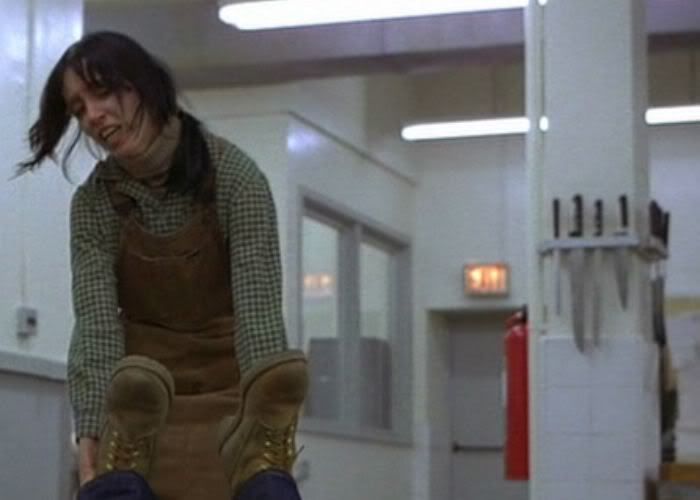
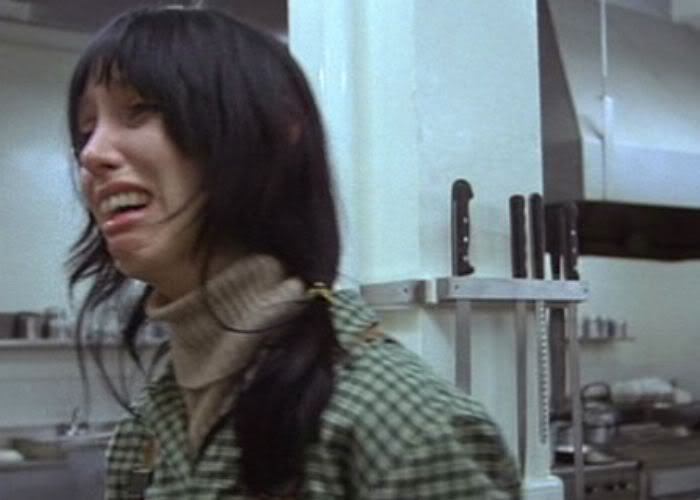
Later in the bathroom, she moves the same knife again. She throws it in the sink with the handle to the right, yet later when picking it back up she reverses the handle’s position to the left without ever touching it.
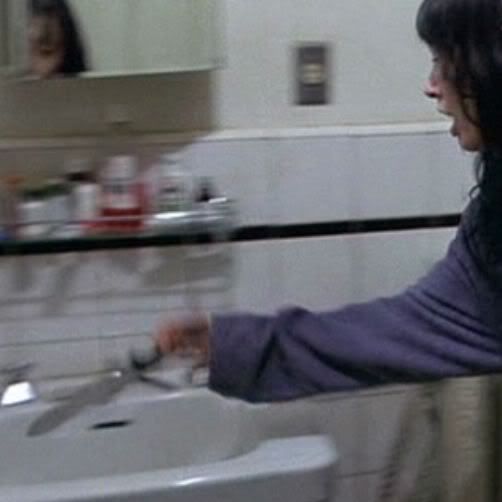
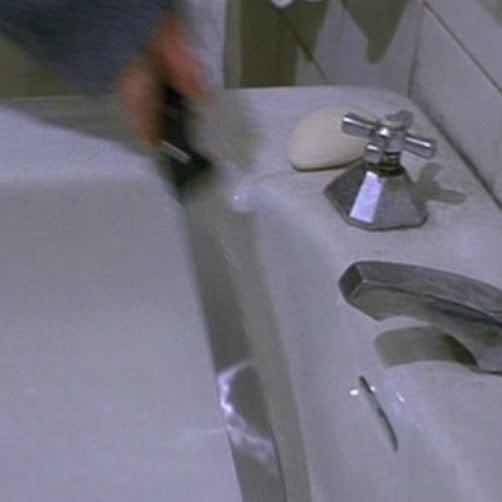
In the end when she doesn't need it anymore Wendy throws the knife down into the packed snow and now it disappears.
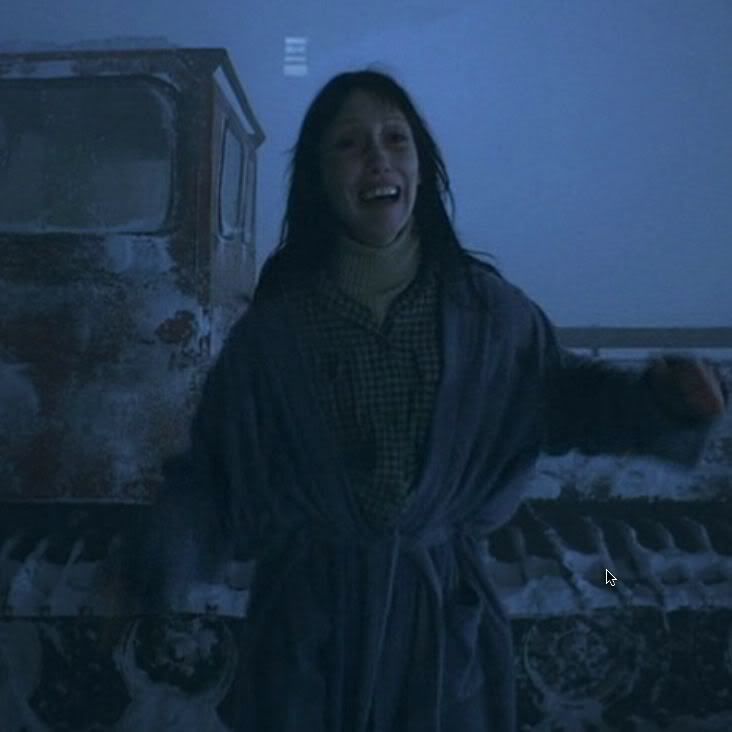
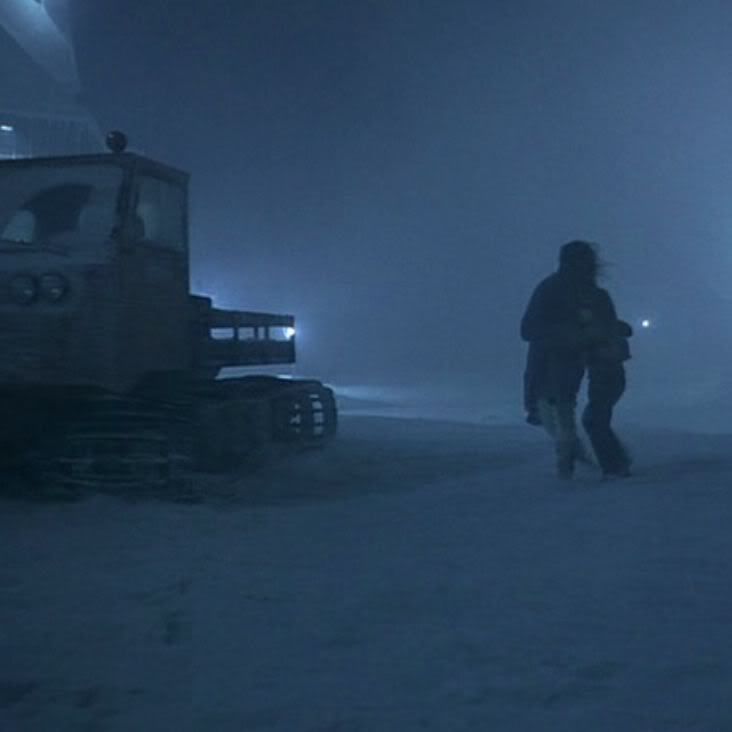
The knife also reverses position between shots when Danny "Shines" and Tony writes "Redrum" on the bathroom door. The knife reverses position each time we look at it.
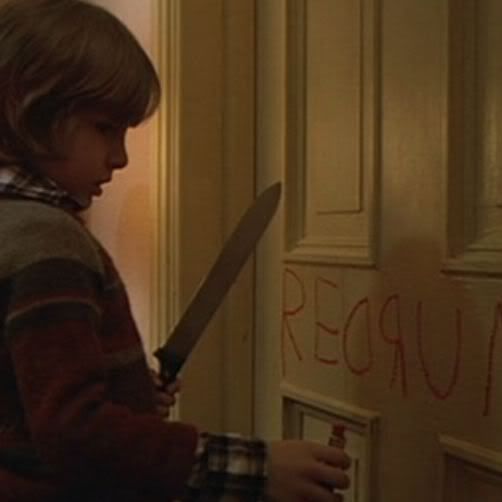
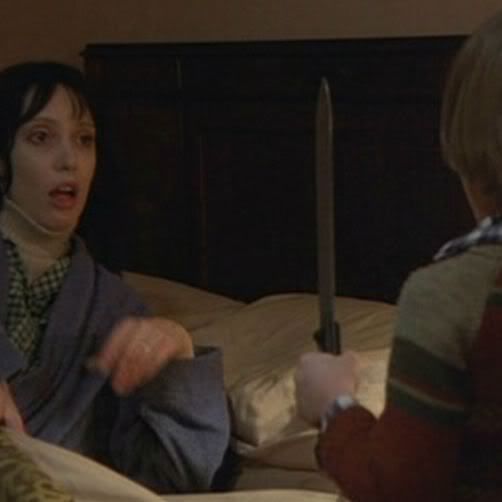
This shot is continuity error heaven. But Stanley Kubrick’s fooling all the movie mistake hunters out there again because what’s really important here but hard to notice are what appear right out of thin air.
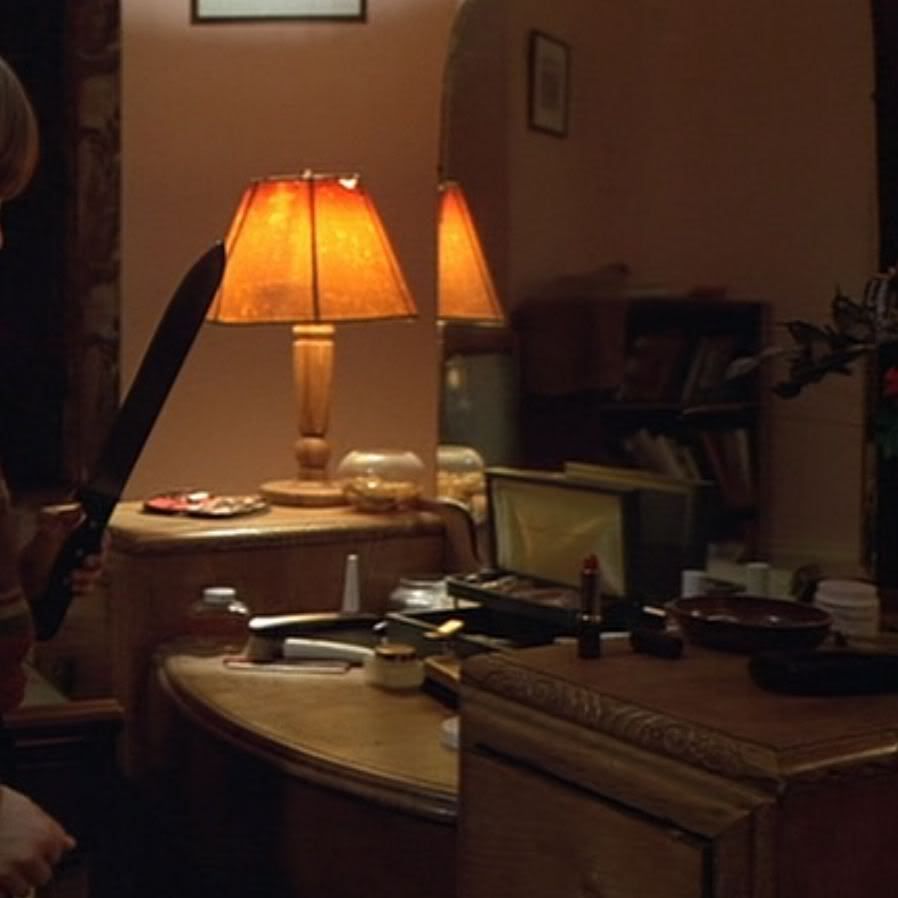
When she looks at Redrum written on the door every single thing on the bureau has moved.
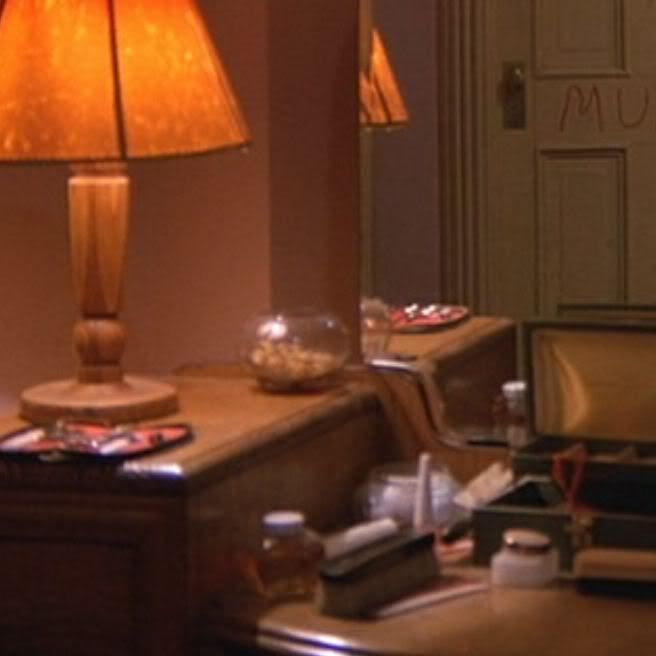
But it's the red pearls that are important. They don't move, they magically appear right out of thin air because Wendy has seen something inside The Overlook that has triggered her ability. After this point in the film all the cast member’s visions are hers.
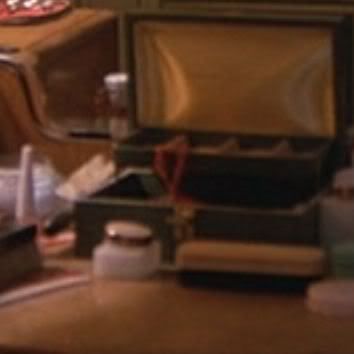
Does Wendy “Shine”?
“Not things that anyone can notice, but things that people who 'shine' can see." Wendy’s special power to “Shine” means she also has the ability to see visions of people that have been at The Overlook in the past, just like Jack and Danny’s vision of the old woman in the novel, Mrs. Massey (Chapter 38 - Page 217), who committed suicide in room 217. “Shining” also explains what this vision that Wendy has as she walks up a flight of stairs right at the climax of the movie, is all about (A shot that took 36 takes). Many believe this is Horace Derwent (Chapter 1 - Page 6) with Roger (Chapter 41 - Page 228) who are both mentioned in the novel as people who were at The Overlook years before. Horace Derwent is a Howard Hughes type who once owned the hotel, “It stood vacant until the end of World War II, when it was purchased and completely renovated by Horace Derwent, millionaire inventor, pilot, film producer, and entrepreneur." (page 6, chapter 1) When you read the novel the guy in the film looks nothing like him. Here’s Stephen King’s two descriptions of Derwent, “… after that a story on Derwent himself, a balding man with eyes that pierced you even from an old newsprint photo. He was wearing rimless spectacles and a forties-style pencil- line mustache that did nothing at all to make him look like Errol Flynn. His face was that of an accountant. It was the eyes that made him look like someone or something else.” (page 107, chapter 18). The second description is here, “The man beside the woman in the sarong had removed his fox head and Jack saw that it was Horace Derwent, his pallid blond hair spilling across his forehead.” (page 235, chapter 43). Many believe the guy in the dog costume is Roger from the novel and their relationship is related here as Jack speaks to a woman at the party, “[Harry’s] AC/DC, you know. Poor Roger's only DC. He spent a weekend with Harry in Cuba once, oh months ago. Now he follows Harry everywhere, wagging his little tail behind him. "She giggled. The shy scent of lilies drifted up. "But of course Harry never goes back for seconds, not on his DC side, anyway…” (page 238, chapter 43) In the novel what Stanley Kubrick depicts in this shot never happens at The Overlook. In fact believing that these gentlemen are from the novel is just a guess. In the movie Stanley Kubrick never tells us or even hints at who they are. Think about this; how do you know that it’s a man in the costume? Can you prove it’s a man and not a woman under there? It's the same with the woman in room 237. At first we see a young woman. But there’s no young woman in the novel’s bathroom yet everyone presumes that the women in the film is still Mrs. Massey. But we really don't know for sure. And with the film's Grady also. In the novel the ghost is Charles Grady yet in the film the ghost is Delbert Grady. He’s different.
The reason the Torrance’s can see what appear to be specific guests from the hotel’s past will really surprise you and I discuss this in a later section "Is The Overlook Haunted or does it "Shine"?.
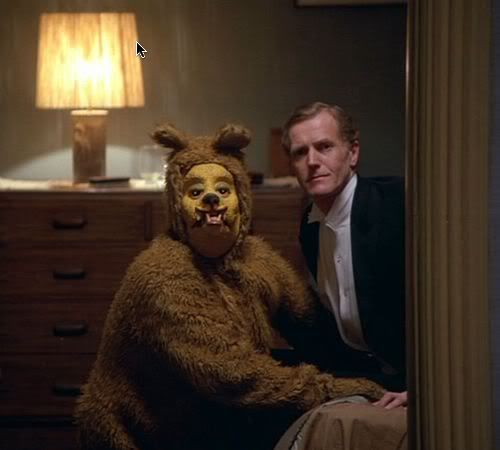
After Wendy looks into something on Jack’s desk she sees a vision of the old gentleman who says, "Great party, isn't it?" Watch the scene closely as she reacts before seeing the vision behind her. Than she turns around to see him. Everyone believes he’s is a vision of a guest from The Overlook’s past.

He's mentioned in the novel but he’s totally different as we read about a masked guest at Horace Derwent's recurring 1945 costume party and Wendy sees him as Jack chases and tries to kill her; “She fled stumblingly down the main corridor, hands pressed to her side. The door to one of the rooms jerked open and a man with a green ghoul mask on popped out. "Great party, isn't it?" He screamed into her face, and pulled the waxed string of a party-favor. There was an echoing bang and suddenly crepe streamers were drifting all around her.” From Chapter 52 (Wendy and Jack, page 279). If you look closely in the film he's not a guest at all, he's the maître d' Jack meets as he first walks into the party.
Who moves the entrance to the hedge maze at the end of the film?
If you look closely at the end of the movie the entrance of the hedge maze moves closer to Danny before Jack chases him into it. Early on we see this area several times, and also in the hedge maze maps. There’s only one entrance to the maze and it’s not on the wall facing the hotel. Later the entrance moves from its original position to the wall 90 degrees to the left, and we now see it facing The Overlook. This can be seen best just before they escape the hotel as Danny walks straight into Wendy’s arms at the end of the movie. She’s standing right in front of the rear entrance of The Overlook where Dick Hallorann parked the Sno-cat. Earlier we see this same spot and there’s no entrance there. At first I thought Danny, in order to save his life, "Shines" and moves the entrance closer to him. But if you think about it Stanley Kubrick hardly ever shows Danny using his special ability in the movie. It’s Jack that moves the entrance in order to entice his son into the maze where he’s sure he’ll be able to trap him. Stanley Kubrick even hints about this in the Roadrunner cartoons that Danny watches - Danny’s chased but never caught. You don’t think I’m right about Danny not using his special ability in the maze scene? I bet you never realized this; Stanley Kubrick has him escape from Jack by using his wits and not his “Shine”. This fact cannot be denied. It’s incredibly well hidden but true. In a way Danny’s much smarter and able to protect himself better than any of the others (Dick “Shines” yet he ends up dead, all the “Shine” in the world didn’t help him). Stanley Kubrick has Danny survive without having to rely on his special ability. Stanley Kubrick even shows us a mirror image of, “Hansel and Gretel” (mentioned by Wendy). In Grimm’s Fairy tail the children are not trying to get away. Hansel leaves the bread crumbs as a way to find their way back home. In “The Shining” Danny fools his father in a similar yet opposite way. Now he retraces his footsteps in order to get away. Remember this, Danny never asks for help from anyone in the film at all – especially the two times his life is in peril. When he’s strangled and chased by his father, he doesn't use his "Shine" . We hardly ever see him use his supernatural ability in the movie to do anything except see visions that are “Shined” into his head by his insane father. He doesn’t possess anywhere near the “Shine” that his father does either. In fact if you look closely at the visions he sees throughout the film they’re all “Shined” into his mind by others. It’s never the other way around.
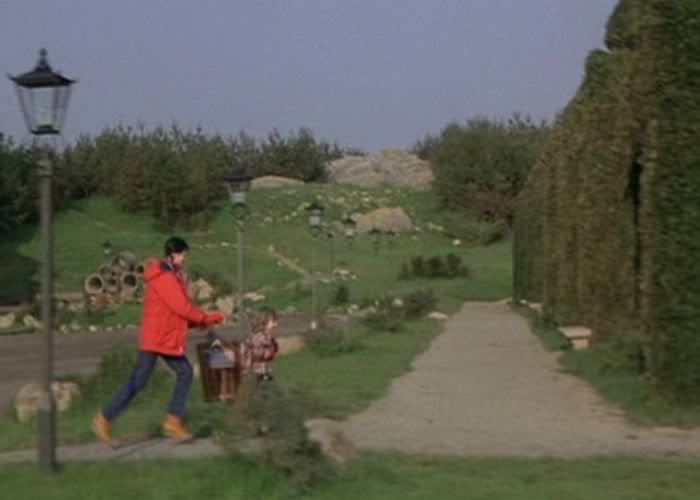

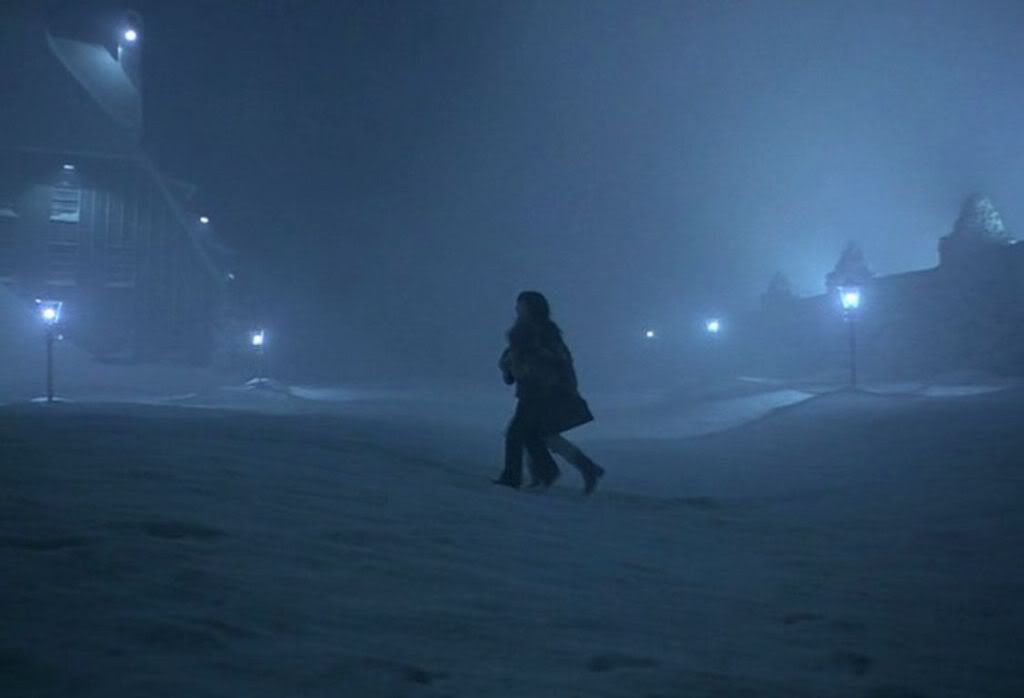
Is The Overlook itself a maze?
Absolutely not! Even though Wendy comments about needing to leave a trail of bread-crumbs, from Grimm’s fairy tail “Hansel and Gretel”, no one in the film ever gets lost inside The Overlook. Even in the Hedge Maze no one (except the crew) ever gets lost. At the end Jack looses his mind as he chases Danny, he isn’t even trying to get out of the maze. He just wants Danny and dies trying to find him. Stanley Kubrick’s real maze is hidden somewhere else in the film. He did say that the hotel’s “labyrinthine layout” produced an eerie atmosphere. He also commented that the inside of The Overlook was constructed so it, “mirrored the kind of camera movements which took place in the maze”. But the reality still is, no one in the film ever got lost. There are lots of crazy websites from writers who are totally lost inside “The Overlook’s” maze though. This is how you can test whether or not someone has done their homework when it comes to “The Shining”. Anyone who doesn’t utilize, or choses to simply ignore, Stephen King’s novel and the dialogue from the film is creating a maze for you to get lost in.
Where did Stanley Kubrick get the idea to use continuity errors for the hidden supernatural movements indicating each character’s telekinetic abilities?
I’ve often wondered if Stanley Kubrick might have gotten this idea of inserting deliberate continuity errors from Alfred Hitchcock, a director he greatly admired who gives us brilliant examples of deliberate continuity errors that aren't part of the plot in his masterpiece, “The Birds”. He’s known for the cameo shots of himself that we see in his films, but there’s something else in each of his movies that audiences have missed (but Stanley Kubrick didn't). It’s the spot where he tricks us into thinking we’re looking at something when we’re actually not. One of the biggest plot points throughout “The Birds” is that there are 2 lovebirds in the birdcage, and we’re 100 percent positive of that because we’ve seen the 2 of them in there the first couple of times he shows us the cage.
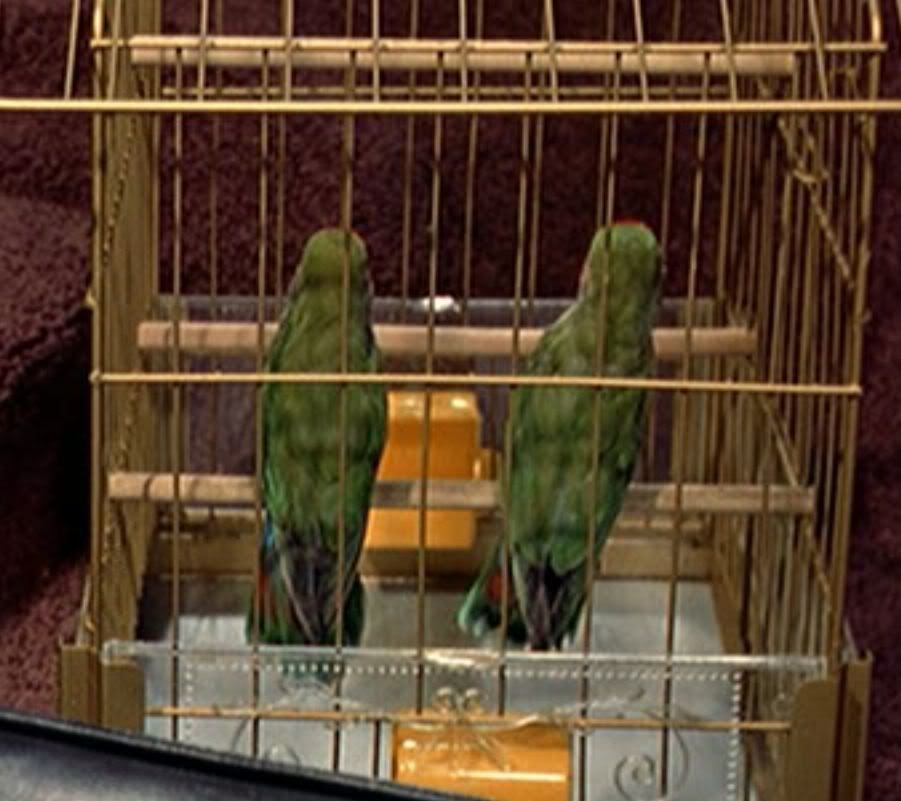
Watch what happens when Tippi Hedren brings the birdcage into Mitch’s house.
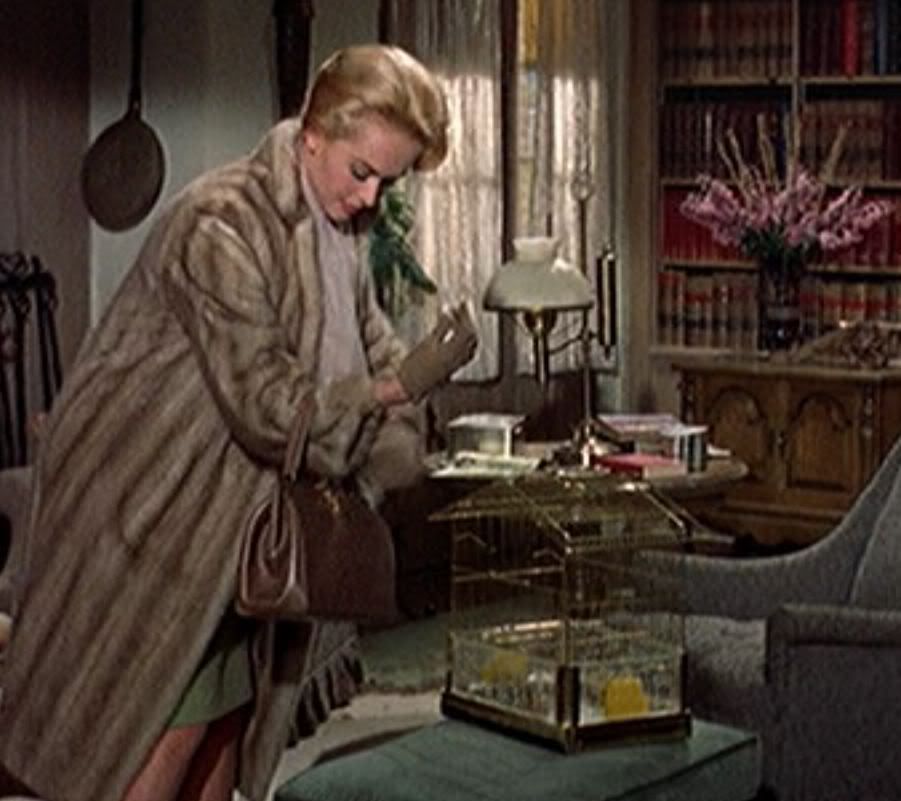

All of a sudden there are no birds in the birdcage and no one (especially her) ever notices (it’s also a different larger bird cage). Alfred Hitchcock does this all the time in his movies and must have chuckled till the day he died knowing that that no one ever noticed.
Look at the birdcage's door in this shot.
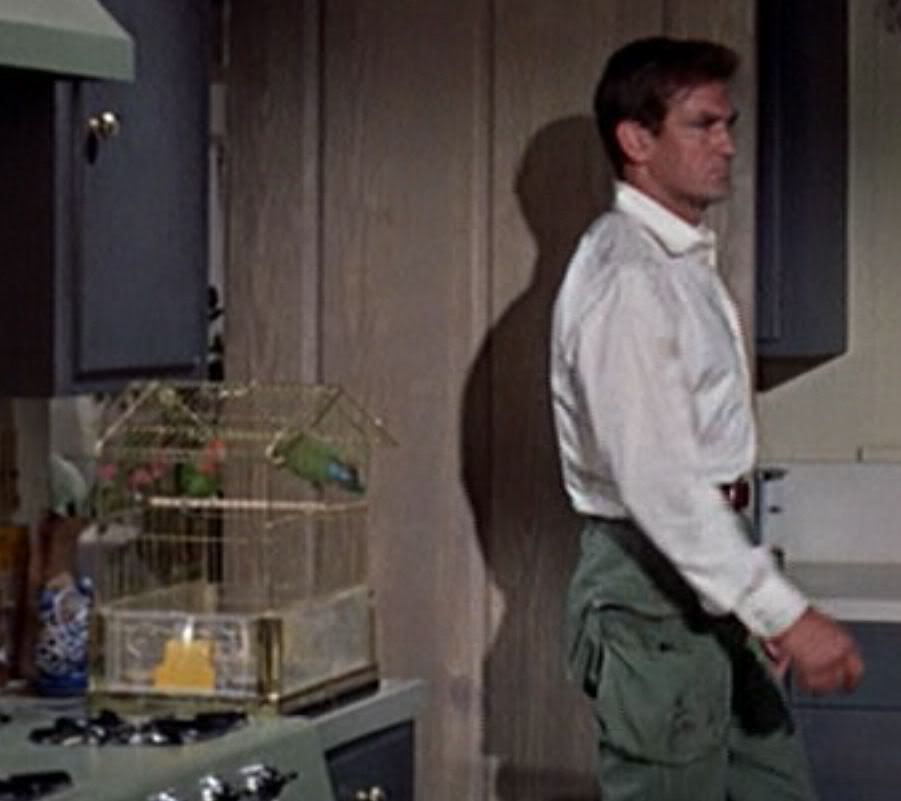
At first it’s closed than in the very next shot, it’s open.

This picture really doesn’t fit here but I always loved how they got Elvis to make a sneaky appearance in “A Hard Days Night”.
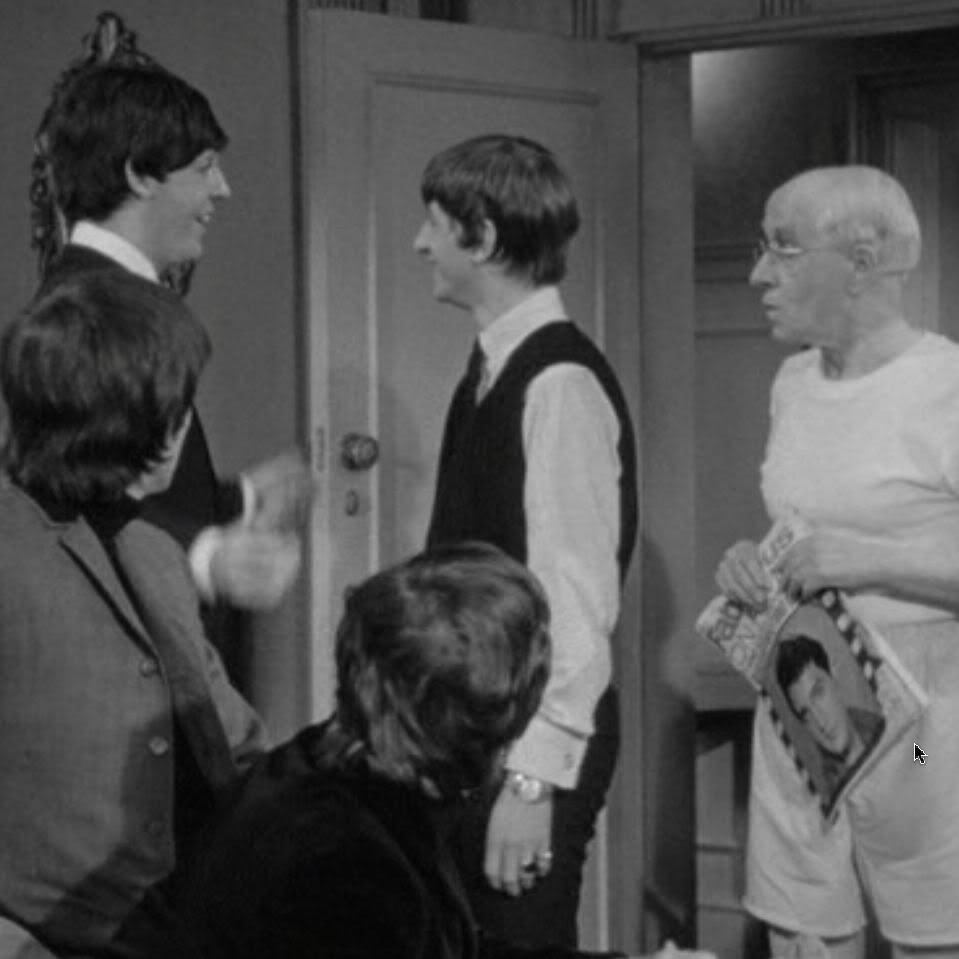
This stuff is not only in old movies; continuity errors are all over the place. Can you find the one in these two shots from “No Country For Old Men”; Frend’O.
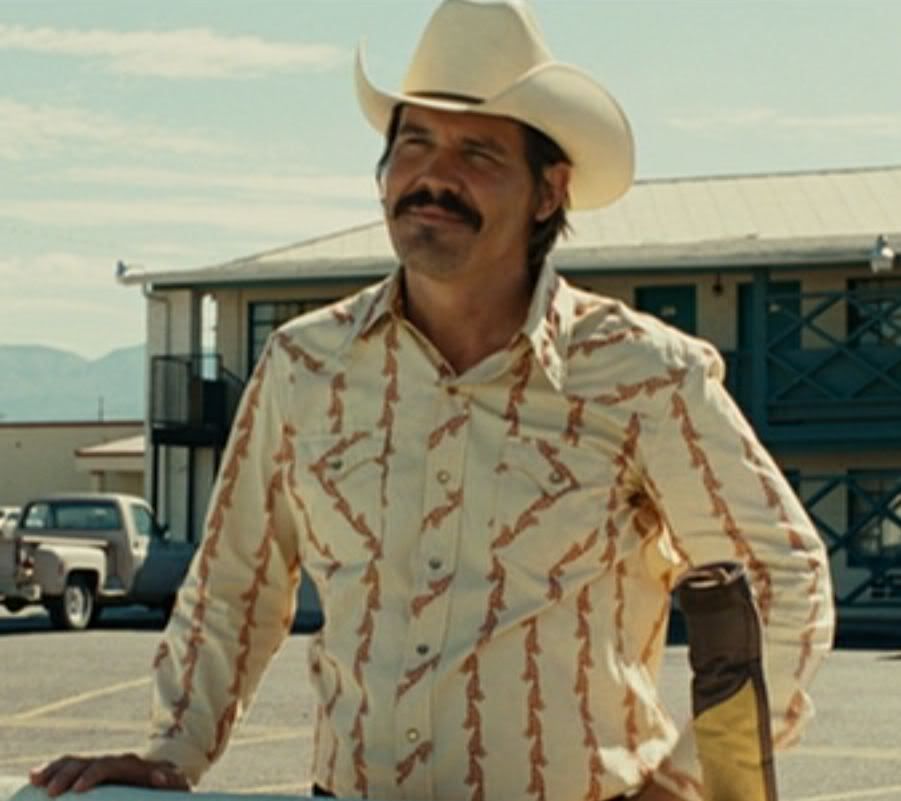
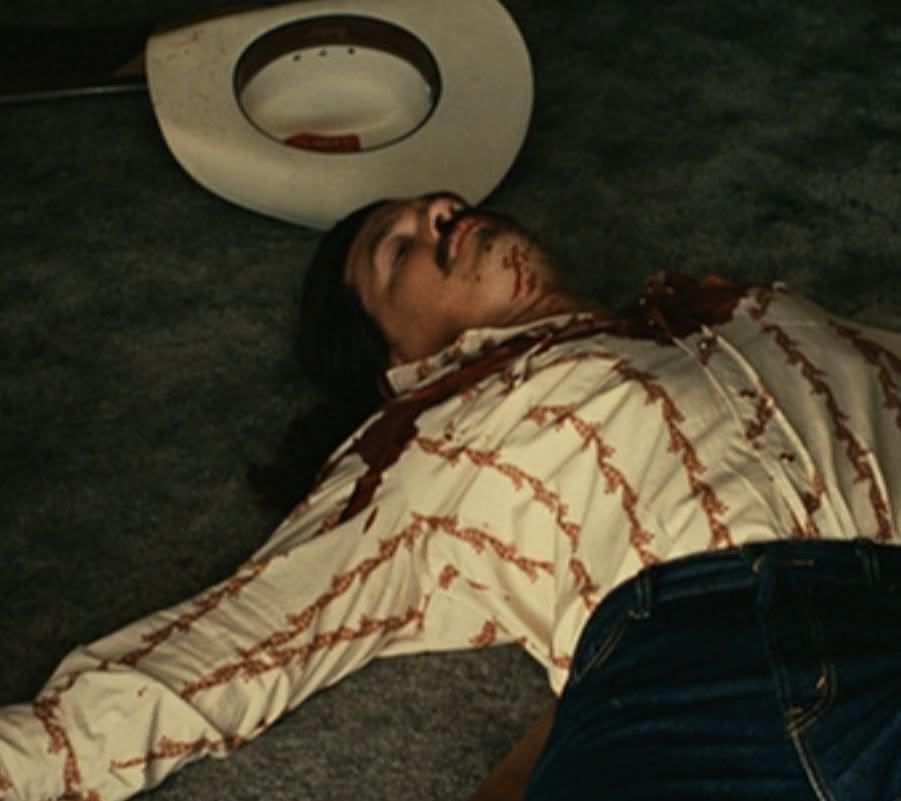
Are you sure that’s Llewelyn Moss lying there? The dead body has a different shirt on.
The visual magic of little jokes like Hitchcock got away with can be found all over the place in movies. We’re witnessing the work of craftsmen who are the best in the world at what they do, but what sets Stanley Kubrick apart from other directors is the sheer magnitude of his deception and he, like Alfred Hitchcock, must have chuckled till the day he died knowing that no one ever noticed all this. No one ever put it together and figured out what he was actually doing after all it’s just a movie mistake, right? What a brilliant deception. These are not just visual tricks in "The Shining" they’re essential for truly understanding the film. Stanley Kubrick actually used them as part of his story.
Many items move around or disappear in “The Shining” and you can see them if you know where to look (light switches, clocks, chairs, maps, bathroom fixtures, pictures, lamps, vending machines, sofas, rugs, mirrors, and almost all of the unattached Indian art work). Again, this is so well done that proving which movements, if any, were not intentional might not be possible. But we now know how he altered the three items The Overlook animates in Stephen King’s novel and it's proof that something is going on. Once you know this it becomes obvious which are the important things that move.
Some pictures of what else moves between shots in The Shining can be viewed here.
Can people who “Shine” alter the colors of their possessions or surroundings in “The Shining”?
He didn’t make this overtly obvious to the casual viewer but he alters the colors of many props in the film. Getting back to the money shot, Jack and Dick Hallorann are both doing the exact same thing, as the Red Indian can behind their head’s moves by a force beyond the laws of nature each time. There’s no question that Dick Hallorann has a special supernatural ability and it's not any different when Stanley Kubrick has Jack do the exact same thing? If something like this only happened once I would have a problem. But it doesn’t. Numbers, time codes of related scenes, props disappearing & re-appearing, and now color. No matter how he accomplished it many items change color when they shouldn’t in “The Shining”; between shots. Wendy and Jack’s apartment changes color throughout the movie and it’s what I noticed first. Either they re-painted it from a lovely peach to a light purple color during their stay there or Stanley Kubrick did it by painting, lighting or tinting. However it happened the color of their apartment changes and that’s what's important here because I feel it’s a direct result of their ability to “Shine”. Before looking at this shot I must show you something important. Jack is staring blankly at his TV set in the scene, not a window. Some of the windows in Stanley Kubrick’s Overlook are not real. At first it appears that their apartment has 3 windows, 2 mirrors and one TV set. But this is not correct, the 2 windows on the right side of the apartment could not actually exist. We see the rear of the hotel as Danny escapes The Overlook from the bathroom window at the end of the film. There’s no way that those windows could possibly exist as their room is not at the side of the hotel. It's in the rear. As I mentioned earlier Mr. Ullman’s window in his office behind his head couldn’t possibly exist either as we know that after Wendy sees the old maître d' who says, “Great party, isn’t it” she runs down the hallway right behind his office. Some believe this is supposed to mix up our spatial orientation while viewing the film. I don’t, as most are not noticeable because of the wide spacing between the shots in the film. I feel Stanley Kubrick is just playing with the audience. Trying to see how much we will notice.
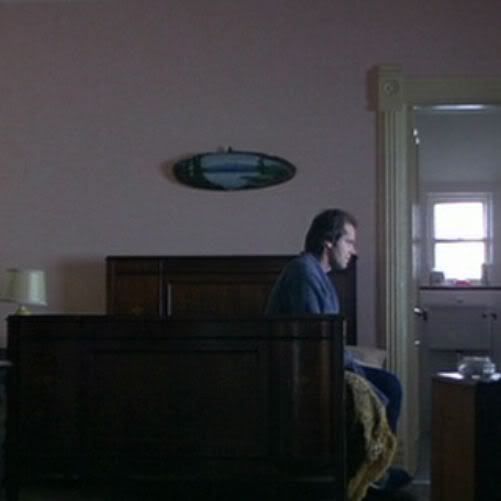
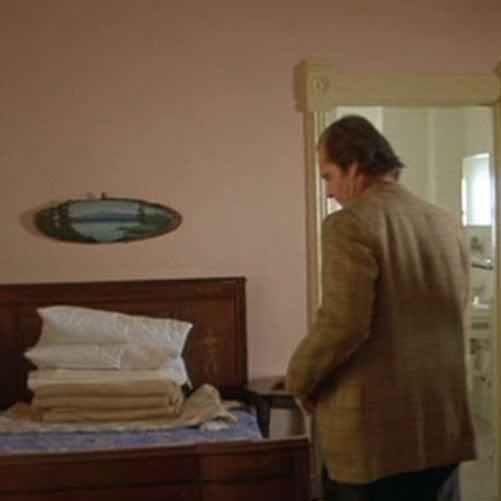
The Torrance's bedroom is not lit differently as the back wall has also been painted the same light purple color.
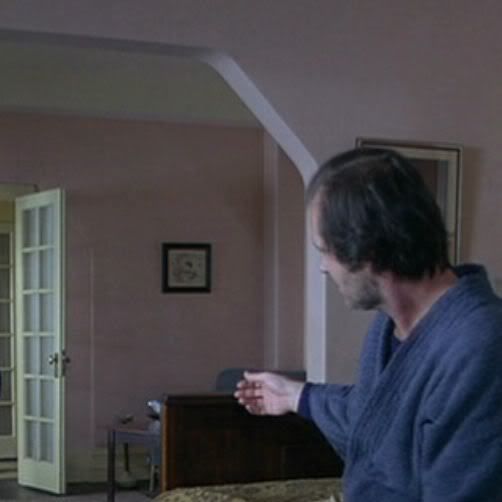
Danny didn't bring 2 trikes with him yet the wheels change color from white to red.
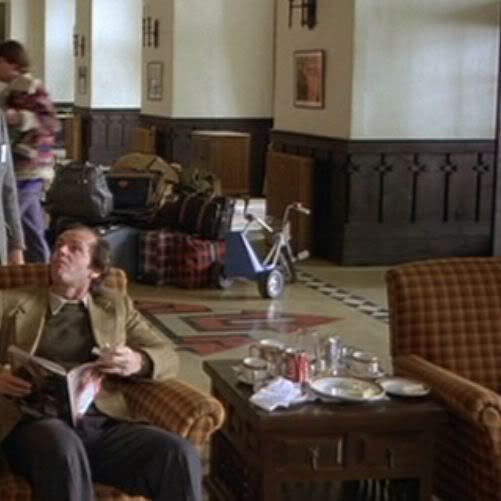

Jack didn't bring 2 typewriters either yet it also changes color.
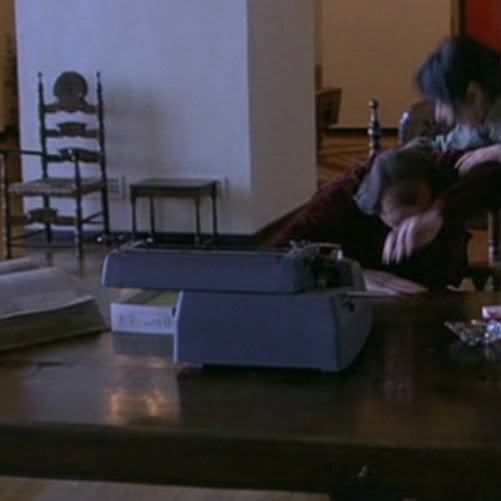
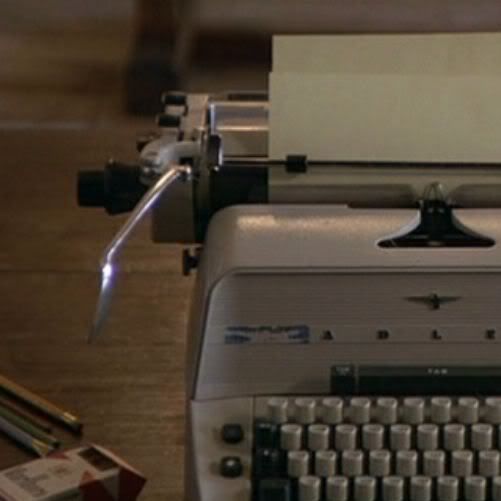
The hallway in the final chase also changes color.
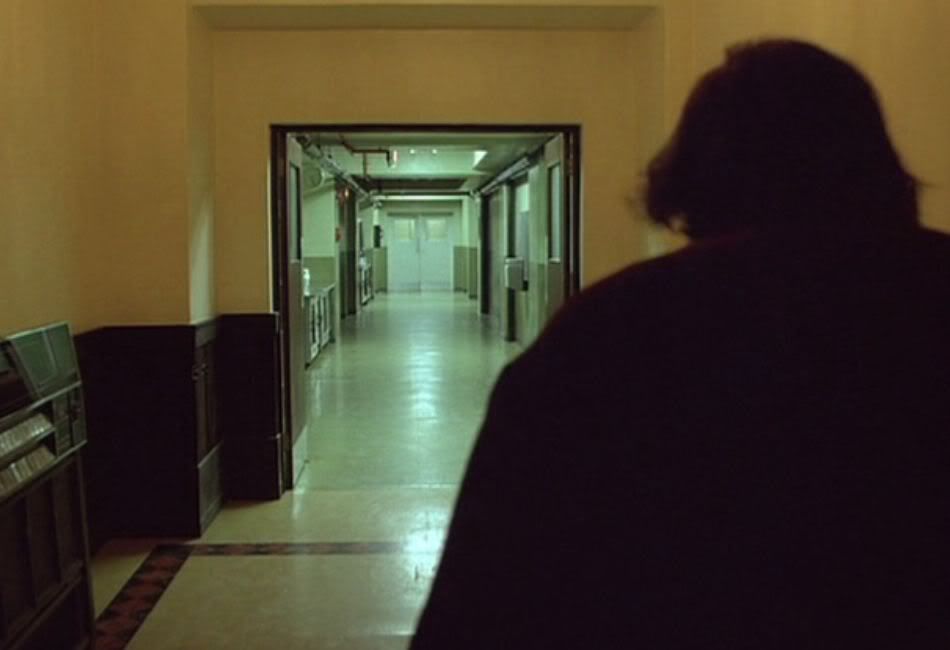

Possessions, surroundings, Danny’s trike, the walls outside their room, vending machines, lamps, items of clothing, the typewriter, the "Redrum" door, and even the paper that Jack’s novel is written on all change color in different shots. There’s no attempt to attract attention to what’s going on as some of these color changes, like the "Redrum" door, are obviously subtle making them harder to spot. Most occur in entirely different sections of the movie and would have been impossible for a theater audience to spot.
Again how he did this is not important; the colors change and a perfectionist like Stanley Kubrick would never have let this happen by accident.
To view some of the color changes he added click here.
How does Stanley Kubrick show us that people who “Shine” emit psychic energy?
Here’s another interesting and subtle touch Stanley Kubrick added to “The Shining”. Most of the electrical appliances and TVs they use in The Overlook and also Dick Hallorann’s house, noticeably, have no visible wires coming out of them.
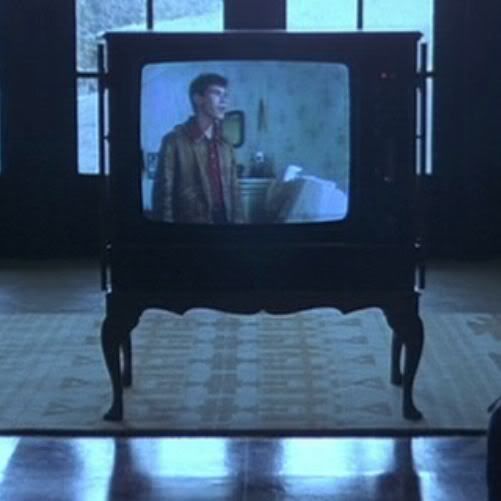
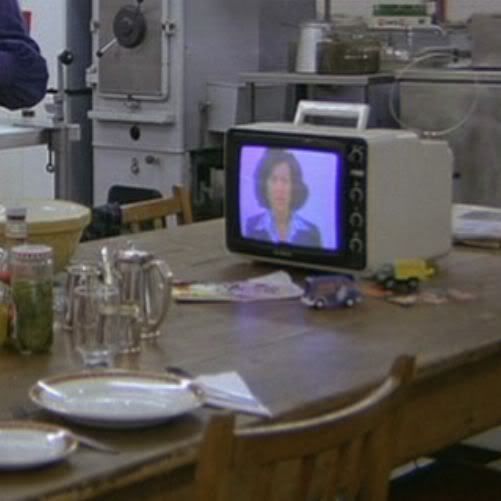
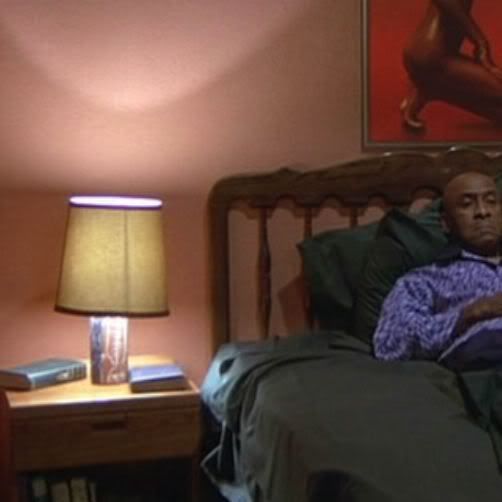
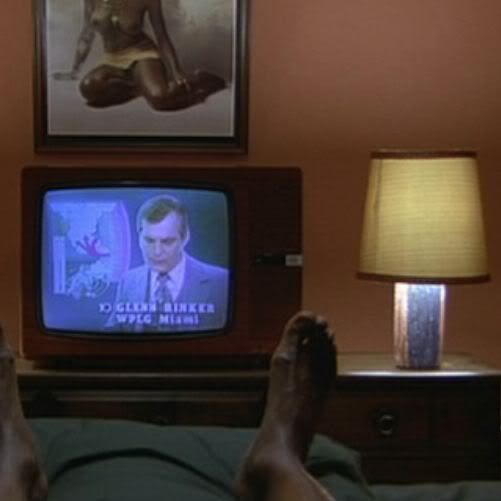
You may have noticed that as Jack gets crazier and crazier, whenever we see the outside of The Overlook different sets of lights are on each time. Especially near the end where no one ever flicks a light switch. Throughout the chase scene different lights go on and off by themselves, even though no one is left inside the hotel. It’s a no-brainer to say that the hotel is haunted and the spooks are causing this to happen but it’s not the case at all. The TV sets, Jack’s lamp on his desk, the clocks on the walls (as well as Dick Hallorann’s TV and lamps) all have no wires coming out of them for a reason. Stanley Kubrick is showing us that these people have a special energy surrounding them. Jack's descent into madness combined with his power to “Shine” is what’s causing the lights inside The Overlook to turn on and off by themselves.
Who beat up Danny?
“Remember what Mr. Hallorann said. It's just like pictures in a book, Danny. It isn't real.” You might want to think about this from that last quote; at what point did “pictures in a book” and visions that aren’t “real” change and become something that can supernaturally unlocked a pantry door or strangle Danny? In the novel Dick Hallorann’s important line to Danny is, “I don't think there's anything here that can hurt you. So just be cool, okay?" (page 60) and he never says, “It isn't real.” In the novel he isn't sure about whether Danny can be hurt by anything inside the hotel, and this is important. He simply doesn't know. Stanley Kubrick came up with the line, “It isn't real.” on his own. He's telling us that the visions in the film are different and he makes Dick Hallorann's statement quite definite, they aren’t “real”. A pure evil psycho possesses a very powerful supernatural ability, and he’s also going completely mad. The “ghosts” everyone thinks are haunting the Overlook are not real - it's Jack and his supernatural ability to “Shine” that's creating these visions for himself and the others. Unless Stanley Kubrick's using another secret language that I'm not aware of there can be no question about this as he placed the clear answer right in the dialogue, "It isn't real". The visions that he sees indicate Jack also has the “Shine” and the Calumet cans that appear behind his head in the storeroom indicate he has the power of telekinesis. I saw them move just like you did.
In the novel Danny’s left in a near catatonic state after his ordeal with Mrs. Massey’s ghost in the bathroom of room 217, and Stanley Kubrick alters all this in the film. The roughing up Danny takes in the movie is from Jack. He beat him up by telekinesis during his nightmare the same way he moved those Calumet Cans and opened the locked storeroom door. He’s able to project real images the same way Dick Hallorann was able to project his thoughts into Danny’s head. It’s exactly the same. The woman isn't real and again we know this from the script. She's just another vision like the bloody elevators, "like pictures in a book". Stanley Kubrick, through Dick Hallorann, tells us exactly what's going on in the dialogue of the film. "It isn't real", and he doesn’t lie to Danny. What "isn't real" simply cannot beat someone up.
Stanley Kubrick is so unbelievably sure of himself. He even visually puts the proof of who beats up Danny into the film. Watch the scene when Danny sits on Jack’s lap in the bedroom again. He has Jack caress Danny’s cheek and place his right hand on his shoulder (0:54:04) in the exact spots where we later see the red marks and the torn sweater. Dick Hallorann is the only one in the film that knows that the visions they see "aren't real". There are people like him (and me) who realize this, and there are people (like much of the audience) who refuse to believe it, and there are those like Grady and Jack who are loosing their minds and follow the orders of the visions in their heads. And remember that all this is a total reversal of the novel.
Does Danny ever go into room 237?
I mentioned this in a previous section and you may be wondering how I’m so sure that Danny doesn’t go into room 237 in the film. In the dialogue Wendy tells Jack this, “No. It's the truth, really. I swear it. Danny told me. He went up into one of the bedrooms, the door was open, and he saw this crazy woman in the bathtub. She tried to strangle him.” Stanley Kubrick has Wendy even swear to the truth of her statement. But you must think about this. Danny “Shines” and sees visions throughout the movie, how can we know for sure that what he tells Wendy wasn’t a vision of a woman in 237 while he was standing there at the doorway or while he was somewhere else in the hotel? This statement is no stretch of the movie’s reality because when Jack walks into room 237 and “Shines” the vision of what he’s seeing into Dick Hallorann’s mind, he sees it as real even though he’s in Florida, nowhere near that room. That's why Stanley Kubrick never shows a shot of Danny in there. He simply never walks into that room. He was fooled by his father into thinking he was in it. There’s also nothing in room 237 that can hurt anyone and the proof of this is in this statement by a person who has spent a lot of time in The Overlook and can also “Shine”;
“You're scared of Room 237, ain'tcha?”
“No I ain't.”
“Mr. Hallorann, what is in Room 237?”
“Nothing, there ain't nothing in Room 237”
It's also clear from this earlier quote that Dick Hallorann even though he’s lived there, isn't scared of anything else inside The Overlook either;
“Mr. Hallorann, are you scared of this place?”
“No, I'm scared of nothing here.”
What’s changed inside The Overlook since the Torrance’s arrived?
We can’t ignore a thing because Stanley Kubrick explains it all in the dialogue. Dick Hallorann’s last statement is crystal clear and can’t be ignored; if there was anything that could hurt Danny in room 237 he would have told him so and the fact that he doesn’t is very telling. There’s nothing in that room but an echo of a past event that only a person who “Shines” can see. Jack obviously “Shines” and can see it also. Later Grady, Jack’s subconscious, orders him to “correct” his family. He’s the only person out to hurt Danny. He beats him up during his nightmare and has the ability to make his son think it was a woman in “one of the rooms”. Jack has the ability to make his son believe he was inside room 237. Jack’s the only one out to hurt anyone in the hotel. Stanley Kubrick cleverly makes you think Danny went into room 237 because we see him standing in front of it with the door wide open and a red room key in the lock. But he never does. The director has reversed just about everything in the scene. It isn’t even the same bathroom as in the novel (room 217). This is why I’m so sure Danny never goes into that room. It’s in the precise way Stanley Kubrick altered the novel. Just think about it. In the novel Danny disobeys Jack, steals the pass key, opens the door, goes in and sees the woman in room 217 – all reversed in the film where Danny disobeys no one, doesn't steal a passkey, doesn't put it in the lock, doesn't open the door, and doesn't go in. These are the facts. It’s the same as the colors of the VW, the ball, and the snowmobile. All reversed. This is the reason there is never a shot of Danny in room 237 and anyone who really believes he went in there should post a screenshot at the end of this blog. Show me him in room 237 to prove it.
Why don’t I believe what Danny says to Wendy about room 237?
You may be wondering how I can believe Dick Hallorann’s explanation of his return to The Overlook that I mentioned before (“Ullman phoned me last night.”) yet it seems that I don’t believe what Wendy says (“He went up into one of the bedrooms.”)? Everything supernatural that Danny sees is a vision and Dick Hallorann explains it plainly to him here, “Not things that anyone can notice, but things that people who 'shine' can see." Wendy isn’t lying but what she says is hearsay. She wasn’t present when it happened. Dick Hallorann was present when he recieved Mr. Ullman’s call. Wendy basically tells Jack exactly what Danny told her, “Are you out of your fucking mind?” - “No. It's the truth, really. I swear it. Danny told me. He went up into one of the bedrooms, the door was open, and he saw this crazy woman in the bath-tub. She tried to strangle him.” She wasn’t there when any of this happened.
Stanley Kubrick makes sure that we never see Danny inside room 237 and this is the main reason I know he never enters the room in the film. I showed before how incredibly meticulous Stanley Kubrick is as he inverts the entire scene with Danny and the pediatrician from chapter 17 “The Doctor’s Office” in Stephen King’s novel (click here). Danny’s entrance into room 217 is an important part of the novel as he’s the only one who sees the old woman. Looking at what a painstaking job Stanley Kubrick did in inverting the doctor visit it’s no stretch, and there is no error in believing that he did this throughout the entire film. And this is why he never shows us Danny in room 237. Everyone is manipulated by what Wendy says. But in the film Danny never went in there.
Danny sees visions on a regular basis and there’s enough proof that he’s been fooled by his father into thinking he was in the room looking at the old woman? The answer to many questions about this film are in what Stanley Kubrick chooses to show us, and the answers to others are in what he chooses to tell us. We never physically see Danny in room 237. On the other hand what Dick Hallorann says is a firsthand explanation of why he returned to The Overlook. He was present when Mr. Ullman phoned him. It’s the only explanation Stanley Kubrick gives us in the dialogue as to why he returns to the hotel and there’s simply no reason, that isn’t pure un-provable speculation, not to believe what he says. You know all of this is entirely reversed from the novel where it’s not Wendy but Danny who tells Jack about the old woman and Dick Hallorann doesn’t get a phone call from anyone. This is also reversed; in the novel after he’s been attacked they see Danny at the top of the stairs, in the movie it’s at the bottom of the stairs.
This phone call from Mr. Ullman is what bothers so many critics of my blog and they fight tooth and nail about it. Either the ‘ghosts’ are real or they are in the Torrance’s minds. If I’m right about the phone call it proves that the others also have the “Shine”, and that the ‘ghosts’ aren’t real. If Mr. Ullman saw the same vision of Jack in the bathroom than they all have the ability as they all see the same visions. If these visions according to Dick Hallorann, aren’t real. Than Grady isn’t real either and Jack is the one that lets himself out of the storeroom. They must fight on.
How does Stanley Kubrick fool Michel Ciment when asked who lets Jack out of the storeroom?
Stanley Kubrick is very precise in what he lets the audience see and hear in this film. Normally ghosts aren’t able to move things (as they consist of Ectoplasm). If they were, here, they wouldn’t need Jack to kill his family; they would have done it themselves. Grady is all in Jack’s head, if he wasn’t he would have “corrected” Danny and Wendy himself just like he "corrected" his own family in 1970. Think about it for a second; Jack lets himself out of the storeroom. That’s why Stanley Kubrick never lets us see Grady open the lock, because it never happens just like Danny going into room 237. It never happened! But we hear Grady talk to Jack through the door! We also hear Lloyd pour Jack a drink that later disappears as Wendy runs into the Gold room to tell him about Danny being strangled. It's all an hallucination that, "isn't real".If a “ghost” opened the storeroom door why couldn’t he show Jack the way out of the Hedge Maze, did Grady's power disappear at the end of the film? Why doesn’t’ Lloyd help him out of the maze, he couldn’t be to busy, Jack’s his only customer? It’s obvious yet many totally misread this quote from his interview with Michel Ciment. and try to use it as proof that Grady, a ghost, let Jack out of the storeroom. The movie is a mirror image of the novel and if you read closely you’ll see Stanley Kubrick’s talking about what happened in the novel and not his film. "…What I found so particularly clever about the [way the novel was written]. As the supernatural events occurred you searched for an explanation, and the most likely one seemed to be that the strange things that were happening would finally be explained as the products of Jack's imagination. It's not until Grady, the ghost of the former caretaker who axed to death his family, slides open the bolt of the larder door, allowing Jack to escape, that you are left with no other explanation but the supernatural." In fact in most of this interview unless you stop and think about it you don't really know if he's talking about the novel or the movie. Remember there’s one question he never answers about any of his films, ‘What does it mean’. The novel and film are entirely different in a very special way and Stanley Kubrick is very crafty in the words he uses and what he says. The clue here is the word "larder" that he uses to describe the storeroom. The "larder" is only found in the novel, not the film. In the interview Stanley Kubrick also says this, "… my view is that the paranormal is genuine". What on earth does that mean? The word view means opinion. “The Shining” is his film and he only has an opinion, doesn't he know? Or is he carefully avoiding certain questions about his film by talking about the novel, which is worlds away from his movie?
He cleverly keeps his secret as he tells Michel Ciment exactly what everyone expects to hear; a ghost lets Jack out of the storeroom. Again Stanley Kubrick refers to the “larder”. The word is only found once in the novel, "You're sure the larder is fully stocked?" she asked, still thinking of the Donners (page 42, chapter 8). No storeroom is ever mentioned in the novel’s kitchen, it’s a cold pantry, which is different. In the interview he’s cleverly talking about the novel and not his film. Grady and the locked cold pantry door may be the very spot that solidified Stanley Kubrick’s idea to reverse Stephen King’s novel. It’s perfect. What an idea if you're creating the ultimate puzzle; take what everyone who knows the story is 100% positive of (a “ghost” lets Jack out of the storeroom) and secretly reverse it. Hide what you're doing in plain sight. Poor Michel Ciment probably never read the novel and was totally unaware of the alterations that were done to it. No one that has experienced this film can honestly claim they could totally explain it after one viewing. It may make you wonder about how far a perfectionist like Stanley Kubrick would go with all this. If you’re still a skeptic (click here). There's undeniable proof that Stanley Kubrick has reversed or altered every major aspect of the novel except for a few names and there’s simply no plausible reason to suggest that he would stop doing this in the storeroom scene. Stanley Kubrick’s film is a mirror image of the novel and he hides what he's done by answering the interviewer’s questions about the film with what happens in the novel. “The strange things that were happening would finally be explained as the products of Jack's imagination” and that’s exactly what he did. In the novel there's no question that a ghost opens the door. In the movie the ghosts are all in Jack’s head mingled together with that very special hidden ability that enables him to move things with his mind by telekinesis. It’s perfect. Kubrick's unbelievably clever and just like Dick Hallorann in the film, he never lies to Michel Ciment; just brilliantly eludes his questions.
Who rolls the yellow ball to Danny?
Something else moves as if by magic in "The Shining". It’s Jack, not a ghost, that lures Danny to Room 237. In the novel it’s curiosity that lures Danny to room 217. In the film Jack “Shines” and uses his supernatural ability to roll his yellow ball in the boy’s direction while he plays with his toys in the hallway. If he has a supernatural ability to move things with his mind, and the pictures prove this, than it’s not a stretch to see that Jack's the one that does it. It’s exactly the same as the piece of paper appearing in his typewriter and the Calumet cans in the storeroom. The Overlook doesn’t lure Jack to room 237 either. Wendy simply asks him to check it out and see if Danny’s story about the old woman is real. He sees the vision that "isn't real" and than promptly lies to her about it. This is important because he lies about everything in the film.
Who lures Dick Hallorann back to The Overlook?
Something that’s not very obvious in the film is that Dick Hallorann is lured back to The Overlook? As I mentioned before Danny has the most power in the novel and the hotel covets this power. Dick Hallorann tests Danny’s special ability as they sit in his car on page 55 (chapter 11), and tells him to use it to call him in Florida if he needs any help. That’s exactly what he does and Dick Hallorann returns and ends up saving them from Jack. The novel’s nice easy predictable ending. This is all altered in the movie and if you listen closely to the script Dick never tests Danny’s power or tells him to call for help at all. There’s a very good reason; because Stanley Kubrick reversed the novel in a big way here without anyone noticing. It’s not Danny calling for help that attracts Dick’s attention while sitting in bed in Florida; it’s now Jack that attracts him back to the hotel in order to kill him (along with his family). Why does Jack lure Dick Hallorann and not someone else? Because he’s one of the four main characters in Stephen King’s story and because Jack may be a racist.
The reason I'm so sure it’s not Danny’s call for help but Jack that lures him back is because Dick Hallorann doesn't know of anything that's going on at The Overlook before Jack walks into room 237. Don’t forget about Danny being strangled by the woman in "one of the rooms". He was almost killed while Jack is having a nightmare as Wendy checks the boilers and it’s long before Jack enters room 237. This fact can't be ignored, dumbed-down, pooh-poohed away, or un-explained. There has to be a valid reason why Dick Hallorann didn't know anything was happening when Danny’s life was in the most peril. If Danny was going to call for help it would have been then. Dick's only alerted that something’s wrong at The Overlook just before Jack sees the woman in the bathtub and not a moment sooner - he doesn't ‘vision’ Danny being strangled at all. In the novel Danny says this (page 169, chapter 28), "Mr. Hallorann got me alone because he was worried… He said this was a bad place for people who ‘shine’. He said he'd seen things.” In the novel, Dick Hallorann knows about the, costume party, the moving hedge animals and Mrs. Massey’s dead body in the tub (page 217), yet in the film he knows nothing. In the film Jack "Shines" the image of room 237 right into Dick Hallorann's mind (and Mr. Ullman's also). Danny didn't "Shine" anything into anyone's mind and Dick Hallorann not knowing about the attempted strangulation is proof of this. Dick Hallorann never sees anything out of the ordinary in The Overlook before Jack shows up. This can't be un-explained. Stanley Kubrick never has Danny use his supernatural ability to “Shine” to call on Dick for help at all; if you don’t believe this watch the end of the movie again very closely. Danny is hiding in the cabinet before Dick gets to The Overlook. He’s on the other side of the hotel, hiding. He never acknowledges that Dick’s there until he’s being killed with the ax. Even when he hears the Sno-Cat he never calls on Dick for help. Not only in the final chase but nowhere in the entire film does Danny ever call on anyone for help, or use his ability to “Shine” to get out of trouble. In the film this simply never happens.
In the film it’s Jack who lures Dick back to The Overlook just like he lures Danny to room 237. Dick and Mr. Ullman are both being lured by Jack as he “Shines” the beacon from room 237 directly into their minds. Whoever shows up he plans to kill, the same as his family. Dick Hallorann doesn’t see Danny being strangled because Jack simply hasn’t called on him yet. Jack’s ability to “Shine” evolves throughout the film and something happens that changes him from imagining, to dreaming, than to actually becoming a killer. Look closely at the film; it happens between Jack’s nightmare and his going into room 237 and it changes everything. Lloyd gives him his first drink and Stanley Kubrick makes the time code precisely 66 minutes and 6 seconds into the film when he gulps it down. It’s when pure evil enters into him. There’s something else that I’ve alluded to before. There’s something inside The Overlook that only Jack sees. None of the others see it and it’s what starts him on his mission. I talk about it later in the section, “Is The Overlook Haunted or does it "Shine"? You may think this statement of mine is wrong, “Dick Hallorann doesn’t see Danny being strangled because Jack hasn’t called yet.” But think about this; how is it that Jack is able to have Dick Hallorann walk straight into an ax at the end of the film? Jack has much more power than the others. That’s why so many Calumet cans appeared out of nowhere behind his head when he “Shines” and opens the storeroom door. Dick Hallorann can only muster one when he “Shines” and talks to Danny. The cast only sees what Jack wants them to see. He’s controlling the visions that appear in their minds and he's controlling who sees them.
Wendy’s “Shine” evolves also. Something happens that brings out her ability. She’s in the most famous “haunted hotel” in history but the ghost’s wait till the end of the film, the very last night there, to show themselves to her? She never sees any visions until after she views Jack’s novel. That’s when Wendy is scared to death and her “Shine” comes alive. Otherwise she would have seen the room 237 freak show like the others. After looking at Jack’s novel she sees several visions of The Overlook’s more unsavory guests who’s pictures aren’t hanging on the walls.
In the red bathroom when he lies to Jack, how does Grady know that Dick Hallorann is returning to The Overlook?
Jack’s loosing his mind. Grady is his subconscious and like Jack, he always lies. He knows he “Shined” the vision of room 237 into Dick Hallorann’s mind and lies to Jack telling him it was Danny who did it. Jack used his ability to “Shine” to lure Dick Hallorann back to The Overlook and, as I mentioned in a previous section, at the end of the film he uses it again to lure Danny into the Hedge Maze by moving the entrance right in front of him by the Sno-cat. Jack lures both of them. You may be asking yourself ‘Why would Jack lure anyone back to the hotel’? Well it’s an integral part of the story - Dick Hallorann has to return.
In the beginning of the room 237 scene Dick Hallorann, sitting in bed in Florida, sees a vision of something that scares the life out of him. What is he looking at? Is it the door to room 237 ajar with a key in the lock? Not so fast! That’s what the audience sees. You’ll have to look at the dialogue to answer this question because he’s obviously reacting to something well before Jack walks into that room, and we know from the dialogue that Dick Hallorann knows “nothing” about room 237. It’s easy to let this quote fly over your head but look again at what Stanley Kubrick has the only expert on “Shining” say, “People who shine can sometimes see things that are gonna happen… ” It’s subtle but obvious that he already knows what Jack’s going to see in room 237. Just before we see him stepping into the room Dick Hallorann is mortified because he already sees the old woman. In this scene he’s seeing the future. Having a vision of what Jack is imagining is going to happen in that room while we’re still looking at room 237's opened door with a red key hanging out of the lock. The same room that Danny had to bring up while talking with Dick in the kitchen, because he knew “nothing” about it. In the vision of room 237’s bathroom Dick Hallorann already knows what we’re soon going to see, and his reaction is similar to Jack’s just before he runs out of the room ready to puke.
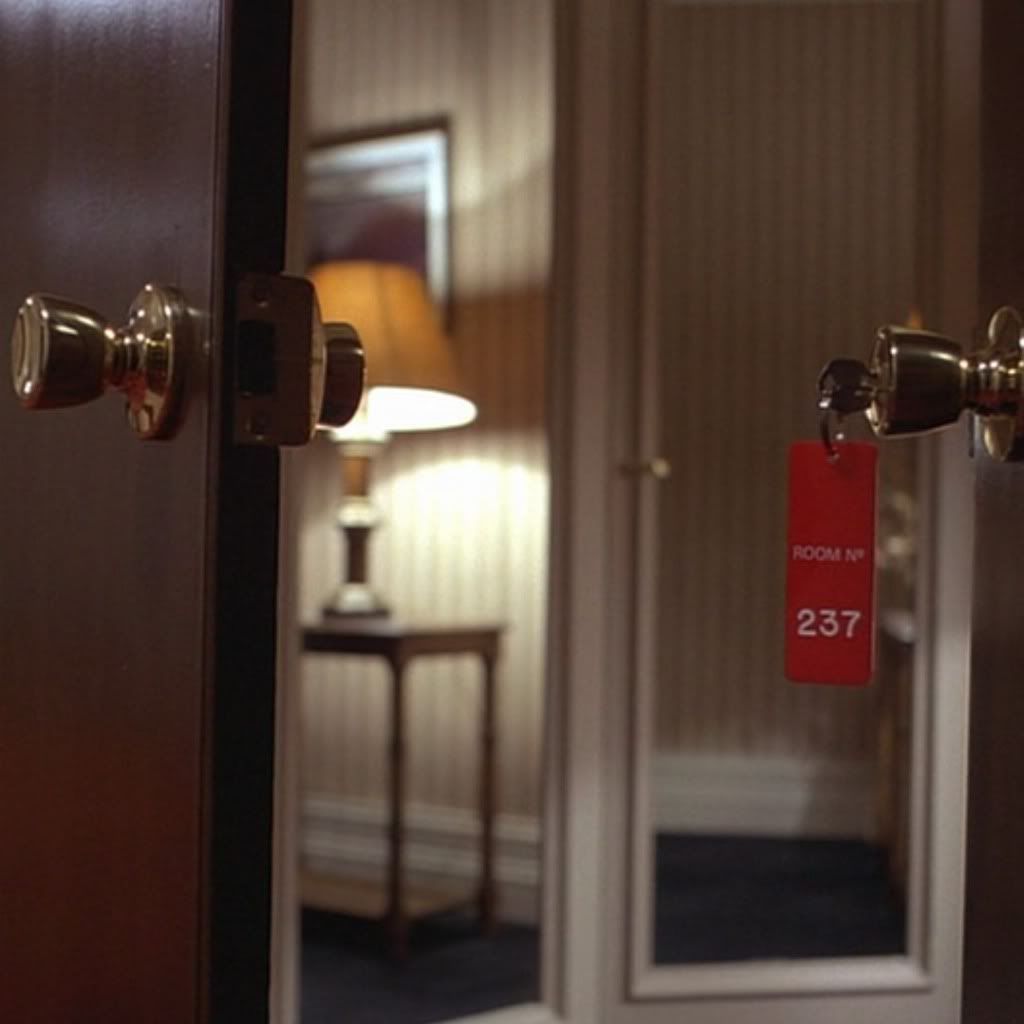
Again, in the novel The Overlook covets Danny for his power and uses Jack to get it. What does it covet in the movie? Think about it for a second The Overlook seems to be trying to kill Danny and ends up with Jack on the wall. It’s obvious that in the movie this time, if it wants anything at all, the hotel wants Jack and not Danny. Why would The Movie’s Overlook want Jack if he didn’t have the most power to covet (or if he had no ability to "Shine" at all)? In the novel on page 254 (Chapter 46) Wendy realizes this very important part of the story. Remember this is the novel, not the movie; "The hotel caught Daddy."… And she was convinced that was true. More, she thought that Danny might be the one the hotel really wanted, the reason it was going so far ... maybe the reason it was able to go so far. It might even be that in some unknown fashion it was Danny's shine that was powering it, the way a battery powers the electrical equipment in a car ... the way a battery gets a car to start. If they got out of here, the Overlook might subside to its old semi-sentient state, able to do no more than present penny-dreadful horror slides to the more psychically aware guests who entered it. Without Danny it was not much more than an amusement park haunted house, where a guest or two might hear rapping's or the phantom sounds of a masquerade party, or see an occasional disturbing thing."
"But if it absorbed Danny ... Danny's shine or life-force or spirit ... whatever you wanted to call it ... into itself — what would it be then?
.................The thought made her cold all over."
Why is the red key so important and who put it in the door of room 237?
As Danny plays in the hallway. There’s something else that moves by itself that most forget about as they wonder who rolls Jack's yellow ball. I mentioned before in the novel Danny takes the passkey, puts it in the lock of room 217, turns it, and walks right in. None of this happens in the movie as he never touches the red room key that’s already in the door obviously turned and opened by someone else and he never enters the room. A mirror image of what happens in the novel. Who put the red key in the lock of Room 237 and who opened the door? These two mysteries of the yellow ball and the red key go hand in hand. How apropos, as I'll discuss in a later section, even Stanley Kubrick's choice of color is telling us something here as he makes them the very special colors - yellow and red – the same colors he reverses from the novel. On page 206 (Chapter 37) of the novel Stephen King writes, “He looked at the clock inside the glass dome… In front of it, slightly distorted by the curve of the dome, was a carefully carved silver key… He picked up the silver key… He placed it in the keyhole at the center of the clock face. It went firmly home with a tiny click, more felt than heard. It wound to the right, of course; clockwise… Danny turned the key until it would turn no more and then removed it. The clock began to tick… The ballroom was empty… The whole place was empty. But it wasn't really empty. Because here in the Overlook things just went on and on. Here in the Overlook all times were one… It was as if the whole place had been wound up with a silver key. The clock was running. The clock was running.
...............He was that key, Danny thought sadly.”
The movie’s Overlook wants absolutely nothing. There’s no indication whatsoever that in Stanley Kubrick’s version The Overlook needs Danny, or any of them for that matter. But in the novel Danny is “the key”, and the power, and for whatever reason The Overlook covets his power. And like putting that “silver key” into the clock and winding it, Danny’s actually winding up The Overlook and unbelievable things soon start to happen. Right after this, in this next excerpt Danny enters a different world. Again we have a mirror image of the source novel where Tony can be seen, in the movie he’s now invisible; “The clock face was gone. In its place was a round black hole. It led down into forever… Danny tottered and then fell into the darkness that had been hiding behind the clock face all along… Down and down and down and down to… Tony was far below him, also falling. I can't come anymore, Danny ... he won't let me near you ... none of them will let me near you ... get Dick ... get Dick ...” Again, none of this happens in the movie as Mr. Ullman orders Dick Hallorann back to The Overlook.
There are two important keys in Stephen King’s novel, but in the movie we see only one key: a red room key in the door of Room 237, turned “to the right, of course; clockwise”, with the door left ajar. In the very next scene we see Jack having his nightmare. No time has elapsed; Jack “Shines” during that nightmare and rolls the yellow ball toward Danny in order to lure him to Room 237. Jack, not Danny, “Shines” the key into the door and Stanley Kubrick reverses the novel yet again; it’s Jack now, during his dream, who turns the key and opens the door. In Stanley Kubrick’s “Shining” Jack is the key (and the power), not Danny. But it’s more complicated in the movie because something else is reversed. It isn’t The Overlook that’s wound up by the turning of the key to room 237; it’s now Jack and the key is in the door precisely to the minute at the halfway point of the movie. After beating up Danny we see the next scene with Lloyd the bartender. He takes his first drink at precisely 66 minutes and 6 seconds; the key has turned and the clock is now running down for Jack. The drink Lloyd gives him is real. In the novel, “Jack contemplated the twenty imaginary drinks” (page 163, chapter 28) but in the film he gets a real drink as he has the power of telekinesis. He can make things appear out of nowhere just like the Calumet cans behind his head in the storeroom scene. It’s exactly the same.
The battery here is The Overlook, the evil around it, the ancient Indian burial ground it's built on, the place itself. Whatever it is The Overlook revs Jack up as he gulps down his Jack Daniels after selling his soul to the devil, “God, I'd give anything for a drink. My God dam soul”. Lloyd shows up in the shot all dressed in red and Jack is now the key to his own destruction. Like Stanley Kubrick printed on The Gold Room sign, “The Unwinding Hour.” Jack turned the key himself and in the movie’s Overlook time is not ticking forwards towards The Hotel’s destruction as it does in the novel but backwards; ticking backwards towards Jack’s reunion. Stanley Kubrick reversed everything here, in the movie The Overlook is not destroyed (as in the novel) and Jack remains on the wall “for ever, and ever, and ever”. It’s not destroyed or involved at all, only Jack is. He turned the key and The Overlook in the movie is now the “battery” that Wendy spoke about in the novel. He grows madder and madder, time is ticking backward to Jack’s final reunion with pure evil in the July 4th, 1921 picture where he will remain as long as movies are seen. “I wish we could stay here forever... and ever... and ever.” Jack’s self-fulfilling prophecy is granted to him.
In this excerpt from the novel Dick Hallorann “Shines” the image of the important clock just before the Overlook is destroyed, “It's too late," [Danny] said… Hallorann's mind was fixed with an image of a clock under a glass dome… The hands of the clock were standing at a minute to midnight… Suddenly the shine was on him, and he understood what Danny had meant when he said it was too late. He could feel the explosion getting ready to rumble up from the basement and tear the guts out of this horrid place… There was a flat explosion, a sound that seemed to exist on one low all-pervasive note (WHUMMMMMMMMM) and then there was a blast of warm air at their backs that seemed to push gently at them. They were thrown from the porch on its breath… The Overlook's windows shattered. In the ballroom, the dome over the mantelpiece clock cracked, split in two pieces, and fell to the floor. The clock stopped ticking: cogs and gears and balance wheel all became motionless.” None of this happens in Stanley Kubrick’s “Shining” because we are looking at a mirror image of the novel. It has all been reversed; now it’s Jack at the end of the film, and not The Overlook, that stops ticking.
Are there other explanations for the supernatural movements I’ve noted in the film?
Before writing this article few of the continuity movements I’ve shown here were ever mentioned on other Shining sites. But since my article some that have read it and have a lot of time invested in their own ideas have come up with another explanation for these continuity movements and color changes that I’ve noticed in “The Shining”. They can’t say they aren’t there because the pictures I’ve produced prove it and agreeing with me would mean a lot of deleting and time consuming rewrites. So another explanation has been put forth; it seems now that they agree with what they refer to as my so-called “theory” that they are deliberate but noticing them has another purpose in the movie. Seeing things like moving clocks and light switches and rugs are supposed to unsettle us, add to the spooky atmosphere of the movie and maybe even scare us.
Look at the clock on the wall.
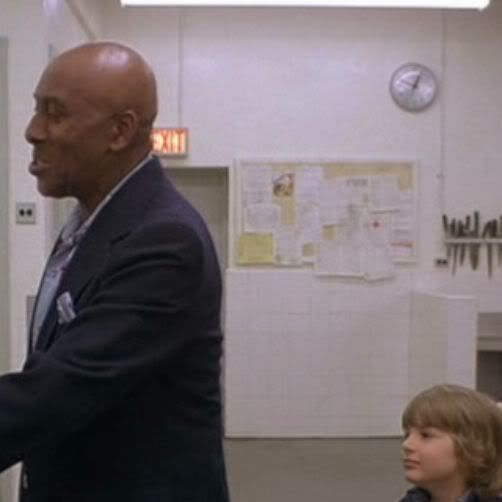

Watch the light switch on the left as it disappears.
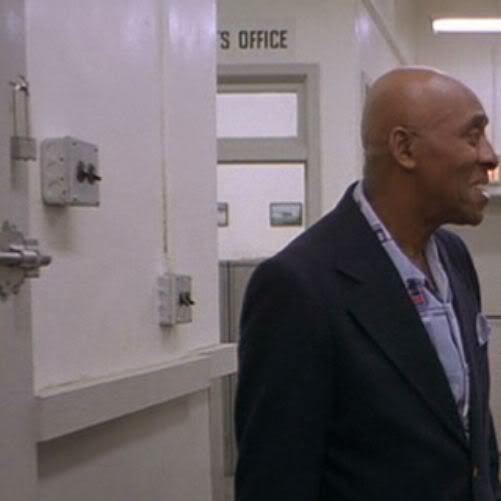

This light switch appears later in the movie.
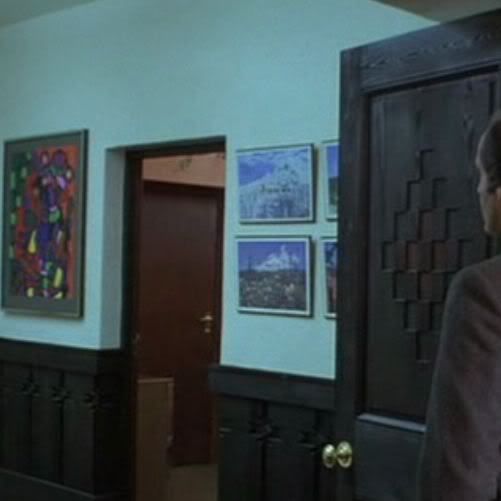

Are you scared yet?
You have to look closely at this simplistic explanation because there’s a reason none of this was noticed before I showed up. So much time was spent by other writers dissecting Stanley Kubrick’s psychological motives that they missed the obvious; the things that Stanley Kubrick hid in plain sight. I stuck with purely visual anomalies and was specifically looking for these continuity movements because I knew they were there and I knew just where to look. If you don’t know something’s hidden in a movie you’re not going to be looking for it, and if you don’t know something exists and it's never noticed, it can’t possibly scare you. The reason I don’t agree with this other explanation is this; now that I’ve shown them to you the cat is out of the bag and we all know where the items that move are. But there’s a big problem with the assumption that Stanley Kubrick was trying to scare us with things like moving clocks, rugs and light switches because they were unbelievably well hidden, and this cannot be ignored. The average viewer would have to possess the memory of a savant to have spotted any of them in a theater as most occur in entirely different parts of the movie. No! I’m positive that when you think about all these pictures they will prove to you that Stanley Kubrick, in his version of “The Shining”, gives the power of psycho kinesis to certain characters (Click here). It’s all a well-hidden part of his movie, not a trick used to frighten us. “Shining” is now a supernatural power that enables people in the movie to move things with their minds. The source novel has been altered and now you know exactly where to look to see these movements. Here’s proof that Stanley Kubrick is purposely-placing movie mistakes in this film as an integral part of his story. It’s the second most famous continuity error in the history of film that I spoke about earlier. Take a crack at explaining how it got there. The July 4th picture (the most enigmatic image in the history of motion pictures) just appears the same way as the Calumet cans, out of the blue on the wall in the final shot of “The Shining”. It’s just like magic. When we see that very spot several times earlier in the film and it isn’t there. It isn't hung on any other wall of The Overlook either, it just appears out of nowhere exactly like the Calumet cans behind Jack and Dick Hallorann’s heads. Everyone with the “Shine” seems to be gone though, who do you think it this time?
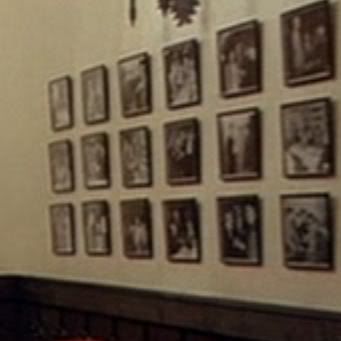
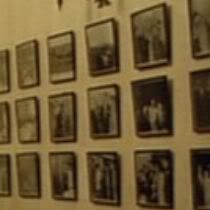
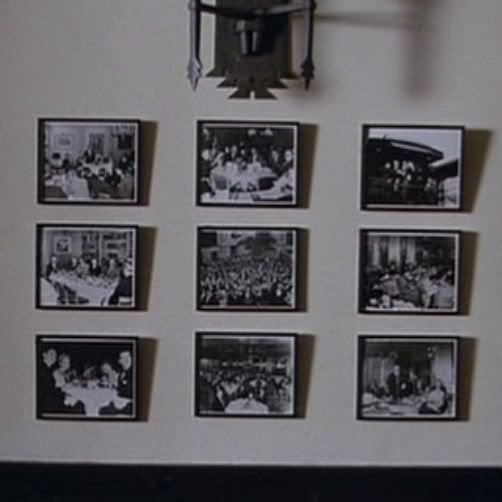

The movements I’ve shown are an important part of the film. It’s so obvious and skeptics have to ignore the pictures and dialogue and put a 180 degree spin on what Stanley Kubrick placed in his film so that wrong explanations will somehow fit. Tony; “Remember what Mr. Hallorann said. It's just like pictures in a book, Danny. It isn't real.” What do you think Stanley Kubrick is talking about? This phrase, “It isn't real.” is his invention, it’s not mentioned anywhere in Stephen King’s novel where everything happening to the Torrance’s was quite real. If the spooks aren't "real" one must come up with an explanation of how those Calumet cans appeared out of nowhere, how Jack got out of the storeroom, who rolled the yellow ball, who beat up Danny, and who put the key in room 237 and opened the door because Stanley Kubrick simply doesn’t visually show us any of it. One has to also prove that Dick Hallorann who has lived in The Overlook is somehow wrong and doesn't know what he's talking about when he says "it isn't real". Good luck! This is no theory on my part, Stanley Kubrick is explaining something important in the dialogue, "It isn't real". If you still don’t believe that Jack has the ability to “Shine” and see visions like Danny, go to the end of this blog and explain your criteria for judging what’s real and what isn’t in the film. If Stanley Kubrick tells us that Grady’s daughters aren’t real how can you rationalize that Grady is real? It's not spooks, it's something else that appears to the audience to be haunting The Overlook. Again if you have preconceived ideas the supernatural movements caused by characters in the film, just like the reversals that Stanley Kubrick made to the novel, are shocking. Especially how he was able to hide all this in plain site. But if you “go check it out” what I’ve noted is quite correct and can’t be ignored, altered or most importantly dismissed. It is what it is and may not seem right but it’s obvious and quite clear that in the movie; Jack “Shines”. He has a supernatural ability to move things and he uses it to let himself out of the storeroom; the exact opposite of what happens on page 262 (Chapter 48) of the novel. Stanley Kubrick shows us that cast members have a supernatural power to move things; psychokinesis – A.K.A. "the Shine". There is no other explanation.
Some other visual anomalies and what moves around in The Shining can be viewed here, garden variety visuals I,
and more can be viewed here, garden variety visuals II, and here garden variety visuals III.
.............................. Music
What Do Delbert Grady And Danny's Friend Tony Have In Common?
Stephen King dropped these two words, double and Doppelgänger, in his novel and Stanley Kubrick couldn’t resist finding a place for them in his film. I've found something else that’s odd and moves around in "The Shining" when it shouldn’t. It was one of the first things I ever noticed in the movie and I immediately thought it was the most common of visual continuity errors seen hundreds of times in other movies. But I never would’ve realized just what this meant and how important it is to understanding the story had I not read the novel.
How does Stanley Kubrick visually show us that each main character also has an imaginary friend like Tony?
The recurring doubling motif that Stanley Kubrick sprinkles throughout "The Shining" is quite obvious and pointing us to something under the surface of the movie. There are no important examples of doubling in Stephen King’s novel; they were added into the movie. But doubling is mentioned in it and I believe it's where Stanley Kubrick got the idea from. Tony, Danny’s imaginary friend, can be seen in the novel. This can’t be ignored as I noted before Stanley Kubrick is showing us an inverted mirror image of Stephen King’s novel, and now in the movie Tony is invisible and communicates through Danny’s voice and index finger. But he's still there if you know where to look. In the movie Tony is not only a voice inside Danny, but he’s an actual invisible entity. In fact anyone else who “Shines” in this film also has an invisible entity around them. What I’m suggesting may be a little hard to comprehend because how on earth could Stanley Kubrick show us something that’s invisible on a movie screen. This would be tough for the average director but for Stanley Kubrick it's no problem at all and the proof of what I’m saying is in these pictures. Every time a cast member’s invisible entity makes an appearance in the movie they do the exact same thing. I’ll show you the pictures first and see if you can spot where they are in each one.
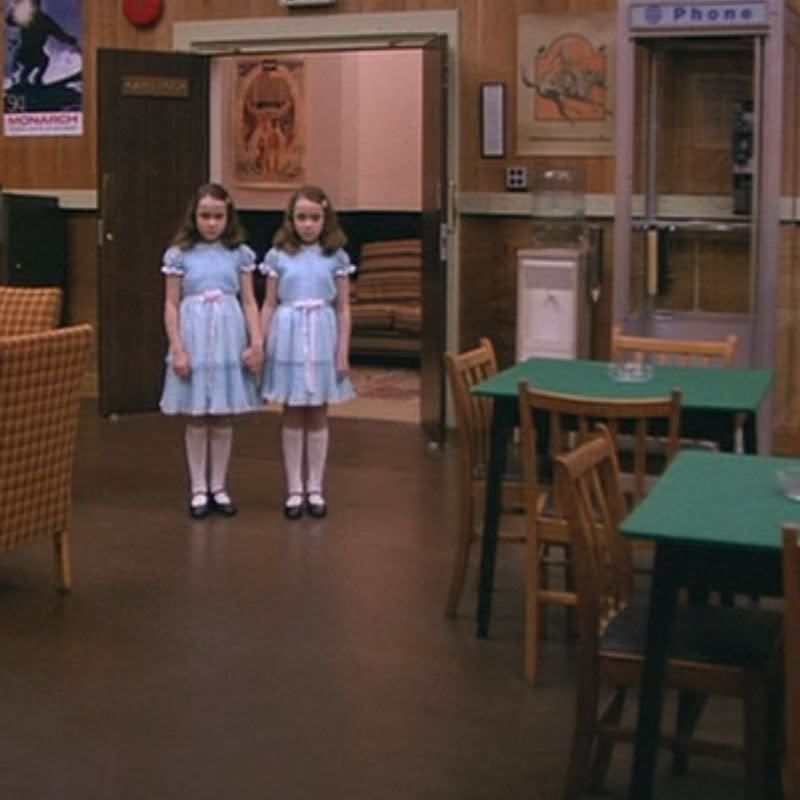
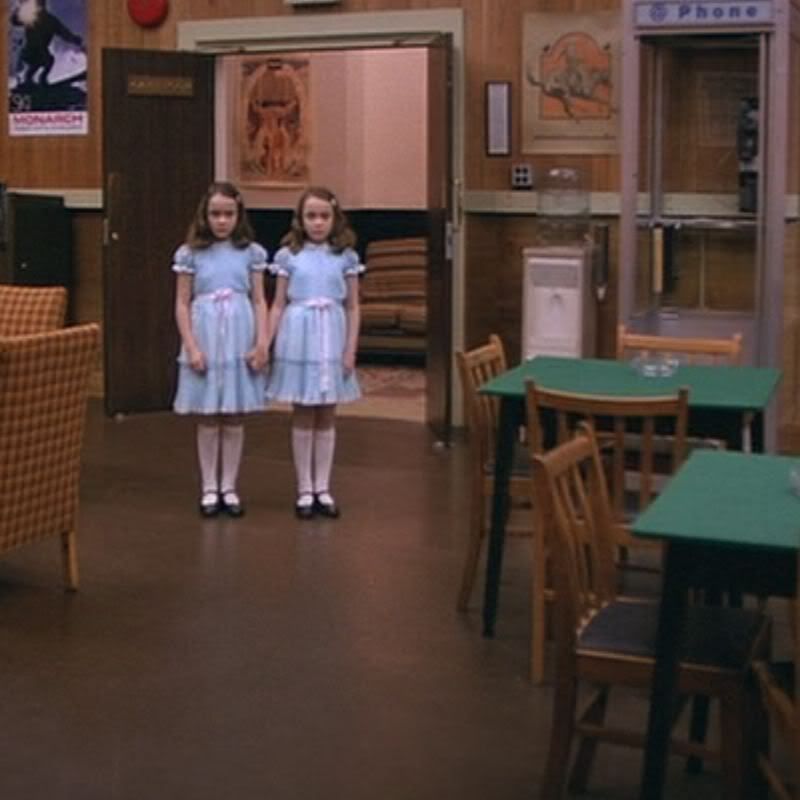
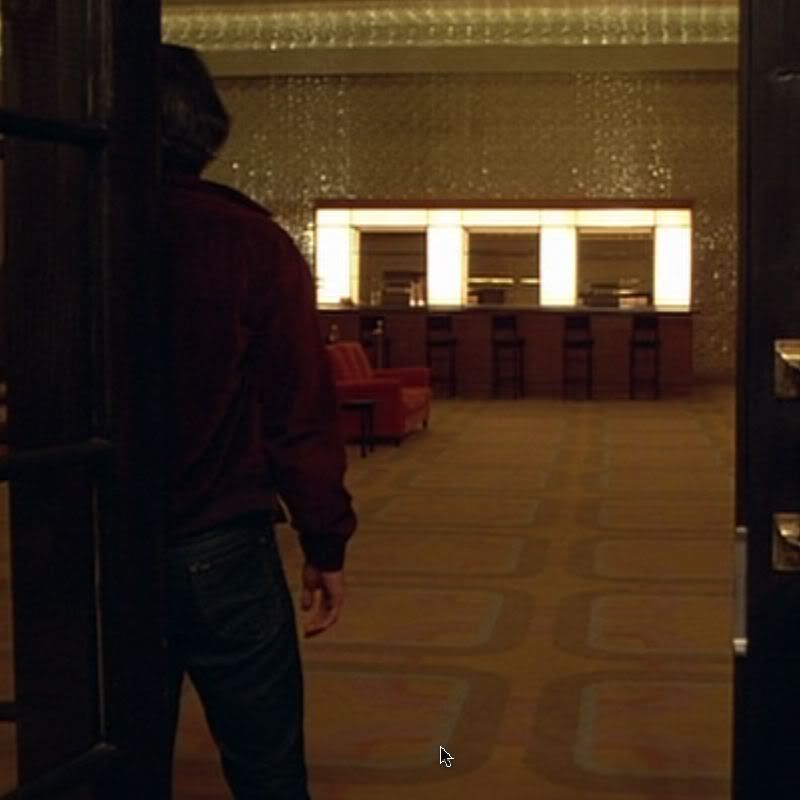

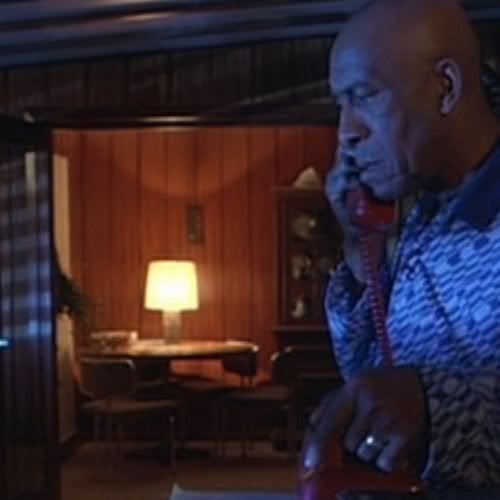


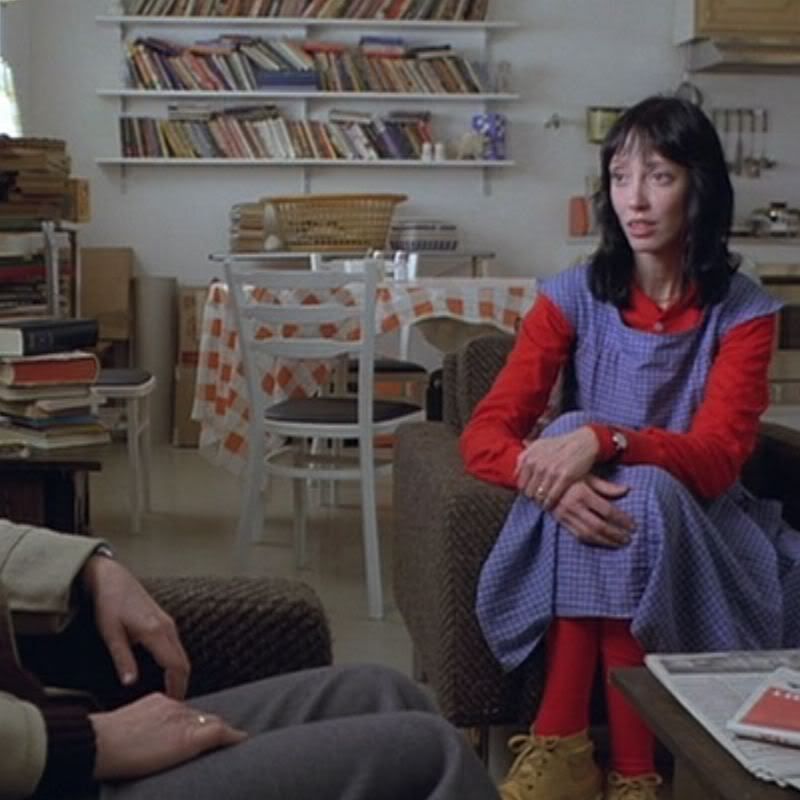
Did you notice a chair moving between shots in each scene? This isn't a mistake or a movement of a camera angle. No cast member went near them and they shouldn’t have moved. It’s deliberate and it happens at least five times in the film. Stanley Kubrick shows you that they are there, the invisible entities are present sitting in a chair making themselves comfortable while hanging around and observing their host. In the Merriam-Webster’s dictionary the definition of the word Doppelgänger is; a ghostly counterpart of a living person, a double, and Stanley Kubrick put the visual evidence here in these pictures that each major character in “The Shining” has a Doppelgänger associated with them. Even though the modern Internet definition indicates an evil presence Stanley Kubrick is working from the older definition here, as only Jack’s Doppelgängers, like he, are evil. It can't be denied obvious doubles are all over this movie. What an idea Stanley Kubrick had; take Tony from the novel, make him invisible in the film and than give everybody else an invisible Doppelgänger also.
People who "Shine" in the movie each have a double.
There should be no confusion as to whether The Overlook itself is causing this because Stanley Kubrick has it happen three times in the hotel and twice outside of it. Therefore the moving chairs are happening as a result of “Shining” and not any other popular phenomena, like ghosts or a haunted hotel. It may still be hard for some readers to accept but there are no classically defined ghosts or spirits from the hereafter in this movie. What the Torrance’s see are visions inside their own minds that Dick Hallorann tells us are "not real". They are causing the supernatural occurrences themselves and this is another aspect of the novel that Stanley Kubrick has reversed in his movie.
If Jack “Shines”, how does Dick Hallorann not know it?
Stanley Kubrick lets us know, “there are other folks” but at this point you may be wondering why Dick Hallorann only seems to pick up on Danny’s special ability if these other people also have the “Shine”? In the novel Dick Hallorann meets several people who possess the “Shine”. He knows it right away and so do they (“A Shine knows a Shine”, page 217 Chapter 38). Stanley Kubrick reverses the novel again. In the movie, ‘a Shine doesn’t know a Shine’. The others don’t know that they have this ability and he plainly tells us this in the dialogue, “Though mostly they don’t know it”. Dick Hallorann is obviously not able to perceive it in them, and in the film he’s the only one we know of who knows he has the “Shine”. Then I thought about this and realized that I had a huge problem to solve because it appears that he knows right away that Danny possesses the “Shine”. How could he not know about the others the same way? There has to be an explanation for this. At first I thought that Danny’s age has something to do with him picking up on it. But that’s not it. Then I thought when Danny “Shines” in the game room seeing the vision of the twins, maybe that’s when Dick picks up on his ability. But that’s not right either, something else is happening in the game room and I’ll discuss it in a later section. These are all just guesses anyway. Then I went back to look at the scene again because I knew Stanley Kubrick wouldn’t leave out the answer. I couldn’t believe what I found; Dick Hallorann doesn’t know that Danny “Shines” at all. This seems crazy because it’s so incredibly well hidden by Stanley Kubrick in the dialogue. Look again at the question Dick Hallorann asks Danny in the kitchen, “Do you know how I knew your name was Doc?” The obvious question should have been, do you know how I spoke to you in your thoughts and said, “How'd you like some ice cream, Doc?” But he doesn’t mention the obvious elephant in the room. Because of the director’s brilliant manipulation we all just assume that Dick Hallorann starts the thought transfer between himself and Danny. This isn’t the case at all, if you look at the film it’s Danny that “Shines” first and Dick Hallorann is then able to pick up on the boy’s ability. That’s when he knows for sure and transfers a thought into Danny’s mind, probably for the first time in the young boy’s life. In the film this is so important and it proves something; Dick Hallorann only knows someone possesses “The Shine” if it’s directed at him. Again we know from Stanley Kubrick’s dialogue that there are others. And in a story with only five main characters it doesn't leave many for you to choose from. This is why something I brought up in the last section is so important. Dick Hallorann doesn’t know it when Danny is strangled. It proves that Danny doesn’t call him for help. It’s Jack who “Shining” a call out to Dick Hallorann and Mr. Ullman that eventually lures one of them back to The Overlook to be killed.
Does Stanley Kubrick’s Overlook attract people who “Shine”?
I believe that in Stanley Kubrick's story The Overlook is a place that may attract people who posses the “Shine”. That’s why the Torrance’s are there and Mr. Ullman says, “Our people in Denver recommended Jack very highly, and, for once, I agree with them.” This statement implies that he never agreed with any of the other caretakers before and his statement is very clear. Only 2 caretakers ever went crazy and tried to kill their families inside The Overlook, Charles Grady and Jack Torrance so Mr. Ullman really isn’t a very good judge of potential caretakers. Charles Grady and Mr. Ullman both “Shine” and this statement “for once, I agree with them” tells us why no other winter caretakers (there must have been plenty) other than Grady and Jack ever totally lost it inside The Overlook. It’s because they didn’t “Shine”. Mr. Ullman didn't hire Grady, his "predecessor in this job" did, but he obviously never “agreed” with any of the other caretakers they sent him during his tenure. They didn’t have the “Shine”, and he somehow senses that. These other caretakers that he didn’t, “agree” with don’t go nuts on their families either. They couldn't be driven crazy in the same way as Jack and Grady. They didn’t get “cabin fever” being locked up all winter in the hotel because they didn't have the same ability to see visions of its past guests running around. They didn’t “Shine”, and Mr. Ullman might have somehow perceived that Jack does. You must remember this is Stanley Kubrick’s Overlook, a hotel that only occasionally attracts these types of people. And as I’ll show you in this section "Is The Overlook Haunted or does it "Shine"?". There’s something in the hotel that only Jack sees, and the others never do. It’s the reason why Mr. Ullman and Dick Hallorann, who have also lived in The Overlook, don’t see the hotel’s past guests running around like the Torrance’s.
What other characters possess the “Shine”?
As I’ve shown before, cast members who “Shine” seem to have possessions that change color. It's quite obvious when pointed out. Mr. Ullman and Bill Watson both have personal articles of clothing that change between shots in the film. A perfectionist like Stanley Kubrick would never let this happen by accident in a million years. How he did it is not important; the colors change and that’s very important because it's proof of their supernatural ability.
I showed this before, watch as Mr. Ullman’s tie changes color right before our eyes.


Mr. Ullman possesses the “Shine”. It's Jack and not a call for help from Danny that lures Dick Hallorann back to The Overlook. There’s only one singular explanation Stanley Kubrick gives us in the dialogue as to why he returns to the hotel and I believe Dick Hallorann when he says that Mr. Ullman phoned him in Florida. Dick Hallorann doesn’t lie to Larry Durkin when he says it. Mr. Ullman has the same supernatural ability as the others. When he “Shined” his tie changed color just like Danny’s trike and Jack’s typewriter I showed in the last section. He also sees the exact same vision of Jack in room 237 with the old woman that Dick Hallorann saw. Stanley Kubrick makes sure that he tells us in the dialogue that all the phones are out and there is no other explanation as to how Mr. Ullman could possibly know something was wrong back at The Overlook.
Watch as Bill Watson’s pants do the same thing as Mr. Ullman’s tie did between shots. At first, in a Blu-ray screen shot, they appear to be kaki corduroy stripes with no lateral lines, later, after the first shot, we see a grey plaid design with lateral lines.
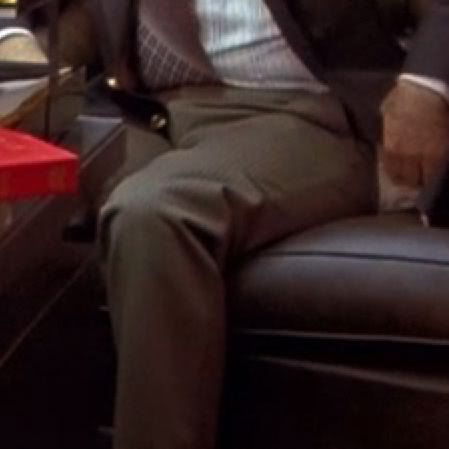
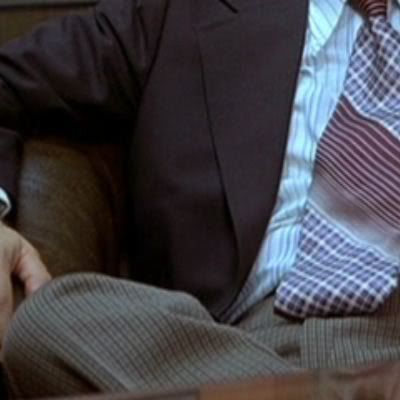
It’s obvious that all these people have the same ability. I’ve shown this many times in pictures throughout my blog but now just look at the chairs to the right of Mr. Ullman that move between shots in this scene. 6 major characters who “Shine” are present and not one of them went near any of these chairs. Their invisible Doppelgängers did and are sitting right there with them. They’re all up close, personal and operating in the present time frame. But 7 chairs move and there are only 6 characters who “Shine”. It’s because Jack is special and has 2 imaginary friends that we meet later in the film.
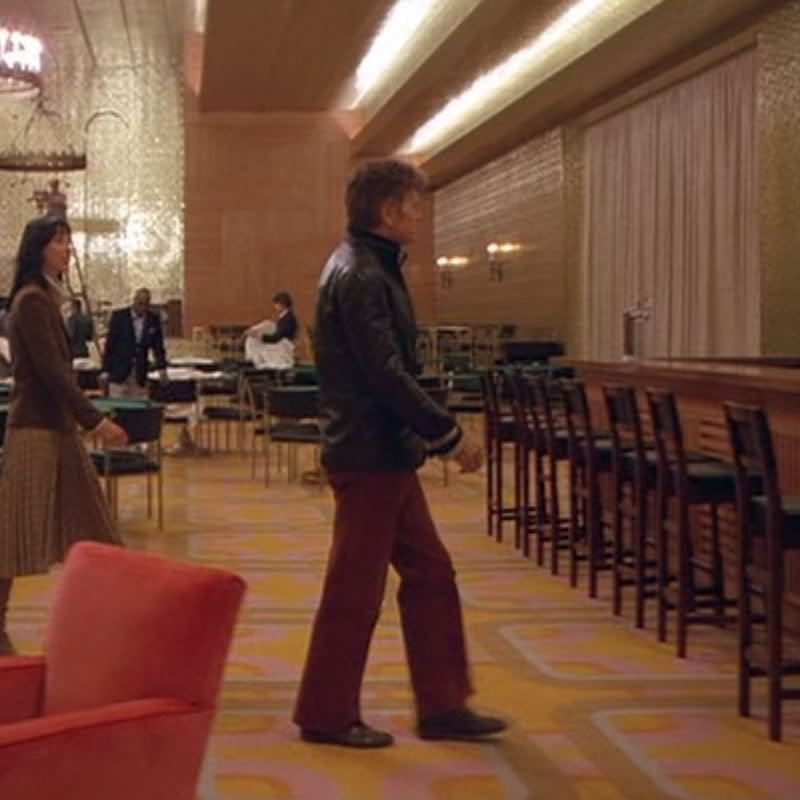
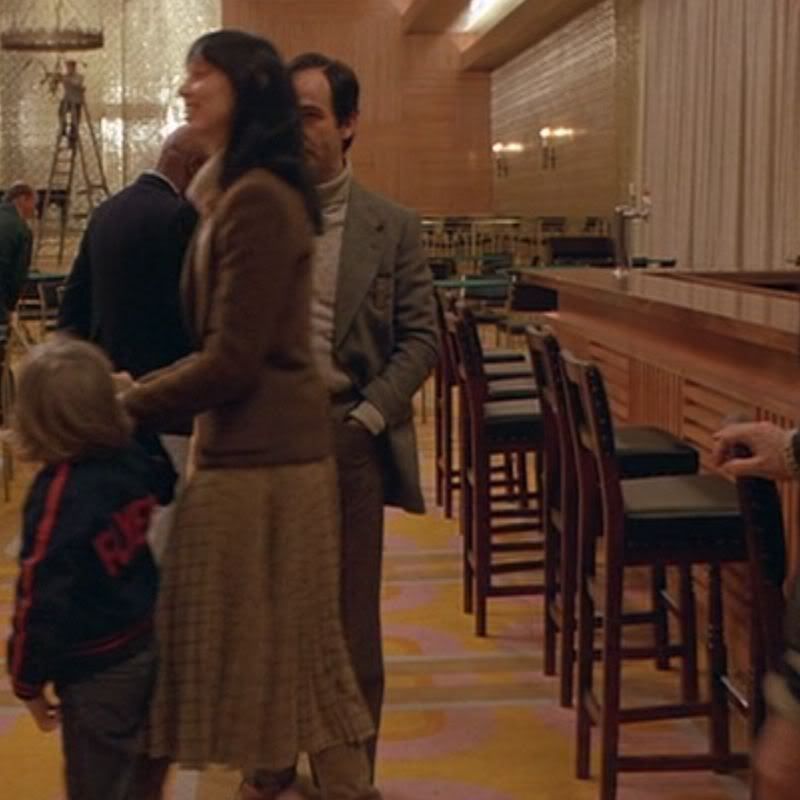
I believe Stanley Kubrick may have doubled the abilities from the novel that each character now posses, and he also doubled the amount of main characters that can use the “Shine”. Just like the Grady girls, who are twin actresses in real life playing non-twins in the movie, each character has a double. Stanley Kubrick makes this obvious in his film (twin elevators, twin boilers etc. - click here). These invisible entities might be the culprits behind what’s causing everything to move around, disappear, and change colors, and when a person “Shines” their invisible Doppelgänger is present in the scene as they’re doing it. The actual characters have no idea what’s going on and Dick Hallorann, the only person in the story that knows anything about “Shining”, might not even be aware of the other powers that his Doppelgänger posses. The doubles are part of their subconscious and Danny is the only one who may have the slightest clue, as he speaks to his imaginary friend on a regular basis.
What’s different about Jack’s imaginary friends?
We know Danny has one and it’s obvious that Dick Hallorann and Wendy have invisible friends also; but what about Jack? He's a different case because Stanley Kubrick lets us actually see Jack speaking to his friends. We know from the interview with Mr. Ullman that Charles Grady was an actual person who worked in The Overlook, murdered his family then killed himself in 1970. Stanley Kubrick actually gives Jack’s imaginary friend, the putative ghost Delbert Grady, an entirely different name to seemingly confuse, or point the audience to the fact that the two are entirely different (the real caretaker was named Delbert Grady in the novel, there was no Charles Grady). He's not a ghost haunting The Overlook, he only exists as Jack’s double and is his subconscious version of Danny’s imaginary friend Tony. “Is Tony the one that tells you things?” “Yes.” It’s the same with Jack. Grady is the one who tells Jack “things”, like Grady alerting Jack that Dick Hallorann is returning to The Overlook. His double is also helpful in getting him out of the storeroom without Jack’s conscious mind (or the audience’s) knowing it. All the Doppelgängers are invisible. Don’t let the fact that we see Grady fool you. It’s Jack who’s seeing him and Stanley Kubrick is letting us eavesdrop in on his vision. Don’t forget what Mr. Hallorann said they aren’t, “real”, they’re part of the Torrance’s subconscious minds. Grady and Tony may communicate without Jack or Danny ever knowing it. I’m sure this is how Danny was beat up during Jack’s nightmare. There never was and old woman, or ghost of one, in room 237 while they were in The Overlook. It was just a vision of an echo of what happened to a person who committed suicide there in the past. A vision of an actual event only a person who “Shines” can see, “Not things that anyone can notice, but things that people who 'shine' can see". We all know that Jack is loosing his mind, he’s talking to himself when he speaks to Grady with the mirror in front of him. Don't forget about Lloyd the bartender, he's part of his subconscious also as Jack speaks to the darkest side of himself again with a mirror there staring him in the face. Stanley Kubrick lets us eavesdrop inside Jack’s mind again. Remember Jack first sees the old woman in the reflection of a mirror. The fact is neither Lloyd, the woman or Grady ever utters a sound without a mirror being present in front of Jack's face. As the movie progresses the madder Jack gets the more stuff happens and it's his subconscious that’s doing everything. The subconscious is our minds protector. But Jack is nuts and his subconscious possesses a very special supernatural ability. Stanley Kubrick put the evidence right in front of us; if you know where to look. He’s given a madman the power of psychokinesis. Jack can move any object his subconscious wishes; with his mind.
Where did Stanley Kubrick get the idea to put Doppelgängers in his movie?
From Stephen King, of course. In the novel on page 149 (Chapter 25) as Danny walks into room 217 and sees his reflection in the mirror, “He watched his double nod slowly,” and “Yes, that's where it was, whatever it was. In there. In the bathroom. His double walked forward, as if to escape the glass.” In the movie Jack can’t escape the glass in front of him as he speaks to his imaginary friends with a mirror present for him to look right into each time.. And there’s this quote from page 37 (Chapter 6) of the novel as Wendy talks to Jack, “She had expected to discover his anger…. It was almost as though the Jack she had lived with for six years had never come back last night — as if he had been replaced by some unearthly Doppelgänger that she would never know or be quite sure of.” In the movie Stanley Kubrick makes all this happen visually. In fact, Stanley Kubrick may have conceptualized his “Shining” to be the artistic Doppelgänger of Stephen King’s “Shining”. Maybe he sees himself as Stephen King's Doppelgänger – his genius evil twin?
Someone else also had an invisible friend sitting next to him when he did his dirty work. Evans Adrian a commenter on my blog noticed this.
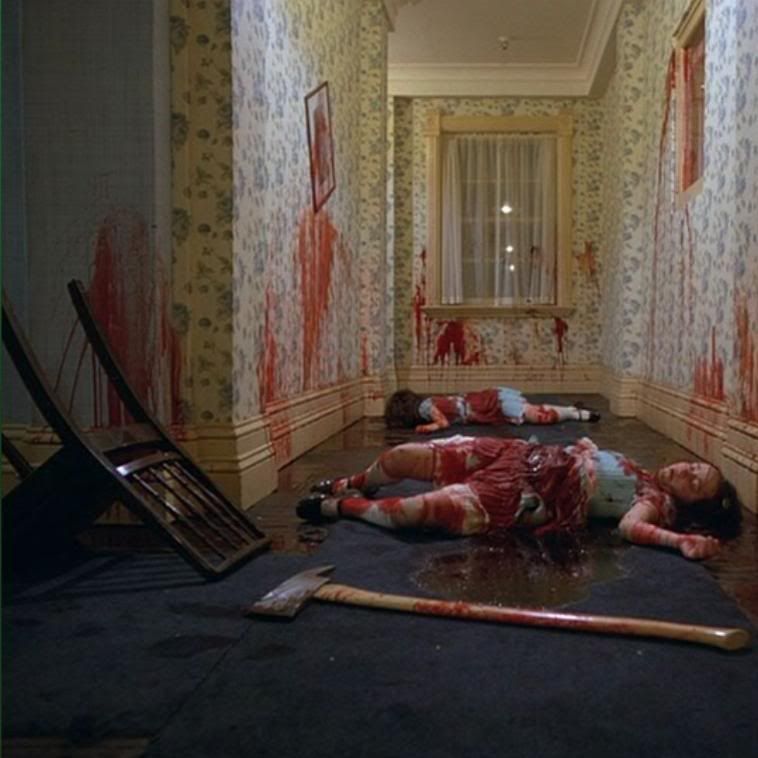
In the novel Grady leaves the Roque mallet along with some Gin for Jack after he lets him out of the storeroom. In the film this is all reversed and we never know where Jack gets the ax from. The ax in the photo is the same one that Jack uses later in the movie, but don’t let that confuse you the important thing that he noticed is the overturned chair, just like the one mentioned in Stephen King’s novel on page 23 (chapter 4) right after Danny’s first vision of the word “Redrum”, ”Across the room was a mirror, and deep down in its silver bubble a single word appeared in green fire and that word was: REDRUM. The room faded. Another room. He knew (would know) this one. [An overturned chair]”. The chairs we see throughout Stanley Kubrick’s Overlook are not the same style as this one but I knew if I looked through the movie I would find this particular chair somewhere in there. We see it several times right outside of Wendy and Jack’s apartment. But the thing that’s really important is that every time we see it there it’s upside down, just like in the Grady ax murder scene.
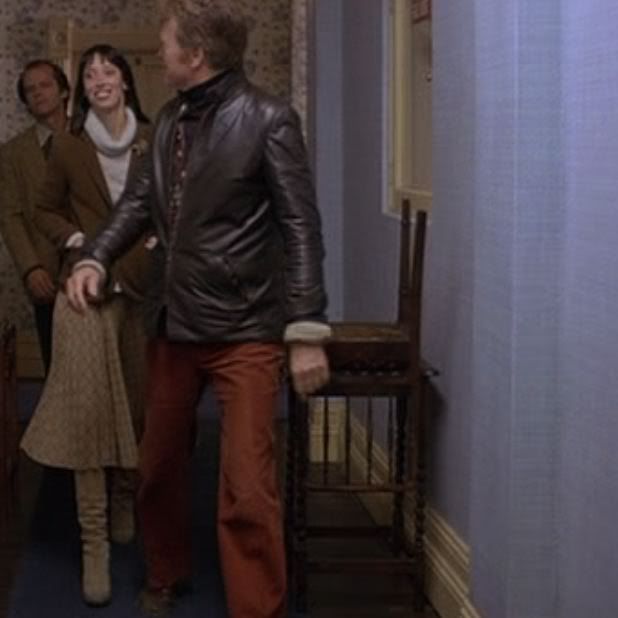
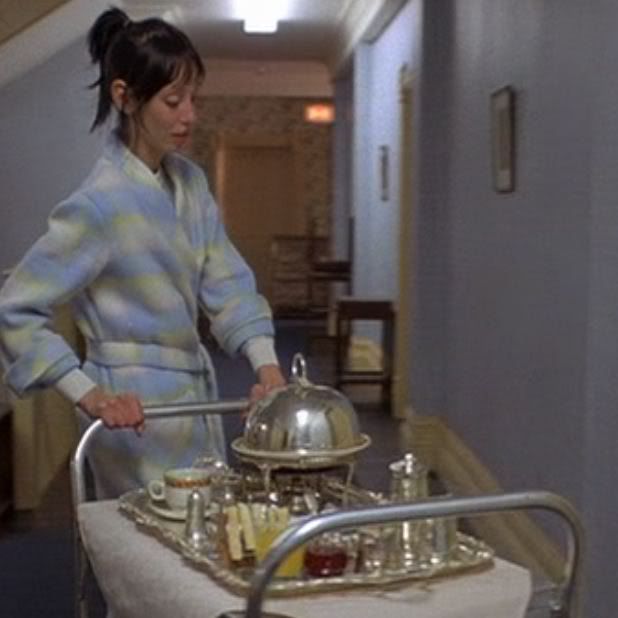
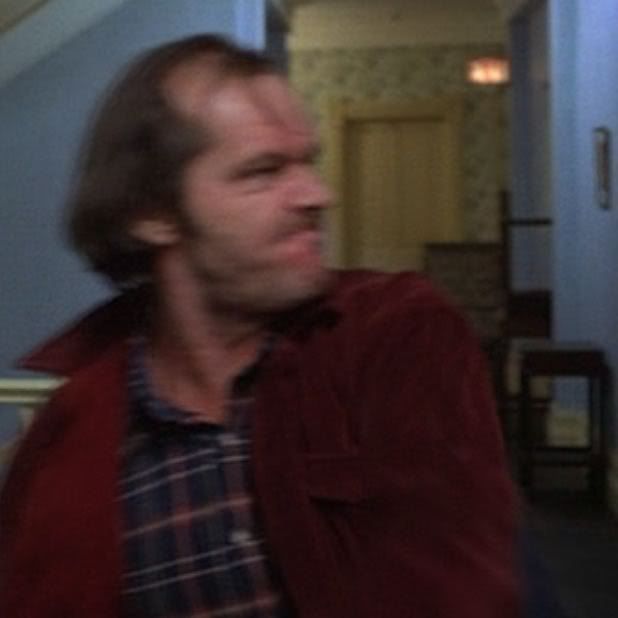
Charles Grady was also able to “Shine” and his invisible entity was sitting in that very chair before he killed his family and himself. The reason the chair is now overturned is because Grady killed himself and there’s no invisible friend sitting there any more, and if Jack was a reincarnation of Grady, as some believe, the chair outside The Torrance’s’ room would be right side up because Jack and Grady would both share the same Doppelgänger. I mentioned before I believe in the movie version of this story The Overlook may be a place that attracts people with this special ability to “Shine”. In the pictures of the moving chairs Stanley Kubrick shows us that people who “Shine” have invisible friends by their sides. The ghosts that everyone believes are haunting The Overlook may be the Doppelgängers of the current residents, and there’s no solid evidence I can find to the contrary. The visions they see are a result of their supernatural ability, “Not things that anyone can notice, but things that people who ‘Shine’ can see.”, and one of them has the power to “Shine” the images he’s seen from the hotel’s past directly into the other’s minds. But no one is there except the Torrance family and their invisible doubles. It’s brilliant how Stanley Kubrick gave each cast member an ability that makes it appear to the audience that The Overlook is haunted, when it actually isn’t.
An interesting thing that I noted before is that almost all of the sofas, rugs and a lot of the unattached artwork disappear throughout the movie. Chairs, rugs and Indian artwork disappearing, props and rooms changing colors, clocks, lamps, shower nozzles and light switches all moving around by themselves. It’s all part of the mystery of this movie and some of these movements have a very significant meaning. It’s a byproduct of “The Shine”. A special ability that enables people to supernaturally move and change certain items of the director’s choice. Again, this is what the movie is about, “Shining”. The Torrance’s also have some hidden friends, and one of them (along with his hidden friends) has quite obviously gone completely out of his mind. It may be hard to decide which is right but cast members possessing hidden Psychokinetic abilities is so much more interesting than common ghosts, and “The Shining” is by no means your common every day ghost story.
...................................Music
The Significance Of Yellow And Red In The Movie.
............ “Orange is the happiest color.” - Frank Sinatra
The colors yellow and red are another important part in the understanding “The Shining”. I've included pictures below to show how Stanley Kubrick uses them in this film.
The brightest and most obvious yellow items are Jack’s 2 special possessions and each plays a significant role in the movie. The yellow Volkswagen (changed from red in the novel) brings him to the Overlook,
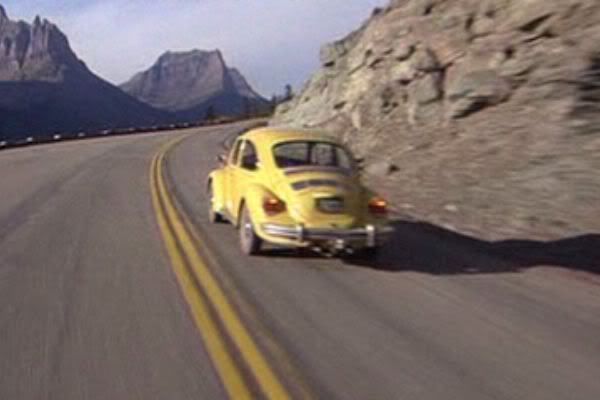
and the yellow ball (also changed from red in the novel) lures Danny to room 237. It’s Danny’s (and it’s red) in the novel but now, in another plot reversal, it’s Jack’s and may well have also lured him to the Overlook. Apearently in the deleted scene from the original director's cut, the yellow ball is given back to Danny in the hospital by Mr. Ullman possibly to lure him back to The Overlook in the future.
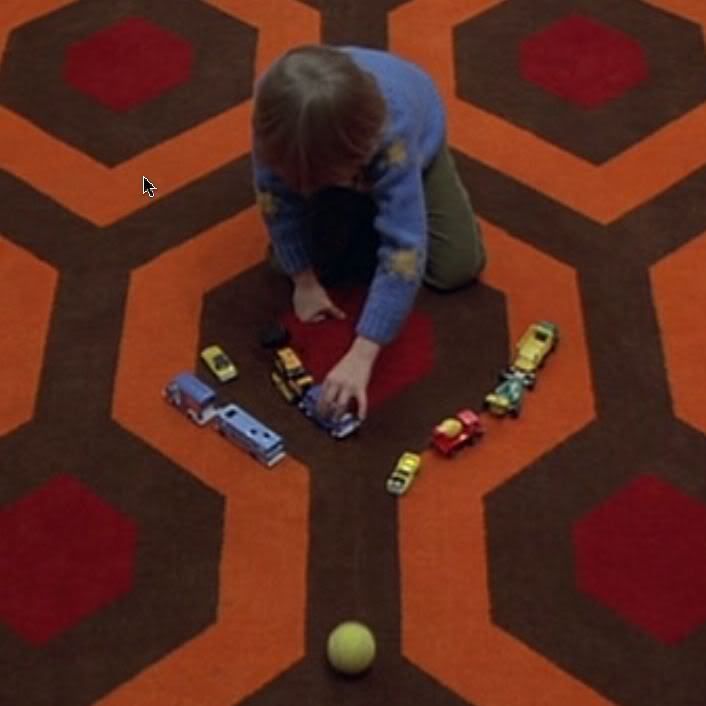
Look closely at the carpet. Red and yellow are prominent but it was blue/black in the novel.
Where are some examples of Stanley Kubrick’s use of the color yellow?
Danny’s yellow and red dwarf from Snow White (Dopey) before his 1st vision (I thank EvanVolm for letting me know that this wasn’t a Smurf as I first thought).
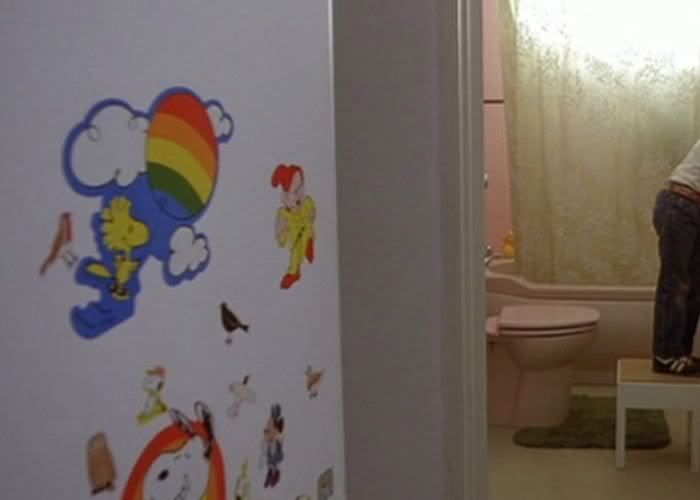
Their yellow bathroom door with red writing on it.
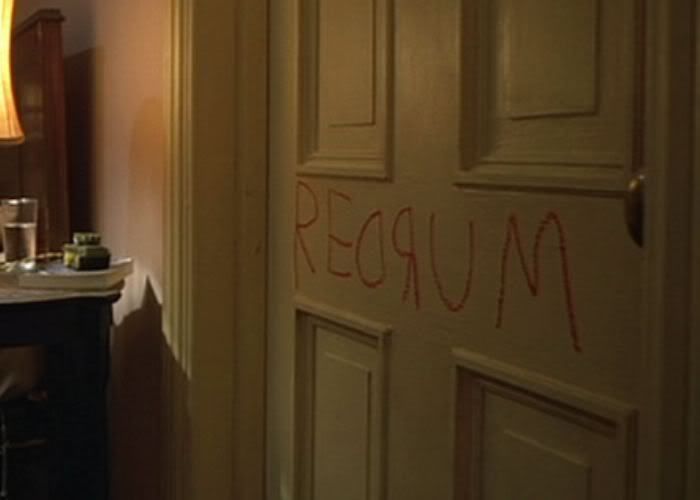
The yellow border of Room 237’s bathroom.
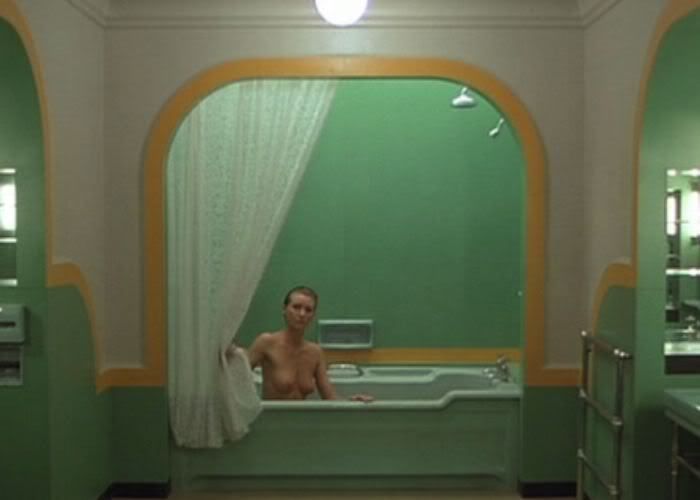
Jack’s novel is written on yellow paper.
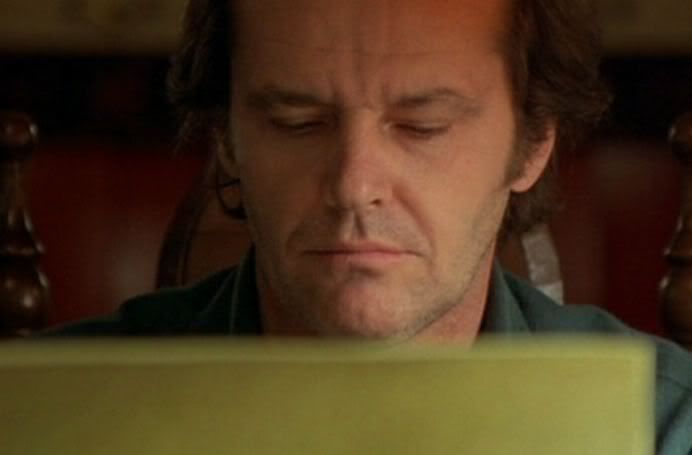
And don’t forget the Advocaat that Delbert Grady spills on Jack at the party, it's also yellow.

Red also seems to be prominent in "The Shining" and it took me a while to figure out what was happening. Surroundings and possessions which are entirely yellow or red are obvious and have been noted by many but never fully understood. Stanley Kubrick got the idea for the colors from Stephen King’s novel where Dick Hallorann smelled oranges when he “Shined”. Being that smell can not yet be adequately brought across to a theater audience Stanley Kubrick made the brilliant decision to use the two pigments a painter mixes together to make the color orange, then use those as a visual device to indicate “Shining”. Jack’s yellow VW and the red Calumet can behind his head in the storeroom. Red and yellow equals orange just like the walls of Dick Hallorann’s bedroom in Florida as he “Shines”. Red and yellow were mentioned very little in Stephen King's novel and weren’t an indication that someone was "Shining". Stanley Kubrick has changed this in the movie and both red and yellow are indicators that a cast member "Shines".
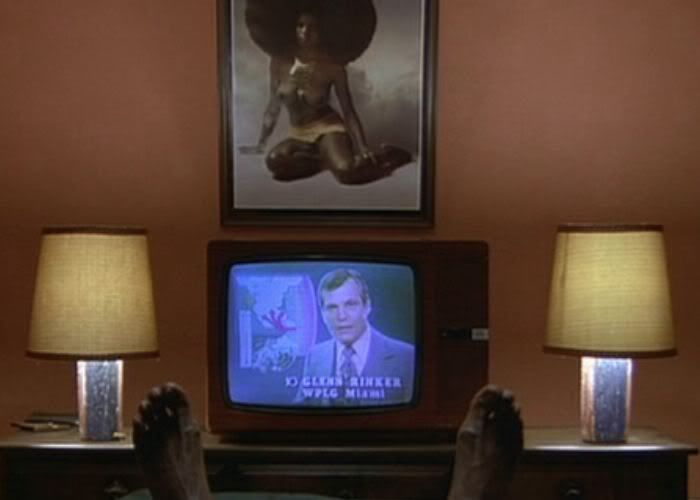
Where are some examples of Stanley Kubrick’s use of the color red?
The red key to room 237.
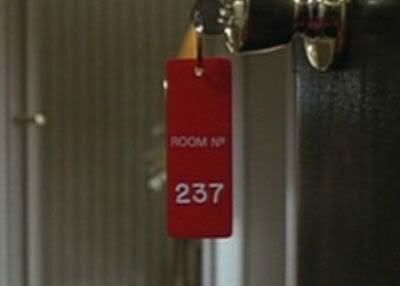
The red bathroom in the Gold Room where Jack has his vision of Grady.
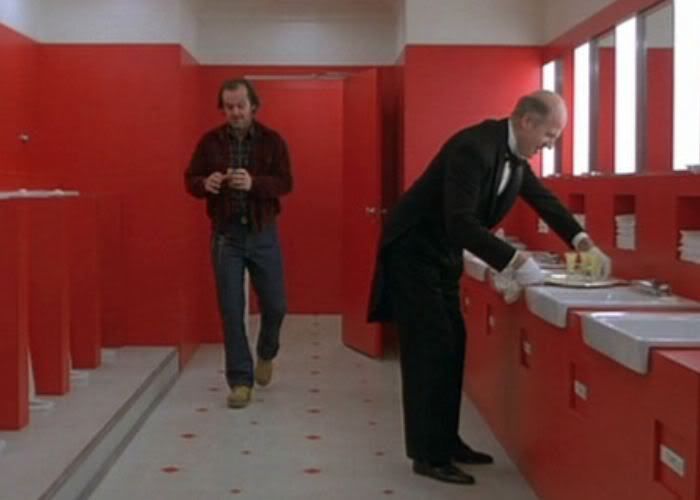
The red Calumet can as Dick Hallorann "Shines".
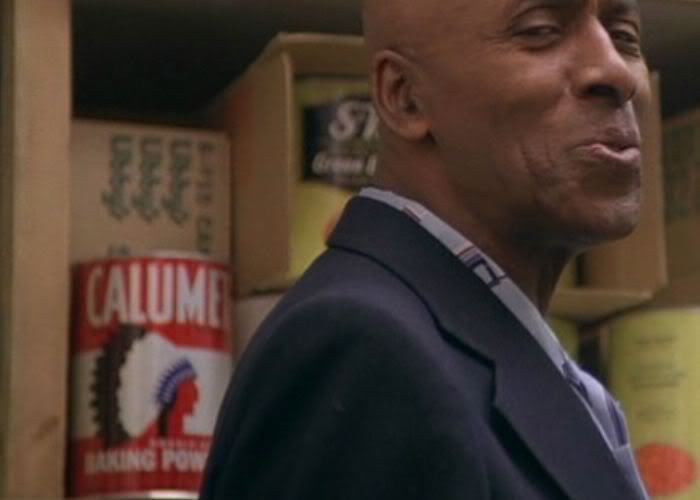
The red Calumet can again and Jack’s red jacket as he "Shines".
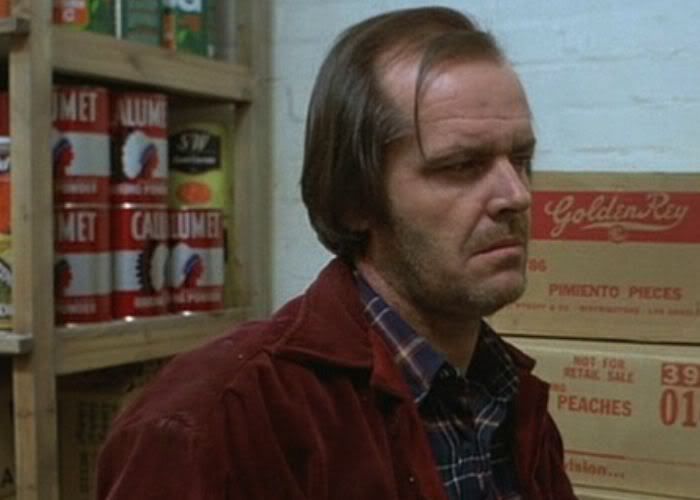
The red elevators.
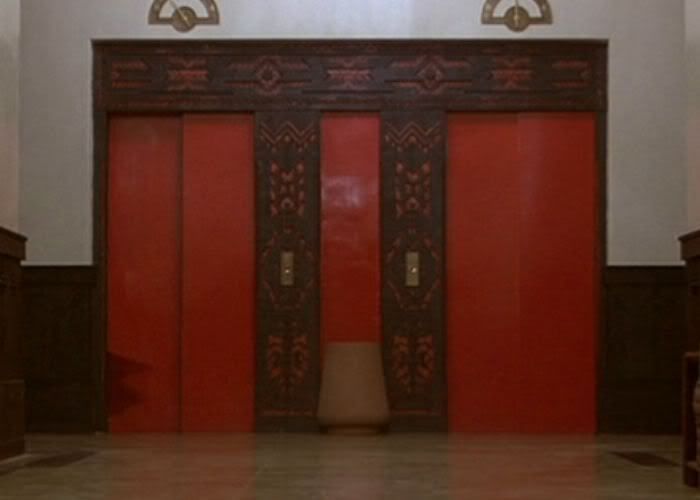
Danny’s red sweater as he "Shines".
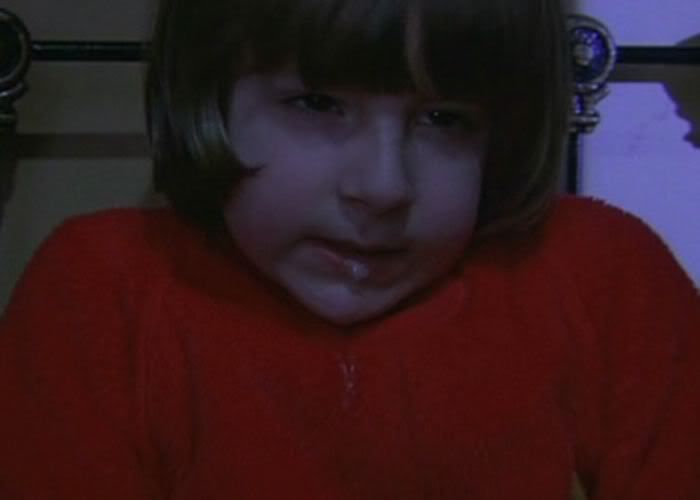
The red picture behind Dick Hallorann while he's “Shining”.

The red lipstick.
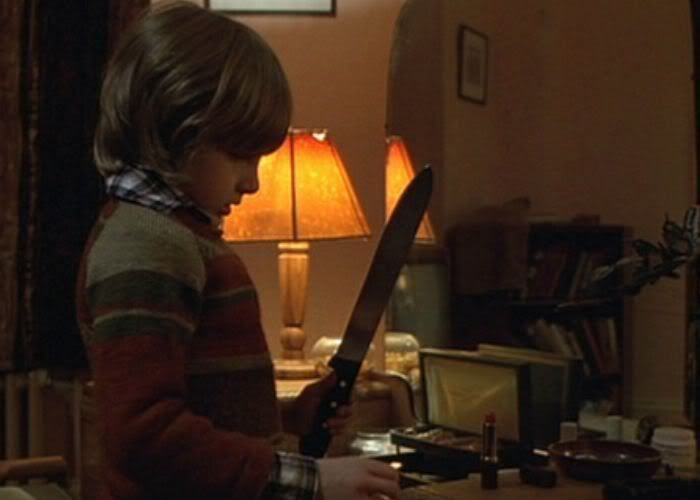
Red darts just before his vision of the girls.
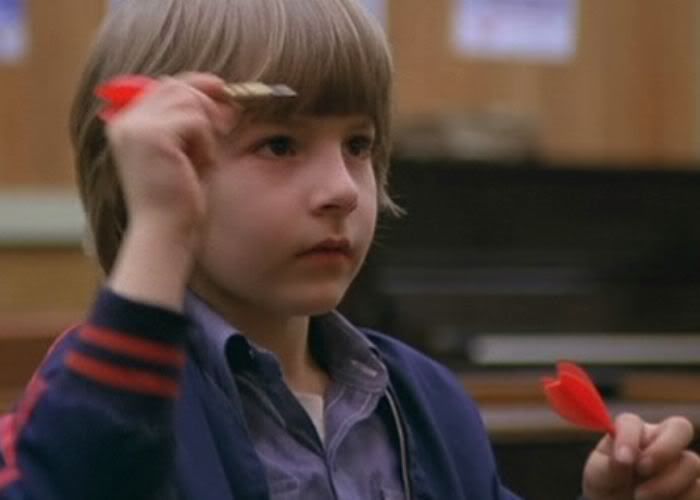
The important number 42 is red on Danny’s sweatshirt in his bathroom before the vision of the bloody elevators.

And of course; Redrum
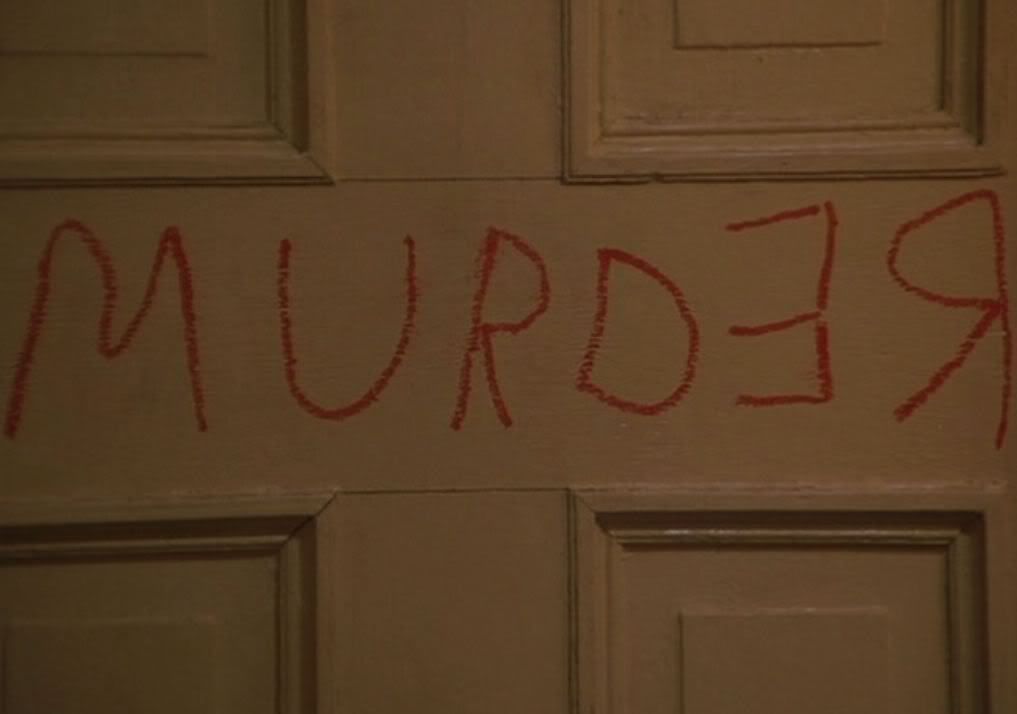
If you read the novel you’ll note how hard it is to find what colors the VW and snowmobile are because each is mentioned only once. The red VW is in Chapter 4 “Shadowland” (page 25), and the yellow snowmobile is in Chapter 33 “The Snowmobile” (page 188). Again, red and yellow were used very little in Stephen King’s novel and weren’t an indication that someone was "Shining". But I believe in the movie they are. Stanley Kubrick makes this as visual as possible.
It isn’t just the numbers or time codes or colors or mirrors or what was changed in other ways from the novel. It all has to be taken together as I noted two sections ago. When you look at the color reversals I’ve noted together with what moves around and disappears throughout the movie, something massive is going on and viewers invariably will make their own decision on what it is. Just look closely again at everything that moves or disappears than at Wendy and Jack’s bedroom, Danny’s trike, and Mr. Ullman and Bill Watson’s clothes during the interview and as Jack says, “you’ll see what I mean”.
................................ Music
Is The Overlook Haunted Or Does It "Shine"?
“A Shine knows a Shine”, Dick Hallorann from page 217 (Chapter 38) of the novel.
I've alluded to this several times already. There's something in "The Shining" that Stanley Kubrick visually places right under our noses that’s the explanation of where the "ghosts" in the film come from. Only Jack looks into it. Stanley Kubrick took something directly from Stephen King's novel yet most readers have missed its importance in the film, and most viewers don't even know what it is or why we're seeing it. It's the key to understanding Stanley Kubrick's Overlook and it's why Stephen King said this in the quote from USA Weekend that I showed in an earlier section, “My problem with ‘The Shining’ was never the adaptation. I certainly didn’t mind the idea that it was more psychological than supernatural... " If, as most mistakenly believe, the film follows the novel how could he say it’s more "psychological than supernatural"? If you read this section to the end you'll understand what I'm talking about.
By now you’ll either accept what I've pointed out in earlier sections (that Stanley Kubrick is purposefully moving things around between shots, making artwork rugs and sofas disappear, changing the colors of cast member’s possessions, and deliberately trying to make us notice a set of numbers in his movie) or you will not. I did produce screen shots from the film to prove it; but it still may take a little time for some to realize what he's done. Maybe this is all just a big mistake on my part. Sounding a little like Jack as he mocks Wendy, "maybe I’m just seeing things", even though the alterations to the novel that I’ve shown in this blog are precise and cannot be disputed. But this is a horror flick about people who possess an unusual ability and we should expect strange supernatural things to happen. By this point you may be wondering why I don’t believe the obvious; that The Overlook is possessed, and causing things to move around by themselves throughout the movie? Why am I coming up with all sorts of controversial explanations that no one has ever thought of before? After all The Overlook is the most famous haunted hotel in history, just ask anyone who’s heard the story and they’ll tell you. But after viewing this movie do you really think it's that simple?
People are in 2 camps when it comes to who or what is controlling things in “The Shining”. At this point I’ve mentioned it several times and it should be no secret that I believe Stanley Kubrick’s Overlook is not haunted (and I believe he's the only director that could pull something like this off without anyone suspecting). This idea came to me after reading Stephen King’s novel and my belief is not a theory as the dialogue taken from the film and the alterations he made to the novel are exact and can't be ignored, “Remember what Mr. Hallorann said.... Danny. It isn't real.” Examine your criteria for judging what’s real and what isn’t in the film. If Stanley Kubrick tells us that Grady’s daughters aren’t real how can you possibly say that their father Grady is real? They’re the same – a vision seen by someone who posses the “Shine”. If Stanley Kubrick reverses the colors of the main props in the film (and so much more), how can you not expect him to reverse the most important plot point of the story; is The Overlook haunted? But how on earth can anyone prove something like this without Stanley Kubrick being around to ask - and to explain. If we could ask him he probably wouldn’t tell us anyway. So, I’m writing this now well after I thought this blog was finished because I just keep discovering new things about this fascinating movie. It will not stop, it keeps “pulling me back”.
How does “The Shine” work when Dick Hallorann knows Danny’s nickname is Doc?
What I’m now going to explain started out with a little problem I had. From the story we know that Dick Hallorann has the supernatural ability to “Shine” but when he uses his special gift how does it actually work? I was looking at this interchange and it lead me to one of the most important and fascinating secrets in this film (I say, “one of the most important secrets” because there are so many);
Dick Hallorann: Well I think we can manage that too, Doc. Come along now. Watch your step.
Wendy: Mr. Hallorann, how’d you know we call’em 'Doc'?
Dick Hallorann: Beg pardon?
Wendy: Doc. You called Danny 'Doc' twice just now.
Dick Hallorann: I did?
Wendy: Yeah. We call him Doc sometimes, you know, like in the Bugs Bunny cartoons. But how did you know that?
Dick Hallorann: Well I guess I probably heard you call him that.
Wendy: Well, it's possible, but I honestly don't remember calling him that since we've been with you.
Dick Hallorann says to Wendy, “I guess I probably heard you call him that.” and this bit of dialogue is the explanation of how the “Shine” works. We never actually see this happen in the film but he’s telling her the truth; he actually heard her call him “Doc”. It’s undeniable as Stanley Kubrick gives us plenty of evidence that people who possess the “Shine” can hear conversations that occur out of earshot and can see things happening over long distances. At 1:45 into the movie Danny, sitting in their apartment, is able to use his ability to listen to his parents conversation before Wendy clobbers jack with the baseball bat. When Jack, inside the hotel, has his vision of Danny and Wendy walking in the center of The Hedge Maze at 00:39 he not only sees it but he’s also able to hear what they’re saying outside the hotel. There’s also room 237 that is seen by Dick Hallorann all the way in Florida. So what Dick Hallorann tells Wendy is the truth. He used his special supernatural ability and heard her call Danny, “Doc” before they met. That’s how he knows the nickname. Stanley Kubrick cleverly includes this in the dialogue also so there’s absolutely no confusion as to when Dick hears her use the nickname “Doc”. “I honestly don't remember calling him that since we've been with you”. His attention to detail here is unbelievable as all the bases are covered. Wendy uses the nickname a lot and obviously knows she said it earlier in the hotel before they all met Dick Hallorann for the first time. Here’s how it happened in the novel. "[Dick Hallorann] snapped his fingers as if he had forgotten something. "What's my name, now? I guess it just slipped my mind." "Mr. Hallorann," Danny said, grinning. "Dick, to your friends." "That's right! And you being a friend, you make it Dick." As he led them into the far corner, Jack and Wendy exchanged a puzzled glance, both of them trying to remember if Hallorann had told them his first name." He didn't, and in the novel this is where Dick Hallorann knows that Danny can "Shine" (page 51, chapter 10). In the film this is reversed and we're alerted to the "Shine" when Dick Hallorann knows Danny's nickname is "Doc", not when Danny knows Mr. Hallorann's first name, Dick. A total mirror reversal.
Can Dick Hallorann or any of the others read minds, like Danny does in the novel?
Dick Hallorann can hear conversations out of earshot but can we ever be sure if he was able to know the nickname "Doc" by reading Wendy’s mind? This is such an important question. Unbelievable attention to detail again as the answer to this is also in Stanley Kubrick’s dialog. This simple line is so easy to pass up as being unimportant as Jack says, “Mr. Hallorann, I'm Jack, and this is my wife, Winifred." It's her actual name and Jack never uses the nickname Wendy in The Overlook before they meet Dick Hallorann. Not only do we never actually hear the name, Wendy, but Stanley Kubrick shows us that example of how she's introduced and there’s no evidence that Jack doesn’t introduce her to everyone they meet in exactly the same way. Jack says, "Hey Babe" when he calls her up after the interview, and even Mr. Ullman never calls her Wendy as we always hear him say Mrs. Torrance. The nickname Wendy is simply never heard in The Overlook until later. This is the point of a seemingly meaningless fluff sentence Stanley Kubrick added to the dialogue, “Mrs. Torrance, your husband introduced you as Winifred. Now are you a Winnie or a Freddie? - I'm a Wendy.” It’s obvious that Dick Hallorann doesn’t know her nickname is Wendy and there’s only one reason for this; when he “Shined” he never heard anyone call her Wendy inside the hotel. He doesn’t read her mind at all; he simply never heard the name Wendy. There should be no confusion here; Stanley Kubrick points us to this by bringing up the two nicknames, "Doc" and "Wendy" and Dick heard only one of them with his special ability, not the other. He knows Danny's nickname and doesn't know Winifred's. "Now what kind of ice cream do you like Doc? – Chocolate? - Chocolate it shall be." Do you see how obvious Stanley Kubrick makes this, Dick can't read Danny's mind or he would have known the answer to that question. This is one of the alterations Stanley Kubrick made to the novel that I spoke of before. In the novel Danny is able to read peoples minds. In the film people who possess the “Shine” don’t read minds. The opposite thing happens. Images are "Shined" into people's minds.
Is The Overlook haunted?
Now the reason I’ve brought all this up is because it has everything to do with The title of this section; whether or not The Overlook is haunted. It's so important because it proves who has the ability to “Shine” in the movie. Like Dick Hallorann said, “Not things that anyone can notice, but things that people who ‘Shine’ can see.” They all see the visions of previous hotel guests because they all possess the same supernatural ability. This is not an opinion or a theory on my part; it comes directly from the script of the movie itself – and all of them see the visions I’m talking about. Either there are real card carrying spirits of it’s previous guests or the Torrance’s’ are imagining what they are seeing in the hotel. There’s no other answer and most have probably made up their minds about this long before reading my blog. But you should consider this; what we in the audience perceive as “ghosts” can actually be something quite different. Grady, his daughters, the party guests, and the old woman are all visions of former guests from The Overlook’s past. And there is a difference between a ghost and a vision. “Well, you know Doc, when something happens it can leave a trace of itself behind. Say like if someone burns toast.” He’s talking about visions of things that have happened in the past, not “ghosts” and only people who possess the “Shine” can see these visions from the past.
The images Stanley Kubrick shows the audience of former hotel guests and employees are coming directly from inside the minds of those who possess the supernatural ability to “Shine”. The very same special ability we're told enables them to see these visions. When Dick Hallorann says “Not things that anyone can notice, but things that people who 'shine' can see", Stanley Kubrick is telling us only people with the “Shine” can see these visions. Jack and Wendy see visions because they “Shine”. Dick Hallorann knows all about Danny’s ability and he's making the boy aware that he might be seeing visions of past events during his stay at the hotel. These images may appear to the audience as ghosts but the fact that they’re inanimate visions inside the Torrance’s minds is clear from reading the script. The implication of what Dick Hallorann is saying here, “it's like pictures in a book “, "it isn't real", is definitely not ‘and by the way Danny if you happen to see any twins walking around they aren’t real but what your father sees, well that’s real’. What he’s implying is that any spooks that Danny, or any one else, might be seeing are “not real”. What Tony heard Dick Hallorann say is not specific to a certain “ghost” or he would have said so. He doesn't tell Danny what any of them look like. And if we know that the Grady twins, that Danny sees before his discussion about "The Shine" with Dick Hallorann, aren’t real then none of the other “ghosts” are real either. “Remember what Mr. Hallorann said. It's just like pictures in a book, Danny. It isn't real.”
I believe Stanley Kubrick put an almost unbelievable twist to his version of The Shining and no one realizes it. He’s totally inverted Stephen King’s novel where The Overlook was obviously possessed and the cause of everything supernatural that happened in it, and this is what Stephen King was talking about in that quote I just mentioned, more "psychological than supernatural". Many don’t agree with me and the end of this blog is littered with negative comments to this effect. If you're one of these skeptics just look at your index finger and in Tony's voice repeat Stanley Kubrick’s dialogue over and over, “Remember what Mr. Hallorann said.... Danny. It isn't real.” The statement can't be un-explained. It comes directly from an expert on the “Shine” and couldn’t be clearer; the Grady twins Danny’s seeing aren’t real. They can’t hurt him, and like the other visions would definitely not be able to unlatch a locked door for Jack or for that matter be able to beat up Danny. As I showed two sections ago, something else is happening and causing those physical manifestations. My problem in getting this across is that visually from the audience’s point of view, there's no difference between an actual ghost haunting a hotel and an inanimate vision of a past guest created inside of a character's head. How can anyone watching this film possibly discern whether what the Torrance’s see are products of their own minds or actual “ghosts” haunting The Overlook? To us on a movie screen they would both look exactly the same. And that “was” my problem; they would all “look exactly the same”. If cast members have the ability to “Shine” and see visions, how could I possibly know whether these visions are products of their own minds or actual “ghosts” haunting a possessed Overlook hotel? Again, it has to be one or the other. There’s nothing else to go by except the source novel, but Stanley Kubrick reversed so much. How could he not be tempted to take what every person that knows the story believes, and secretly reverse that also? Stanley Kubrick has us guessing, and fooled, all the way to the end about what’s really causing the Torrance’s visions. I can’t think of one other director that could think up or would even try to pull off a deception like this. When Stephen King said about the film, more "psychological than supernatural"; what do you think he was talking about? Jack could have gone mad anywhere and it may have started a long time before the movie starts. Wendy has been in The Overlook for months yet the “ghosts” waited till the end of the film, the final night as she fears for her life, to appear to her. Throughout the movie she’s seen nothing out of the ordinary. It’s clear that her state of mind after seeing Jack’s novel is what brought out her ability to “Shine”. Then she’s able to see the visions of her worst fears that she couldn’t see before. Jack says in his interview, “She's a confirmed ghost story and horror film addict”. Being chased by her insane killer husband wielding an ax would make anyone scared to death and this coupled with her special ability to “Shine” is what makes her see visions of what appear to us as spirits from the great beyond. Did you know that “ghosts” are only mentioned 2 times in the movie, and each time has something to do with Wendy. Wendy and Jack’s “Shine” seems to evolve as the movie progresses. It’s their current mental state that brings out the special abilities that aren’t obvious to us at other times. Wendy simply doesn’t see any visions until the end of the movie when she’s fighting for her life. In the novel Jack’s possessed by The Overlook, and in the movie we’re led to believe, that it possesses him again. Reversing this without the audience noticing is truly a masterful deception on the director’s part. If you ask anyone who’s seen this movie on the face of the earth, except me, they’ll tell you they’re sure The Overlook is possessed and controlling poor Jack. Everyone believes this, but do you really think it's that simple? I'm saying that the exact opposite is true and;
I will prove it to you.
We’re looking at yet another inverted Kubrickian reflection; the opposite of what we all thought was real. More of the same mirrored alterations he made he made to the novel. And again this is no theory; like the VW and snow mobiles, what's red is now yellow and what's yellow is now red, and in typical Kubrick fashion not even remotely obvious. So very well hidden.
Why doesn’t Dick Hallorann know about room 237 or any of The Overlook’s ‘ghosts’?
One thing has always bothered me and I’ve mentioned it several times earlier. We have a real dilemma here that appears, on the surface, to be a major plot error in Stanley Kubrick’s dialogue. Hardly anyone ever brings this up when discussing the movie because if you believe the hotel is haunted you have to ignore or try to un-explain what I'm going to discuss now. Why doesn’t Dick Hallorann tell Danny any specifics as he talks about their ability to "Shine" in the kitchen? He does in the novel. He tells him all about room 217, Mrs. Massey, the maid, and lots of other stuff; why does Stanley Kubrick have him know nothing about the most important room in the hotel? Dick Hallorann has lived in the Overlook for some time and has the same ability as Danny. He can see and hear the exact same things that Danny can. Dick had to have seen the exact same visions of The Overlook's previous guests. Danny sees the vision of the Grady twins just before he meets Dick Hallorann. If they were lingering around the hotel like "burnt toast" Dick would have known about them. Why doesn’t he warn the boy about this cast of spook show characters they’re all going to meet during their stay? If The Overlook is truly haunted by certain "ghostly" members of the Grady family, Lloyd the bartender, and a crazy old lady in room 237 – he must have seen them also - why doesn’t he tell him about any of them? Now before you put a silly comment at the end of this blog, please read this quote very carefully,
“What about Room 237?”
“Room 237?”
“You're scared of Room 237, ain'tcha?”
“No I ain't.”
“Mr. Hallorann, what is in Room 237?”
“Nothing, there ain't nothing in Room 237”
His answer is simple yet concise, and in the context of this story quite shocking; Dick Hallorann doesn’t know a thing about room 237 at all. In fact Danny has to bring it up in their conversation; yet another reversal of the novel where Dick brings it up. He knows nothing about that room and there’s also no error in me suggesting that he knows absolutely nothing about “ghosts” either. And if he did know anything about a “ghost” haunting room 237 he would have told Danny so;
“Mr. Hallorann, are you scared of this place?”
“No, I'm scared of nothing here.”
In the interview Mr. Ullman tells Jack about the Grady murders and I get the feeling he would also be proud and mention it if his hotel were haunted too. After all he was quite truthful with Jack and did mention several horrible murders that happened there. Wendy would have loved to hear that. The place is haunted. Neither Mr. Ullman nor Dick Hallorann mentions “ghosts” because it isn't until Jack arrives that the hotel becomes “haunted” and if that's an incorrect assumption on my part; prove it. Both Dick Hallorann and Mr. Ullman have been there for years and neither says a thing about “ghosts”. Dick Hallorann is one of the true heroes of American literature, he risks his life for Wendy and Danny and in the film he gives his life for Wendy and Danny. He’s a classic hero in every sense. Yet some believe that he somehow knew something more, and didn’t want to tell Danny the whole story. He doesn’t want to scare young Danny so he tells him nothing about the crazy woman in one of the rooms who’s going to try to kill him. Think about it for a minute, this is an utterly ridiculous and unfounded assumption. Like I showed before with the nicknames, he only tells Danny what he knows. But how can this be so? How can he not know about room 237? He lives in what everyone believes to be a haunted hotel and he also has a supernatural ability that would enable him to see it’s previous guests running around? “Not things that anyone can notice, but things that people who 'shine' can see." Well we know for sure he can "Shine". In the last quote Stanley Kubrick tells us that there is absolutely “nothing” in room 237. “Nothing” is in there and if there were something in that room Dick Hallorann would have known about it and would have told Danny so. He doesn’t tell him because even with his supernatural ability he’s never seen anything in any room; and “Nothing” cannot beat you up. The old woman is a vision that’s not "real". Something else attacks Danny while Jack is sitting at his desk having a nightmare, imagining himself killing his family. And again Stanley Kubrick's dialogue through the mouth of Dick Hallorann couldn’t be more precise and cannot be ignored, “Nothing, there ain't nothing in Room 237”.
Dick Hallorann has true character. He never lies to anyone in the film and Stanley Kubrick uses him to convey to the audience all the facts about "Shining" that we’re aware of. He doesn't know and doesn't tell Danny about "ghosts" haunting The Overlook because he's simply never seen any himself. Just like the nickname and the chocolate ice cream I just spoke about. He doesn’t read minds and doesn’t talk about things that he knows nothing about. While he’s been in the hotel he’s never seen Grady or his daughters and he knows absolutely nothing about room 237. Don’t think that he would use his “Shine” to know the future and be able to see what Jack was going to become later in the story because as I mentioned two sections ago with the Calumet cans; Jack “Out Shines” Dick by quite a bit. They don’t have the ability to read each others minds and he isn’t able to see the ax in his future! But he has lived in the hotel and would know about any “ghosts” running around.
What is the important prop that Stanley Kubrick has placed on Jack’s desk?
It appears that in Stanley Kubrick’s “Shining” both Danny and Dick Hallorann have the exact same ability to see visions of previous hotel guests yet the one who’s been there the longest and knows the most about the “Shine”, has seen the least. Again, what’s the reason for this? On the surface it seems the only thing that’s changed in The Overlook is Jack Torrance walking through the front door. He also has the ability to “Shine” and brings this along with his mental illness to the hotel (click here). But there is something else! Jack has seen something inside The Overlook that Dick Hallorann is not aware of and has never seen himself. It's something that Stanley Kubrick barely lets us see and never explains even though it's probably the most important prop in the whole movie. I’ve never even seen this item mentioned in any another Internet article before mine was published. The only reason I ever noticed it was because it moves between shots every time we see it without ever being touched by anyone. I thought it was just a trivial prop and never even knew exactly what it was or it’s significance to the story until I read Stephen King’s novel. The novel is tremendously important for a true understanding of the movie – the two go hand in hand. They’re mirror images of each other, Doppelgängers “If I may be so bold, sir”. Dick Hallorann knows that things happened in The Overlook’s past and tells this to Danny, “I think a lot of things happened right here in this particular hotel over the years, and not all of them was good.” But he doesn’t know any specifics; he especially doesn’t know what any of The Overlook’s previous guests look like. But Jack does! Jack knows exactly what all the most colorful (and dreadful) guests look like. And he knows this on the very first day shortly after his interview with Mr. Ullman. Don’t forget it’s like, “pictures in a book”. But what book? In the dialogue Stanley Kubrick is pointing us to something important, something that only Jack knows about and only he’s seen. It’s the scrapbook that I’m talking about. We see it open on his desk but never really know what it is. When he looks into that scrapbook, he knows exactly what they all look like; the party goers, Lloyd, Grady’s girls, the old woman who killed herself, and the putative “ghost” - Delbert Grady; they’re all pictures in that book and with his special ability Jack makes them come alive in his mind, and than the minds of his family. The mysterious scrapbook is most important to his story and Stanley Kubrick even mentions it in the dialogue. It's easy to pass up this significant statement during the discussion in the bathroom when Jack says to Grady, “I saw your picture in the newspapers” he’s referring to the unexplained scrapbook we see open on his desk throughout the movie. It's simple, if Jack had never opened it up he would never know what Grady, or any of the others, looked like (he might not have ever gone mad either). Dick Hallorann has obviously never seen it or had any access to it. This is why he isn’t specific with Danny. He’s not a mind reader and doesn’t mention anything about the previous unsavory guests to Danny because he doesn’t know anything about them. He’s only seen “all the best” people’s pictures; if they aren't on the walls - Dick knows nothing about them. It’s Jack and his ability to “Shine” these images into the others mind's that makes all of the previous guests and the hotel itself seem to come alive. But remember what I mentioned in the beginning of this blog; Stanley Kubrick’s Overlook never makes so much as a single spooky sound, no screams, no eerie moans or groans, not a single creek. Now you know the reason for this.
When does Jack first look into the scrapbook?
We never actually see anyone look into the scrapbook but Stanley Kubrick lets us know that Jack has had an opportunity to see it right from the start of the film. Proof of this is in the script taken from the interview in Mr. Ullman's office at the beginning of the movie;
“Bill, I'd like you to meet Jack Torrance ... ”
“Jack is going to take care of the Overlook for this winter. I'd like you to take him around the place soon as we're through ... ”
“Well, before I turn you over to Bill, there is one other thing I think we should talk about. I don't want to sound melodramatic, but it is something that's ... ”
“I don't suppose they ah told you anything in Denver about the tragedy we had up here during the winter of 1970? ... ”
“(Grady) ran amok and ah ... killed his family with an ax … stacked them neatly in one of the rooms in the West Wing, and then he ah ... then he put both barrels of his shotgun in his mouth.”
The script shows that Bill Watson took Jack "around the place" after the initial interview and that Jack knows about the Grady murder suicide. He knows about the murder suicide and he immediately sees pictures of what the Grady's look like. If you missed this clue in the dialogue you would think that Jack's only tour of The Overlook occurred later with Mr. Ullman and the rest of his family. The reality is that Jack goes on 2 tours. Bill Watson takes him on his 1st tour right after the phone call to Wendy telling her about getting the job – just before Danny’s 1st vision of the bloody elevators - just before Danny has his seizure in the bathroom – before any “ghosts” appear in the film. Jack knows what the two girls look like from the scrapbook right from the start before anything supernatural ever happens. He “Shines” that image of them into Danny’s head in the bathroom exactly the same way he “Shines” room 237 into Dick Hallorann’s head as he sits in his bed in sunny Florida, thousands of miles away. Exactly the same way Dick Hallorann “Shines” his voice into to Danny’s mind at the beginning of the film. I believe Danny’s vision of the bloody elevator happens at the same moment that Jack looks into the scrapbook on his first tour of The Overlook. Stanley Kubrick doesn’t let us see the first time Jack looks into the scrapbook but don’t let the short duration of the cut between the phone call and Danny’s seizure in the bathroom fool you into thinking there wasn’t enough time. We don’t know for sure exactly how long Danny was standing at the sink. The tour with Bill Watson is when Jack had the opportunity to know about the scrapbook's existence and also look into it.
In the novel (Chapter 17, page 97) Danny has a vision in the doctor’s office. Tony shows him Jack finding The Overlook’s immensely important scrapbook on his own, hidden in the hotel’s basement, and that’s where it stays throughout the story. The hotel uses it to lure Jack, and Danny knows “that some books should not be opened”. This Sentence is so important and Stanley Kubrick utilizes it twice in his film. In the novel the manager lures Jack into the basement where he decides to write a novel about The Overlook (page 151); “He would write it because the Overlook had enchanted him — could any other explanation be so simple or so true? He would write it for the reason he felt that all great literature, fiction and nonfiction, was written: truth comes out, in the end it always comes out. He would write it because he felt he had to.” In the movie this is all inverted, as Jack writes nothing at all. He just copies the same plagiarized nonsense over and over. Stanley Kubrick is so clever; Jack isn’t a writer at all in the film. He makes the scrapbook in the film another book that should definitely, “not be opened”. He’s taken one more sentence from the novel and secretly inserted it’s meaning into his story. Stanley Kubrick craftily downplays the unexplained scrapbook placing it innocuously on Jack's desk throughout the movie but it's just as important there; only you might have never realized it if you didn't read this blog. This simple line, “some books should not be opened” is taken by Stanley Kubrick and made into a cornerstone of his story because the scrapbook in his film is where the "ghosts" reside.
How do I know there’s no basement in Stanley Kubrick’s Overlook?
Stanley Kubrick reverses the novel where the scrapbook never leaves the basement. In the movie the scrapbook is never in the basement in the first place because in his Overlook there isn’t any basement. I mentioned this before; think about the scene in the movie as Wendy runs to Jack during his nightmare. The boilers are on the same floor as the Colorado Lounge. If you don’t think this is correct watch the scene again very closely. We see the spot where Wendy appears during Jack’s nightmare earlier as Danny takes his trike tour. We can see that there are no stairs that could lead down to a basement in that area. Stanley Kubrick put only EXIT signs there, no stairs to run up, and no basement to leave the scrapbook in. Even though Mr. Ullman says this in the dialogue, “Dick, can we borrow Mrs. Torrance for a few minutes? We're on our way through to the basement – I promise we won't keep her very long.” There is no basement in Stanley Kubrick’s Overlook, it doesn’t exist.
As they talk in the kitchen, is Dick Hallorann lying to Danny about the visions he may see in the hotel?
The reason why Dick Hallorann never sees anything out of the ordinary in his time at The Overlook is because The Overlook’s "ghosts" only come alive after that scrapbook has been opened. What an incredibly well hidden plot point. Dick Hallorann has never seen the book before and it’s the reason why he never tells Danny any specifics about the previous guests from The Overlook’s past. This cannot be ignored, he obviously doesn’t know what any of them look like, and he can't tell Danny about something he's never actually seen. He does tell him that his special supernatural ability will enable him to see things though; “Not things that anyone can notice, but things that people who 'shine' can see.”, but he obviously can’t tell him exactly what he will see. Again just like this quote before proved,
Danny; “What about Room 237?
Dick Hallorann; “Room 237?”
Even the most ardent skeptics about what I'm implying must admit that Dick, remarkably, doesn’t know a thing about that important room. You may think that from watching the actor’s expressions alone you can imagine that Dick Hallorann is somehow afraid of that room, or that he's trying to protect Danny by telling him to, “Stay out of room 237”. Or you may know deep in your heart that Dick Hallorann is lying or maybe he’s putting on a brave face while obviously being terrified. But this is all just guessing because I can say what I believe; Dick Hallorann’s expression is that of sheer astonishment. Stanley Kubrick has hidden this so well by using dialogue instead of visual clues. He knows the audience will fixate on the actor's expression, than what he actually says flies right over our heads. It’s manipulation by a master. What we’re seeing on his face is sheer astonishment that Danny knows something about room 237, a room that Dick knows absolutely nothing about. And my explanation takes into account the two inseparable bits of information that Stanley Kubrick has given us; the actor’s expression combined with what he says. There is no way whatsoever to discern alone which explanation is correct but what's in the dialogue is utterly clear, “Nothing, there ain't nothing in Room 237”. This fact can’t be ignored or changed. He says what he says and in Stanley Kubrick’s story Dick Hallorann never lies or misleads anyone.
In the novel Danny knows that, “... they lie here. Everything is a lie and a cheat.” (page 292) This is the core of Stanley Kubrick’s brilliant manipulation of the audience and this thought never pops into anyone’s mind at all. He's in total control of what we're perceiving at any given moment. We’re taken in one direction by what we see on the screen but than we're told something entirely different in the dialogue. Both must be taken together. But it’s in the dialogue that most of the explanation of “The Shining” is hidden. What Stanley Kubrick has Dick Hallorann say in this story is the gospel truth. If the two "ghosts" of the Grady twins that he mentions in the dialogue are what "isn't real" (Remember; when Danny and Dick talk in the kitchen, Danny has already seen the vision of the Grady twins.), how can you possibly believe that Delbert Grady is not the exact same thing; a vision inside a persons mind that "isn't real" and is "just like pictures in a book"? This comes from the mouth of the expert on the subject of "Shining", not from me. If you believe that Grady's "ghost" opens the storeroom door releasing Jack it goes against the dialogue directly from Stanley Kubrick’s pen. This is a movie, not real life and Dick Hallorann is the only person that knows anything. Either you believe everything Dick Hallorann says or you believe nothing he says; there is no in between. It’s about truth and lies. If you choose not to believe everything Dick Hallorann’s character says in the movie you'll need to clarify the criteria you're using to pinpoint what's true and what's a lie. In the context of this film this will be a very slippery slope for you. What are you going to use to figure out the truth; are you going to believe only certain things he says, every other thing he says, just what he says on Tuesday, what only seems right in your mind, what fits your specific agenda? None of this alters the fact that in the context of Stanley Kubrick’s story, he’s either telling the truth or he isn’t.
I choose to believe Dick Hallorann when he says this line, “They've turned out to be completely unreliable assholes. Ullman phoned me last night, and I'm supposed to go up there and find out if they have to be replaced.” It’s his explanation of why he’s returning to The Overlook and I believe it because I never heard Dick Hallorann lie to anyone in the story. His statement is the truth and it’s proof that Mr. Ullman “Shines”. This doesn’t disturb the reality of this movie one bit, “But, there are other folks though mostly they don’t know it, or believe it” Who is Stanley Kubrick referring to in this sentence? Mr. Ullman was watching the very same vision of Jack walking into room 237 as Danny and Dick because the phones are out and he had no possible way of knowing this except by first hand knowledge. “They've turned out to be completely unreliable assholes”; Mr. Ullman knows this because when he sees that vision he knows something has happened. He knows Jack has opened the scrapbook. I’ve never seen anyplace in the story where Dick Hallorann ever lies or misleads anyone. If you’re skeptical about all this I’d like you to go through the dialogue and indicate where he’s lying and where he’s telling the truth and post it so I can know for sure. You can start by un-explaining this line that ‘The Cult of Grady’ has so many problems with, “Remember what Mr. Hallorann said. It's just like pictures in a book, Danny. It isn't real.” If Dick Hallorann ever lies – go to the end of this blog and prove it! And if you can’t there’s no reason I can find why I shouldn’t believe what he says. I’m not interested in opinions; if Stanley Kubrick has him ever lie to anyone in this story, prove it.
In his conversation with Dick Hallorann how does Danny know about room 237?
One person’s vision cannot become another’s “ghost”. An inanimate hallucination cannot move something. The beating Danny gets, Jack’s yellow ball rolling toward him as he plays on the carpet, the red key in the door, and Grady opening the locked storeroom door all have the same explanation. There’s only one evil entity inside The Overlook and we know from Dick Hallorann in the kitchen that "nothin" scares him before Jack Torrance shows up. Jack does it all himself. He has the ability to “Shine” visions into others minds and can also move things through telekinesis. And he's going slowly and completely nuts. But how could Danny know about room 237 on his first day in the hotel when he brings it up during the discussion with Dick Hallorann in the kitchen? The room was never mentioned to Jack in the interview. Again the dialogue tells us Jack learns about the murder suicide from Mr. Ullman just before his tour of the hotel with Bill Watson. After looking into the scrapbook Jack knows exactly what happened to the old woman and he knows which room it is - 237. With his supernatural ability he's able to "Shine" that image and the room number into Danny's mind the same way he "Shines" the image of room 237 into Dick Hallorann's head in Florida. It's exactly the same as with the Grady twins. Think about this. How could an inanimate vision of the Grady girls that Dick Hallorann tells us "isn't real" possibly know Danny's name as he has his vision of them in the hallway saying, "Come play with us Danny .... "? There’s no way they would know his name. If they’re a vision that Stanley Kubrick tells us, “are like pictures in a book” they couldn’t possibly know Danny’s name as they would just be an image lingering around The Overlook like “burnt toast”. He would be able to see them and know what happened to them but they wouldn’t talk to him or know his name. He’d be seeing a vision of the past and nothing more. But Jack knows Danny’s name and also knows what the girls look like from the scrapbook. He "Shines" the visions into Danny’s head the same way he "Shines" the room number 237, and Stanley Kubrick's dialogue proves all this. When Jack “Shines” he’s able to make it appear to Danny that the vision of the 2 girls is actually speaking to him.
How does Stanley Kubrick’s dialogue prove the ghosts are all in Jack’s mind?
Stanley Kubrick has Jack repeat the same obvious line, "I wish we could stay here for ever, and ever, ever." as the Grady girls, "Come and play with us, Danny, for ever, and ever, and ever". In the movie Jack’s subconscious is obviously the author of this line similar to a ghost’s line in the novel, (page 197, Chapter 34). “If you can't save me at least come play with me... forever, and forever, and forever.)”. Look at this other quote from the novel (page 228, chapter 41 "Daylight"), "Get it up!" the drunken dog man cried out from around the corner. His voice was both violent and despairing. "Get it up, Harry you bitch-bastard! I don't care how many casinos and airlines and movie companies you own! I know what you like in the privacy of your own h-home! Get it up! I'll huff... and I'll puff ... until Harry Derwent's all bloowwwwn down!" He ended with a long, chilling howl that seemed to turn into a scream of rage and pain just before it dwindled off." The fact that Stanley Kubrick takes this line from Roger's I'll huff... and I'll puff ... speech in Stephen King's novel and has Jack say it in the film as he's axing down the bathroom door is so obvious. This is just beautiful. Stanley Kubrick has Jack saying the “ghost’s” lines from the novel. He’s subliminally telling us that the ghosts from Stephen King’s novel have now become Jack Torrance. Here’s something else that’s interesting about the scene of Jack breaking down the door with the ax. Stanley Kubrick may have been inspired to change a Roque mallet into an ax by a 1921 Swedish silent film "The Phantom Carriage" (Körkarlen). The date 1921 is not only in the final photo, he has it pop up several other times in “The Shining”.
Stanley Kubrick said this in his interview with Michel Ciment, “I've always been interested in ESP and the paranormal…. I thought {The Shining} was one of the most ingenious and exciting stories of the genre I had read. It seemed to strike an extraordinary balance between the psychological and the supernatural in such a way as to lead you to think that the supernatural would eventually be explained by the psychological: "Jack must be imagining these things because he's crazy". This allowed you to suspend your doubt of the supernatural until you were so thoroughly into the story that you could accept it almost without noticing…” This is so brilliant. What balls! He’s telling Michel Ciment exactly what he’s done to Stephen King’s novel and poor Michel doesn’t realize a thing. Now the audience cannot “suspend [their] doubt of the supernatural” for one moment. Even when the very explanation is told to them several times in the dialogue. Delbert Grady "isn't real" and in the movie his image is all in Jack's mind, he's "just like pictures in a book". A masterful deception that I know will make the heads of a lot of my readers explode. Stanley Kubrick helped perpetuate Stephen King’s brilliant creation but he makes the answer to the question of whether or not the place is haunted quite obvious in the dialogue, it “isn’t real”. What book do you think Stanley Kubrick is referring to, and just what “isn’t real”? It’s the scrapbook on Jack's desk that the, "pictures in a book" line is pointing us to. The most famous haunted hotel in history, The Overlook, and in the movie we’ve all been fooled by the master; it isn’t haunted at all. Unbelievable!
How does Stanley Kubrick indicate in his dialogue that The Overlook doesn’t “Shine”?
You might be saying to yourself that deep down I know it’s The Overlook making the Torrance’s see these visions. After all if they can “Shine” visions into each others minds than the hotel can do the same thing to them. Except the hotel doesn’t “Shine”. It’s the opened scrapbook filtered through Jack Torrance’s sick mind that makes the hotel seem to come alive for its guests. For me this is no longer a subject of debate but at one point I wondered if The Overlook actually could “Shine” like it’s guests and possibly be the cause behind the supernatural occurrences that happen inside it. It's a plausible explanation but then I looked deeper. Murders and deaths happened at the hotel but we’ve never seen and just don’t know, for comparisons sake, exactly what it was like before Jack appeared there. And I do believe that Jack is causing the supernatural occurrences inside it. Danny is the reason for what happens in the novel and we know this because Stephen King tells it to us. But with the movie we’re not so lucky and if Jack’s the reason for what’s happening there how could we ever know, not having seen what took place in the hotel before the Torrance’s arrival? But we do know someone who knows exactly what it was like before they showed up because he’s worked in the hotel for some time and also has the ability to "Shine". As I mentioned before when Danny talks with him over ice cream Dick Hallorann obviously has no knowledge of the hotel having the same special power that they posses. Stanley Kubrick even tells us in the dialogue that the hotel doesn’t “Shine” so there should, in theory, be no confusion about this. When Dick says this to Danny, “It's just that, you know, some places are like people. Some 'shine' and some don't. I guess you could say The Overlook Hotel here has somethin' about it that’s like 'shining'." We have to take this as coming from someone that knows exactly what they’re talking about. Stanley Kubrick is an expert on the use of our language; “Somethin' about it that’s like 'shining” is not the same thing as “Shining”, it’s somethin’ like it and nothing more. If you look at what Dick and Danny are talking about over ice cream you’ll see he’s simply telling him not to go into room 237, not to poke around The Overlook because with his special ability he'll see frightening things. He definitely would have told him if it was dangerous or if someone was in that room waiting to kill him and this cannot be ignored or explained away. Everyone believes that The Overlook is haunted, making Jack go insane, and causing its inhabitants to see things. But there’s not a shred of proof anyone can point to that any of this is caused by the hotel at all. If you find this hard to believe and feel that The Overlook has the same ability to “Shine” as it’s guests just think about this; as I mentioned before everything we’re told about “Shining” comes from one source, the lips of Dick Hallorann. Whether we’re reading the novel or looking at the movie, he’s the only one that knows anything or says anything about it. He’s the board certified expert on the subject and we never hear him lie to anyone. You can't pick and choose what you are or you are not going to believe from Dick Hallorann's lips. Again this is a very slippery slope. The way Stanley Kubrick uses him to hide things in plain sight from the audience has to be marveled at. At first Dick Hallorann tells Danny that, “Some places are like people. Some 'shine' and some don't." Now the audience knows that not only people possess the "Shine". But then in the next sentence he tells us that The Overlook is not one of those "places" that "Shine". I guess you could say The Overlook Hotel here has somethin' about it that’s like 'shining'." Again, “Somethin' about it that’s like 'shining” is not the same thing as “Shining”. It's just like Heaven. Somethin' about it that's like Heaven may be very nice but it’s not the same thing as Heaven.
“Nothing. There ain't nothing in Room 237, but you ain't got no business going in there anyway, so stay out! You understand, stay out!”
Dick knows that Danny with his special talent might see the echo of something horrible that happened in the hotel’s past, exactly like what he knew the maid in the novel saw; a vision of the old woman who committed suicide in room 217. In the novel, The Overlook acts as a conduit and people who “Shine” can see the channeled echoes of what’s happened in its past. On the surface it appears that the same thing is happening in the movie; but now the conduit is Jack after he opens the scrapbook.
Does Wendy see ‘ghosts’ when she “Shines”?
Wendy’s visions are also because of her special ability, and not because The Overlook is haunted or exerts any exotic powers. And she isn’t going crazy. She sees what’s happened there in the past. Listen again to the words of an expert on the subject, “Well, you know Doc, when something happens it can leave a trace of itself behind. Say like if someone burns toast.” Stanley Kubrick explains everything in his dialogue, as Dick Hallorann says, “Not things that anyone can notice, but things that people who ‘Shine’ can see. Just like they can see things that haven't happened yet. Well, sometimes they can see things that happened a long time ago. I think a lot of things happened right here in this particular hotel over the years, and not all of them was good.” Wendy also “Shines” and it’s that ability that enables her to see the visions of previous guests that I mentioned earlier like the popular putative ghost of Horace Derwent,

and the old bloody gentlemen.

Both of whom many believe were mentioned in the novel.
Looking into the scrapbook is what started Jack’s visions. During the final chase scene Wendy is the only one who sees any visions and they all happen after we see The Overlook’s scrapbook closed for the first time on Jack’s desk. It’s another book that starts Wendy’s visions. She never sees anything supernatural until after she looks into Jack’s novel “All Work And No Play Makes Jack A Dull Boy”. At first I thought I had a problem with her visions because there seem to be actual “ghosts” in one of them. I can’t say that The Overlook isn’t haunted if I can’t explain what this vision is.
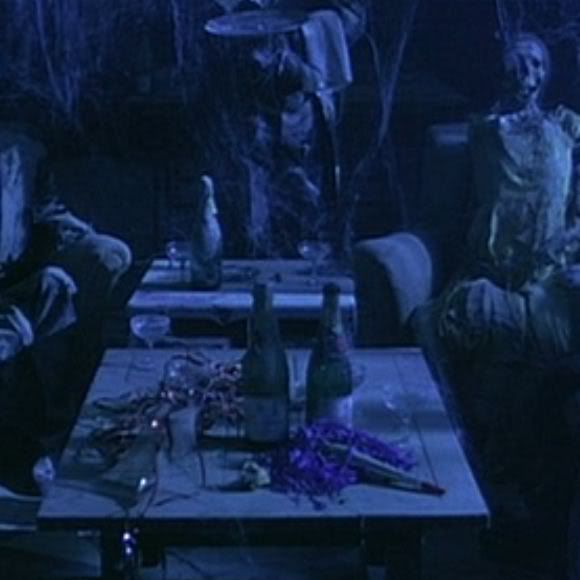 If you look closely we aren’t looking at “ghosts” what we’re seeing are skeletons and the first thing that comes to mind is that they’re the skeletons of the party guests that Jack imagines. But if it is it’s the remains of the party guests we’re seeing, not “ghosts” of the party guests. She’s seeing a vision of what Jack’s imaginary friends look like now, in their future. What they look like in their graves.
If you look closely we aren’t looking at “ghosts” what we’re seeing are skeletons and the first thing that comes to mind is that they’re the skeletons of the party guests that Jack imagines. But if it is it’s the remains of the party guests we’re seeing, not “ghosts” of the party guests. She’s seeing a vision of what Jack’s imaginary friends look like now, in their future. What they look like in their graves.Where is a list of the visions in “The Shining”?
If you think about it the visions in this movie are the only occurrences that would lead us to believe The Overlook may be haunted, or is exerting any supernatural powers. This is what the director wants us to believe but his dialogue tells us something different. It might be interesting for you to stop now and take a look at a list of the visions the character’s experience in “The Shining” (click Here).
If The Overlook is haunted how did it lose all its powers at the end of the film?
If you still believe the hotel is haunted you have a tremendous and quite obvious conundrum that needs explaining and I’ve mentioned it in a previous section. For those who insist on believing that The Overlook is controlling poor Jack, and refuse to look at other explanations, think about this; how is it that the “ghosts” or “demons” that possess the hotel were able to lure him to the Overlook, show themselves to Jack, mysteriously let him out of the storeroom and help him throughout the movie, yet they couldn’t show him the way out of the maze at the end when he had a very sharp ax and the hotel was lit up like a Christmas Tree? You can say that the movie had to end somehow but how did The Overlook utterly loose all of its special power so quickly? Even when Wendy and Danny were right in the middle of The Hedge Maze. That would have been a perfect time to off them; nothing happened! Some say Jack slipped to far into madness and the hotel was not able to help or control him anymore, but this is nonsense. The Overlook never controlled any of them. This is not how a truly possessed hotel would have let it end. Throughout the movie there’s no indication that Jack’s level of mental illness did anything to hinder him in his mission as he progressively got sicker and sicker. Think about it, The Overlook didn’t loose any powers in the end of “The Shining”; it never had any powers in the first place. It’s all Jack and Jack is the key. And don't forget that he doesn't know about his special ability and this is explained in the dialogue, “... there are other folks though mostly they don’t know it, or believe it”
What about Stanley Kubrick’s Indian burial ground?
...“Where'er we tread 'tis haunted, holy ground.” - Lord Byron
It may take a little time for you to digest all this. Even though I don't, you may still believe with all your heart that The Overlook Hotel is haunted. Well there may be a glimmer of hope you can hold onto. In the dialogue Stanley Kubrick infers that there’s something else that may be haunted. I didn’t mention this in the section about “things that move” but one of the biggest and most obvious continuity errors in “The Shining” is their breath. There are scenes taking place in sub zero temperatures but you can’t see their breath, the “white plume” as Stephen King describes it in the novel. In the final chase it’s very distracting but it happens anytime they’re outside and even in the freezer scene with Dick Hallorann. This must mean something, it's just so obvious. Here's something else Stanley Kubrick has changed from the novel. The guy who takes Jack around on his first tour, Bill Watson, is related to the original owner of The Overlook. His grandfather built the place and the first soul to die there was his son as it was being built. Watson is the owner of the scrapbook in the novel. In the film we know none of this and Stanley Kubrick makes this seemingly insignificant alteration as Mr. Ullman tells us that, “The site is supposed to be located on an Indian burial ground, and I believe they actually had to repel a few Indian attacks as they were building it.” This is never mentioned in the novel but some believe the spirits of dead Indians are inhabiting The Overlook. As I mentioned several times already Stanley Kubrick is a master at using the English language and if you read the words very closely this sentence is obvious hearsay. Mr. Ullman has no firsthand knowledge of what he’s saying to them. It’s just a rumor that was obviously included by Stanley Kubrick to keep Indians in viewer’s minds through the movie (again it’s nowhere to be found in the novel). Through the years it has certainly worked well. Stanley Kubrick also adds this in the dialogue so you'll know it's all a joke as Mr. Ullman tells them the year that The Overlook was built, “construction began in 1907 and was finished in 1909.” There were no "Indian attacks" in 1907 or 1909. But even though, the Indian burial ground rumor has a lot of mysterious significance for some, because it can’t be disproved, The Overlook may actually be built on an ancient burial ground. In the novel The Overlook is possessed by evil but in the movie it’s the ground that may very well be where the evil lies. Even though we see snow, and frigid temperatures are “suggested”, the air is obviously not cold. This is worth thinking about; there may be a reason we don’t see their breath. There may be heat we can’t see that’s coming from way down in hell. But it’s still Jack that has the power in the film, and he’s slipping into insanity. In the movie there’s nothing that can be firmly pointed to which can be used as evidence that The Overlook is haunted or can even “Shine” (I also find no correlation between the scrapbook and the Indian burial ground). My explanations are just as plausible and are backed up by the film’s dialogue. If you’d like to read my take on the American Indian – “Shining” connection theory click here.
Could Stanley Kubrick actually pull off such a deception; a movie about a haunted hotel that isn’t really haunted?
The novel is so important in the understanding of Stanley Kubrick’s film. He’s showing us a mirror image of it and if you haven’t read it, and have only seen the movie, you would never know about this. The questions posed by this movie would have no answer and what I’m writing now would make no sense at all. You only have half of the story if you don’t include how he altered the novel. And if you attempt to explain the movie’s most enigmatic questions without acknowledging what he’s done; you’ll end up guessing, and probably being wrong. If you’ve gotten this far in my blog maybe you should think of checking out the novel. I know it’s hard for anyone reading this to accept what I believe that the movie’s Overlook is not haunted as it is in Stephen King’s novel, but you must ask yourself after all I’ve just shown you; where do Stanley Kubrick’s reversals to the novel stop? Would he actually not invert the most obvious plot point in the whole story? Would a perfectionist go so far and then just stop? You must be wondering about this right now, and you must be realizing; this is not Stephen King’s Overlook. Here the Torrance’s are doing everything to themselves. It’s not Stephen King’s Overlook, it’s Stanley Kubrick’s Overlook and he did go all the way. But some people still want the “ghosts” to be real and will resist any notion that they aren’t. It’s almost like telling someone there’s no Saint Nick. Hopeless, till it eventually sinks in. Stanley Kubrick could come back from the grave and explain it all but they still won’t accept what’s in his dialogue and images if it goes against a pet ‘theory’. This is what I believe "The shining" is actually about. The faith people put into this story is unshakable and Stanley Kubrick may actually be mocking that type of faith.
What did Stanley Kubrick say to others about “The Shining”?
In “Stanley Kubrick: A Life in Pictures”, Jack Nicholson recalls that Kubrick said “The Shining" is an optimistic story because "anything that says there's anything after death is ultimately an optimistic story." Stephen King actually says the same thing when he talks about the time Stanley Kubrick called him at home and I think this conversation (1:23 into video) was where he got the idea to pose Jack the way he did in the final photo (next section). Are you still sure this is an optimistic story? Don’t think that this statement alters anything I’ve written. Stanley Kubrick just does the same sly thing to Jack Nicholson that he did in his interview with Michel Ciment. What a piece of work! Talk to him about “The Shining” and he gives an answer that pertains to the novel, and not his film. By now you should know that the two stories, like Charles and Delbert Grady, are two entirely different entities. But still ask anyone what the most famous haunted hotel in the world is and you’ll get the same answer; The Overlook, and it actually doesn’t even exist. He definitely succeeded in putting one over on everyone; Stanley Kubrick has made a movie about a haunted hotel (the most famous haunted hotel in history) that in his version is actually not haunted at all. What other director would or could even try to pull something like this off. Again the proof is in the treatment he gave to Stephen King's novel. The inversions I’ve already pointed out cannot be ignored; where do they end? Like I just mentioned, does anyone really think a perfectionist like Stanley Kubrick would stop right at the end in his alteration of the source material? I challenge anyone reading this to come up with a valid reason why he would not alter the very core of the story in the same way he altered the color of the Volkswagens and snowmobiles, or the locations of each scene. If you think about it there's not one shred of evidence anyone can point to that the movie Overlook, as evil as the ground it was built on may be, has done anything to, or affected it’s inhabitants in any way. It’s just where the story takes place and nothing more. There’s just as much evidence that they did it all to themselves, and that’s the beauty of it; the ambiguity. What I’m saying is very controversial but why would Stanley Kubrick make this point so ambiguous if his Overlook were actually (as everyone believes) haunted?
............................. Music
Why Is Jack In That Photo From 1921 At The End Of The Movie?
“Wild, dark times are rumbling toward us, and the prophet who wishes to write a new apocalypse will have to invent entirely new beasts… “ - Heinrich Heine
Stephen King gets it; that’s why he hates the film. He may not know the answer to his most puzzling question, ‘why he did this’? But he knows exactly what Stanley Kubrick did to his story. He knew the moment he saw that ugly yellow Volkswagen at the beginning of the movie. Yet for the audience the most puzzling question about “The Shining” still is and will always be; why is Jack in the photo at the end of the movie? Stephen King knows exactly what that’s all about also. You’re not going to believe it when I show you where Stanley Kubrick got the idea for the July 4th picture. The one place no one ever thinks of looking for the answer to this question is in fact the place where the secret of the final photo is. But in the film’s reality just how did it get up there on The Overlook’s wall because it only appears in that spot at the end of the film? It's a continuity error; the most famous hidden continuity error in the history of film. Every other time we’re shown that wall Stanley Kubrick has us see a different set of photos hanging there and Jack is not there until the end.
In Stephen King’s novel Jack dies inside The Overlook by burning to death in the boiler explosion that destroys the hotel. But nothing that simple happens in the film. In another reflected image of the source novel viewed in the Kubrickian mirror; at the end of the movie we undeniably see the exact opposite, Jack frozen solid outside with The Overlook Hotel still standing. But what seems to have been included in the original director's cut, shown to the first audiences and than later removed by Stanley Kubrick, is that the police couldn’t find any evidence of what Wendy and Danny said they saw in the hotel. This is very important. For all we know they imagined the whole thing (that’s something to ponder). But the audience is still left looking at the most puzzling and enigmatic picture in the annals of moviemaking.

Before I talk about where the idea for the July 4th photo came from you need to know what’s unusual about it. If you just want to enjoy “The Shining” on a basic level what’s in this article won’t matter to you, but if your desire is to delve into a deeper understand of this film we’ll need to first look very carefully at the anomalies contained in the July 4th picture. You can’t really let anything pass by. What level do you want to perceive this movie on? Are you going to believe what’s written on the photo or are you going to believe your own eyes? Stanley Kubrick purposely created a cinematic enigma that he knew viewers would be trying to understand for a very long time. In a beautifully simple way he made the ending of this movie as hard as possible to figure out because the more you look at it, the more you notice. And the more you notice, the more there is to question. No one can argue that Stanley Kubrick release a finished work looking exactly the way he wanted it to. The final shot sequence in this film took several days to complete. It was well planned out ahead of time and what we see on the screen was placed there purposely. And the source of his ideas came directly from Stephen King's novel. It is what it is and can’t be changed. It’s easy to prove that Jack Torrance’s character had never been inside The Overlook Hotel before. But it’s the opposite of what most believe because of this brilliantly manipulative seemingly iconic final picture.
Why do so many people insist that Jack Torrance is a reincarnation of a previous caretaker who had worked in The Overlook?
Stanley Kubrick includes three obvious clues that would lead anyone to the belief that Jack’s been reincarnated and had worked in The Overlook at a previous time. After looking at them you may be wondering how anyone could pose such a seemingly outrageous idea that Jack Torrance has never been in The Overlook Hotel before? But either he was or he wasn’t and Stanley Kubrick wants you to believe that he was. First Jack says this to Wendy as he gets served breakfast in bed, “It was as though I had been here before” Second, you have Grady’s famous line, “I'm sorry to differ with you, sir, but you are the caretaker. You have always been the caretaker, I should know, sir. I've always been here”.
Then we see it! Jack appears standing with partygoers in the black-and-white picture dated July 4th 1921. Ask anybody who’s seen "The Shining" if Jack Torrance has ever been there before and they will all use this photo as irrefutable proof of it. After all it does say “Overlook Hotel” and what it says has to be right, right? How brilliantly the audience has been lead by the nose to this conclusion. It's never questioned. But what if the photo is another of the film’s visions, “just like pictures in a book”? What if isn’t real?
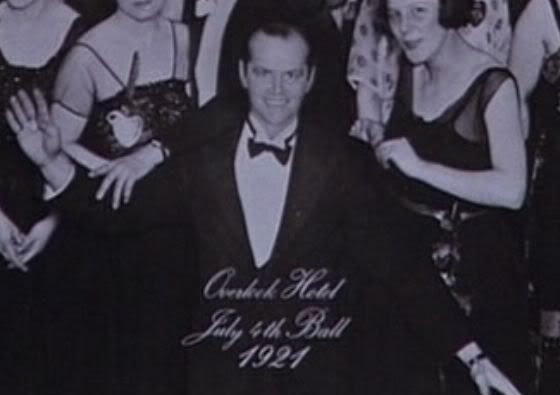
‘Of course he's been reincarnated, I’ve seen a picture of Jack with a date under it from 1921 and I’m absolutely sure of it, it has to be true; are you f’ing crazy?’ The reincarnation theory of Jack Torrance is just that, a theory. The photo is too easy to interpret in that way and we know for a fact that Stanley Kubrick doesn’t ever make things nice and easy for viewer’s interpretation. That's why you're here reading my article. Look closely at the photo. If you really believe it could be this simple why are you reading this article? You know the answer already and you need not read any further as it will just upset you. If you think the July 4 photo shows that Jack has been reincarnated from a previous life and this is as far as you’d like to delve into Stanley Kubrick’s masterpiece then you’ve already figured out the most perplexing mystery in the history of film. Why go any further?
He’s masterfully manipulated the audience yet again. On the surface the picture is just to easy to explain and Stanley Kubrick put these three specific suggestions into our heads that would lead anyone on first viewing to the conclusion that Jack Torrance was at The Overlook in a past life. But you’ve been fooled; Jack’s never been in the hotel before, hasn’t returned, and isn’t Grady reincarnated. Some people hold onto this reincarnation theory like a child's unshakable belief in Santa Claus. But no matter how hard you sound like Natalie Wood saying, “I believe, I believe” it’s just never going to be so. Yet again a master has manipulated his viewers.
"What three suggestions does Stanley Kubrick use to plant it in the audience’s minds that Jack has returned to The Overlook?"
Look closely at the first suggestion; Jack’s statement to Wendy in their bedroom, “It was as though I had been here before. We all have moments of deja vu, but this was ridiculous.” doesn’t prove anything as feelings of “Déjà vu” do not mean you’ve actually been somewhere before. This is simply a suggestion “Shined” straight into our heads by Stanley Kubrick. He wants his audience to believe something. But in the film’s reality, why could Jack believe he’s been there before? Think about this. Jack also reveals to Wendy, “It was almost as though I knew what was going to be around every corner.” for a very good reason. He has the ability to “Shine”! He’s seen the inside of The Overlook exactly the same way that Danny saw the bloody elevator in his bathroom and Dick Hallorann saw room 237 in Florida. They all have the same ability to see visions, “But there are other folks, though mostly they don't know it, or don't believe it”. Jack doesn’t know it! Before he went for the job he’s seen visions or had dreams about The Overlook and this is why he tells wendy about “Déjà vu”. But this conversation from someone who sees ‘visions’ simply can not be used as proof that he’s ever been inside The Overlook before.
Grady’s famous line, “I'm sorry to differ with you, sir, but you are the caretaker. You have always been the caretaker, I should know, sir. I've always been here.” isn’t proof that Jack’s returned to the hotel either because what if Grady's lying? After all he is supposed to be an evil ghost of a nut who murdered his entire family. What if he’s flat out lying? Think about this, in the film Jack’s caretaker of The Overlook in name only. He has not “always been the caretaker” because never lifts a finger inside the hotel except to type nonsense or to kill other cast members. Reincarnated or not, he’s not a caretaker at all! Grady is lying to Jack, “....I should know, sir. I've always been here.” If he’s ‘always been’ there, where is Grady’s face in the final photo? He’s lying!
But that picture of Jack at the July 4th, 1921 party; it just can’t be explained away. On the surface it seems obvious that he’s been inside the hotel before; it’s so clear; Jack in the 1989’s must have been reincarnated as we see him attending a party in 1921. But when you look at the picture closely every single thing about it is a paradox. The image of Jack standing there is akin to a religious icon. Everyone has an unshakable belief in what they’re seeing and this shows the enormous power that can be infused into one enigmatic image. It has a weird glow around it. You may have already guessed; if it were in color the glow would be reddish. There’s a strange faith people have in it. That it’s telling us something truly important about “The Shining” and because of this it's a truly unquestioned image. It says “Overlook Hotel” so that has to be correct. How could anyone not see or believe this? The picture is a lie though, and the audience must be aware of the visual inconsistencies contained there before coming to any firm conclusion about it. These inconsistencies can’t be explained away or ignored, and I believe when I show them to you they, along with where Stanley Kubrick got the idea for the photo, will prove without a doubt that the picture depicts something else and even though you have a certain perception after viewing "The Shining", Jack Torrance hasn’t been reincarnated. The inconsistencies are all one big ball of wax. You can’t just look at one or two of these anomalies and think you’ve got it all figured out. They have to be addressed as a whole because Stanley Kubrick included all of them in this one photo.
What self-contradictions has Stanley Kubrick placed in the July 4th photo (click on each link for an in-depth discussion)?
Click on each link for an in-depth discussion.
First off the definition of reincarnation is precise; the rebirth of a soul in a [new] body. It’s Jack’s face we see and by the very definition he cannot have been reincarnated because he still looks the same.
It says July 4th but we’re not looking at a summer party. Stanley Kubrick has airbrushed in another obvious clue that it's a New Year's Eve party.
Jack Torrance is not the caretaker in the picture he’s someone special, he’s the manager.
Delbert Grady, Lloyd and the others are top “ghosts” inside the hotel and must be in that final photo – yet they aren’t there.
It’s not The Overlook; look at the palm tree dead center. The picture hasn’t been taken in any room of the hotel. It's such a brilliant but simple deception. Just look at it. What’s written on it is obviously a lie. Jack is not in The Overlook in that picture, no matter what it says. If it is The Overlook go to the end of the blog and prove your point. Link a screenshot from the movie to indicate where this room is located.
Jack Torrance doesn’t belong in that picture.
Stanley Kubrick precisely dates the party in the 1921 photo and the party that Jack imagines seeing in the Gold Room by what we’re hearing. Listen to the song playing in the background soundtrack. It’s from 1932, not 1921. Stanley Kubrick is telling us again that something is not right about the photo.
Jack and Charles Grady were obviously both alive at the same time in 1970. You can’t be the reincarnation of someone who is alive at the same time you are.
Where are all the other caretakers?
It’s not a Ball or a Ballroom.
Stanley Kubrick has Jack singing a special song from the year 1921 just before he dies.
The final picture is not there on the wall at any other time in the movie. It appears only after Jack’s death (and I’ll discuss this again later in this section).
The entire photo is a fake and was specifically produced this way. We know this from Stanley Kubrick’s interview with Michel Ciment. Jack Nicholson's face was airbrushed onto someone else’s body. To quote Danny's imaginary friend Tony again, “it's like pictures in a book “, "it isn't real".
The July 4th photo is (supposed to be) exactly the same as the famous photo of Lee Harvey Oswald with his face purportedly airbrushed in by the CIA. When someone's face is airbrushed onto another’s body there’s only one way to describe the photo; it's been faked. Ton’s of analisis was made on this photo through the years but the one thing no conspiricy nut will ever bring up is; who took the photo and why not ask that person if it’s real or not? Oswald’s photo is not a fake because it was his wife Marina who took it. This is known for sure and conspirisy nuts can whine all they want about it. It’s exactly the same with Kubrickian nuts that whine incesently about the July 4th photo. But it doesn’t change a thing because Stanley Kubrick explained exactly how he created it; and it is a fake. It’s a face airbrushed onto another’s body.
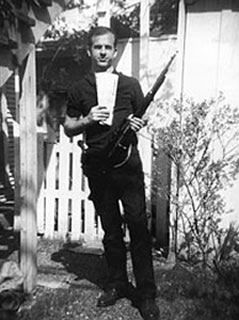
In the photo, it’s not Jack, it’s not July, it’s not a caretaker, the music we hear is not from 1921, it’s not The Overlook, it’s not a Ball, not a ballroom, it’s not the state of Oregon, and it’s not on the wall during the movie. To add even more to all this, an astute anonymous poster alerted me to the most important clue about the picture. Something they thought was going on in that final photo. It seems for some strange reason that Stanley Kubrick may have posed Jack Torrance in the final picture as;
..................................Baphomet
……………………………..……What’s this all about?
Where did Stanley Kubrick get the idea for the July 4th photo?
Before attempting to further unravel the puzzle of “The Shining” you need to look at where the idea for the black and white photo he inserted at the end of this brilliant film came from? When I first started this blog I never dreamt anyone would ever know what that final photo actually means. It's too cryptic and paradoxical and most explanations are simply un-provable speculation or hackneyed nonsense. If you stop and think about what I just showed you about the picture really makes no sense at all except for the fact that in a horror movie about the supernatural, anything can really make sense. For me that's not enough. The only explanation that will work has to either be contained in the dialogue of the movie, the visuals from the movie, or the source novel itself; everything else is un-provable nonsense - no matter how intelligent it may sound. Stanley Kubrick was a brilliant filmmaker and I just knew that there would be a link somewhere in this saga pointing me to its meaning. Knowing where he got the idea for a cryptic black and white photo would make explaining it so much easier. This can’t be debated and surprisingly it turns out that the place where Stanley Kubrick got the idea for this particular black and white photo is right where you would expect to find it, hidden in plain sight, in Stephen King’s novel.
For nearly 30 years that photo has been on The Overlook’s wall and Stephen King never breathed a word about it even though he must know exactly what that final picture of Jack represents because the idea came directly from his novel. The only important (black and white) photo in Stephen King’s “Shining” is the linchpin in understanding Stanley Kubrick’s ending. It’s the only clue to the final picture you can find in the novel and it’s mentioned on page 191 (Chapter 33). It tells us exactly what that enigmatic July 4th photo depicts. Here’s the important excerpt from Stephen King’s novel that led me to the explanation the July 4th picture; “In that instant, kneeling there, everything came clear to him… In those few seconds [Jack] understood everything. There was a certain black-and-white picture he remembered seeing as a child, in catechism class… a jumble of whites and blacks… Then one of the children in the third row had gasped, "It's Jesus!" …. "I see Him! I see Him!" … Everyone had seen the face of Jesus in the jumble of blacks and whites except Jacky… when everyone else had tumbled their way up from the church basement and out onto the street he had lingered behind… He hated it… It was a big fake… [But] as he turned to go he had seen the face of Jesus from the corner of his eye… He turned back, his heart in his throat. Everything had suddenly clicked into place and he had stared at the picture with fearful wonder, unable to believe he had missed it… Looking at Jack Torrance. What had only been a meaningless sprawl had suddenly been transformed into a stark black-and-white etching of the face of Christ Our Lord. Fearful wonder became terror. He had cussed in front of a picture of Jesus. He would be damned. He would be in hell with the sinners. The face of Christ had been in the picture all along. All along.”
There’s only one important photo in Stephen King’s novel and it’s black and white. Stanley Kubrick chose a black and white photo for his final enigma and there should be no confusion about what inspired him to create it. We’re looking at an exact, purposeful mirror image of the paragraph I quoted from the novel. The enigmatic black and white picture we all see at the end of “The Shining” is the mirror opposite of the image of Jesus that only Jack sees in the novel, and this sentence is what Stanley Kubrick used as the blueprint for his black-and-white mystery, “It was a big fake”. In the novel Jack believes the black-and-white picture is "a big fake" but it isn't. In the movie Stanley Kubrick shows us a black-and-white photo that everyone accepts as real without any question, not one iota of skepticism. But the photo at the end of Stanley Kubrick’s "Shining" actually is "a big fake". It’s fake! Jack Nicholson’s face was airbrushed in on someone else’s body. No one ever stops and thinks that this photo and what’s printed underneath are all a lie. It’s was meant to deceive yet we all just blindly accept that it's the truth and that it proves Jack Torrance has been in The Overlook before. And you know you’re right because you've seen the picture of him from 1921 saying "Overlook Hotel". The only question that anyone ever seems to ask is ‘what does it mean’, never ‘is what it depicts actually real’?
Everything in this black-and-white photo is a lie. Jack Torrance was never in The Overlook Hotel in 1921. “[It’s all] a big fake”.
When does Stanley Kubrick’s devil possess Jack?
“God, I'd give anything for a drink. My God dam soul.” Stanley Kubrick puts it all in that one line. You can feel sympathy for Jack's character or not but he took a major wrong turn in life. An evil turn, “if I may be so bold”. I mentioned before Stanley Kubrick’s obvious manipulation of time codes in the movie and this proves it. If you look closely at the time code, the shot where we hear Jack gulp down his first drink is exactly 66 minutes and 6 seconds into the movie. Revelation 13:18; “This calls for wisdom: let the one who has understanding calculate the number of the beast, for it is the number of a man, and his number is 666.” What a creepy touch Stanley Kubrick added.
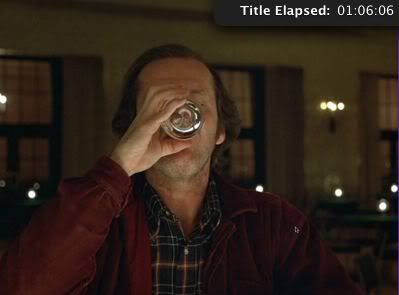
It’s undeniable, the time code is exact to the second from when the story starts after the :11-second Warner Brothers logo is finished. If you don’t believe me “go check it out” for yourself. This special number didn’t just pop up by chance. “The Shining” even contains 666 individual shots (click here). Stanley Kubrick is luring us into a false assumption that Jack’s character is obviously evil in a Biblical sense and the way he’s posed in the final photo proves it. But he doesn’t have Jack posed as Baphomet like the poster thought. Stanley Kubrick grew up in the last century and has Jack Torrance posed as something he’d seen before. Something spooky that represents to most of us, pure evil.
.....In the July 4th photo Jack Torrance is posed as the devil.
Not so fast though! Don’t jump to the conclusion that Jack is supposed to be the devil. There’s something else that’s a huge part of the enigma of this final photo that I discuss a little later; Stanley Kubrick absolutely does not believe in the existence of the devil.
Was I wrong? Do you still believe that Jack doesn't posses the ability to “Shine”? Lucifer means “the shining one”. In one picture from the novel we have the image of the most influential human in history (the ultimate good hidden only from Jack) now becoming in another picture from the movie, the ultimate evil (hidden from everyone). What a perfect mirror image he created. It’s the devil! Jack goes mad and becomes possessed by pure evil when Lloyd gives him that drink; in the final photo he represents the devil! The Manager or Master of Ceremonies in hell. He’s even dressed for the part in the same tux as Lloyd the bartender. Jack being evil in the movie is the mirror opposite of the novel where it’s The Overlook that’s the evil possessing him. If you go back to the paragraph from the novel about Stephen King’s black and white picture you can see just how brilliantly Stanley Kubrick used the source novel. Everything now “suddenly clicks into place.” We’ve “stared at that picture” in wonder for years; “unable to believe we had missed it”. The most enigmatic image in the history of moviemaking and its explanation has been right under our noses all along. Visually he created a true mirror image of the important black and white photo from the novel. A reflection viewed in Stanley Kubrick’s special mirror. “[ Jack ] would be damned. He would be in hell with the sinners.” And this is exactly what Stanley Kubrick has done here. The face of evil has been in the picture “All along.” And it will be there on that wall, “for ever, and ever, and ever.” Stanley Kubrick’s fake black and white photo inspired directly from the real black and white photo in Stephen King's novel.
What’s unusual about the final words Jack utters in, Stanley Kubrick’s “Shining”?
But there’s something else! Stanley Kubrick adds one more brilliant little touch at the end of “The Shining” that must be mentioned. You hear it every time you view the film but I bet you’ve never ‘really’ heard it. The final words spoken in the film; something borrowed from “The Exorcist” and we never would have known about it if a poster hadn’t mentioned this to me. Lightningscream suggested that I, “should watch the film in reverse. Kinda’ like reverse speech.” But even though some believe there are many hidden messages in rock & roll songs, could a message be hidden in a film the same way? I knew that there’s one obvious part of the film’s audio where Stanley Kubrick could have hidden something. People have come up with all sorts of explanations and translations of what Jack is saying at the end of the film. Some think he’s calling to the dead spirits in the Indian burial ground, or the “ghosts” in The Overlook, or a dead Saint, or maybe even the souls of the Donner Party. But after Jack sells his soul and takes Lloyd’s drink he’s been possessed by the purest of evil. Now it’s the big time. The Overlook was the place where all this happened and the scrapbook was the fuel for Jack’s insanity. But you have to listen closely to the 2 last words that Stanley Kubrick has Jack utter to truly understand the depth of what’s happened to him, and where he knows he’s going to be residing, “for ever, and ever, and ever”. It all sounds like gibberish unless you reverse the audio. Then it becomes frightening clear that Stanley Kubrick has hidden 2 of the most incredibly chilling words I’ve ever heard in a film. Hearing them has totally changed the end of the film for me. The anguish and despair cuts right through and the more you listen to it the more disturbing it becomes (click here). Help Me! The final pathetic words spoken by Jack Torrance in “The Shining”, and Stanley Kubrick has him speak them in reverse. Heeelllppp Meeeee. A perfect chilling end to his film’s dialogue. Two words (like the word “Redrum”) brilliantly hidden and like his entire film, only understandable when reversed.
What is truth and what are lies in “The Shining”?
“Evil is unspectacular and always human, and shares our bed and eats at our own table.” - W. H. Auden
Stanley Kubrick is pointing us to a unique characteristic we all have; the ability of the human race to attach blind faith to an image that may or may not be real. And in this case it isn’t. What he's pointing out about us has tremendous implications in our faith, or lack of it. Think about it. Grady’s famous line is a lie, “You are the caretaker. You have always been the caretaker” If you believe he’s not residing in Jack’s imagination you’ll need to explain which of the visions Dick Hallorann talks about that they all see throughout the film, “isn’t real” and just how you know this for sure. Grady, Lloyd and the woman are all a product of Jack's imagination combined with his cabin fever. When we think Jack’s speaking to a “ghost”, he’s actually looking directly at his own reflection in a mirror while we eavesdrop in on each of his visions. A mirror is right in front of Jack’s face each time. Look closely at Jack Nicholson’s eyes in the bathroom scene with Grady. He’s not looking at Grady. He’s looking past Grady at his own reflection as they speak. Stanley Kubrick couldn’t make this any plainer, Jack is talking to himself each time he looks at himself in a mirror. The Overlook’s spirits don’t exist and aren’t speaking to Jack through Grady. Everything is happening inside his mind. The hotel is not causing any of this as it isn’t haunted or possessed at all.
So much is going on below the surface of “The Shining” that it was almost impossible for me to know exactly where to start or in what order I should present it all in. But there’s something here that I must discuss. Something that reaches into the very core of our human nature. It’s amazing how in “The Shining” Stanley Kubrick is so easily able to manipulate the audience into believing that lies are the truth and that the truth is a lie. In the end this may be what the movie and final picture are actually about because, as in life, we have to distinguish between truth and fiction all the time. There's also a continuous conflict in each soul between the "benevolent" and the "malignant". He’s questioning our core belief system (our faith) by showing us how easily we can all be fooled.
He may be mocking or belief system. Actually I’m being a little too nice. Stanley Kubrick may have been a deceptive person at heart because of the way he brutally toyed with the audience. I don’t think he ever thought anyone would make sense out of all this. We can never know for sure? But have you ever stopped and thought about your own beliefs? Why you have faith in what you believe in, or your lack of it? Especially when it comes to the supernatural or even the true existence of God. Stanley Kubrick is doing this for us in “The Shining”. What I’m going to show you now has flown right over the heads of just about every viewer and it’s quite incredible when you think about it. We all left the theater with unique ideas about this film but as you viewed “The Shining” did you stop and think about what Delbert Grady’s character was actually saying? I alluded to this before; was he telling the truth? Of course, he must be telling the truth; everyone knows that Jack’s been in The Overlook before because Delbert Grady says so. No one ever questions his truthfulness because a master has manipulated us in a brilliant way. Grady had some problems with his family in the past but he “corrected” them. He also tries to convince Jack to kill his family. But if you put all these shortcomings aside he has ‘stellar credibility’. Grady is an honest God fearing “ghost” and inside The Overlook, he’s the top “ghost”. But it never dawns on the audience that something is tremendously wrong here. Dick Hallorann’s character is a true hero; he never lies or deceives anyone in the film yet what he says in the dialogue is not believed (click here). Stanley Kubrick not only explains the “Shine” but most of the other secrets about the mysteries of his masterpiece through the mouth of Dick Hallorann, but viewers only believe some of what he says. Some writers will even try to un-explain what his character says in sentences like these. “It isn’t real” indicating that visions like Grady aren't real or “there are other folks” indicating that others (like Jack) have the same ability to "Shine" and don't know it. Or when he says, “Ullman phoned me last night, and I'm supposed to go up there and find out if they have to be replaced.” Indicating that something else, other than Danny calling for help (which he never does at all in the film) is what lured Dick Hallorann back to The Overlook. If you don’t like what Dick Hallorann says in the dialogue and it goes against what you believe you're seeing in this film you’ll be tempted to just ignore what Stanley Kubrick has him say. Grady (A.K.A Jack Torrance) on the other hand has no credibility at all and is believed by everyone, wholeheartedly. How thoroughly easy it is to deceive human beings and in his film Stanley Kubrick plays this card for all it’s worth. It's quite embarrassing.
It can’t be denied; we’re all lead to believe the opposite of what the truth is in this movie. Delbert Grady lies about everything and Dick Hallorann never lies to anyone – it’s so obvious. For some it may take a while but when you finally realize this it’s gonna’ change everything about how you perceive “The Shining”, for good. Stanley Kubrick only gives us certain bits of information to work with. Dick Hallorann says that Ullman phoned him ordering him back to the hotel, and unless someone can find another explanation in the dialogue or prove that it’s a lie, it’s the only explanation there is. And it changes everything about the film.
In the dialogue exactly how does Grady lie to Jack?
If you haven’t read it yet this is what Danny realizes in Stephen King’s novel on page 293 (Chapter 55), “The house always lies”. Stanley Kubrick reverses this sentence and makes it an important reality. In his "Shining" it's now Jack, not The Overlook that always lies. Look closely at the conversation he has with Delbert Grady in the film and remember that Jack is talking to his imaginary friend (his version of Danny's friend Tony - himself) as he talks into the mirrors, not a real “ghost” haunting The Overlook;
Jack: What do they call you around here, Jeevesy?
Grady: Grady, sir. Delbert Grady…. That's right, sir.
Jack: Delbert Grady?
It’s in the name. At first this seems to be just one more enigmatic thing. Another perplexing mystery that Stanley Kubrick placed in “The Shining” that has no real answer. But Grady doesn’t tell Jack his real name. What he says is a lie. We know from Mr. Ullman that his real name is Charles Grady, not Delbert Grady. Most never realize this; what he says is a lie.
Jack: Ah, Mr. Grady... haven't I seen you somewhere before?
Grady: Why no, sir. I don't believe so.
This is another lie. Jack tells us later in this scene that he's seen Grady’s picture in the scrapbook we see opened on his desk. Grady would have known about the scrapbook as it's inside the hotel and holds the pictures of The Overlook’s more infamous guests who aren’t “all the best people”. The ones whose pictures aren’t hanging on the main walls. What he says is a lie because he would have known exactly where Jack had seen his picture (in the novel it’s actually Grady’s scrapbook and he specifically left it there for Jack to find).
Jack: Eh... Mr. Grady... weren't you once the caretaker here?
Grady: Why no, sir. I don't believe so.
Another lie as Grady was the caretaker of The Overlook in 1970.
Jack: You’re a married man, are you, Mr. Grady?
Grady: Yes, sir. I have a wife and ah two daughters, sir.
Jack: And, ah... where are they now?
Grady: Oh, they're somewhere around. I'm not quite sure at the moment, sir.
Another lie as he actually hacked them to death and is not telling this to Jack.
Jack: Mr. Grady, you were the caretaker here. I recognize you. I saw your picture in the newspapers. You ah... chopped your wife and daughters up into little bits, and ah... and you blew your brains out.
Grady: That's strange, sir. I don't have any recollection of that at all.
Another lie as Mr. Ullman tells us that all this happened at The Overlook in 1970. We also now know from the dialogue that the "ghost" Jack is imagining himself talking to looks exactly the same as Charles Grady who was the caretaker in 1970.
Jack: Mr. Grady, you were the caretaker here.
Grady: I'm sorry to differ with you, sir, but you are the caretaker. You have always been the caretaker, I should know, sir. I've always been here.
Another lie because he was the caretaker in 1970. Again if Delbert Grady had, “always been” in The Overlook his face would be in the final photo at the July 4th 1921 ball along with Jack at the end of the movie. And like Jack he would look exactly the same. They were both “caretakers” at the hotel and there have been many others that didn’t try to kill their families. Jack never “corrected” his family but Grady did. Grady would be there with Jack because he’s the number one "ghost" and succeeded at correcting his family. Something that Jack was a failure at. Grady must be in the July 4th photo or what he says is a lie.
Grady: Did you know, Mr. Torrance, that your son... is attempting to bring an outside party into this situation? Did you know that?
Another lie as it’s Jack with his ability to “Shine” who .... is attempting to bring an outside party into this situation. Jack alerts Dick Hallorann that something is wrong at The Overlook. If you find this hard to believe remember that Dick Hallorann knows something is wrong only when he visions Jack walking into room 237, then kissing the woman. He is totally unaware when Danny is strangled and almost killed, which happened several scenes earlier. It's quite obvious that Danny never telepathically calls Dick Hallorann when he's attacked or at any other time. This is extremely important; follow the time line of the movie that I explained in an earlier section. Before Jack meets the old woman in room 237 he’s “Shining” that image into Dick Hallorann’s head, not Danny's. As I showed before, Danny and Dick are both seeing entirely different visions of the inside of room 237 and if you can find anywhere in the film that Danny ever asks for help from anyone. Post it at the end of this blog.
Grady: Your son has a very great talent. I don't think you are aware how great it is, but he is attempting to use that very talent against your will.
This is an obvious lie as Danny never does anything except ride around The Overlook, play with his toys, and watch cartoons until the end when he escapes from his crazy ax wielding father. Watch the movie again if you don’t believe it. Stanley Kubrick plainly hides this in the film. Danny doesn’t even use his ability to “Shine” to get away in the end, he uses his wits. Stanley Kubrick conceals this extremely well but think about it, we hardly ever see him use his special ability in the movie as Danny is still to young to know exactly how it works. Here it’s Jack that, “has a very great talent” and he’s loosing his mind.
And don’t forget the first important thing that Grady says to Jack:
Grady: That doesn't matter, sir. You're the important one.
Obviously this is only true inside Jack’s sick mind as he’s actually a total failure in life and quite unimportant.
What an amazing example of manipulation we’ve been subjected to here with obvious parallels in human society. Because of the way Stanley Kubrick presented the characters the natural instinct after viewing “The Shining” is to believe all the things that the putative “ghost” Delbert Grady says and to ignore what the totally truthful Dick Hallorann says. It’s unbelievable when you stop and think about it. It’s a study in mass manipulation on the highest level and has everything to do with the final photo in the movie, which, as I’ve show, is also not what it appears to be. Ask yourself this important question again. Why do you believe what you believe? Do you still believe that Jack Torrance was at a party in The Overlook in 1921?
Does the final July 4th photo indicate that Jack was reincarnated?
Unfortunately Stanley Kubrick will be no help whatsoever in trying to understand what’s going on in the end of “The Shining”. This is why we’re here poking, prying - endlessly trying to understand this film. Look carefully at what he said about the final scene in his interview with Michel Ciment. He could have told Michel exactly what the July 4th ballroom picture means, but instead he cleverly says this; “The ballroom photograph at the very end suggests the reincarnation of Jack”. What an interesting choice of words he uses as the definition of ‘suggests’ is to cause one to think that something exists. The implication (and deception) here is obvious. He wants Michel Ciment, as well as the rest of us, to “think that something exists” or else he simply wouldn’t have used that word. He wants us to believe Jack’s been in the hotel before – but he hasn’t. Stanley Kubrick is a master of the English language and it’s obvious that what happens to Jack doesn’t even remotely fit the definition of the word reincarnation, the rebirth of a soul in a new body, as Jack’s face has remained the same. Everyone who views this movie is positive they have some unique insight into the puzzling question of what happened to Jack. It’s because the power of this one image, and what it implies, is unbelievable. But look closely again at Jack in the final picture. Remember what I showed you before; it’s undeniably a total paradox. The Overlook's caretaker worked in the winter. July 4th is in the summer and Jack wouldn’t have been there. He isn’t the caretaker in that picture either he’s someone special, The Manager. It isn’t even July 4th, as the only identifiable object Stanley Kubrick airbrushed in with Jack Nicholson’s face when he created the photo would obviously make it a New Year’s Eve party. The song playing in the background didn’t exist in 1921. The photo is definitely not The Overlook and the image of Jack is a fake – a face airbrushed onto someone else’s body. It's obvious that everything here is the reverse of what it appears.


As I brought up earlier; what happened to all the other caretakers that had to have worked in between and before Jack and Grady? “You have always been the caretaker.” Why didn’t they try and kill their families and are they “reincarnated” also? And if this picture actually was The Overlook why would Jack Torrance be invited to that party? He’s an utter failure, as he didn’t succeed in doing his duty to “correct” his family. This can’t be left out; where’s Delbert Grady? If he’s a real “ghost” and not a figment of Jack’s imagination he must be in that picture also. “I should know I have always been here”.
Nothing really fits here. Stanley Kubrick created the ultimate enigma in that photo and if we didn’t look at Stephen Kink’s novel questions about it could never have a correct answer. The photo is truly "a big fake"; the mirror image of the black-and-white photo from Stephen King's novel. It’s meant to mislead and sear a powerful image (that Jack Torrance has been in the Overlook in a previous life) forever into our minds.
The amazingly unshakable power contained in one single image. Isn’t it just as powerful in a movie, if used in the right way?
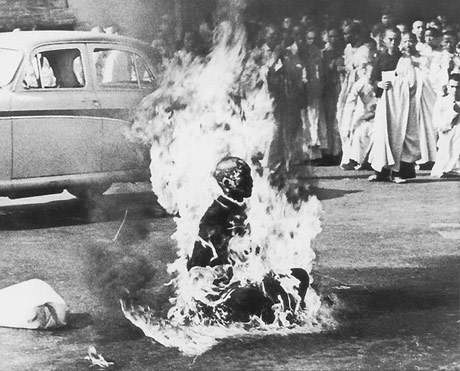

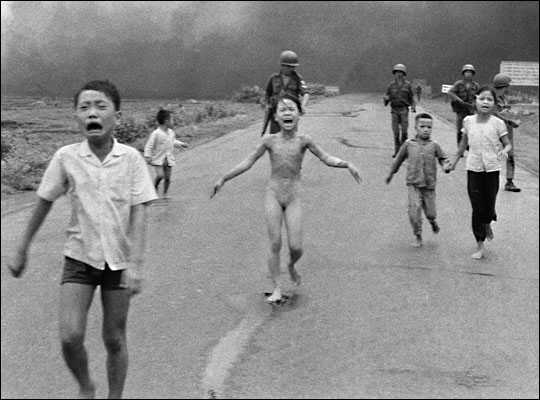
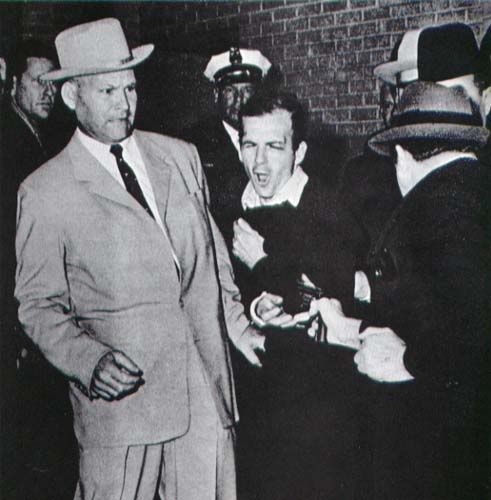
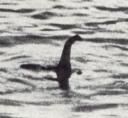
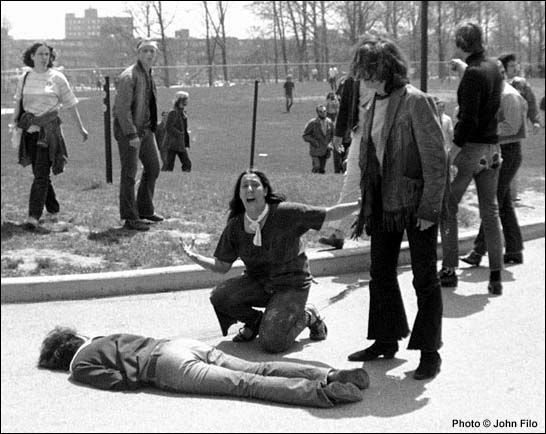


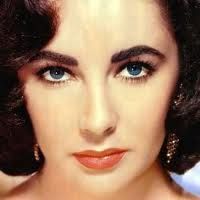


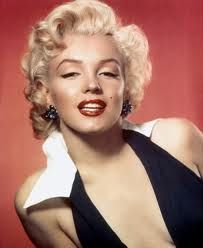
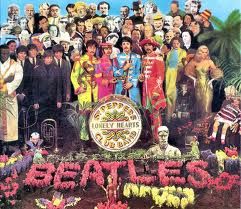



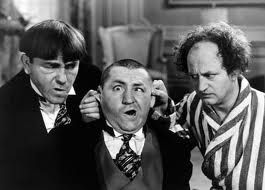
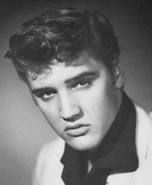
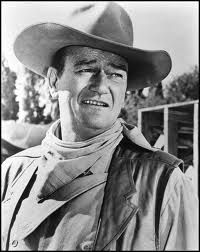

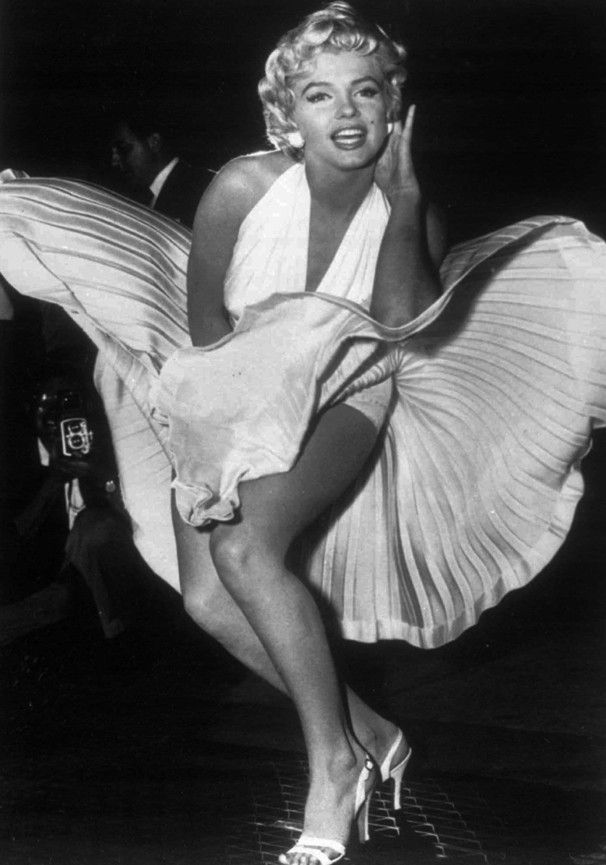


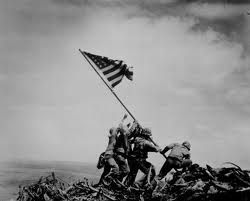

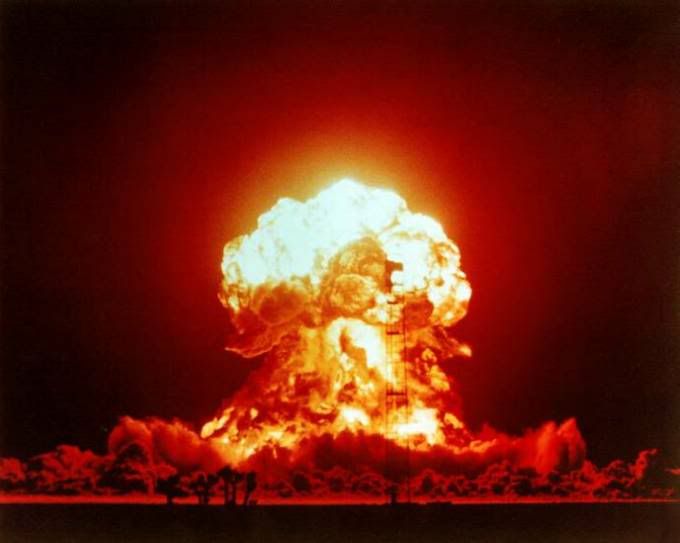
How did Stanley Kubrick weave dialectic theory into “The Shining”?
The answer to these two questions, whether The Overlook is haunted and is Grady a real “ghost” or a hallucination in the mind of a man suffering from “cabin fever”, are really linked to the final July 4th photo. Stanley Kubrick hides the answers in the dualism of truth and lies from his characters own words. Just who is lying and who is not? Is what you are hearing true or false? If someone tells you something you have a choice as to whether you believe it or not. But your choice doesn’t change what that person is telling you. It’s either true or false. You simply don’t know for sure. There's no theory in what I'm saying. The main premise of my blog is that Stanley Kubrick explains exactly what’s going on in this movie using the dialogue he wrote. It’s like Dennis Hopper’s dialectics discussion from Apocalypse Now. We have here either truth or lies - no maybes, no supposes, no in betweens. He's played with Dialectics by creating a script where only two characters tell us all of the supernatural aspects of the story: Delbert Grady and Dick Hallorann. The audience can try to decide if what these characters say is true or false but the reality is that there is no in between. It’s dialectics; an existence of opposing forces; one always lies and the other never does. The explanation of the movie is hidden in the dialogue of these two characters where everything Dick Hallorann says is true and everything Grady says is a lie, and when you understand what's been done here the movie is much easier to understand. If you don't agree with me you'll need to clarify in your own mind what criteria you're going to use in pinpointing what's true and what's a lie. Is some of what they say true, one quarter, three quarters, every other statement? Or just what seems right to you? Do you believe only what supports your opinion or agenda of what's actually happening in this movie. You have to have some sort of criteria that makes sense. You need to remember this is a movie, it isn’t real life. Dick Hallorann may lie all the time when he’s off screen but there is nowhere in the film where he lies or deceives anyone. He's the same as Olivia de Havilland's character Melanie Wilkes in "Gone With The Wind". The purest soul in movies. Someone that doesn't exist in real life. But in film we meet people like this all the time.
In this film Stanley Kubrick has either used his ability as a director to deceive, or to show us how easy it is to deceive. You decide which is right as it’s not what he left out of his film, but what he kept in that’s important.
Who “Shines” in the final scene from “The Shining” after all the characters have gone?
The perplexing final July 4th photo is only half of what’s going on in the end of “The Shining”. Any serious discussion of this film must address the other visual anomalies in the last scene and can’t be considered complete without doing so. Looking at the photo alone is not enough and I’ll start with what’s obvious. Throughout the movie whenever someone “Shines” something moves, changes color or disappears whether inside or outside of The Overlook. Just about all of the props in the last shot except the ceiling and floor have changed, and this adds another dimension to what’s going on here because the question now has to be; Who “Shined” this time? The cast members have all gone, and you must seriously ask yourself; just who’s seeing this final vision of the movie with the song "Midnight, The Stars and You" playing in their ears? We've never see the July 4th picture before this final scene because throughout the film Stanley Kubrick has other photos in it’s place on that wall. But we have heard the music playing at the end of the film before. But how can that be the photo says, 1921 yet the song is from, 1932? We hear the same final song because the final photo is exactly the same as Jack’s vision of Grady and the party, it’s all in the mind. There never was a party in the Gold room except in Jack's imagination. The same way there never was a July 4 party except in our imagination’s. Neither one, as with all the other visions in the film, are real.
Inexplicably the chairs and furniture in the Overlook are not covered throughout the film but in the final scene they are covered. A reversal of what we saw in the novel where the chairs and furniture were covered when the Torrance’s were in The Overlook and uncovered when they weren’t. The Gold Room sign doesn’t change with the same 2 artist’s pictures on it (indicating to me that we’re still in the present time frame – the next day and not in the past). But throughout the film it continuously reverses position across the floor, from left to right and back again each time we see that spot (another deliberate continuity error pointing to the reversals Stanley Kubrick made from the source novel that occur continuously throughout the movie).


The 2 mirrors on the sides of the 21 pictures are gone, replaced by Indian artwork, and the red couch, another place to sit, has now disappeared.
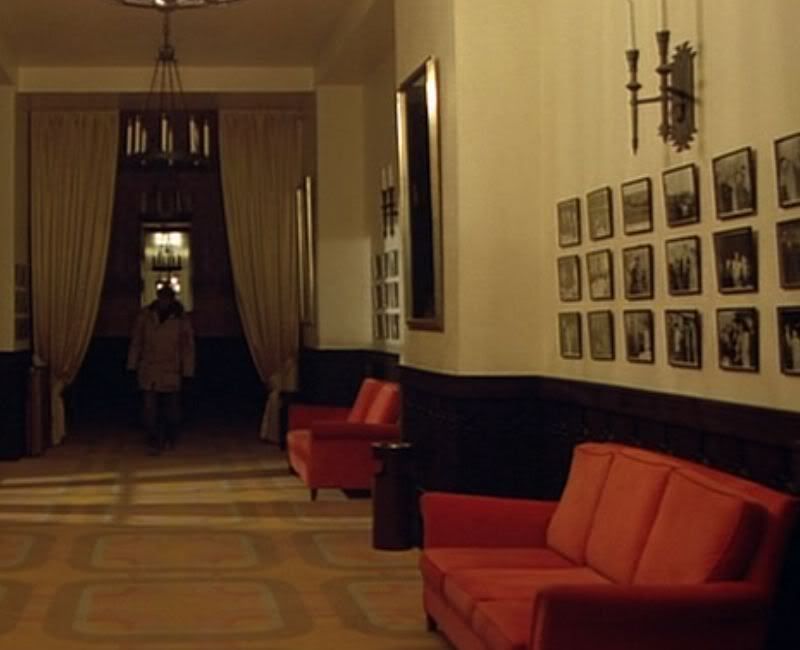
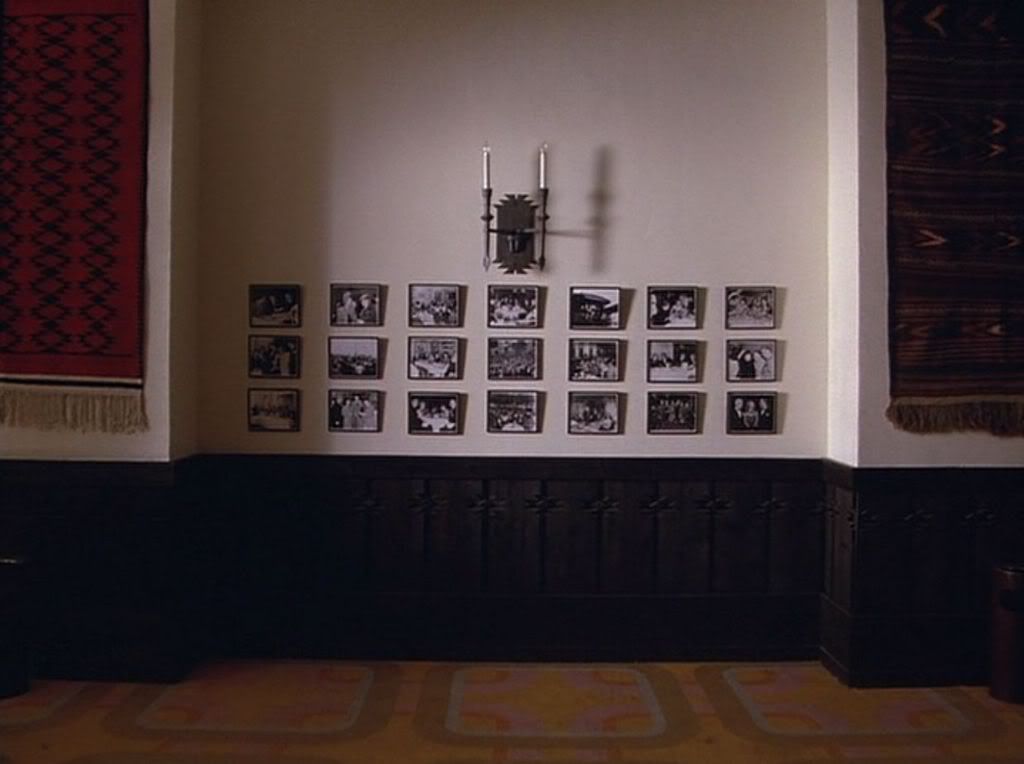
Lastly, don't forget what I just mentioned; the most important deliberate alteration in the whole movie (maybe of any movie in history). The 21 pictures on the wall; the most perplexing continuity error of all time. They’re entirely different from the pictures that are hanging in this spot each of the several other times we see it throughout the movie. And that most puzzling image of all time dead center, “Overlook Hotel July 4th Ball 1921”, just wasn’t there before this last shot of the movie. No one ever notices this when viewing the film. How could all the pictures be different? Did Stanley Kubrick simply forget to hang up the July 4th photo earlier in the movie? Either this is an obvious continuity error or it’s an important part of the movie. There’s a reason for this and it isn’t hanging with any of the other photos inside The Overlook either. The word Shine in the title tells us what paranormal phenomenon occurs in this film.




Anyone who still doesn’t realize that all the major cast members in this movie have a very special ability may be hopelessly thick. Not only do they see visions (past, present and future) and speak together telepathically, they can change the colors of possessions and surroundings, and move objects without touching them. This is what the movie is about. Not only do most of the props in the final scene move on their own, but it’s also obvious someone used this special ability and “Shined” that picture onto the wall right at the end of the movie. But everyone in the story with the “Shine” is either dead or has left the building, and Dick Hallorann told us in the dialogue that The Overlook can’t “Shine”. Who did it this time?
There’s a classic episode of “The Twilight Zone” from 1961 that reminds me of all this, and I bet that Stephen King (and Stanley Kubrick) had seen it as it was one of the best and most well known episodes. In “It's a Good Life”, Billy Mumy plays a child who has a special power that will look familiar if you ever get to watch it. He’s totally evil and is able to transform people he doesn’t like into inanimate objects at will. "Shining" is the only paranormal phenomenon that Stanley Kubrick’s movie is about. It's the power that enables them to see visions. It's the power that moved the Calumet cans behind Dick and Jack's head's in the storeroom. It’s the power that unlocks the storeroom door, and it's the power that transformed the 21 pictures on the wall in the final shot. That’s why that photo just appears out of thin air at the end of the film. It’s the “Shine”, and someone other than the characters from the film is also present in that final scene. Someone else possesses the ability to “Shine”, to supernaturally move things on the screen.
Stanley Kubrick added yet another brilliant twist to this movie (maybe the greatest hidden twist in movie history). In the end as the camera zooms in on that center picture we, the audience, are the only ones there in The Overlook’s lobby. And each one of us as we sit in our chairs watching becomes an integral part of this film. This should come as no surprise because Stephen King got the idea for the title "The Shining" from a line in John Lennon's "Instant Karma", "We all shine on". And our vision is exactly the same as all the rest in the film, “It isn’t real”. Jack was never in The Overlook in 1921 but we, never realizing that it’s us doing it, “Shine” his image to the spot on the wall where thanks to Stanley Kubrick’s suggestions we've been led to believe he was, and belongs; back into the Overlook’s past. And we grant Jack his wish, “I wish we could stay here for ever, and ever, and ever.” In this final vision his only existence is on that wall. Nothing more, nothing less. We've “Shined” him into that picture on the wall. Now he’s where he belongs, in the Overlook frozen a second time for the rest of time, “for ever and ever and ever”. Jack's not in the dusty old scrapbook like Grady, he's on the wall - dead center with “all the best people”. Throughout this entire movie we’ve been guided by the art of Stanley Kubrick’s simple suggestions and are unshakenly positive in our belief that the photo tells us that Jack Torrance was there in a past life. Possibly as the reincarnation of Grady The Overlook’s caretaker who murdered his wife and kids and put both barrels “of his shotgun in his mouth”. But again we’re seeing a reflection, the exact opposite, of what we thought was real. Just like the 2 reflections seen backwards in Wendy’s mirror, "Redrum" and Stovington. Jack was never in The Overlook during a previous life in 1921 because the picture is a fake. But he is now, “for ever and ever and ever”; and you are the one who did it. It’s a vision of Jack’s future. Stanley Kubrick got the idea for the black and white picture from Stephen King but you, with your special ability given by the movie’s brilliant director, are the one who put him there on that wall.
How does the July 4th photo represent past, present, and future all at the same time?
Look again at how thoroughly Stanley Kubrick is showing us a mirror image of what happens in Stephen King’s story. In the novel The Overlook is destroyed, Jack burns to death, and no one remains there. In the movie The Overlook is not destroyed, Jack freezes to death, and remains hanging on the wall forever. In the novel The Overlook always lies and now in Stanley Kubrick’s story, Jack always lies. The inversions are obvious. But old perceptions die-hard and a knee-jerk explanation is that all I just mentioned is nonsense, and the final picture simply has mistakes in it. But there are to many and they’re so obvious. Stanley Kubrick doesn’t make “mistakes” like this without a reason, and anyone who thinks he does should be prepared to prove how they know this for a fact. Anyone who erroneously tries to explain why this photo (the most enigmatic prop in movie history) isn’t there for 99% of the film, to then miraculously appear out of nowhere, as a movie mistake or common continuity error is insulting Mr. Kubrick’s intelligence, and just doesn’t get this film. He placed it there and we can all see it. In the film’s reality there must be a valid and plausible explanation of why it only appears after Jack’s death? Stanley Kubrick didn't go through the trouble of finding an authentic picture from 1921, as stated in his interview with Michel Ciment, and then simply forget to hang it up till the end of the movie. That’s nonsense! Items change color, move around, disappear and reappear throughout the film from the very start and this is more of the same. “The Shining” was released looking exactly the way he wanted it to and we're seeing a brilliant deception. We’re actually seeing people attending a party back in the precise year 1921 but we don’t know what it actually depicts. At first glance the picture looks like the past but do you know for certain whether it’s past, present, or future? Think about how the July 4th picture was produced for a moment because Stanley Kubrick created an image that actually represents all three, the past, the present, and the future all at the same time. Even though it’s an authentic picture from the past taken in 1921, as stated in the interview with Michel Ciment, if you want to be precise you can’t say the picture is actually from 1921 because Jack’s airbrushed face is obviously from the present in the late 70’s when the movie was produced. This fact has to be included in any explanation and no one can say Jack is younger in the photo because his hairline remains the same. The spot where the photo ends up on the wall is the future though. That evil, iconic image of Jack as the devil will remain on that wall as long as movies are seen by the human race. “If I may be so bold, sir” no one will ever take it down. Never to be removed from its special place in The Overlook for the rest of time till the end of time. Jack’s photo from the present, superimposed onto an authentic photo from the past that will remain in that particular spot on The Overlook’s wall forever. Past, present, and future; all represented in this one single iconic image created by Stanley Kubrick. As I mentioned before Jack Torrance finally got his fondest desire, “I wish we could stay here for ever, and ever, and ever.” But he, unlike Grady, didn’t succeed in getting his family to stay with him in the hotel. It appears that his character's been “Shined” into his own private unseeing, unthinking, unfeeling, inanimate hell. Forever, and ever, and ever. A photo on a wall; an inanimate object like the people in the Twilight Zone episode I spoke of earlier.
Who are the people in the July 4th photo with Jack?
In the novel Jack strives to be the manager and doesn’t make it. In the movie he strives to be Grady, his idol, whose photo he sees in the scrapbook on his desk. He doesn’t achieved that goal in the way he would have wished either. But interestingly Stanley Kubrick does have Jack end up like Grady, in a photo, and he looks exactly like he’s the manager. But who are the other people in final July 4th photo? What could they represent? It could be a get together of all the previous “Shiners” who visited The Overlook in the past as the hotel may be a place that attracts this sort? This can't be right because we’ve seen the ballroom in the film. It isn’t The Overlook that we’re looking at in the photo and “Grady isn’t there. The picture might actually depict a different type of end; maybe Jack has somehow conned his way into being The Manager or the Master of Ceremonies in some other hotel in another dimension. A place where Jack is rewarded for effort alone, and unlike during the movie, he’s now someone special? I doubt it because a failure is a failure - anywhere. The people with him could very well be former guests who, like Jack, have passed through The Overlook and taken a similar wrong turn. After all Stanley Kubrick has Jack posed in the picture as the devil! But again the picture is not inside The Overlook, that’s not where they’re gathered. There’s a good reason why Stanley Kubrick has it end up on The Overlook’s wall, and it will be there forever, but they are definitely enjoying that get together someplace other than our favorite “haunted hotel”. Could Jack along with the others have been absorbed into the hotel? This never happens though; the movie Overlook is just an inanimate place where Stanley Kubrick's story takes place and nothing more. Could they all be in hell as Jack is obviously posed as the devil in the photo? Not so fast. Stephen King told us that Stanley Kubrick doesn’t believe in hell. Jack being posed as the devil is just a mirror reversal of the photo in Stephen King’s novel. You have to remember according to the expert Dick Hallorann, the visions aren’t real and the photo is the final vision. On first viewing “The Shining” seems to end with an enigma that clarifies absolutely nothing. Everything about it is a paradox, if it is a vision, according to the expert Dick Hallorann, “it isn’t real”.
You could go on and on, “forever, and ever, and ever” and not get it right because any explanation as to who the people in the July 4th, 1921 picture are is pure speculation. All I've just mentioned are guesses, and unless there's something pertaining to the picture that can be found in Stephen King's source novel all we can do is speculate. Many comment on the things from the novel that were left out of the movie. The two complaints that stand out most are the moving hedges, and the back-story of Jack's past alcoholism and abuse. The hedges were reversed from the front of The Overlook to the back and don't move for a reason, and Stanley Kubrick only mentions what’s absolutely necessary about Jack's alcoholism and the fact that he thinks of himself as a writer (we don’t even know in the film if he’s ever written a thing). But one of the most enigmatic sections from the novel seems to have been left out and no one ever mentions, or misses it at all. The wasps were a huge part of the novel. They seemed to embody the invisible spirits that haunted Stephen King’s Overlook. I could’t imagine Stanley Kubrick leaving them out, just like the Hedge Animals I’ll talk about in the next section. But I looked high and low and couldn't find a single wasp flying around this movie. Nothing remotely alludes to them; not even a lowly fly accidentally landing on someone's nose. Then it came to me. The people in the photo do represent something from Stephen King’s story. They’re the wasps from the novel. He didn't leave them out. If you look at the picture closely every single one of the people at the party are W.A.S.P.’s, and this explanation, as dull and lackluster as it may seem, is the only one that can claim Stephen King's novel as a direct source. W.A.S.P.’s.
You don’t think I’m right, do you? Maybe we need to look at what the boss said about the people in the photo; “... they were in a photograph taken in 1921... I originally planned to use extras, but it proved impossible to make them look as good as the people in the photograph... I think the result looked perfect. Every face around Jack is [an archetype] of the period.” Do you really believe this statement, “it proved impossible to make them look as good as the people in the photograph”? (1976 Oscar, Best Costume Design - Barry Lyndon) But an archetype? This is what stood out for me. What an interesting word he chose to describe the people in the photo. Again the secret ends up being in the words he chooses. I thought I knew what archetype meant but to my good fortune I looked it up in the dictionary anyway. An archetype is “an original model of a person, ideal example, or a prototype upon which others are copied, patterned, or emulated; a symbol universally recognized by all.” But there’s something else that’s more important; in psychology, an archetype is “a model of a person, personality, or behavior.” Psychoanalysis “in Jungian psychology - a primitive mental image inherited from the earliest human ancestors, and supposed to be present in the collective unconscious.” In the photo these people are the mold that Jack springs from. They all have devils in them, exactly like Jack. The devils that cause us to kill. They’re exactly the same as nature’s lowly carbon copy of each other; the wasp, from Stephen King’s novel. Stanley Kubrick’s archetype of every other W.A.S.P. They’re all have the devil in them, Jack’s minions!
I mentioned earlier that there’s never a moan or a ghostly whine, and we never hear a clock tick; The Overlook never makes so much as a single sound, no laughter, no crying either, and very little physical contact. There are also no distinct shadows cast by any of the characters inside of the hotel. This may make you think about something Stanley Kubrick probably read in preparing for this masterpiece, Jung's writings on "The Shadow". “Everyone carries a shadow, and the less it is embodied in the individual's conscious life, the blacker and denser it is.”
What is the July 4th photo ultimately about?
Do you remember how I showed that Stanley Kubrick edited “The Shining” so the film would be symmetrical? Word search this line - ( Where is the obvious symmetry that Stanley Kubrick created with “The Shining’s” time codes? ). What he shows to us in the first frame of the film has something to do with the last frame. “The Shining” begins with a mirror and ends with a mirror. The first thing we see as movie starts is a mirrored reflection in the beautiful blue water of a lake. It’s not obvious but the last thing he’s shown us is another reflection - at the end of the film with Jack posed as the devil we may be seeing the reflection of another mirror. The evil that causes us to hurt our fellow man is actually inside all of us. The way Jack is posed in the photo is a reflection of you! Stanley Kubrick is saying that not only Jack but all of us have devils in us. Remember Stanley Kubrick said, “Every face around Jack is an archetype ... “ a carbon copy.
What is the essential piece of the puzzle that that Stanley Kubrick took out of his film?
All I’ve just discussed explains where Stanley Kubrick got the idea for the July 4th photo and who put it there on the wall, but it doesn’t explain the enigma that shrouds the end of this movie. I spoke about this in an earlier section; Stanley Kubrick did something to "The Shining" that I don't think has ever been done to any other movie in history. He took this line from Stephen King and made sure he really created, “a mystery no living hand will ever solve.” If a jigsaw puzzle has a missing piece it can't ever truly be complete. Stanley Kubrick created a visual jigsaw puzzle and in the end of “The Shining” one of the pieces is missing, and he made sure that the missing piece would never be found. The first viewers of "The Shining" saw a different movie than everyone else and there are no special DVD box sets that include this lost scene. The version of the movie that we see today is not the same movie that was shown to audiences at the initial premiere (and for several days after). Shortly after its premiere Stanley Kubrick decided to excise the mysterious hospital scene from the end of his movie, and to destroy it. And, in theory, future audiences would never know anything about it – yea sure!
Normally all editing is finished before the release of a movie. I don't believe there's ever been a film that was released then pulled back several days later then re-releasing in a different form for future audiences to see having a pivotal scene explaining the ending cut out of it. As interesting as this might be to movie buffs we wouldn’t be discussing it at all except for one little thing that Stanley Kubrick “forgot” to do. It appears that in his haste one of the most meticulous and precise directors in movie history simply forgot to change the credits and take out the names of the actors from the scene he deleted. Few would ever know anything about this scene had it not been for the credits. Stanley Kubrick is a world-renowned perfectionist and you'll have to forgive me for not taking everything in this saga at face value, but I don't believe this scenario for a second. He’s deceptive and playing a game. The credits were left in specifically for us to notice. He wanted us to see the 21 double letters in the names and wonder about what happened in a missing scene with a nurse and a policeman in it. What's so interesting about this is that Stanley Kubrick knew that the only way anyone would ever be able to find out what was actually contained in that scene would be to ask someone who saw the original feature before it was deleted. The problem is that no two people that have seen it describe it in exactly the same way. We only have a rough idea of what's in the scene. Several say that Mr. Ullman tells Wendy that what she saw were hallucinations and that he gives Jack's yellow ball back to Danny. The one that Jack used to lure the boy to room 237. Some descriptions imply that the police never found Jack’s body. Who knows! Stanley Kubrick made sure that one huge part of this puzzle is missing and can never be retrieved, as it seems that he destroyed this piece of film. So we now see Jack frozen solid with the film cutting to the July 4th picture, but the original audiences saw more and the puzzle of what truly happened to Jack’s character in the end of Stanley Kubrick’s “Shining” can never be known for sure. Being directed by what Stephen King wrote; Stanley Kubrick created a mystery that truly has no solution (page 224, chapter 40 “In The Basement”), “Destroy the secrets, burn the clues, it's a mystery no living hand will ever solve.” (page 31, chapter 5 “Phone booth”) It “would always be a mystery to them, and perhaps that was as it should be.” Stanley Kubrick got the idea from the novel, and that’s exactly what he did especially “burn the clues” as that is believed by some to be the fate of the deleted scene.
The perplexing July 4th picture is the final vision in a movie that’s full of visions. It’s by someone who has the exact same ability to “Shine”, see visions and move things supernaturally as The Overlook’s previous guests, the Torrance’s and Dick Hallorann, who we know in the end are all either dead or, like Elvis, have "left the building”. The hotel is now empty except for us, the audience. Just think of how brilliantly this was put across in Stanley Kubrick’s script by Dick Hallorann, the only expert on “Shining” we know of; if you believe him he did say, “But there are other folks, though mostly they don't know it, or don't believe it”. That may be you he's talking about, think about it; you are the "other folks" that "don't know it, or don't believe it". I can imagine the look on your face. You don’t believe it. Do you? What an unreal twist and Stanley Kubrick puts the clue right in the script – if you believe it? The power held by this one image and the unbelief at realizing that it’s not what it seems. Stanley Kubrick created a well-crafted lie in that image of Jack at the party. I can see the amazement that’s going through your mind right now and, “Remember what Mr. Hallorann said. It's just like pictures in a book... It isn't real.” It turns out that Stanley Kubrick has taken Stephen King’s story about a little boy who possesses the ability to “Shine” and in the end reverses who has that ability by giving it to everyone in the audience as well (and don’t forget you also have a Doppelgänger, it’s not on the screen, it’s sitting in the chair right next to you). Now, as I mentioned before, in this last perplexing shot as John Lennon sang in the song, "Instant Karma", that inspired the title of Stephen King’s novel.... “We all ‘Shine’ on”!
............................. Music
What’s Interesting About Danny’s Toys In “The Shining”?
Where are the Hedge Animals in the movie?
Let’s not forget about the Hedge Animals from the novel that everyone who’s read it comments on. They weren’t left out of the movie; they were (like so many other things in Stanley Kubrick’s “Shining”) just cleverly disbursed. Click here if you would like to see where they are in the movie.
What is my favorite section from the novel that Stanley Kubrick left out of the film?
Everyone that reads the novel has something that they wish Stanley Kubrick hadn’t left out of the movie. For me it’s this bit about the old wives tale.
Why did Stanley Kubrick put a Gollywog in “The Shining”?
Stanley Kubrick doesn't let a scene pass without visually challenging the audience to figure out what he's up to. One of Danny’s toys has another meaning. Click here to see something else you might've missed that's also hidden in "The Shining".
............................. Music
The End.
..."It's the end of the world as we know it and I feel fine." - REM
Where did Stanley Kubrick get the idea to create “The Shining” the way he did?
At this point you may be wondering how, or even if, all I've discussed in this article fits together? On the surface it does seem rather odd that Stanley Kubrick would choose all of these disparate odds and ends to hide in a movie. Like the obvious numbers, Doppelgängers, purposeful continuity errors, and the reversals he made to the source novel only to finish it off by placing the most enigmatic shot in the history of moviemaking at the very end of his brilliant work of art - just to perplex and confound us. But when you look at each individually, it's obvious that these ideas were taken directly from Stephen King's novel and the other materials he says he read in preparation for the movie. What a brilliant idea. Stanley Kubrick uses bits and pieces from a source novel that he utterly turns inside out in order to manipulate what the audience is thinking. What do you think he was speaking about when he said this in his interview about the film, “… to temporarily mislead the audience”?
1) The idea for all the reversals along with his use of mirrors came from the word "Redrum" itself. A word that only makes sense when viewed in the reflection of a mirror ( a reflection of a reflection in the novel). And Stanley Kubrick has truly created a work of art that only makes sense when viewed in his special mirror.
2) Doppelgängers are mentioned in the novel also and as I showed before Stanley Kubrick found an ingenious way to secretly include each character's special friend without anyone noticing. "It was almost as though the Jack she had lived with for six years had never come back last night — as if he had been replaced by some unearthly Doppelgänger …” page 37 (Chapter 6). He also peppers the movie from beginning to end with mirrors and obviously posed doubles, that are also mentioned in the novel, “He watched his double nod slowly,” and “Yes, that's where it was, whatever it was. In there. In the bathroom. His double walked forward, as if to escape the glass.” page 149 (Chapter 25).
3) In the novel lies are mentioned in an important statement by Danny when he discovers that, "the house always lies" and Stanley Kubrick created a script where one main character ‘always lies’ and and another ‘always tells the truth’ as an integral part of the plot.
4) Paranormal movements are a big part of the novel and Stanley Kubrick simply figured out how to visually place them throughout his movie in a way that would point anyone who looks closely right to what he was doing. He took this line, “But now things had been misplaced. Things were missing. Worse still, things had been added…” (page 133, chapter 2) and came up with a unique and ingenious way of hiding this in his film by using what appear to be common continuity errors to mask what he was doing. Remember Stephen King tells us, "It only happens when you're not looking.” (chapter 34 page197). He points you right to this by inverting what The Overlook animates in the novel. Those three important items (the elevators, the Hedge Maze, and the fire hose) remain totally motionless throughout his film and just about everything else moves around between shots without being touched.
5) The important black and white July 4th photo is a mirror image of the important black and white photo mentioned in the novel.
6) Hidden Indians are mentioned in the novel, “Can you see the Indians in this picture?” and Stanley Kubrick kept them in our sight throughout the entire film by showing artwork in The Overlook and the Indian on the Calumet cans behind Jack and Dick Hallorann’s heads in the storeroom.
7) The scrapbook is a huge part of the novel as Danny knows “that some books should not be opened” (Chapter 17, page 97). Stanley Kubrick just visually downplayed its significance so no one would realize that it’s the most important prop in his film. In his Overlook it's where all the “ghosts” reside and it’s open on Jack's desk throughout most of the movie. It’s truly a book that, “should not be opened”.
8) And there’s the deleted hospital scene that was the one part of Stanley Kubrick’s jigsaw puzzle that he destroyed when asked to by Stephen King, “Destroy the secrets, burn the clues, it's a mystery no living hand will ever solve.”
It's amazing how Stanley Kubrick took seemingly insignificant words and sentences from Stephen King's novel and then made them noticeably integral parts of his movie. But even though many numbers are mentioned in the novel there’s no firm evidence in it of the set of numbers Stanley Kubrick wants us to notice. At this point they appear to be either his creation alone or he got the idea somewhere else. To me the many numbers Stephen King uses in the novel don't seem to mean a thing. While many think they’ve figured out certain aspects of “The Shining” no one has ever successfully addressed the exact meaning of all the numerical clues he’s pointed us to. Some think that ignoring them or simply denying their existence will make them disappear. But they’re still there, glaring and perplexing; they just will not go away. They’re so obvious and now (I did warn you in the beginning not to read this) you’ll notice them, and wonder about them every time you watch “The Shining”. Even if you don’t believe now, let it rattle around a bit. At some point in the future you’ll come back to this blog and realized that Stanley Kubrick pointed us to them on purpose and for a reason. In the beginning of this project I thought the time code manipulation might be an homage to some of Stanley Kubrick’s favorite horror movies, and point to scenes in them (Rosemary’s Baby; 00:42 is when the rape scene starts, 1:21 she first realizes it’s alive, 2:12 is just seconds after she first sees her son. The Exorcist; 00:42 is the spot when Regan walks into the party, 1:24 is when Damien first meets Regan, 2:12 is the very end of the movie). Although I don’t know of any, maybe some other director did this before. Noticeable numbers might be something he’s put into all his movies (“2001” includes 2 of them in the title, and we first see the monolith at 00:12 minutes into the film. Later the newscast on BBC 12 talks about the Discovery 1. Some of his films have the number 114 popping up).
Stanley Kubrick might have gotten the idea from Stephen King’s novel but this is hard to prove. Multiples of 5 were used extensively (such as Room 217 adding up to 10) and he may have got the idea for precisely timing out the movie from Stephen King as I understand in the original hardcover version Danny enters room 217 precisely on page 217. What a nice touch. In the paperback version that I quote from in this blog it’s Dick Hallorann who recounts the first time he entered Room 217 on page 217 (Chapter 38). The yellow cover of Stanley Kubrick’s copy of the novel may have inspired his special use of intense color in the movie as well. Maybe Stanley Kubrick has taken this line from the novel and, as I quoted before from Stephen King, made sure that in that set of numbers he created, “a mystery no living hand will ever solve.”
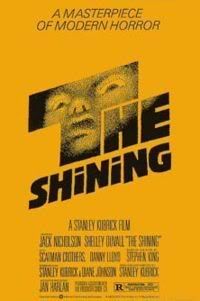
I couldn’t help but look into books from The Bible, chess moves, special mathematical relationships such as 42 is 2 times 21 or 24 is 2 x 12 …, even sequences that might have special meaning to him (a secret Kubrick code). Or it may be that Stanley Kubrick’s given us the latitude and longitude of buried treasure. But all this was wrong. You’ll see that he had an altogether different reason for placing those numbers under our noses. He’s leading us to something outside of the movie. I realized early on that Stanley Kubrick is pointing us to another date, other than the meaningless one we see on the screen at the end of the film. One that contains these special numbers. But is there any other date known to man that could have as much mystery surrounding it as “The Shining” itself?
What is the Indian connection in “The Shining”?
As I mentioned before in the movie we’re told by Mr. Ullman that The Overlook Hotel "is supposed to be located on an Indian burial ground" and Stephen King pointed us toward Indians in the novel (Page 133 - Chapter 21 and Page 196 - Chapter 34) when he wrote, “Can you see the Indians in this picture?” But in the novel Indians are hardly mentioned, and the Indian burial ground quote was added into the movie’s script; it’s not found in the novel. Yet Stanley Kubrick takes Stephen King’s line, “Can you see the Indians in this picture?” and brings it to new heights as he keeps Indians continuously in our site in the film. He even has Wendy refer to the “Keep America Beautiful” Public Service Announcements of the 1970’s (where Iron Eyes Cody sheds a tear over pollution) as she says; “The loser has to keep America clean!” But even though something pointing to Indian culture (the art work in The Overlook) is in almost every shot of this movie. In another obvious double occurrence an actual American Indian is only seen twice on the moving Calumet (a North American Indian peace pipe) cans behind Jack and Dick Hallorann in the storeroom.


All this combined with the date of July 4 at the end of the movie has spawned the “Holocaust of The American Indian” theory found on the Internet. I’ve always had a very tough time buying into this theory as I feel there's nothing hidden under the movie's surface that corroborates it. Like the reference to Iron Eyes Cody I mentioned earlier. It’s a sly joke on Stanley Kubrick’s part because he knows that Cody wasn’t even a real Indian. It’s like he’s whispering in our ears again “what you're looking at is not what it seems to be” as he shoves a cigar store Indian right in front of us. He’s, “a big fake” exactly like the final black-and-white July 4 photo. Cody’s portrayals were so convincing that everyone assumed he was an actual American Indian (I always did). Stanley Kubrick being a Hollywood insider knew the actual truth though. He’s not an American Indian he’s actually Espera DeCorti born in Louisiana to immigrants from Italy. In fact most of the Indians referred to in “The Shining” are fakes. Iron Eyes Cody is not real, the Calumet Indian isn’t real, there were no attacks in the early 19 hundreds, the Indian woman to the left behind Danny after the ball rolls to him is a painting. That leaves the rugs and artwork; do you think they’re they real? It’s still obvious that for some reason we’re being lead by Stanley Kubrick directly to something pertaining to Indians. It can’t be missed. But what seems so obvious on the surface, American Indians, is not what this is all about.
What is the hidden date in the July 4 photo in the end of “The Shining”?
Some people remember hearing about this date, Christmas Eve 2011. It’s a date lost in antiquity now but in the 70’s I learned this was the date the Mayan Indian’s predicted as the end of the world. Even though the meaning, and actual date now seem to be modified – 12/21/2012 Mayan Calendar. For much of the last century 12/24/2011 was the accepted date. I have no proof that Stanley Kubrick knew of this date but I never forgot it when I first heard about it. What I found particularly interesting was that it occurs on Christmas Eve. Christmas Eve on a day when an ancient Indian culture thousands of years ago predicted a great event. Maybe someone else very special will be born the day after that particular Christmas Eve? Or maybe time will just end. When I took “Overlook Hotel July 4th Ball 1921”, remembering how Stanley Kubrick had us notice these numbers so many times in the movie and how important mirror images were, I couldn’t believe what I came up with;
To get the month I took the mirror image of 21, the number of pictures on the wall in the last shots (or as an astute commenter noticed; the 12 crosses in the repeating patterns on the wood underneath the photos). (Another poster noticed the 2 candles above the photos; 2 candles leaving only 1 shadow).
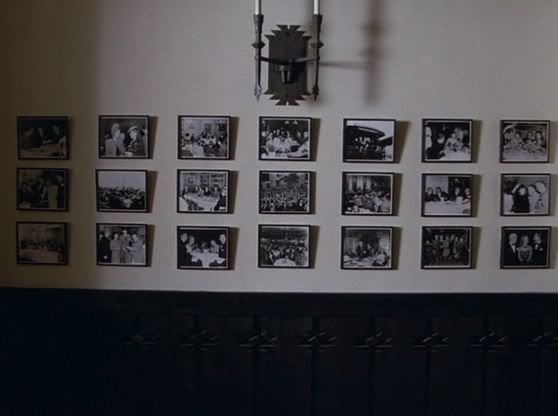
To get the day I added up the numbers contained in the date, 7/4/1921.

To get the year I counted the 20 people shown in the second to last close-up picture of the movie.

... and I added that to the number 11 on Danny’s Apollo sweater (or 2, 1’s (twins) from the last two digits of the year 1921).
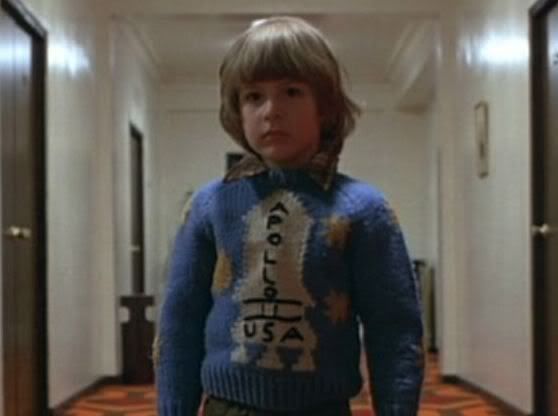
The ancient date of the Mayan Apocalypse, 12/24/2011 (which also adds up to 13) is hidden in the final shot of “The Shining”. His fictitious date 7/4/1921 is the spot where many classic movies would have “The End” printed across the screen, and the numbers Stanley Kubrick wants us to notice throughout the movie are part of a puzzle leading us to the real date that’s an ancient prediction of “The End” of everything, The Mayan Apocalypse. The clues in the film fit like a glove. July 4th ball 1921 is a meaningless date and nothing significant happened on it. The July 4th photo is a lie that everyone wholeheartedly believes, and it only has significance in this movie if you add up the numbers and characters contained in it. It’s also interesting that the year Stanley Kubrick chose, 1921 and 2011 are matching calendar years.
Is it just a strange coincidence that in “The Shining” we’re given many obvious references to special numbers, pointed to Indian culture in almost every shot, and given a meaningless date to ponder at the very end of the story? The special numbers just happen to be included in a known date that just happens to be an Indian prediction of the end of everything we know. It’s unbelievable how he sets us up for this as all the numbers in the date, and the fact that what’s hidden is also a date, have been right in front of us for almost 30 years. As I noted before the twin number 11 is the linchpin for understanding what the other numbers mean and is openly hinted at once in the movie on Danny’s Apollo (11) sweater that he's wearing when attacked. I originally noted its significance by observing Stanley Kubrick’s time codes of the four mirror shots that have the number 11 embedded in them. I had a feeling about this when I started this blog. The main clues leading to the explanation of the numbers in Stanley Kubrick’s “Shining” are imbedded in the mirrors. He edited the movie so the time codes in minutes of all 4 unique mirror shots are :11, :11+:24, :11+:42, and 1:10+:11. Just like “Redrum”, the final photo must be seen in the reflection of his special mirror to be understood. This didn't happened by chance, the movie was purposely edited so it would come out this way. There is no other explanation. The number 11 consists of twin one’s, a double, a Doppelgänger. They weren’t important in Stephen King's novel but twins are posed as an obvious visual clue throughout the movie as each main character has a Doppelgänger; an invisible twin, like Tony.
Twin actresses portray girls who, we are told early on, are supposed to be different ages (8 and 10). “Come play with us, Danny.”
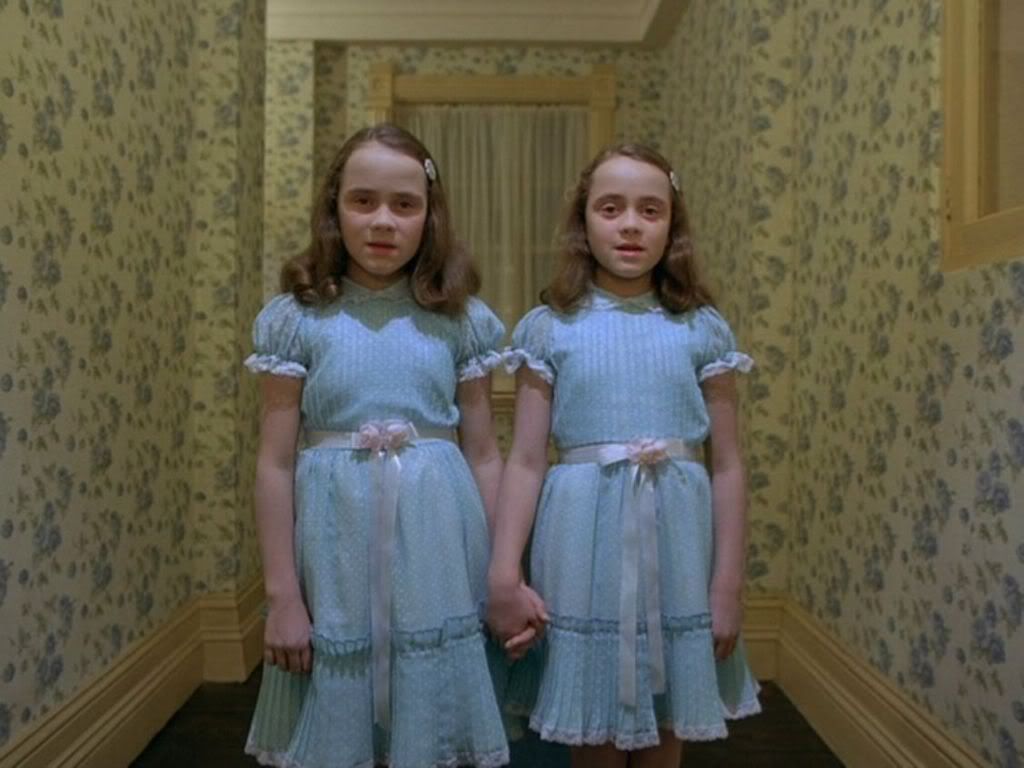
There are Twin Boilers.
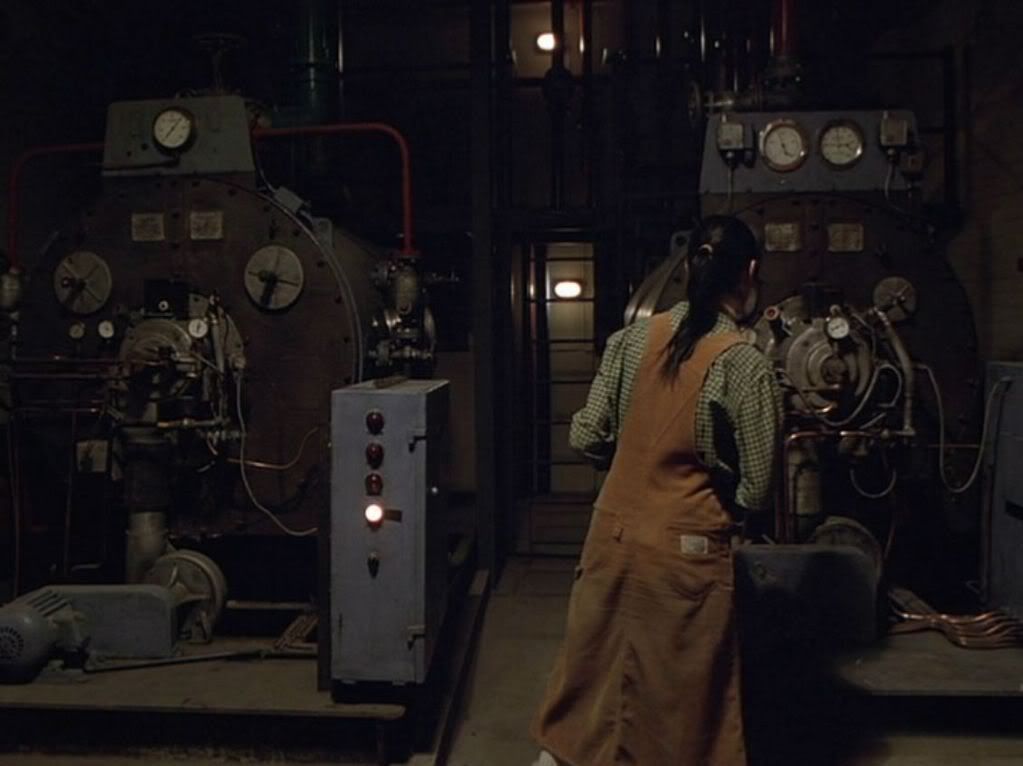
There are twin sides in Jack’s vision of the hedge maze.

And of course the twin elevators.

And don't forget room 237's twin double doors (most of the other rooms have single doors).
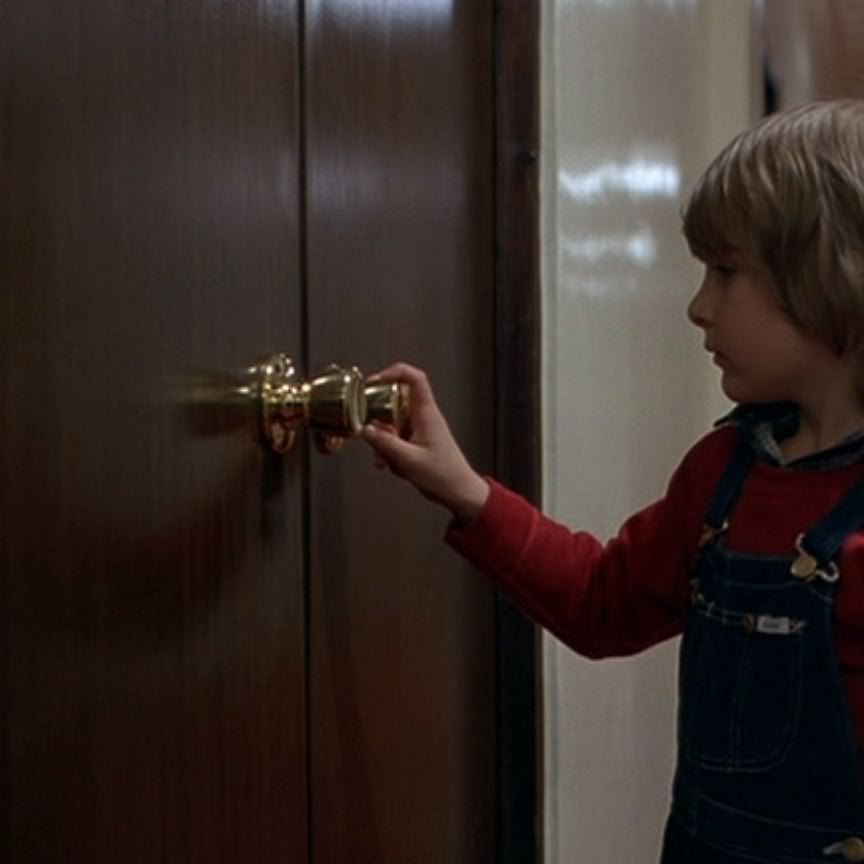
You’ve probably already made up your mind about how wrong I am about the Mayan Indian date being the secret that the last picture holds; right? I can imagine the expression on your face, after all the Mayan's are never mentioned in the movie at all so how could this be correct? But almost everything about this film is an enigma. Do you really expect Stanley Kubrick to come right out and explain all this? It never bothered me but that was my problem with many readers; even though I know I’m right I had no way to prove it. Then April 2008 rolls around and I see something pop up on my TIVO unit. It was an episode of NOVA called “Cracking the Maya Code” and I couldn’t wait to check it out because I just knew I would find something pertaining to what I’d written to add to this blog. About one quarter of the way into the show they talk about the Mayan alphabet, Mayan Hieroglyphs and Mayan numbers and I knew after looking at them that this was it. Finding anything pertaining to a Mayan word, their alphabet or numbers in the movie would help prove a link to the date in the picture at the end. Stanley Kubrick would not be able to resist sprinkling a few well hidden numbers or letters or something else about the Mayans in his movie. All the clues are there if you look closely enough. By now I know “The Shining” like the back of my hand and I was sure that I’d never seen any Mayan symbols in the film. But I did know the one shot where Stanley Kubrick could have hidden the characters so they wouldn’t be easily detected is. After all very little of what I’ve shown in this blog is overtly obvious to casual observation. The shot I’m talking about is Jack’s twin vision of the hedge maze that I just showed you. It’s visually quite busy and if someone were trying to hide something, lots could be there hidden in plain site without being noticed.

I looked at it for about ten seconds and my jaw dropped as I found exactly what I wasn’t looking for. The Mayan Indians never being mentioned by name in this movie doesn’t mean anything because, like everything else I've shown you, they’re iconology has also been cleverly hidden. They were the Indians that Stanley Kubrick has been pointing us to all the time though. Just like the Hedge Animals, fire hose and possessed elevators from the novel that mysteriously don't budge an inch in the movie; he didn’t leave them out. Just look at how subtly and brilliantly he did this. For almost 30 years viewers have looked at this image and not seen what’s hidden there. And Stanley Kubrick did get the idea of hiding Indians in the movie directly from Stephen King's novel.
...............“Can you see the Indians in this picture?”
.......…………….............They are there!
Stephen King asked this seemingly insignificant question in his novel (Page 133 - Chapter 21), but there are no hidden Indians in it to find. Stanley Kubrick reverses the sentence and inserts hidden Indians throughout his film. He makes you “strain and squint” than in the movie, “you could see some of them”. “But you could never see all of them, and that was what made you uneasy. Because it was the ones you couldn't see that would sneak up behind you, a tomahawk in one hand and a scalping knife in the other ... (page 133, Chapter 21)”

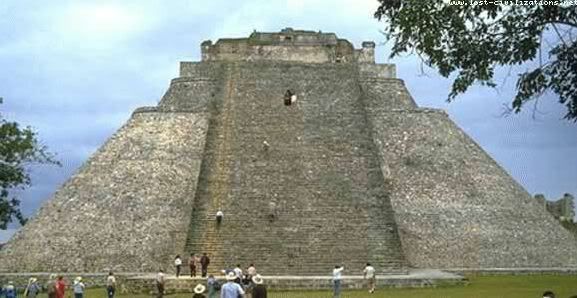

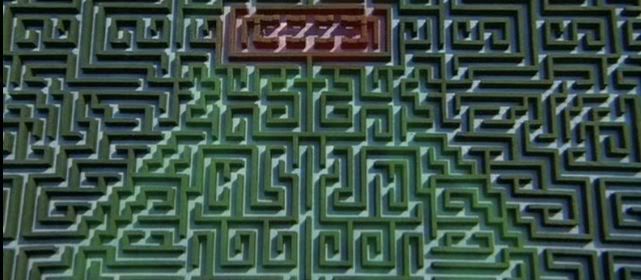
Now, “Can you see the Indians in this picture?” There’s a perfect depiction of an ancient Mayan pyramid (top, sides and stairs) hidden in Jack’s daydream of the hedge maze and it’s proof positive that I’m correct about the Mayan date 12/24/2011. The only thing skeptics can say is, "it's not there". But we all see it. Nothing else in the ancient world looks like this. The top, sides, stairway. It’s all there. It’s an unmistakable iconic image and I made no error in getting the month, the mirror image of the 21 pictures in the last shot. He put them there on the wall to count. I made no error in adding up 7/4/1921 to get the day. He gave that to us to add up. I made no error in counting the 20 people in the second to last close-up picture of the movie. He cropped it that way for a reason. I made no error in seeing the number 11 on Danny’s Apollo sweater. He put it there for a reason. And I made no error in seeing the Mayan pyramid because it’s unmistakable image was hidden for a reason. The many American Indian references throughout the movie are way to obvious and for me they don't hold any mystery at all. The real mystery here is the date July 4, 1921 in the last shot of the movie. The inclusion of what’s hidden here; a depiction of an ancient Mayan pyramid in Jack’s daydream of the hedge maze (in conjunction with the mysterious numbers he has us notice throughout the movie) has no other explanation. It has something to do with Mayan Indians and not American Indians as is the popular belief held by some. There's no way that skeptics can make those pyramids disappear (they’re even twins - one on the top and one on the bottom). No other image in the ancient world looks like a Mayan pyramid and there is no other date in the ancient world like the Mayan Apocalypse. In fact if you had some important reason and we’re looking for a number to hide somewhere in your film, there’s no better one than this one 12/24/2011.
If this still isn't enough maybe seeing the numbers of the date 12/24/2011 Stanley Kubrick hid in the picture will help. They’re all there and quite obvious if you know where to look. The even numbers are horizontal across the middle area and the odd number is vertical.
12 is represented by the three unmistakable 4’s formed by the center shadows (3x4=12).

24 is represented by the two 6’s on the left and right added to the three 4’s (6+6+4+4+4=24). The number 6 on the right side is an inverted mirror image.

The number 20 in the year is represented by adding the four obvious 5’s on the left and right of the two 6’s near the center of the image (4x5=20). Now the numbers on the left side are the inverted mirror image.
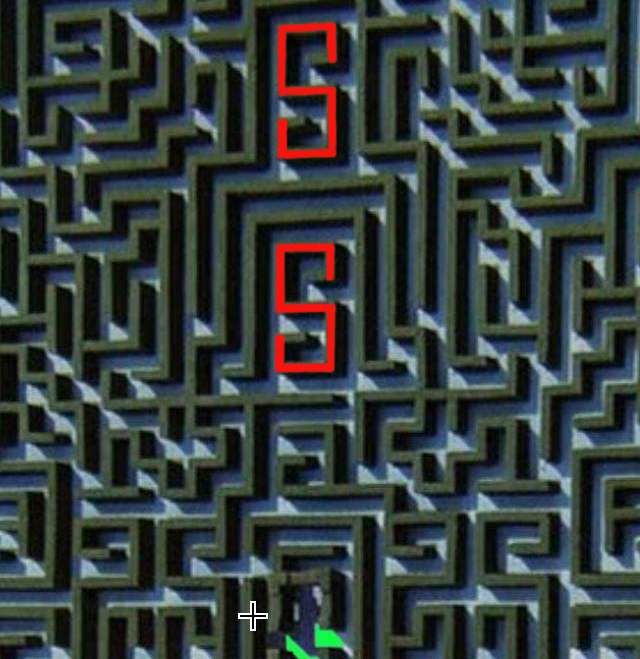
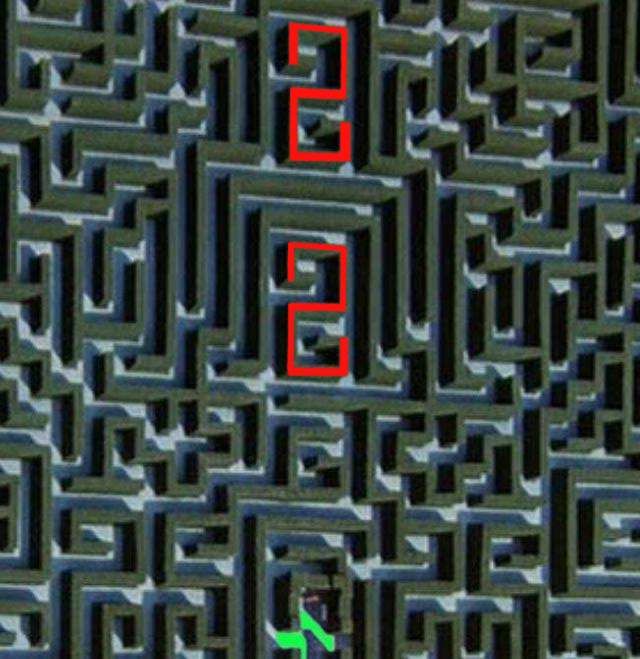
11 is the only odd number in the date. Placing the obvious hidden Roman Numerals (X and I) in the picture together represents the number 11 and completes the year. (Some believe in the X in this picture they’re seeing a skull and crossbones but I find nothing else in the film relating to either poison or Pirates to corroborate this. But in the novel on (page 23, Chapter 4) we do have this vision that Danny sees; “A green witch light glowed into being on the front of the building, flickered, and became a giant, grinning skull over two crossed bones: "Poison," Tony said from the floating darkness. "Poison.")

We‘re actually looking at a beautiful and interesting example of a specific optical illusion. Mirrors are so important in “The Shining” and this image is a nearly perfect depiction of 2 different mirror images at once, a left-right and top to bottom inversion. A double mirror image. It’s not obvious because of the clever shadows he had added to it. The reason I say, ‘nearly perfect depiction of 2 different mirror images’ is because you have to look at it very closely. There are variations he added across the center strip that destroy the continuity of the mirror image.
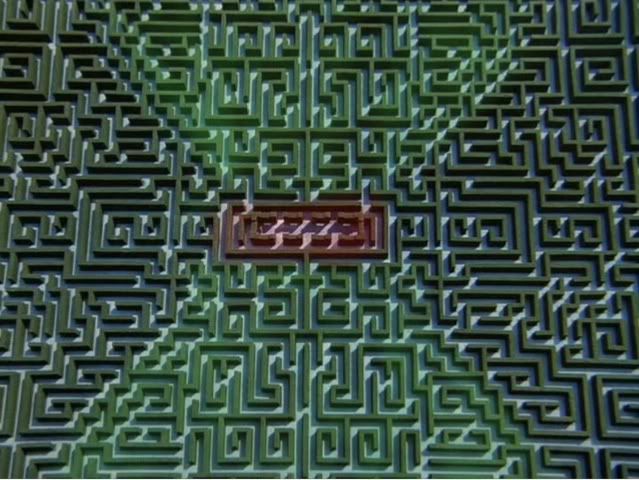
12/24/2011, it’s unbelievable how he was able to hide the Mayan date and pyramid in plain sight for years. All in this one image.

The end of this blog is littered with comments on how wrong I am about the numbers. Just like what I'm going to show you next. There’s so much hidden and so much to see in this film that it boggles the mind. Take a look at how Stanley Kubrick hid the Mayan date in Jack’s novel. I love it; it’s in his clever dispersal of the typing mistakes. Something occurs only 3 times on the first page.
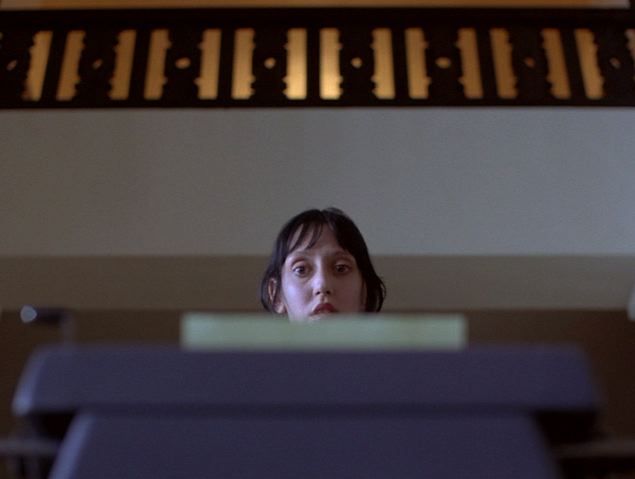
Stanley Kubrick points us to doubles again. Even though many mistakes are shown, there are only 3 sets of double letters that are mistakes (l, m, and a) on the first page of Jack’s novel and there are none on subsequent pages.
l - The first capital letter that’s a mistake is the twelfth number in the alphabet.
ll - 12 and 12 equals twenty four.
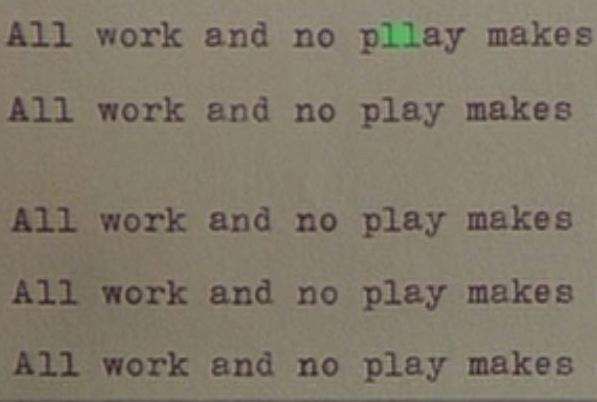
He also adds three l’s next to each other indicating 12 and 24.
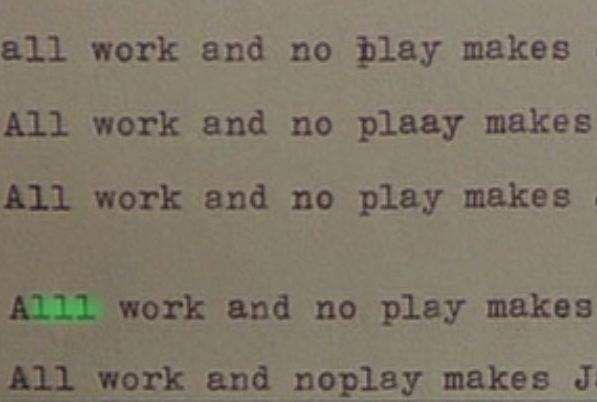
mm - The roman numeral for 2 thousand.
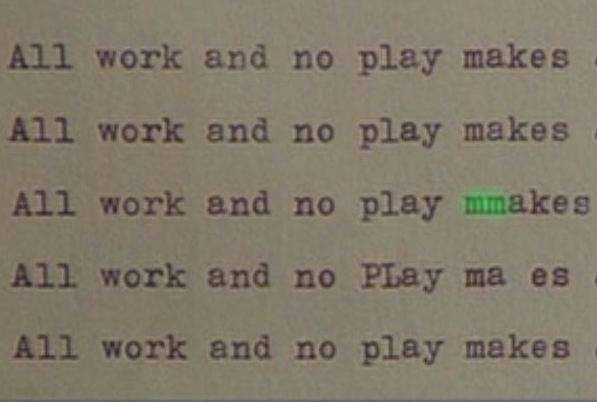
aa - The first letter of the alphabet standing next to itself is 11.

k - Also, the first missing letter on the page is the 11th letter of the alphabet.
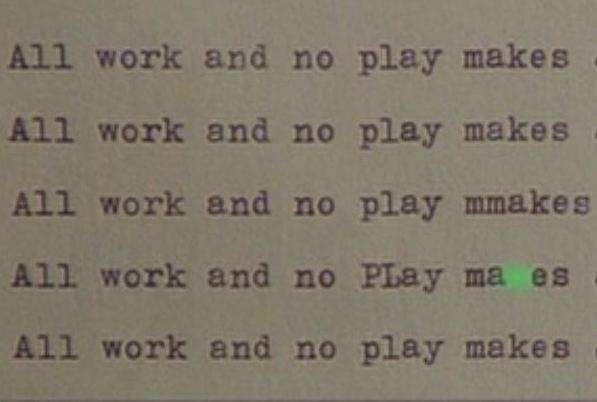
This is all so obvious. All the numbers are there - 12/24/2011.
Artwork and possible logograms pointing to Mayan culture can also be seen here on the office wall at the beginning of the movie. This is not one of the "Navajo or Apache motifs" mentioned by Mr. Ullman during the tour of the hotel.
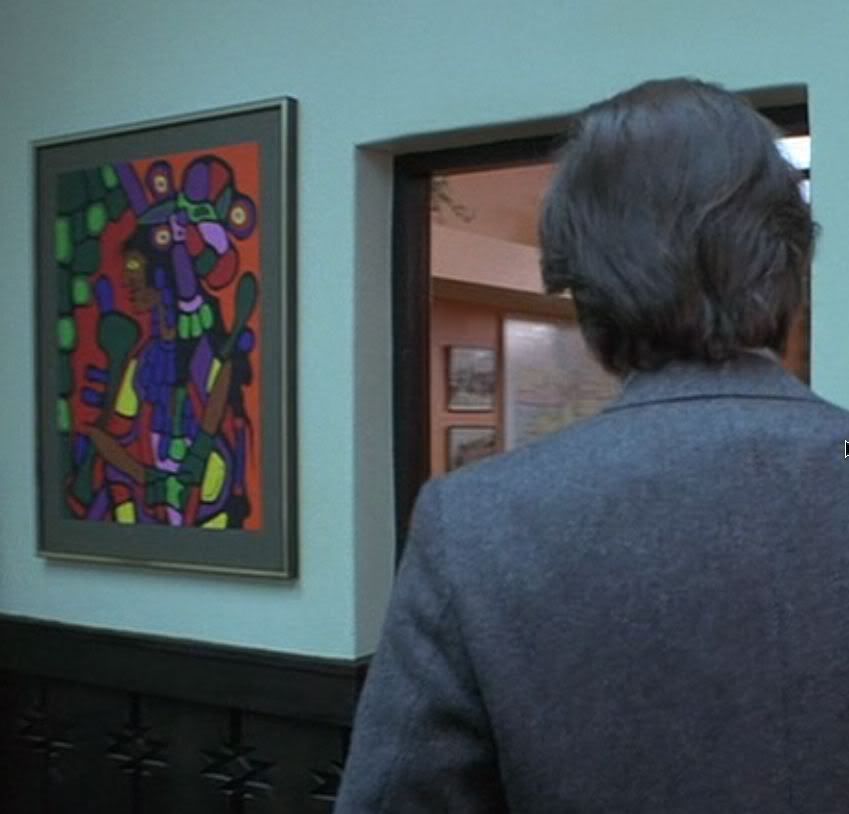
And there’s also the red "Golden Rey" (the Spanish word used for the Mayan Indian's kings as in the ruins of El Rey) box I noted before, pointing to the Mayan’s.

Stanley Kubrick adds interesting images all over this film. There’s a poster that looks like the Ouroboros above and behind the twin’s heads in Danny’s vision of them in the game room.
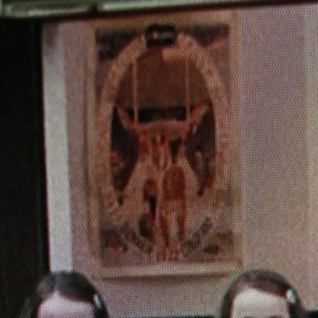
The Mayan’s believed that 12/24/2011 would be the end of a cycle in their calendar. A destruction of everything followed by a rebirth. Much like the Mayan Ouroboros of Kukulkan or the Seven-segmented Aztec Ouroboros. All depicting the constant renewal of their calendar and possibly time itself.
Why has the date of the Mayan apocalypse changed through the years?
I haven’t been able to find the exact reason why the Mayan date has changed through the years from 12/24/2011 to what it is today, 12/21/2012. The closest explanation I could find is that it’s not an actual date but a period of time between two dates. If this is so he may be pointing us the Mayan Indians in the music we hear right from the beginning of the movie. The mysterious date used to be a prediction of the end of the world but now many believe the year 2013 is the beginning of a new age in the Mayan calendar, “The dawning of the Age of Aquarius”. A rebirth. Stanley Kubrick had the movie start after the :11 second Warner Brother's logo ends and if you listen very closely to the music we hear the song begins with a 20 note sequence followed by a 13 note sequence played twice. The theme song is a loose adaptation of this, “Symphonie Fantastique- 5th Movement” by Berlioz, and starts at 3:20 into this video clip (click here). It's numbers and doubling right from the start with an :11-second intro followed by notes that add up to 20-13, all doubled by being played twice. The number 20 is special because Mayan’s use a base 20, not a base 10 mathematical system as we do. Even what’s written in the last picture may be pointing us to the Mayan calendar , a calendar that's based on 13 months. I always thought it was odd that Stanley Kubrick didn’t put the word “The” in front of “Overlook Hotel” in the final picture. If you add the characters in “Overlook Hotel”, “ July 4th Ball”, and the numbers that makeup the year 1921; you get 13-11-13.
What year does Stanley Kubrick’s “Shining” take place?
As I mentioned before Stanley Kubrick spoke about the final photo in the interview with Michel Ciment where he says, “it's actually a photograph taken in 1921 which we found in a picture library". It’s very interesting that he used an authentic photo from the year 1921. That's exactly what you would expect a perfectionist to do, but did you ever wonder how he came up with the year on the date? 1921 might not be meaningless as it pops up in several other spots in the film. The Going-to-the-Sun Road (also closed in the winter), in Montana's Glacier National Park, seen in the opening credits of “The Shining” had its construction started in 1921, and there’s also the song that Jack’s singing at the very end of the film. "California, Here I Come" was written for the 1921 Broadway musical Bombo, starring Al Jolson. There’s also the scene from the 1921 Swedish silent film "The Phantom Carriage" I spoke of earlier that has a similar door axing scene. If you think about it Stanley Kubrick made it impossible to tell exactly when his “Shining” is supposed to have taken place. We really don’t know what year Jack walks through the front door of The Overlook. We know from Mr. Ullman’s dialogue the Torrance’s first full day in The Overlook is Halloween (what a nice added touch). As he tells Jack the hotel is closed between 10/30 and 5/15 and they arrive on closing day, but a year is never mentioned. If you look at a prop Stanley Kubrick shows us for a few seconds, the January 1978 Playgirl Magazine Jack reads as he sits in the lobby on closing day, it’s the only date other than 1921 that Stanley Kubrick shows us in the film.

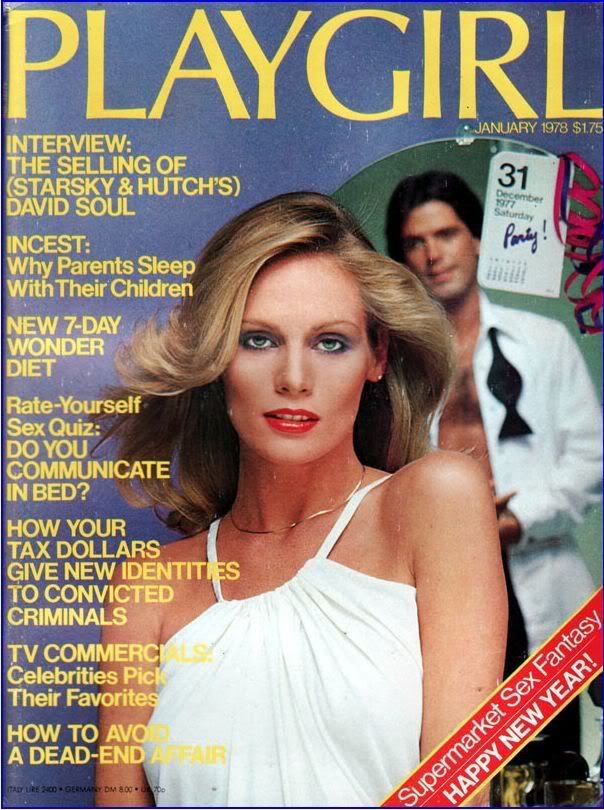
Magazines are available several months before the date printed on them and this one’s significant because it was published the same year as Stephen King’s novel, 1977. This isn’t a strange coincidence. I mentioned before 1921 and 2011 are matching calendar years, so is the year “The Shining” was published; 1977. And what’s important on the cover of this prop that he purposely added to the movie? The Saturday December 31st, 1977 New Years Eve party clip in the right hand corner? It has everything to do with that guy I showed you blowing on the New Years Eve party favor in the middle of the summer at the “Overlook Hotel July 4th Ball 1921”. This also had to be airbrushed in at the same time as Jack Nicholson's face because the party favor is fully extended yet his cheeks are still full of air.


It’s a New Years Eve party; out with the old and in with the new. The party in Jack’s mind is New Years Eve. The actual date of their last day in Stanley Kubrick’s Overlook can be surmised from the movie’s black frames (click here). From the novel, “…here in the Overlook things just went on and on. Here in the Overlook all times were one…” and the same party plays over and over each night: "Unmasking And Dancing At Midnight August 29, 1945 - Dinner at eight! Unmasking at midnight!" “And later, at midnight, Derwent himself crying: "Unmask! Unmask!" The masks coming off and... (The Red Death held sway over all!)” (page 106, chapter 18). If you look closely at the black frames Stanley Kubrick’s party only lasts one night (Jack walks into The Gold Room right after Dick Hallorann calls the rangers and on the next day we see him frozen solid). It’s a mirror image of the novel’s party. The July 4th, 1921 party in the photo on the wall (that seems to go on for ever and ever and ever) is not the same one from the novel. It's not The Overlook Hotel we're looking at and It’s not even a party, it’s a gathering in a lobby as there are no tables, chairs, or band. The July 4th photo is such a paradoxical image. Time may actually mean nothing in Stanley Kubrick’s “Shining”.
There’s nothing spooky about seeing the numbers Stanley Kubrick hid in this movie. The only mystery is what they actually mean. Not how they make us feel. 99% are so well hidden that they could never be spotted in a movie theater or without outside help for that matter. Before I published my blog only a few were even noticed by other authors. They’re too numerous, too obvious, and they were put there on purpose. Clues leading to the explanation of this meaningless, mysterious, and quite enigmatic date he shown to us at the end of the film. July 4, 1921. Stanley Kubrick left a lot of visual tidbits laying around for us to notice while all the time we’ve been watching a movie with an almost incomprehensible numerical substructure hidden in its time codes that’s barely hinted at on the screen. It’s invisible exactly like the Doppelgänger each character has. This second maze in his masterpiece is in what you can’t see; it’s the invisible mathematical one well hidden under the surface. The Hedge Maze and mathematical maze are yet another example of doubling that Stanley Kubrick included in this film and it’s there whether you believe the numbers are purposely placed in the movie or not.
As I mentioned earlier I first saw ”The Shining” during the original theatrical release and one of the things I remembered were 2 numbers on Danny’s sweaters. 42 is actually there but what I thought was an 11 on his Apollo sweater is actually a design made to look like an 11. Had I not made this mistake in perception you would be reading an article about the continuity errors contained in this movie and little more. But just noticing the 11 wouldn’t be enough. This part of the puzzle could never have been figured out without two totally diverse things coming together simultaneously; someone who knows the old date of the Mayan Apocalypse combined with today’s DVD time code technology. Spotting the Mayan Temple without the time codes of the mirror shots may not have helped because the date of the Mayan Apocalypse has now changed from 12/24/2011 to 12/21/2012. Today the old date is almost totally lost. Its meaning is not the same, and the number 11 is no longer present in it. Being aware of the old date makes one person indispensable in this whole story. Without my own unique knowledge, temperament, and tenacity none of this would have ever come to light. Whether you agree with me or not, what Stanley Kubrick did in “The Shining” would’ve been lost “for ever and ever and ever”, just like the original Mayan date. I just happened to count the (21) pictures on the wall than looked at the year in the date (1921) and glanced at the DVD time code (2:21) underneath when I realized what Stanley Kubrick had done. Going back through the movie the symmetrical way it was edited is obvious except to those who choose not to look at it, "or believe it". No one in a theater when the movie was first released would have ever suspected any of this. As for the Mayan date, again I don’t really know why it’s been changed through the years from 12/24/2011 to 12/21/2012. You have to realize that Stanley Kubrick was brought up in the middle of the last century and many things such as genius, were different back then.
I first heard of the Mayan Apocalypse in an episode of the TV show, "In Search of..." In Search of Indian Astronomers (1978) hosted by Leonard Nimoy. If I remember correctly what was interesting about the Mayan calendar was that it had an end date 12/24/2011. It was the only ancient calendar that had this point, as if it were counting backwards to a finish rather than forwards to a future. Exactly like Jack Torrance in the movie after he turns the key to room 237. The reason I remembered the date was because it’s Christmas Eve. What if God was using the Mayan’s to tell us the date of the Second Coming? According to Malcolm E. Weiss in his book “Sky Watchers of Ages Past” (published in 1982 on page 44) “The Mayans believed that time moved in great cycles of 5125 years. At the end of each cycle, the sun and the world were destroyed and reborn. The end of the present cycle, which began in 3113 B.C., will be on December 24, 2011.” According to Michael D. Coe, famed archaeologist and anthropologist from his book, "The Maya", “there is a suggestion... that Armageddon would overtake the degenerate peoples of the world and all creation on the final day of the thirteenth [b'ak'tun]. Thus... our present universe [would] be annihilated on December 24, AD 2011, [later revised to December 23, 2012] when the Great Cycle of the Long Count reaches completion."
I believe Stanley Kubrick may have been interested in this date well before “The Shining” as a few numerical clues pop up in "2001: A Space Odyssey" (1968). As I mentioned before, many Kubrick aficionados who have a lot of time invested in other explanations of “The Shining” have thought throughout the years that Stanley Kubrick was using the movie as a metaphor for the exploitation of the American Indian, but again I don’t believe this. The Mayan Apocalypse is a date that people used to think predicted the end of everything. Now that it’s right around the corner much seems to have changed about it but it’s still the most plausible and interesting explanation of what the numbers and date in the last shot of the movie are pointing to. Remember the real mystery in Stanley Kubrick’s "Shining" is what happened to Jack and the date on screen at the end, not why he placed Indian artwork all over a hotel that’s located in the western US. Exactly where you would expect artwork like this to be found. Tons of opinions and un-provable speculation have been written about this movie but pictures and dialogue don’t lie. I found absolutely nothing that would lead me to believe there’s a metaphor for the Holocaust of The American Indian in this movie and if I did it would be in this blog. Stanley Kubrick is aiming at something much bigger here like the final Apocalypse, the end of everything - the end of time. Seeing the picture of the Mayan pyramid he enigmatically included in this horror movie leads to no other explanation but mine. It’s a secret image that points us directly to what tribe of Indians he’s alluding to in the subtext of this movie. There's an interesting reason why I feel he went to all this trouble, and I discuss it in the Epilogue.
If Stanley Kubrick had the end of the world on his mind did he include a prediction from The Bible?
The number 42 isn’t in the Mayan date but my first assumption that his set of numbers may be pointing us to The Bible may be right as the number 42 is cryptically found there. In the book of Apocalypse or Revelation we’re warned about the end of the world. The number 11 on Danny’s sweater led me right to Revelation Book 11 that predicts 42 months of destruction in the Holy City and of 2 prophets giving witness for 42 months. Book 22, 11+11 and another mirror image of itself is The End of my Bible. He must have looked at Revelation Book 11 and noticed similarities between The Bible and The Mayan date, as he also added twin crosses in that very important picture I showed you before.

There’s also an upside down cross in this shot of the “Redrum”

In the movie Jack's evil imaginary friend Lloyd looks devilish in his red jacket and he is just that.
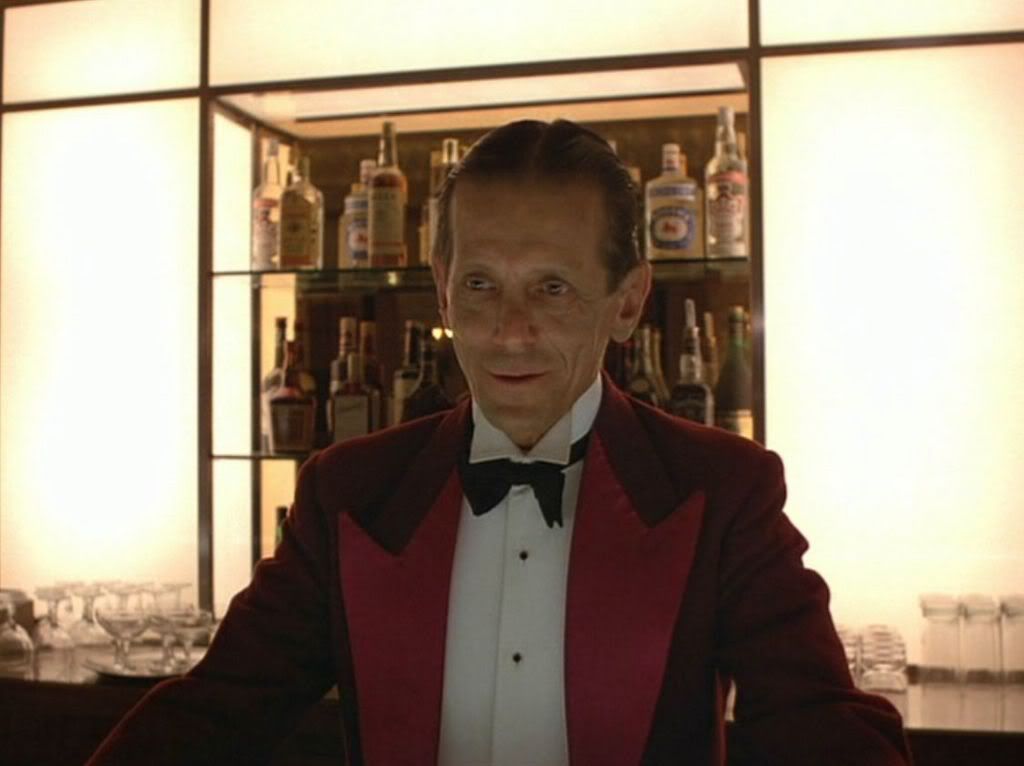
As I mentioned before after he gives him his first drink we hear Jack gulp it down at exactly 66 minutes and 6 seconds after the Warner Brothers logo is finished at :11 seconds into the movie. “God, I'd give anything for a drink. My God dam soul.” This is the spot where Lloyd shows up and it appears that the devil enters him. It's Jack's point of no return. If you’ve gotten this far and you still don't accept that Stanley Kubrick is manipulating the time codes to come out exactly the way he wished, you may have to accept the fact that you’re wrong. Jack has the ability to “Shine”. The drinks Lloyd pours him are actually real, in the movie he can make things appear at will by telekinesis. Stanley Kubrick having this scene happening at that precise point in the movie didn’t happen by chance. The movie was purposefully edited that way.

Dick Hallorann, Wendy and Danny's ultimate Savior, just happens to die in the movie trying to save them, which is another huge departure (and total reversal) Stanley Kubrick makes from Stephen King's novel. It’s so reminiscent of what happens to our Savior in The Bible.
Is the way Stanley Kubrick may have envisioned the world coming to an end also spelled out in the numbers?
So many obvious references to 12, 21, 24, and 42 yet Jack and Wendy’s room number in the center of the 2nd floor of The Overlook ends up being 3? He’s used the movie to cleverly hide a metaphor for the cold war and the possible annihilation of human civilization at its own hand.
……….……...……………………. Armageddon.

The number 3 on their apartment is a reference to a possible World War III. Something that may not be thought of much today, but was in all of our minds in the 1970's. The ideologies responsible are shown to us by the symbolism of their two most important dates. July 4th, in the last shot of the movie, is the obvious celebration of the birth date of America and Democracy but Communism’s prominent holiday of May Day (interestingly the 121st day on our calendar) is brilliantly hidden in the dialogue in what I first thought was a mistake. Early on we’re told by Mr. Ullman that Jack's working until May 15th. But before he's clobbered by Wendy with the bat on the steps he (mistakenly) says, “Has it ever occurred to you that I have agreed to look after The Overlook Hotel until May 1st?” Apartment 3, where Wendy and Jack's final battle between good and evil begins, is a metaphor for Armageddon. Before Danny uses it to write Redrum on the door we see the subtle symbolism in Wendy’s inexplicably uncapped tube of lipstick (she’s not wearing any lipstick) looking exactly like a Russian ballistic missile,

and Danny’s toy tank is prominently placed on top of a purple book on the nightstand.
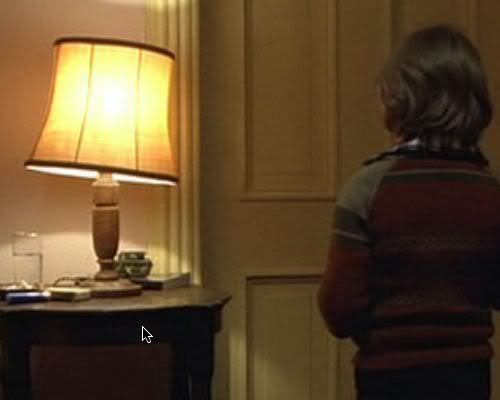
I showed you this before and what’s happening here has multiple meanings. Mr. Ullman’s tie doesn’t just change color right before our eyes. The symbolism of these two nation’s most important colors are in his tie as it unmistakably appears as Communist “Red” one minute, then American “Red White and Blue” the next. The symbolism here of the two opposing nations is unmistakable and obvious.


Does time tick in Stanley Kubrick’s Overlook?
“… Here in the Overlook things just went on and on. Here in the Overlook all times were one…” page 206 (Chapter 37) of the novel. How could he invert that sentence? In his Overlook are all times now none? There’s one other subtle item that just may point to the Mayan date. The apocalypse is the end of time and if you look closely none of The Overlook's clocks actually work. Time is stopped there, and just how do I know this? The easiest of all continuity errors to spot in a film are in scenes that include clocks. They never tell the correct time from shot to shot and sometimes they even move backwards. Take a look at this fascinating shot from the “Maltese Falcon” that Einstein would have laughed at. Look closely as first the clock has no hands, then in the next shot it does.


They did that to make you notice the time on the clock. To visually emphasize the clock Stanley Kubrick does something unique in the scene where Wendy drags Jack into the storeroom. The kitchen clock reads five to seven.

Four minutes later she’s out again yet the clock hasn’t changed.

This isn’t a big deal, it hasn’t moved because it’s a prop and it doesn’t work. What is a big deal is the other clock in the room that isn’t one of The Overlook's. Wendy’s wrist watch is a working prop and can be seen giving erroneous times between shots in other parts of the movie.

I’ll be honest with you, I’ve never seen a wristwatch in a movie set to the same wrong time as a clock on the wall. In this scene though, her wristwatch had to be purposely stopped from running and set at the same wrong time matching the clock on wall. As I showed before,


not only do they move to different positions on the wall but the clocks in The Overlook are stopped purposely and that’s the same thing that happens in The Apocalypse, the end. The party lasts only one night and in the novel, “all times were one” and in the film the same party repeats itself night after night. Stanley Kubrick’s has made time irrelevant and hinted at only in the detached and approximate black frames. I believe the absence of time can be a metaphor for the end of time.
Are the bloody elevators an omen of death?
Now it's Wendy's turn to be surrounded by red before her vision of the elevator near the end of the movie.

The elevator shot was re-done about every week and a half throughout the entire filming of “The Shining”, as it never seemed to come out the way Stanley Kubrick wanted it to. When Danny sees the bloody elevators it’s a premonition of the death of Dick Hallorann and when Wendy sees the same vision it’s a premonition of Jack’s death. But in a broader sense I believe the bloody elevators are a metaphor for the Apocalypse, and the bloodshed at the end of time when humanity would be destroyed and everything (like The Overlook’s elevators) stops. Wendy and Danny are seeing a vision of the future. A premonition of a bloody future for mankind; all mankind - not just American Indians.

.... And the big fade out (from blood red) to black. The end of everything.
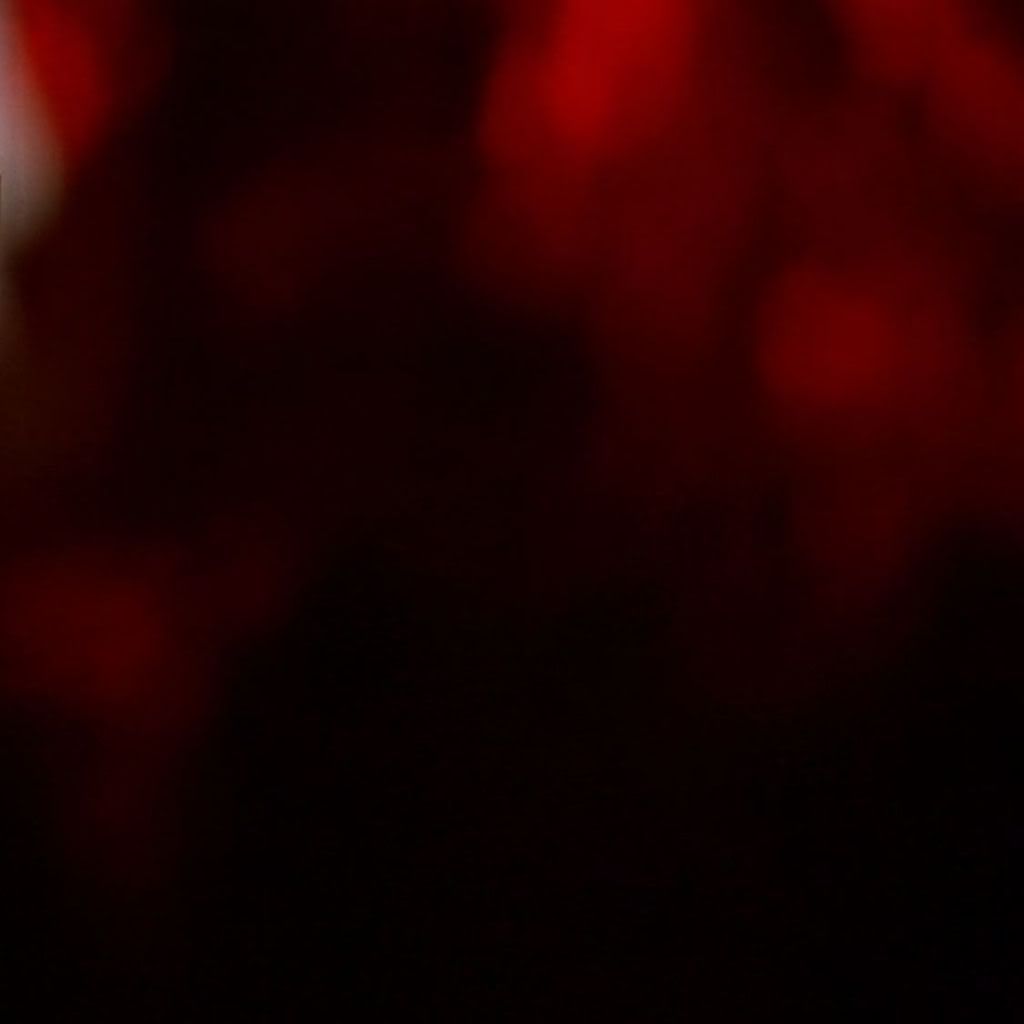
…. And the date that the Mayan’s predicted this will happen, The Apocalypse (12/24/2011), hidden in Stanley Kubrick’s fictitious date.

You still may think I’m wrong. I can imagine seeing the steam blasting out of a lot of reader’s ears. But Stanley Kubrick has many obvious posed shots (like the twins) in “The Shining” and this one is no different. Again I’ve been saying this for a very long time but take a second look at the visual proof Stanley Kubrick placed right in front of us .….

Stanley Kubrick totally reversed the black and white photo of Jesus mentioned on page 191 (Chapter 33) of Stephen King’s novel. Jack is now posed in the final photo as the devil from an old Tarot card.
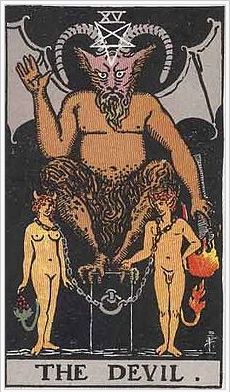
There’s a reason why Stanley Kubrick used the Spanish word for a Mayan king (Rey) on the red “Golden Rey” boxes in the storeroom.

Does Jack represent the Antichrist in the final photo? A king of evil who may just instigate Armageddon. Quite eschatological, “if I may be so bold”, the death, judgment, and final destiny of Jack’s soul, and he even seems to have the same (red) tux on that we see Lloyd wearing earlier in the movie. He's on the wall but I wonder if Jack's picture will also make it into The Overlook's important Hall of Shame scrapbook for a future caretaker like Jack Torrance to open up and see? A caretaker who may just possess the exact same ability to "Shine" and who will also be seeing things, and talking to imaginary "ghosts". Loosing his mind to cabin fever. A caretaker who will have imaginary conversations with Jack Torrance while looking at his reflection in that same bathroom mirror. Who when sent to Mr. Ullman “by the people in Denver” will “agree with them” all over again.

Skeptics can disagree with my assumptions about the metaphors Stanley Kubrick's hidden in “The Shining” but I don’t think anyone will ever disprove, or come up with better explanations than what I have. They don’t add or subtract anything from the story but they are there, we all see them. The two cold war superpowers being alluded to, the symbolism of the toy tank on the nightstand, Wendy’s lipstick canister, the place where their Armageddon takes place being room number 3, a Biblical allusion, and most importantly an ancient prediction of the actual date when all this will happen. Look at the pictures, it’s all there and if you sleep on it for a while you’ll eventually realize the magnitude of what he’s done here. What he’s pointing us to and how well he hid it all.
I still wonder what else he and Stephen King discussed when Stanley Kubrick called him asking questions like, "Do you believe in God?” One person did create all this but I don’t think Stanley Kubrick told a soul what he was hiding in “The Shining”. No one would be able to keep a secret like this! And don’t forget that one last interesting visual enigma I spoke about before. What’s Jack Torrance got in his right hand in the very last shot?
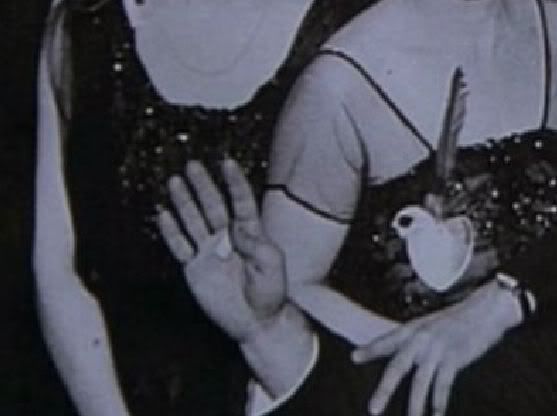
Jack Nicholson probably doesn’t have a clue what’s in his character’s hand in the final image from “The Shining” as only his face was airbrushed onto another body in the photo. Every little thing means something in a Stanley Kubrick film though. His attention to perfection is unbelievable. He didn’t forget to put a Band Aid covering the nasty wounds we see on the devil’s hand in the Tarot card. And everyone presumes that the guy behind him is pulling his arm down. He may be pulling it up, do you know for sure?
All I’ve written about here is in "The Shining" and can be easily spotted now that you know where to look. But the final interpretation is still up to you. As I mentioned before when new things are discovered old theories that don't acknowledge them will not work anymore and any attempted explanation of “The Shining” must include everything we now know or else it’s incomplete. Pictures, dialogue and how the source novel was utilized can’t be changed. What I’ve shown you in this blog can’t be ignored, especially the most important discovery; how he altered Stephen King’s novel. Skeptics will always disagree but I personally feel there’s not a chance any of this happened by coincidence. All I’ve done is point you to what was hidden and if my explanations are accurate they will hold until someone discovers something else. We have to appreciate the tremendous amount of thought and effort that Stanley Kubrick put into this project. Knowing how much I missed when I first watched makes it even more interesting now. It would’ve been great to have been a fly on the wall as he worked the finer points out. I’m sure everything still hasn’t been discovered as every couple of weeks I seem to learn something new. This blog has grown extensively since I first wrote it but my basic premise That Stanley Kubrick has purposely hidden something in this film hasn’t changed at all. The director created an elaborate visual puzzle and made the pieces as hard as possible for us to put together. The only way anyone can attempt to disprove any of this is by ignoring what Stanley Kubrick placed on the screen. But you can’t. It’s all there, forever. Those who have seen it hundreds of times aren’t going to believe they could have missed so much and now that you know where to look I hope you’ll enjoy it even more. So go get your copy and see what you may (or may not) have seen hidden in "The Shining" as it's an amazing example of visual magic of the highest order and a true credit to Stanley Kubrick’s brilliance as a director. Truly the Eighth Wonder of the world of cinema and again, as the song that inspired the title of the novel goes, he will always “Shine On”.
............................... Music
Epilog
“This is not the end. It is not even the beginning of the end. But it is, perhaps, the end of the beginning.” - Winston Churchill
For myself, and I hope for you, this has been an amazing trip inside a movie. I must ask if you’ve gotten this far in Jack’s tone of voice, “How do you like it?” I’m still discovering new things so I’ve decided to add an epilog rather than do any more rewrites as the main text is finished and quite accurate. I’ve spent the right amount of time polishing but I still get a few comments on how I went to far in my analysis. There’s nothing better than a job well done, though, and I’m in no way sorry for all I’ve written. Stanley Kubrick is well worth it, so here I go again as there’s something else to talk about as it appears that the end was actually not the end.
How amazingly well hidden all this was, but could we ever expect to find out the reason why Stanley Kubrick went to all this trouble to have us notice a set of numbers? I mentioned in the last section that they were just about the only thing I came across that wasn’t inspired by something Stephen King had written. I never dreamt that anyone would ever know (and I feel it’s a much better story not knowing) but I’ve come across the reason they’re in the film and even though there aren’t any pictures to show this time it’s just as interesting and just as provable as everything else.
In conceiving this blog I spent very little time thinking about why Stanley Kubrick made “The Shining” the way he did. I could never be sure how much of the mystery I might have missed, plus I really didn’t care. For me the fun was in finding the hidden images. The pictures I’ve included are interesting enough, self-explanatory for the most part, and can’t be ignored or disproved. Was he warning us of an impending apocalypse? Was he creating the ultimate unexplainable puzzle or just having some fun with dates and numbers? Maybe he was worried about the possibility of a WW III? It didn’t enter my mind a lot because you can never be 100% sure you’ve solved a puzzle unless you have all the pieces, and I certainly didn’t know how much of this enigma is still hidden. I say this with the deepest humility, I unwittingly unraveled parts of this 30-year-old mystery but I wasn’t looking for all this. I was searching for continuity errors and I just spotted a few things, kept going, read the novel and got very lucky. I now feel certain that he never wanted or expected much of this puzzle to be figured out by anyone. You may think that I believe Stanley Kubrick’s “Shining” has some sort of connection with the Mayan Apocalypse, but I don’t. The Mayan Apocalypse actually means nothing to this movie. It’s the numbers that are what’s important and they have absolutely nothing to do with the story. The Mayan Apocalypse hidden in the final July 4th photo is just a means to an end. Stanley Kubrick was looking for a number to hide and he picked the most enigmatic number he could possibly find. But why would he be looking for a number to hide in his film anyway? I didn’t know but someone else tipped me off to the reason as they were telling me how crazy I am. The answer is in the next few paragraphs.
Stanley Kubrick could come back from the grave and say, ‘look closely at my images and read my dialogue’ and it wouldn’t matter. There are many who won’t accept the pictures or the explanations he gives in his dialogue if it goes against their pet ‘theory’. If you are too proud to accept the fact that Stanley Kubrick fooled all of us. If finding out that The Overlook Hotel isn't actually haunted keeps you up at night. There’ll be no way to ever change your mind. But it amazes me that anyone would presume to know the motives behind Stanley Kubrick’s work. It’s obvious to me now how intense a director he was and it makes me wonder what else he hid in this or other works? But if you read through my entire blog it’s obvious that I never had any desire to, and didn’t include any psychological interpretations. I find them highly speculative and totally un-provable, but some people love them and are kept warm on lonely late nights thinking up this type of nonsense. I believe some feel that understanding the deep psychological motives behind "The Shining" places them on a similar plane as the great Stanley Kubrick. But I purposely stuck with visual interpretations because I enjoy this. I wanted to put forth the definitive visual analysis of “The Shining”. A movie that may be unexplainable in any other way than visually. I stuck with my belief that everything needed to understand this movie was neatly placed on the screen by Stanley Kubrick. Visually he left nothing out.
This is the way he chooses to play ‘hide and seek’ and “The Shining” is Stanley Kubrick’s test of how much he could get away with as he hid things from the audience. How much would we notice when certain anomalies are teasingly placed right in front of us while the master illusionist redirects our attention in different ways. He created an elaborate Kubrickian maze for us to wander through (and there may be others). A maze where the truth sounds like a lie and lies sound like the truth. The ultimate visual enigma with interesting roadblocks placed in the way of anyone who would ever dare to try to find the way out of it. “The Shining” is a huge exercise in audience control and we’re continuously visually and mentally manipulated into believing we’re seeing one thing when the reverse is actually the truth. Hitchcock to the tenth power, “and you know that Kubrick was crazy about Hitchcock” - Shelley Duvall (1981). “The Shining” is a movie where everything is the opposite of what seems so obvious on the surface, and if you think he didn’t want to fool us; you’re wrong.
The important outside factors that helped me in my writing were the comments of people who noticed things I didn’t, and the people who criticized me. Without the people who criticized me this blog would be quite a bit different. Both come into play here, and this little bit of Kubrick that I mentioned before ends up being pivotal in my explanation of why he went to all this trouble to have us notice a set of numbers. It was pure speculation at first but now I’m sure I nailed it. Click here and take a second look at what I wrote about Stephen King. This still amazes me. What a tremendous ego Stanley Kubrick must have had. This is like, “So you think you’re a genius, pal? Well I am the genius, just look at what I did to your novel; I crushed you and what you wrote, and made your story better. You’ll take it and like it”. He visually “Shined” a barb right into Stephen King's mind. Directly from the mind of one genius into the mind of another; Wow! He put the unmistakable message right in the movie. And I think "All work and no play makes Jack a dull boy" was another poke at him, and father Freud too. That line wasn’t in the novel. It was entirely thought up for the movie. This is the kind of guy Stanley Kubrick was. Just like in a game of chess he’ll crush whomever he wishes as easily as he crushed that red VW and just ask Stephen King what it feels like. It must have been a swift kick in the head to have seen that red VW for the first time in a movie theater. Right out of left field.
The crushed red VW is in the middle of the movie, I wonder how long it took Stephen King to realize what he was looking at; I bet the yellow VW one second after the Warner Brothers logo finished at the beginning of the movie did it? Stanley Kubrick reversed or altered every thing he possibly could from the novel and most was never noticed. It’s obvious that he thought more about misdirecting our attention, and hiding how he turned Stephen King’s novel inside out, than getting an Oscar for his incredible screenplay. It's probably why Stanley Kubrick rejected the script written by Stephen King. He knew exactly what he was planning on doing right from the start. This may be the most brilliant adaptation of a novel in history. Reverse or altering everything except the names (even the names were toyed with; Jack Nicholson - Jack Torrance, and Danny Lloyd - Danny Torrance, Jack Daniel’s whisky, and 2 names for Grady instead of one). And all done in secret with many obvious signposts in view right from the start, yet still most never realized. To start with we have the most obvious reversal. In the novel The Overlook wants Danny’s power and uses Jack to get it. In the film The Overlook if anything wants Danny dead. But there is so much more;
The Overlook survives in the film / is destroyed in the novel, Dick Hallorann survives in the novel / dies in the film. Jack is frozen to death at the end of the film / burns to death in the novel. We don’t see Tony in the movie / do see him in the novel, and we see the Grady girls in in the film / not in the novel. In the film they’re brought to the overlook in a yellow vehicle and have a red vehicle in the garage / in the novel they’re brought to the overlook in a red vehicle and have a yellow one in the garage. Jack plays with his yellow ball / Danny plays with his red ball. In the film the hedges are in the rear / in the novel they’re in the front. In the film the hedges remain motionless / in the novel they move by themselves. In the film Wendy says, “How did you know we called him Doc?” / In the novel, it’s Jack that says, “"How did you know we called him Doc?" Wendy is a weak dumb brunette / a strong smart blond, Wendy bolts the storeroom door / Danny bolts the storeroom door, Wendy sees “Redrum” in the bedroom mirror / Danny sees “Redrum” in the bathroom mirror, Pediatrician female / Pediatrician male. “Redrum” is seen outside the bathroom in the film / inside the bathroom in the novel. In the film, “Do you like lamb, Doc?”, “No” / in the novel, "You like lamb, doc?", "I love it". In the film Jack talks about cannibalism / in the novel Wendy thinks about cannibalism. Jack sees 2 woman in the movie’s bathroom / Jack never sees any woman in the novel’s bathroom. Wendy reads Jack’s novel in the film / Wendy never looks at Jack’s play in the novel, Jack never touches Wendy in the movie’s final chase / Jack injures her severely in the novel’s final chase, 2 elevators remain motionless / 1 elevator moves by itself. In the film “Redrum” makes sense when seen in a reflection / in the novel it only makes sense when seen in the reflection of a reflection. In the film Jack talks to Lloyd and Grady facing a mirror / in the novel no mirrors are present. Danny has his seizure outside The Overlook in the film / inside The Overlook in the novel. In the movie we never see Jack look into the scrapbook / in the novel Jack constantly looks into the scrapbook. Tony is inside Danny’s body in the movie / outside of Danny in the novel. Dick Hallorann “Shines” and asks Danny if he wants something cold, “How'd you like some ice cream, Doc?” / Dick Hallorann “Shines” and asks Danny if he wants to go somewhere warm, “Sure you don't want to go to Florida, doc?” The young woman pulls the shower curtain back in the film / only Danny and Jack pull the shower curtain back in the novel. Jack wears the Stovington Prep t-shirt in the film and Stovington is seen in reverse / Danny wears the Stovington Prep sweatshirt in the novel and it’s not seen in reverse. We can’t see their breath in scenes taking place in sub zero temperatures / in the novel Stephen King describes the “white plume” and it can be seen. Danny brings up room 237 in The Overlook’s kitchen / in the novel Dick Hallorann brings up room 217 outside The Overlook in his car. Jack has no problem with authority in the film / hates authority in the novel. Wendy tells the pediatrician about the time that Jack hurt Danny in the film / Jack tells the pediatrician about the time that he hurt Danny in the novel. In the film Dick Hallorann never tells Danny to call him if there’s trouble / In the novel Dick Hallorann tells Danny, "If there is trouble ... you give a call.” In the film Danny tells Wendy about the old woman in room 237 / In the novel Danny tells Jack about the old woman in room 217. In the film Danny finds the door of room 237 unlocked with the room key in it / In the novel Danny unlocks the door to room 217 himself with a passkey. Tony stays the same throughout the whole film / Tony evolves in the novel and physically gets closer and closer to Danny as the story progresses. In the film Danny’s told not to go into room 237 but doesn’t ever promise he won’t, and he actually never does go in / in the novel he’s told not to go into room 217, promises he won’t than takes the passkey and goes in anyway. In the film Danny disappears for a while and becomes possessed by Tony / in the novel Tony disappears for a while and can’t help Danny. In the movie Jack has a dream before he and Wendy see Danny, after he’s beat up, at the bottom of the stairs / in the novel Wendy is having a dream before she sees Danny standing, after he’s beat up, at the top of the stairs. In the movie Jack says this to Wendy alone, I'm gonna bash your brains in!" / in the novel Jack says this to Danny. In the movie The Overlook never makes a sound / in the novel Jack, "stood in the darkness for a moment, thinking, wanting a drink. Suddenly the hotel seemed full of a thousand stealthy sounds: creakings and groans... " Mr. Ullman wants to hire Jack in the film / In the novel Mr. Ullman doesn’t want to hire Jack. In the film Tony shows Wendy the word “Redrum” / in the novel Tony shows Danny the word “Redrum”. And don’t forget the most important alteration of the dialogue that proves the ghosts are all in Jack’s mind - Stanley Kubrick has him say 2 of the ghost’s lines from the novel; “Come out, come out, wherever you are!”, and “I wish we could stay here forever... and ever... and ever.”
This is all unbelievable, but the most amazing thing I found was that the scenes in the movie all happen in a different place from the novel. The end chase; hedge maze outside / hallway inside, Jack attacks Wendy, apartment / outside the apartment in the hallway, Dick Hallorann is called back as he sits in his bedroom / as he drives in his car, Room 237 / Room 217, yellow VW / red VW. Jack works in the Colorado lounge / in the basement, Jack meets Grady in the Gold Room / Colorado Lounge, Dick Hallorann talks to Danny in the kitchen / in his car. It goes on and on, and I just scanned through the novel, there’s probably much more. Don’t make a mistake and think the crushed red VW Stanley Kubrick slyly inserted into the movie doesn’t mean anything!
Why would he feel the need to do something like this? Again I had no desire to seek out Stanley Kubrick’s motivations but then someone dropped something in my lap, and I just couldn’t resist. The number puzzle I showed you may end up being just a sideshow or maybe what I’m writing now is the sideshow, I just don’t know. I’ve recently read an article and it’s clear to me now that Stanley Kubrick put something else into this movie; an unbelievably brilliant con that’s on a much different level than the purely visual I’ve dealt with. Something that was intended to fool a certain someone, to psychologically pull the rug out from under their feet. He’s pulled off the nastiest hidden deception in movie history and, probably during his lifetime, to his utter delight, the people (or person) who it was actually intended for never noticed and definitely didn’t figure it out. We definitely would have herd about it if they did. The crushed red VW along with his treatment of Stephen King’s novel were the clues that led me to realize exactly what he’s done here. He probably wanted to show Stephen King just who the boss is. But I still believe that the story Stephen King wrote is where much of the real genius is here. Filmmakers would be nowhere without a solid story to tell and Stanley Kubrick definitely had this.
“I'm very confused, and I just need time to think things over!” You might be saying in Wendy’s meek voice!
A self-professed expert on Stanley Kubrick, with a psychological agenda to prove, showed me something he wrote as his proof that I’m wrong about the numbers. The Mayan Temple and the numbers of the Mayan date, which were all neatly and obviously embedded in the same picture that I showed you in the last section, are all wrong. It seems there’s a psychological explanation for all of this mystery that I somehow missed in my frenzy. Words cannot convey the feeling of discovery that I felt when I realized what the enigmatic date meant and I never had one ounce of doubt about July 4th, 1921 being a hidden code for 12/24/2011. I just never thought I would ever be able to prove it to anyone. Then I found the Mayan Temple in a film where it shouldn’t be, and people with other agendas can wish that it wasn’t there or try and ignore it but there’s no way to change that important image. It’s there and it’s impossible to disprove its connection to the movie without explaining what that Mayan Pyramid is doing in “The Shining”. It just doesn’t belong there without an explanation and saying “it’s not there” is not enough. I’ve put forth a lot of controversial ideas about this movie but pictures, dialogue, and the alteration of the source novel, don’t lie and can’t be changed. Even the most hardened skeptic has to admit it’s a little strange that I’m led to believe that the date July 4th, 1921 is a code for the Mayan Apocalypse than we mysteriously find a Mayan temple hidden in the movie. Then I found the actual numbers; three 4's equal 12, two 6's and three 4‘s equal 24, four 5's equal 20, and the Roman numerals X & I equals 11. All neatly placed in Jack’s 3-D daydream. Then I found the numbers in the obvious mistakes on the first page of Jack's novel. It’s all hidden in the double letters that only appear on the first page. l - the twelfth number in the alphabet, ll - 12 and 12 equals twenty four. MM - the roman numeral for 2 thousand, and aa - the first letter in the alphabet standing next to itself is 11. I guess this is all just a cruel coincidence; yea, sure it is.
Commenters often try to prove me wrong. But sometimes they unwittingly end up pointing me in the right direction, and this fellow is no exception. He pointed me right to the source where Stanley Kubrick got the idea to create this elaborate puzzle of obvious noticeable numbers, and more importantly what his motivation was. And it wasn't something he took from Stephen King's novel.
After the release of this film Stanley Kubrick, knowing that the name Freud would attract the attention of a certain type of individual like moths to a flame, made it known that he and Diane Johnson read Freud’s “The Uncanny” before writing the script. He cleverly introduced Freud into this enigmatic saga during the interview I quoted from earlier as he mentions his "essay on the uncanny, Das Unheimliche" to Michel Ciment who is eagerly trying to get any explanation he can for "The Shining" from the elusive genius. But unfortunately Kubrick “don’t surf” and he only lets you know what he wants you to know, just like he only lets you see what he wants you to see. Now before I read Freud's essay I wondered if he could have been looking for some inside information on how to scare the s@%t out of people? But I didn’t really think so; he needs no help whatsoever. Personally, I found reading Freud similar to having your wisdom teeth pulled without Novocain. It’s a tough read because of the translation but just because Freud said something doesn’t make it so. Stanley Kubrick knew this and toyed around with it. At one time he possibly needed Hitchcock, maybe, but he needed help from Freud like he needed a third nipple.
How did Stanley Kubrick use Doctor Sigmund Freud to set a trap for anyone trying to understand his “Shining”?
In “The Uncanny” Freud says, “unless a man is utterly hardened and resistant against the lure of superstition, he will be tempted to ascribe a secret meaning to this obstinate recurrence of a number”. According to Freud seeing recurring numbers in life (like the number 42 Stanley Kubrick has us notice in “The Shining” on Danny’s sweater and the movie clip from “Summer of 42”) will lead us to superstitious interpretations. Knowing this Kubrick created a work with hundreds of instances of the same sets of hidden numbers showing up in different ways throughout the film. It’s so spooky, and over-the-top; and he definitely did it. But there’s a glaring problem with Freud’s statement as it pertains to this movie. The set of numbers Stanley Kubrick hid in “The Shining” actually did, without a doubt, lead to something with a real meaning. There’s no other number I can think of that has more mystery surrounding it than an ancient date predicting the end of the world, and there aren’t that many other dates predicting the end of the world to choose from. A date from a calendar that may count backwards to the end of time, instead of forwards into the future. The frightening thought that the end may actually come to pass on this date isn’t what’s important here; it’s a mysterious fascinating number, and Stanley Kubrick obviously thought so also and hid it in his movie. I feel as the date swiftly approaches we’ll probably be hearing a lot more about it.
So why invoke the name Freud? It’s obvious he thought as much of Freud as he did of Stephen King. You can’t deny he dissed him by reversing his pearls of psychological wisdom exactly the same way he reversed so much from the novel. He was mocking Freud and his article the same way he mocked Stephen King with the crushed red Volkswagen. He inverted what Freud said by ascribing “a secret meaning to” the set of numbers he points us to throughout the movie. They do have a meaning. This can’t be ignored or denied and this is where the Mayan Apocalypse comes in. Stanley Kubrick needed a special number that was something spectacular because the set of numbers he planned on hiding in “The Shining” had to lead to something spectacular. What else could he use pi, the age of the universe, his birthday, the boiling point of water, the carbon tipping point? What number would you use? The number he needed had to be unique, and if there were no Mayan Apocalypse to use he would have had to invent one. As if to thumb his nose right at Freud Stanley Kubrick even embedded the numerical clues along with the Mayan Pyramid in Jack’s daydream of the Hedge Maze as I showed you in the last section. Stanley Kubrick is some piece of work. How apropos; wasn’t it Freud who was big on dream interpretation? To him they were “wish fulfillments” and he would have thrown a Freudian sized tantrum trying to analyze Jack’s daydream in the film. Stanley Kubrick placed all the clues right there in that one single picture. Freud who? He mocked him and his “theory”, and it’s clear he showed the genius of Freud the same respect he showed the genius of Stephen King; and that's absolutely none at all. It appears there’s only room for one genius in Stanley Kubrick’s world and that’s Him. Hmmm….. Veddy interesting! He brilliantly reversed everything of importance that he read in preparation for making this masterpiece. As I mentioned earlier he even shows us a mirror image of, “Hansel and Gretel”. It’s obvious right from the start what he's done to the novel as he reversed the color of Jack’s VW that brought them to The Overlook from red to yellow and then reversed the color of the snowmobile from yellow to red. He used Stephen King for the basic story, a few characters, and The Overlook (the most famous haunted hotel in history that wasn't haunted at all in the film), and he used Freud for a very clever and much loftier deception. He was baiting some of his film clique, and he used Dr. Sigmund’s star power to dupe them.
In preparation for this article I read many websites dealing with “The Shining” and some of the attempts at psychological explanations of this movie are interesting while others are downright laughable. So much un-provable and speculative psychological nonsense is written about Stanley Kubrick’s body of work that it’s obvious he attracts a certain type of fan. But if Freud’s involved, well that’s different, this is just wonderful; It can’t be denied, his name gives a certain air of credibility to any explanation some screwball would come up with. This was the masterful roadblock that Stanley Kubrick knew would trip up any person searching deeply into this movie’s meaning. A certain type of investigator, who he must have known very well, would see all the numbers, and the doubling, and the mirrors, and the twins, and than just; STOP. They would never make sense out of “The Shining” because the name Sigmund Freud would stop them dead in their tracks. Why look for any further hidden meanings, “If I may be so bold, sir”, after all these numbers couldn’t possibly have “a secret meaning” because Freud said so; and the brilliant Kubrick still needed to read Freud before writing his script! He used ideas from “The Uncanny” to make sure anyone in the media trying to explain “The Shining” would, in the end, be wrong. And we know Stanley Kubrick is almost no help at all if you’re trying to unraveled any of the deeper meanings in this or any of his other films. He simply didn’t want to talk about them or explain them. What a brilliant trap; numbers, they couldn’t mean anything more. Twins and doubling, the same they’re all there just to scare you and they don’t mean a thing. Everyone comments about the number 42 on Danny’s sweatshirt but Stanley Kubrick made the most important hidden twin in the movie a number, the number 11 on Danny’s Apollo sweater, and no one ever noticed. A double, a mirror image of itself, and the most deeply hidden of the numbers as it's never openly seen in the movie. Poor, poor me! I was not encumbered by all this Freudian mumbo-jumbo. I literally ignored it, and it would now seem that even the most brilliant plan can have a fatal unexpected flaw.
Stanley Kubrick borrowed this idea from Freud for the last shot of the movie. In “The Uncanny” Freud talks about the ending of a novel by “the unrivaled master of the uncanny in literature”, Hoffmann. “Towards the end of the book the reader is told the facts, hitherto concealed from him, from which the action springs; with the result, not that he is at last enlightened, but that he falls into a state of complete bewilderment. The author has piled up too much material of the same kind. In consequence one’s grasp of the story as a whole suffers, though not the impression it makes”. It can’t be denied the audience is definitely in “a state of complete bewilderment” at the end of “The Shining”. Stanley Kubrick leaves us with the distinct impression that Jack has been in The Overlook before and this is quite bewildering. We are “told the facts, hitherto concealed from” us but everything is the opposite of what it seems; he’s reversed Freud again as the picture we see that everyone uses is proof that Jack Torrance has returned to The Overlook is inexplicably not there for the entire movie. It appeared on the wall out of nowhere for just this one shot after Jack dies. The bewildering “impression it makes” is, I believe, the exact opposite of what’s true as the reason it isn’t on the wall earlier in the movie is not because Jack has been there before, but because Jack is still alive and what the picture depicts (Jack frozen a second time on the wall, “for ever, and ever, and ever”) obviously hadn’t happened yet. This can’t be denied and it isn’t a mistake! It’s exactly what the director wanted. Remember this from the Michel Ciment. interview; “… to temporarily mislead the audience”?.
Here’s another example. Freud’s excerpt from Schelling’s definition of the uncanny “as something which ought to have remained hidden but has come to light” is laughable in this context. Again it’s that picture of Jack in the last shot in a nutshell. But what “has come to light” because of this picture is our impression that Jack was the reincarnation of someone special. But this is a reversal by Stanley Kubrick because Jack was never in The Overlook before and he isn’t someone special. Do you honestly believe one of the greatest perfectionists in history would have reversed and inverted so much from Stephen King’s novel and Freud’s work only to find himself at the end of his movie, the final July 4th Ball photo, and than just stop doing it? Never in a million years. What he did is take that enigmatic picture, “something which ought to have remained hidden”, and by making what it says on the bottom “come to light” in that final shot, fooled us into believing the opposite of what’s true. A true and brilliant reversal and so remarkably well hidden that no one ever noticed. Again, if you have impenetrably preconceived ideas the reversals he made to the novel are shocking and very hard to accept. The lies that were told by the so called “ghost” Grady are just as shocking, but Jack was never in The Overlook before and hasn't been reincarnated.
So, according to Frrrreud our “animal mind” is supposed to have a deep psychological reaction to seeing the uncanny images in this movie like doubling, twins, recurring numbers etc. I know I just ‘crapped my pants’ seeing all the doubling and twins and mysterious numbers in this masterpiece.

Come on, this is obvious nonsense. 99.9% of what I’ve showed you, like the time codes and shot durations, are not noticeable without someone thoroughly going through the movie first, than pointing them out to you. This is what I’ve done. The “Summer of 42” and the numbers 42 and what looks like an 11 on Danny’s sweaters were the only numbers I ever noticed when I first watched “The Shining” in its first theatrical release, and they didn’t entice me to search for anything else. How he altered colors in the movie is what did that for me. I’m either a little too screwed up, or maybe not enough, but I didn’t notice and wasn’t scared by any of this at all. I know it didn’t produce Freud’s intended effect in me. Maybe I need a shrink, but the essence of what Freud wrote has been undeniably reversed in the film and it doesn’t really work in the real world all the time either.
What movie aficionado/aspiring writer like that guy who explained “The Uncanny” to me wants to be told that Stanley Kubrick, his idol, deliberately duped him. So sad, and brutal too. Normally I would feel deep compassion but I have no sympathy for suckers that fall for this Freudian stuff hook line and sinker without thoroughly thinking it through. And they didn’t, they stopped half way because they didn’t bother to look at the whole picture and try to understand how Stanley Kubrick altered Stephen King’s novel. This was the key yet so many putative “experts” have never read it. It's all there and so unbelievably obvious. Just look at the VW that brings them to the hotel and snow cat that they’re saved in, “what’s red is yellow and what’s yellow is red”. Stanley Kubrick pointed us right to the answer from the very first shot of the film, and if you read the novel you’ll know for sure.
I’ve found out if you discover something, and write about it watch out. I now know how it feels to be surrounded by noisy know-nothings. I’ve been hardened by the experience and I’m changed. But someone must have really gotten under Stanley Kubrick’s skin for him to have put all the thought and energy into weaving this crafty artifice. He must’ve loved to crush his chess opponents. Maybe he also pulled the wings off of flies as a child because looking at what he did here, it has its similarities. It’s like he was having fun with the annoying chess nerds, film critics and assorted Hollywood losers that he must have certainly and continuously come across in life. He totally manipulated this crowd. The endless barrage of persistent genius wannabes and Pseudo-intellectuals who think they’re on his level, constantly orbiting around him, and endlessly trying to figure out the deeper psychological meanings of his entire body of work. They inhabit a weird Kubrickland. Hoping maybe by basking in this light, figuring everything out and becoming “true fans” some of his genius will rub off on them. They and their cronies are a part of team Kubrick, talking, discussing, pondering and finally fabricating things for their own amusement that they wish were there, but just aren’t. All the time wallowing in the smug self-confidence of knowing they’ve explained all the mysteries that swiftly pass over the heads of us common folk who just don’t have the capacity to understand. And after all, who can argue with Freud?
It’s annoying to have simpletons criticize your work. They’re quick to comment yet don’t actually bother to look into what you’re talking about before piping up. And it’s always the “experts” that are the loudest. I especially can’t stand “skimmers” who quickly skip around than ask dopey questions that were actually answered if they had read the whole text. It must have been a thousand times worse for Stanley Kubrick, especially after working on projects for five years or more. He must have hated to be criticized or asked to explain his movies by the same lummoxes over and over again. The Stanley Kubrickians remind me of the Ellen Jamesians in the “World According to Garp”. Thick as bricks. Whether he loved the attention, or hated it he may have looked down on or even despised this crowd of underlings.
Do you think the critics bothered him? Here’s an excellent example of why they get such a bad rap. Two people posted this review of “The Shining” from Vanity Fair magazine after it was first released. “The truly amazing question is why a director of Kubrick's stature would spend his time and effort on a novel that he changes so much it's barely recognizable, taking away whatever originality it possessed, while emphasizing its banality. The answer is presumably that Kubrick was looking for a commercial property he could impose his vision on and Warners, not having learned its lesson with Barry Lyndon, was silly enough to let him do it.” This is the kind of crap Stanley Kubrick had to deal with. Yet 30 years later we’re still discussing this movie because it’s one of the greatest horror films of all time. And it, like its director and Jack’s picture on the wall will live on “for ever and ever and ever”. What he did to the novel was brilliant. I wonder if this critic ever amounted to anything? And who does he think he is anyway, insulting the way a moviemaker chose to alter his source novel? Especially when, he's obviously clueless about exactly how well hidden and brilliantly Stanley Kubrick did this alteration*. Stephen King’s novel has gone down in history as one of the greatest American horror stories ever but with all due respect, if it wasn’t for Stanley Kubrick’s “Shining” I believe only serious readers would know of Stephen King’s story or The Overlook Hotel. If you don’t agree I’d challenge you to sit down with a couple of beers and watch his miniseries, originally aired on ABC, before you post a comment on this blog. If we only had that miniseries and didn’t have Stanley Kubrick’s film it might have been the end for “The Shining”, as there wouldn’t be very much to discuss. It’s the mystery in this masterpiece that keeps people coming back for more. Stanley Kubrick has turned The Overlook into the most famous haunted hotel in history – and in his film it isn’t even haunted at all. This is the real beauty of this film, the brilliant deception.
* With all due respect there might have been another agenda going on. Maybe that critic had to write something controversial. I still find it hard to believe we were both watching the same movie.
Someone gave Stanley Kubrick the idea to set this brilliant and deliberate Freudian trap as it was obviously meant to stop that person dead in his tracks. Meant to muck up their plans for the ascertainment. This is why the numerical clues, and the mirrors, and the twins were so obvious in “The Shining”. He must have watched smugly and laughed at Freud’s “repressed” as they spun their heads like Regan in “The Exorcist” trying to understand the inside of the great Kubrick’s mind. 30 years “lost in a maze of their own” with the enigma constantly gnawing away as they try unsuccessfully to figure out what’s in there. It must have been sweet revenge on all those critics. Stanley Kubrick’s laughing because he put the clues to the biggest mystery in movies right under their noses. I’ve just shown some of them to you. What an exercise in manipulation by the master. He even placed a copy of “The Manipulator” in the stack of books as Wendy talks to the pediatrician in their apartment. I wonder what Freud would have thought of “The Shining”? How long would it have taken him to notice something? The first shot? Like Stephen King sitting there numb-struck as he looked at that horrible yellow VW heading for The Overlook? I’m certain if he were alive in the 70’s Stanley Kubrick would have sent a message to Freud also by somehow placing a dead psychiatrist in that crushed red VW. Absolutely positive. He would have done it just for fun, sporting a wide grin, without anyone realizing it for quite a few years. That’s the kind of guy he was, and he was just that good at hiding things in plain sight.
Well there you have it. I’m finished and even though, just incase someone got real close, Stanley Kubrick made sure that one big piece (the deleted hospital scene) is missing most of this spooky puzzle did, in ‘The End’, have an explanation. I can’t help but wonder how much else is visually hidden in "The Shining" or in Stanley Kubrick’s other works that we know nothing about. Did he do this to each of his films or is this the only one? Don’t ask someone with a psychological agenda though. They’re clueless and will just mumble, “It’s not there” when you show them something interesting. In the movie “Stanley Kubrick: A Life In Pictures” Jack Nicholson said, “Whatever movie Stanley made, what I love about his work is they are completely conscious. You may like them you may not like them, you may say well what about this that or the other thing. But, you know, everybody pretty much acknowledges he's the man". At the end of “Stanley Kubrick: A Life In Pictures” the last sentence ends up saying it all though. It’s Christiane Kubrick talking about her husband and she says this, “… and he would often say to people, you know they’d say how you doing Stan?” (and he’d reply) “I’m still fooling them.” What an appropriate way to have that movie end; and also to end this blog. What could he have meant by such a telling statement? I already know, do you?
............................... Music
............................... Music
Where are some of the most obvious occurrences of the numbers Stanley Kubrick wants us to notice?
.......... My Frequently Asked Questions
........and Resource Page for “The Shining”
..................Text © 2007 and © 2010 Jonny53 (157)
...............................THE END
...............................12/24/2011
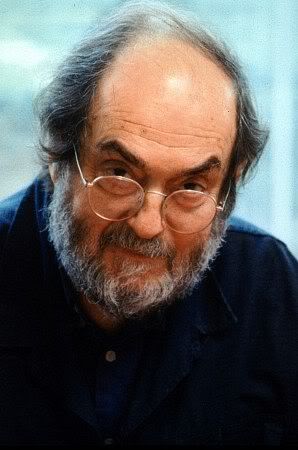
.......................
the shining analysis
the shining actors
the shining actresses
the shining analyzed
the shining archetype
the shining book
the shining book vs movie
the shining bear suit
the shining cast
the shining clips
the shining dog suit scene
the shining DVD
the shining explained
the shining ending
the shining explanation
the shining explanation of ending
the shining elevator scene
the shining film
the shining Freud
the shining girls
the shining grady
the shining ghosts
the shining hotel
the shining here's Johnny
the shining hedge maze
the shining imdb
the shining in 30 seconds
the shining interpretation
the shining images
the shining jack Nicholson
the shining jack nicholson quotes
the shining jack Torrance
the shining jack typing
the shining Jung
the shining king
the shining kubrick
the shining kubrick analysis
the shining kubrick moon landing
the shining kubrick apollo 11
the shining location
the shining
the shining movie
the shining movie quotes
the shining mohonk
the shining moon landing
the shining meaning
the shining novel analysis
the shining novel summary
the shining opening scene
the shining overlook hotel
the shining photos
the shining pictures
the shining plot
the shining psychology
the shining quotes
the shining questions
the shining review
the shining redrum
the shining room 237
the shining rotten tomatoes
the shining soundtrack
the shining stephen king
the shining strange
the shining strange occurrences
the shining strange events
the shining summary
the shining script
the shining screenplay
the shining synopsis
the shining symbolism
the shining twins
the shining trivia
the shining the movie
the shining twins where are they now
the shining you've always been here
the shining you've always been the caretaker
the shining vs the shining
the shining vs the exorcist
the shining versions
the shining W.A.S.P.
the shining woman in bathtub
the shining wife
the shining year
the shining 1920
the shining 12/24/2011
the shining 2012
787 comments:
1 – 200 of 787 Newer› Newest»Interesting stuff, but some of your numerical stuff seems a bit stretched - you can take a handful of numbers and add, divide, subtract untul you get any number you like, that doesn't prove much...still, interesting read, thanks
12/21/12 is the date the Mayan calendar ends and many cosmic alignments etc are supposed to occur. Many feel it is the end of the world.
http://www.greatdreams.com/2012.htm
THIS IS THE GREATEST THING EVER. Thank you for putting so much effort into this. Its so cool! Now I cant wait to watch this movie over and over again.
Are you insane?? Get yourself a real life - instead of a reel life.
I like feedback on my blog but anything posted by obvious mental cases will be swiftly expunged.
WOW!!! You are kookoo!! That number thing is ridiculous!! Come on buddy,your stretching it a bit dontcha think!!??
I totally and 100% agree with Harvey!
You are a cinomatic genius, maybe even on Kubrick's scale, just for figuring out this movie!
This is truly amazing. I knew The Shining was very deep and complex, but I never knew it was this complicated!
You're right- I *can't* see this movie the same way again.
Now I see it as a scary movie for most, but an endless, puzzling, terrifying masterpiece of a movie for a select few.
MAJOR props!
1 more thing--
That Devil thing is soo creepy.
that is amazing.
Okaaayyyy...you do realize that vanishingly small numbers do recur with astonishing frequency just about anywhere you could possibly look, don't you? Given that there is no repeating formula used to get each supposed "clue," just whatever you can make work in a given situation, there is no reason to assume that there is anything to this besides numerology gone wild.
Also, the fact that objects such as the coins or Jack's pages seem to move between cuts is attributable to what are commonly referred to as 'continuity errors,' and can in fact be found in every film ever made.
This reminds me of "The Number 23" because it's equally retarded. Like Sven said - you can take any handful of numbers and manipulate it to get any number you like. You're crazier than Jack Torrance, and working on this crap has made you a dull, dull person!
Whoooyyyyaaaa-bla-bla-bla….
What observant experts the last two readers are and how nice of them to chime in with their bountiful store of knowledge about this movie, not a whole brain or a pair of eyes between them. Any opinions challenging Stanley Kubrick’s numbers are irrelevant and now tiresome and quite unoriginal.
They’re the same numbers stupids! Over and over and over again. They’re on Danny’s sweaters. Did you see???? Different shots and scenes in movies having the exact same duration to the second, time and time again, don’t happen by chance.
No I’m afraid my calculations are exact and you’ll have to come up with more than a few feeble unsubstantiated remarks to disprove this – like some proof. I’ve put in pictures with time codes and durations for numbskulls like you.
Only the thickest of skeptics can overlook the sheer amount of clues that he’s given us.
“There is no repeating formula” he says, yikes! It’s Stanley Kubrick’s formula, whether you believe I’m right or not is unimportant, as he functions way above your head. And by the way I think you are an expert on the 'continuity errors,' you speak so eloquently about but they aren’t what they seem. But if you think they are, have fun with it, ignorance is bliss.
As for Tweddle Dumb, you remind me of the number zero! The Internet is full of loitering know-nothings and do nothings, like yourself who post aaaall daylong. "A picture is worth a thousand words", again for the simple of mind “they’re on Danny’s sweat shirts, Retard”!
You quoted Sven so well but you can’t take any handful of numbers and manipulate them to get any number you like. That’s just high school bull, come up with something origional.
If you don’t like what’s been discovered here, well that’s just too bad. Start your own blog and vent.
You’re crazier than a Kentucky loon on the full moon, I implore you to get a life and find something interesting, if you can.
Thanks for all the insightful name-calling. Has Kubrick EVER personally substantiated these so-called deliberate numbers' appearances in the movie? Do you have any real proof that these aren't just figments of your overactive and misplaced imagination? No? I didn't think so. Listen, you're obviously a very creative, though not terribly rational, person. Why don't you channel your creative energy into something worthwhile to society instead of this delusional crap?
After a quick google search, I see you're not the only one who has latched onto this cracker-jack theory about the numbers in the movie. This, to me, provides absolute certain proof that you are not the only cracker-jack on the internet. I resign from this argument because I realize that logic and reason don't stand a chance against mental imbalances like yours. Best of luck!
Cracker-jack, schmacker-jack, disprove it. Have you ever thought that some things aren’t on Google, woman of the new millennium? Well have ya, Chick? Kubrick, like Dylan, doesn’t have to explain anything he does. Thanks for tellin’ me I’m creative though. I still think you’re crazier than a Kentucky loon on the full moon.
I like the connections you've made, but I can't see anyone, even a perfectionist like Kubrick, just sitting in a room with a pocket calculator watching his movie going, "Now! Cut that frame now!" Coincidence? Maybe. The numbers just are. Some of them may attribute to your belief, but I don't think Kubrick himself would have had the patience to do such a thing as make sure the shots are exaclty twelve, twenty-four or forty-two seconds long. It seems fallacious.
That’s what I first thought, but he did it with a sophisticated editing machine and it probably wasn’t as hard as we think. He does a movie every 5 or 10 years and that’s plenty of time for him to “think things over” and come up with offbeat ideas. Thanks.
JESUS. You yourself call this stuff "hidden." If it's all real, then maybe my disbelief is to be blamed on your inability to explain it properly. My advice is to start your page with the significance of the numbers (Mayan calendar's end of the world, supposedly?) and then show them to the reader. Also, if you can, why don't you mention the appearance (or lack thereof) of any OTHER numbers that DON'T contain 1, 2, or 4? If these are the ONLY numbers that Kubrick uses, or if he uses them a much larger portion of the time than any others, it bolsters your theory. If not - well, I can't help you with that. If you want to prove your case, you must refute any contradictory evidence - and here it seems you've just omitted or not addressed it at all (or even said "there IS NO contradictory evidence" - your reader is left wondering "how many times does the number 9 or the number 3 show up?").
I've made some changes and thanks again, dude.
Kubrick himself stated in an interview with Playboy Magazine that he doesn't want to come out and openly explain the meanings of his films he'd rather let the viewer work out thier own meaning and I must say this is a wonderful reading of the film.
a perfectionist like Stanley Kubrick wouldn't have a guys trousers change pattern during shots by mistake in a billion years.
Finely what I wanted to hear! 100 % correct sir.
Wow! Thanks for putting so much effort into this research. I'm no expert, but I have to agree with you that there is too much data here to say it's all coincidence. "The Shining" is my all time favorite scary movie, and I really enjoyed reading your blog. I will never see this movie the same way again! Thanks.
I will never view The Shining the same way.Just like seeing Wicked and not viewing The Wizard of Oz the same.Interesting stuff.Everyone is entitled to an opinion and interpretation.Thanks for the additional entertainment.Debby
Your theory is interesting and very plausible in several points, but when it comes to the interpretation of the meaning of the numbers, there's something that just isn't right: all indian references in the movie are related to north american indians, not Mayan indians (south america). The "end of the world date (2012)" comes from the Mayan calendar and even considering that some american indians eventually descended from south american ones, that calendar wasn't part of their culture.
If Kubrick planned all these references so carefully (as it seems he did), he surely wouldn't make such a gross extrapolation like that, just to get a "game of numbers" into the film. The numbers are there and I do believe they're supposed to have some meaning, but not the "Mayan calendar" one.
This is a great point, but I believe the fascination with the Mayan Indian date is because it’s the only ancient prediction of the Apocalypse that gives an exact date, and he couldn’t change that. If Stanley Kubrick was interested in the Apocalypse and actually wanted to hide that date in the movie things might not have worked out using Mayan references and art work as it would have been so obvious, people would have picked up on that in a minute as the prediction is well known. I really think what I’m writing about here was purposely well hidden. In fact just this weekend after reading the book I’ve discovered something else that’s very well hidden, something that Steven King has never said anything about even though he must have noticed right away (I wonder why he didn’t say anything?); Stanley Kubrick didn’t just alter things from the novel like everyone thinks. It’s been noted how he used mirrors and parts of the movie are not just randomly changed from the novel but are inverted mirror images of what happens in the novel, and Steven King never said a word in his criticism. Mr. Kubrick didn’t make any of this easy.
Getting back to the numbers two things really bother me, first I can’t at this time prove that he even knew of the Mayan date, and second there’s much more going on than just the numbers that are contained in the date. It may be because they’re components of the numbers I mentioned, but look at all the numbers that were changed from the novel to the number 2 for no apparent reason (1 furnace/2 furnaces, 1 elevator/2 elevators, 1 typewriter/2 typewriters, Danny is 5 years old in the novel/7 years old in the movie, Grady’s girls are 8 & 6 in the novel/they are 8 & 10 in the movie, all 2 years apart, etc.) and this may have an all together different meaning that isn’t understood at this time. I don’t think that what I’ve claimed to discover is by any means the end of this.
I think you made a very good observation though, and all the feedback on this blog makes is better in the rewrites. Thank you very much (it’s nice that I’m not getting last summer’s comments, that I somehow manipulated these numbers to come out the way I wanted, - unbelievable).
Another thing I forgot to bring up is that there’s something that proves he defiantly had the Apocalypse in his mind. I believe the dates referred to in the movie, July 4th and May Day, could have no other explanation than who he felt would be responsible for Armageddon.
Hello,
My friend sent this to me and I want to say that this really made my day. I love Kubrick and I love the thought of making a movie so complex and with so many layers.
2 things. 1 - what do you think is the purpose of Kubrick's decision to change the different props around as well as the wardrobe? You do present that to us, but I feel as if there wasn't a point presented on your half. (Trust me, I would love to know.)
2 - I cannot deny the numbers and all the things you have pointed out. (I actually love it.) But to just state that all this layering and information points to the Mayan's belief of the end of the world doesn't seem great enough of a reason to put all this information in the movie. If it is true, don't you feel like there would be more of a reason? Especially for Kubrick. To say, I want to base all these crazy layers on the mayan belief of the end of the world doesn't seem completely right. (That not saying that it is a part of the answer.) That part seems to simple. Like, why would he choose that? Don't you feel it would also have to pertain to the film and the story of the film as well? Something to enhance King's story even more? Some darker secret? Maybe I am asking too much? But we have to ask the question - if he did all this planning - WHY did he do it?? Now, that's a question I would love to hear answered.
Great job. I am popping in my Shinning DVD now and I am definitely going to read the book as well.
Also, one more question - how long did this take you to figure out? What was the time period that you worked this out?
Hahaha. One more thing - I loved the part about the reversal/mirror of King's book. That was fantastic.
CAN'T WAIT TO HEAR BACK!! THANKS!!!
1) People who “Shine” have the ability to change and move things throughout the movie, it’s obvious but very well hidden.
2) Maybe he thought Steven King had some mystery hidden in the novel (could he have told him that?) and he was trying to add to it, I just don’t know and I don’t think I’ve unraveled all of this by any means, there must be more. I have pretty much added to this blog as I’ve found things and they keep on appearing to me. Just last weekend I realized that his alterations from the novel are not random and do have an important reason.
I do think the Mayan date is a big deal though and he might have also; What if they were right? When I first heard of the date I etched it on a basement wall so I would never forget it.
As to why he did this only he can answer that question and I might not be presenting it in the most logical progression because I’m still finding things. But for anyone reading this blog make no mistake; He did do this.
3) This took about 8 months, only because I keep finding things and have to do rewrites. The big break happened when I noticed that their bedroom changed color, than I looked at the yellow VW in utter disbelief, than the 21 pictures on the wall in the end with 2:21 in the time code underneath – this was the big one and when I knew what to look for after that it was easy. I’m putting in the hidden Hedge Animals tomorrow; they’re in the movie also.
I'm not sure yet about whether or not I believe all of your theories, but I appreciate them very much and am very impressed with your thoroughness.
All those people that are calling you crazy clearly don't understand and have no business reading such an in-depth and impressive interpretation as this. They should just watch Good Luck Chuck and call it a night.
There is no doubt that Kubrick intended most (if not all) of these things to happen.
Thank you again.
Annika
Wow, just read your article here and must say that it has gotten me interested in the Shining. I am quite the fan of Kubrick's films and I had just, hours ago, rewatched the movie. As mentioned before, Stanley was a perfectionist, so when you look at all of these timecodes (which by the way must have been alot of work) and they all point to certain numbers it would make sense to have these assumptions.
Your point that really put the nail in the coffin (so to speak) for me about the timecode idea was the scene when Lloyd gives the drink to Jack at exactly 66 minutes and 6 seconds. The fact that that happened at that time makes it painfully obvious that the timecodes could play a key factor in a larger plot created by Stanley.
I also liked your point about the colours (Kubrick always used different colours and colours of light in his films to display differernt meanings).
The only criticsm I have about your article would be regarding the moving of objects. I think that some of the object would have been moved or taken out for different reasons (such as to draw the attention more towards the actor rather than their environment or to make the shot easier to shoot). Everything else about the article I love though.
I hope to see more written about this as I will be checking back in the future. Thanks again for taking the time to make such an interesting argument and for giving me a fun read!
have you done any more work on other Kubrick Films, such as 2001? Or Eyes Wide Shut? Maybe The films in which he used the 4:3 aspect ratio instead of a widescreen aspect ration have a certain significance as well?
Oh I just thought of something - have you ever heard of the fibonacci number, the fibonacci series? I was taught while in design school that when used in a design, if used for positioning of design elements, size of typography and such, the final product will be much more pleasing to the eye than it otherwise may be. As an example, If I'm designing a poster for a movie and I want to use three different sizes of typography, I would use the sizes: 13 pt, 21 pt and 34 point. These all come from the fibonacci series. SO, Perhaps Kubrick has his own set of numbers; namely 1, 2, 12, 21, 42 and other such numbers used in this film, which he personally considers to be the perfect time length for it to be aesthetically pleasing or the perfect amount of time for suspense, for a creep out and such. That's also just a theory.
And, besides, 666 - the Devil and all that other stuff - that's all old wives tales. THe Devil doesn't exist. It's a cute metaphor but hey, Stanley was not a religious man, was he??
1) I am thinking of looking into other movies of his, but I don’t know much about aspect ratios.
2) I did look into Fibonacci numbers and you may be right, I just don’t know that much about it.
3) I don’t know if he was religious either, but I do know he’s in heaven now working on something new.
you are sick ..... see a psychiatrist ....
I’ve been looking for a Psychiatrist for some time. Is yours any good ????
Amazing post!! "The Shining" has always been one of my favorite movies, and my all time favorite book. I actually read the Shining every year starting on the 1st day of winter. Make for wonderful wintertime reading.
You make so many interesting points! I can't wait until Dec. 31st rolls around this year!!
I see no point in people reading your entire blog then bashing you out. I mean, why read its entirety in the first place then leave rude comments afterwards?
Personally I cannot say that you are a psycho or something, as I have always listened to other people's opinions/observations/theories whatsoever and thought about it, unlike narrow-minded people who doesn't even bother in exercising their brain cells a few seconds a day.
I wouldn't have thought about this movie in a "deeper" sense... but I do believe that if things happen and appear over and over and over again, then I start thinking that there really is something hidden there.
I find your entire blog very amusing and I admire you for this. You've really looked into the details of the movie.
I would like to say that you are a genius for figuring out this code of The Shining. In addition to your analysis check out the 12 song original score to the movie, the 11 song is Midnite,the stars and you.Also in the expanded score the 11th song is called Subliminal Ballroom. Why would it be called Subliminal.
Finally if you have the time check out a guy on youtube called rob ager he has a three part analysis of the Shining that is fantastic.You can also go to his website www.collativelearning.com
By the way all of Stanley's films have code in them.2001.
i'd like to start by saying you did an incredible job indexing all these things. i think the sequence does have something to do with personal preference, but i agree it seems to go well beyond just aspects, as it ties in to numbers that actually APPEAR in the movie, which wouldn't have anything to do with the feel that would be established by this sequencing.
i would like to point out the fact that dick DID say that "the Overlook Hotel here has somethin' almost like 'shining'." which, sorry to say, kinda refutes your idea that the hotel DOESN'T shine and that it's all the doing of the people in it. this could account for the lack of wires on all the appliances mentioned that are in the hotel, and perhaps it is dick's own ability that controls those in his own room in florida.
i thought the "sno-cat" theory for the lions was interesting, because it would be so easy for kubrick to change "snowmobile" to "sno-cat", changing the essence of the animals, while still maintaining the integrity of the story.
i noticed that the numbers 237 added up to 12 as soon as you brought up the "component numbers" 1,2, and 4. also, if you start with two and add one you get three then you add four you get seven. simple as hell, probably nothing, but i figured i'd throw it out there.
Really interesting hints on what appear and disapear in the movies.
I didn't notice the wireless t.v. and lamps, great !
But if you want to have a clue to answer you thought, just look at all the artefact in the hotel and their connection with navaro indian culture. As you have noticed, the yellow color is very used in the film, and associate with wendy (who really look like an indian girl). The color yellow is associate with power in the navaro indian culture. You can also notice on the wall all those indian based motif (who are also on different piece of clothing of Wendy and Danny, like his belt.
I don't think like you that overlook isn't posseded, he is in fact and Wendy, Jack, Danny and Halloran throught their ability to shine, see trace of the past, like the blood that come out of the elevator, the party, the guy in the wieird suit. Indeed, Kubrick like a lot to use symbolism and freudian psychanalyse. In some interview Diane Johnson who help him adapt the Shining state that kubrick based his adaption on a passage of a book by Freud called (strange worrying, im not sur if its called that in english, in french its Inquiétante étrangeté).
This passage talk about the mechanism of fear of the human mind and develop on the fear that come from something that his hidden in the past or if you prefer hidden inside something.
Each things that the characters see
in the movies when they shine is the presence of the evil past of the hotel, and what does the hotel represent ? In the begining ,Ullmann say to Jack and Wendy that the hotel is construct on indian cemetary and that during the construction, they had to fight the indians who were protesting against the construction. The hotel represent the greed of american capitalism over the navaro indian. Who goes to the Overlook Hotel ? Only the wealtiest of america, and the hotel has a past of violence.
As i said, the color yellow is associated with wendy and Danny, but not with Jack. The hotel slowly turn jack completely crazy, jack become the represent of the hotel (like grady was). Jack become to represent the american greed over the indian couple danny/wendy. Sound crazy ? Yes i know. Remember what i said earlier about the presence of the past hidden, the reference to the freud text, all the navaro symbol are there to back the assocation with wendy and danny against the agressor jack.
One scene that prove that symbolicaly and that a lot you i'm sure never noticed, is the scene were jack trow the ball against the wall, if you look at the wall, the 4 figure of indian navaro are there in yellow. Wanna go even freakier, in the shot before that one, we see a table with the typewritting machine, and there a smoke in a ashtray with a pack of malboro, and, you can see two wooden pen and eraser that make the form of a gun, pointed at the navaro figure on the walls. And the smoke ! There malboro, the boss of that company, Philip Morris is a self-proclaimed racist that once finaced the KKK.
Kubrick has always been a great but subtile critique of the american policy and idealogy, (no wonder why he decided to go live in London)He make an metaphor on how american society killed the navaro (16 milions were killed, two times the number of the nazi holocaust).This is what the scene of blood elevator means, massacre. But in the end, the film even if it seem dark is positif, it annonce the death of an old american way and the birth of a new one throught Danny, who finish the movies alive and well and Jack who become another ghost of the american past. The numerology that you found is really great, great work with the timecode. Personnaly, i see the recurence of the numbers that are mirrors one of another as an association with one the most worked thematic in horror genre, duality, (like dr.jekyl,mr. hyde)
All the film is shot in symmetrical manner that bring the idea of the double, like the twin daughter of the grady family, the double can be seen here like a reflexion of a duality hidden in Jack, and the hotel. All the mirror bring that idea of double too.
Still, there a lot to answer about that film, like to the reference to myth(jack as the minotaur in the labyrinth, the oedipan myth and complex trought the danny/wendy relationship that is exploit throught the deconstructing family theme, also notice that the film they watch in the movie come back two times and his about a women who has relationship with a young men when her husband is at war) .
And the children story, too !
When jack is in front of the door and say the replica from the tree little pig, and the way Danny come back in his trace like in The little Poucet. Im gonna stop here.
thanks
I like reading comments on my blog. Sometimes they’re extremely helpful, and I’d like to answer the last three.
I’ll do the last one first. I often wonder if there are any clues in the Indian artwork but his use of the colors yellow and red may have nothing to do with Indians. The colors were taken from the novel and if you read it you’ll notice that they’re reversed as if being looked at in a mirror. What’s red is yellow and what’s yellow is red and this is the most important clue to understanding the entire movie. Stanley Kubrick did it on purpose so you would notice but for people who don’t realize this, it’s lost. I’ve personally wonder if the movie has anything to do with American Indians. It’s not their Holocaust that was on Stanley Kubrick’s mind but the Holocaust of the Mayan Indians who’s prediction of the Apocalypse was 12/24/2011, all numbers seen extensively in “The Shining”. American capitalism might have nothing to do with it either. It’s small peanuts compaired to the fact that America is one of the two nations on the face of the earth that has the capability of destroying all life. This is the hidden metaphor in the Shining, and the fact that he mentions both dates July 4th and May Day just proves it. I have only dealt with things can be visually seen in this blog. I specifically left out any psychological explanations in my blog and they should be discussed elsewhere as they can be argued about forever.
love_is_a_myth found something very interesting. I like the title of that song “Subliminal Ballroom”, and that it’s the 11th song. I think the definition of subliminal should be noted - perceived by or affecting someone's mind without their being aware of it. It seems that this is what Stanley Kubrick has done throughout the entire movie and this is yet another clue that proves it. I did check out the online analysis of the Shining.
The middle post absolutely made my day though. Look closely at what he’s written. “the Overlook Hotel here has somethin' almost like 'shining'." which, sorry to say, kinda refutes your idea that the hotel DOESN'T shine and that it's all the doing of the people in it. “It DOESN'T” is supposed to be very loud so I can hear the refutation. I looked at this sentence for about 11 seconds until I realized with my mouth hanging open that this is the indication I’d been looking for that proves the very unpopular but 100% correct view that I have brought forth which is; The Overlook doesn’t “Shine” and doesn’t have the same abilities as the people in it. I couldn’t believe I missed it. This anonymous person got the quote exactly right, which I admire but I still went back to the movie to double check it. The explanation of everything that’s hidden in this movie is either on the screen in front of us, in what Stanly Kubrick changed from the novel, or in the dialogue itself. Just think about this; everything we’re told about “Shining” comes from one source, the lips of Dick Hallorann. Whether we’re reading the novel or looking at the movie, he’s the only one that knows anything or says anything about it. He’s a board certified expert on the subject, and when he says “the Overlook Hotel here has somethin' almost like 'shining'." we have to take this as coming from someone that knows exactly what they’re talking about. “Somethin' almost like 'shining” is not the same thing as “Shining”, it’s ALMOST LIKE IT, period. There you have it from the horses mouth, The Overlook Doesn’t “Shine” it has “somethin' almost like 'shining”, and if you look at what he and Danny are talking about over ice cream you’ll see he’s trying to convince him not to go into room 237. The reason is not that he’ll find anyone in there or that it’s even dangerous (which he would have told him) but because Danny, with his very special ability, will see the echo of something that was there in the past, exactly like that maid in the novel does. It’s kind of like the smell of “burnt toast”, the toast is in your stomach but the smell is still there.
Thank you very much Mr. Anonymous this definitely belongs in my blog.
This analysis is great.
I agree with a few of the earlier comments in that you are %100 cookoo. Not a single one of your theories holds any water whatsoever. It's impossible to film an entire movie without a few little continuity errors. Your number theory is laughable. Stop overanalyzing it. The reason some scenes change color a little is simply because of lighting. He wanted some scenes warm, some cool, simple as that.
Ummmm, the Mayan calander ends on 12-21-2012.... So your entire thing is wrong. The whole point of your EXTREMELY long analysis is based on something you're just plain wrong about, so how can anyone listen to a word you say? Jeez man, with all the time you wasted on researching the film you'd think you could have taken two minutes to find out the actual end of the Mayan calander. Dumb ass.
Hey Dumb Ass; Your ummmm “thing is wrong”. They should have taught you little children how to read instead of skim. Here’s what you missed, it’s in (2) different places and simple English for the simple minded. 1) “In the 70’s I learned this was the date the Maya Indian’s predicted as the end of the world (though the meaning, and actual date now seem to be modified – 12/21/2012 Mayan Calendar)” 2) “As far as the Mayan date, I don’t have a clue why it’s been changed through the years. I heard of it in an episode of "In Search of..." In Search of Indian Astronomers (1978) hosted by Leonard Nimoy”. Clear now, Dumb Ass? Why don’t take your sarcasm with you and go back for some schoolin’ rather than trolling the Internet with your useless dribble. Now reeeeeeeeeeee-read it the right way and do an extensive report on it by tomorrow. Scoot.
As for the Mr. Anonymous before you: I, unlike you, am only 10% cookoo and I put in the pictures for numskulls like you.
The numbers that you came up with are interesting and who's to say that some of it was acually used. Editing a movie, especially with a director as famous as Kubrick for taking massive takes would be a large job for any editor. For Kubrick to sit in with his editor to make sure that these somewhat subliminal details worked is a job that I don't believe any Editor would take on. Now, as for the Hotel I've always been in agreement that the hotel itself retained bad things that happened in the past as some other places do and that only people that shine see these events. They are so ingrained in the hotel that they are always there but most can't see them. the things that happened there really didn't happen at that time. A non shinning person would have seen none of it. There were many years that people spent winters there and there were no problems....Why? Because they didn't shine and didn't see it. I believe their whole family shined and it makes sense that it is heredity. In closing, it all happened in their minds. As far as the topiary it's quite well known that at that time it was impossible to use that in the movie without looking fake and Kubrick wasn't about that. He was a thinker and wanted you to think. It has taken may years of watching and there are still things I see. Bottom line. I doubt all of the numerology was planed completely although I can't say some wasn't intentional. The hotel was simply a repository of events that many old places have and certain people respond to this. The weekend mind of Jack put him in the ultimate bad situation. Danny was the strongest shinner as both of his perents were and as such, saw the most, he was just of more rational mind than Jack who was also stronger than his wife but not his son. He knew it and thats why his son was considered dangerous by jack knowing Danny was seeing it but of stable mind. All in all very intesting.
This is by way, way, WAY far the most in-depth, imaginative (meant as a compliment) and intriguing movie analysis I have ever read. The truth or not of it is immaterial. By saying that, I mean that you lay down the building blocks of a hypothesis, you present your conclusion, but what every one of your readers makes of it is what matters, however that will vary. May I congratulate you on your work?
Now some fun facts (I can definitely see what SK liked in this)
My last sentence began with "May I"
I have, for the first time, read your blog on 29/03/2008 (pardon my continental dating). 2+9+3+2+8 = 24
In December 2012 I will be 29 years, 11 months of age. 2+9 = 11
Before I watched the movie (for the zillionth time) I sat on an orange duvet drinking Vodka and orange juice.
And last but not least something that I believe you might enjoy... Have you ever read Douglas Adams' works? If so, what is the answer to Life, The Universe, and Everything?
P.S. to those that will jump in to call me a paranoid schizophrenic, sod off, I'm having fun.
Me again (i could most likely do this all night but I'll refrain after this one)
Stephen King and Stanley Kubrick share initials. S is English's 11th and K 19th letter
Okay okay it is far fetched, but I said I'm having fun here :D
Those letters add up to 2011.
Just realised I put them the wrong way around last night :) It was the Devil Vodka :)
Okay, nice an interesting work, and sure I'll notice next time I watch it. But let it be like that...
It's just another view of seeing a thing like many do endless times with anything.
Nice job, but I don't think it's was ment to be like that :-)
I don't know if you caught onto this but heres an exert from Wikipedia regarding it:
All work and no play makes Jack a dull boy
'The sentiment expressed by this proverb was first recorded thousands of years ago by the Egyptian sage Ptahhotep, who wrote in 2400 B.C'
Again, another reference to 24.
Anyways, just something you may like to add to your blog if you find it worthwhile.
Thanks; That's great. I've found a few more that I haven't put in yet.
I think you looked at numbers far too long. 21 footsteps in the snow? (By the way, what do you mean with full?) 21 pictures on the wall? You are so possessed with finding these numbers that you don't see them when actually do appear. It's true 2,3 and 7 add up to 12, but did you ever try to multiply them? The result will blow your mind, I fear. These numbers might have a significance, but the May Day? This is so random I have no words for it. For what reason did you choose to add the 11 from the Apollo shirt and not let's say the 42 from his other sweater? If there's any logic behind the equation leading to that date you failed to show it. In fact I think the post from MARCH 6, 2008 12:17 PM was much closer to the meaning of the movie then your theory.
I am also afraid it's just not possible to cut a movie the way you suggest. Do you really think Kubrick left out footage or added stuff he didn't really need just to get the timecode right? If he did he wouldn't have been the great director he actually was. And don't tell me that he planned the timecode before shooting. There's no way that someone could do that, not even a genius like Kubrick.
The different colours in the images are really a product of lightning. I'm a spark, so you can trust me on that.
But after all I think you brought up some interesting details, e.g. the numbers are really too significant to ignore but your conclusions are just to random and illogical.
“I am also afraid it's just not possible to cut a movie the way you suggest”, I don’t think you get it; It’s already been done.
“There's no way that someone could do that, not even a genius like Kubrick”; How do you know that? I guess he’s only a mild genius.
“…Your conclusions are just to random and illogical” Thanks but I never clamed to be Mr. Spock and "random" is because everything hasn’t been discovered yet.
So your theory isn't logical and it's based on facts you haven't discovered yet, is that it? Well, what you are actually telling me is that you already had a conclusion and then distorted the facts so they would fit in. That is by no means a reasonable way to interpret a piece of art. If you do so you could easily proof that the Mona Lisa is about praising fascism or peanut butter or whatever.
The timecode-thing is in fact not possible. How do I have to imagine that? "No Jack, you can only pause there for 6 frames or we will not end up at 01:06:06."? This whole thing would cut down your possible decisions in a way that is just not thinkable any more. Why should Kubrick have done such a stupid thing that would have left him without any room for dramatization?
You know less than nothing about moviemaking. A genius of your caliber could never figure out how to do something soooo complicated but Stanley Kubrick somehow did. The time durations were done in the postproduction editing stage and Jack Nicholson probably knew nothing about them. Now why don’t you scoot along and go play in the traffic.
Wow, what a grown up comment. Seems, you don't mind constructive criticism. Well, relax. I actually know that nothing I can say will change your point of view. I just want to give you something to think about. So here are some final points. First: I think I mentioned that I work in the industry. And now I'm taking a wild guess here: I know much more about moviemaking than you. But that's an argument by authority, so nevermind. Second: I find it hard to believe that Kubrick has mad a movie that is only understandable when you read the book first. The very same director who refused to give interviews on the grounds that his movies have to speak for themselves. And third: the timecode. I think there's a misunderstanding regarding my position. You suppose that it serves as a proof for your theory, that you found some important scenes taking place when the timecode shows these numbers. Now consider a movie with a lenght of 02:24:00. How many times do you think will the timecode show the numbers 1, 2, 4, 12, 21, 24, 42 with all the possible plus-minus combinations? 100 times? 1000? ( you can calculate that if you want, but I didn't bother; the number is huge anyway) It's impossible that you don't hit anything important. It would actually point to a deeper meaning If you wouldn't. What if the timecode was 01:06:06 when Jack is saying "Words of wisdom, Lloyd."? Would you have come to a different conclusion? Why would you use a stylistic device that can't be told from a coincident with certainty? And that's my position: I don't doubt that the timecodes you figured out are right and that they contain the numbers, I just find it unavoidable. An unavoidable coincidence, nothing more.
And of course: it would be possible to cut a movie around the timecode, but that would imply that you use things you don't need or to turn something down that is important ( and I think I also mentioned that before). Just think of how music and picture come along with each other in The shining. Or the acting and the picture. There are so many important things to worry about, that would all suffer if you would try to end up at certain timecodes.
So that's it. You are free to proof me wrong, but at least try. If you do so you will be one step further. Now, wouldn't that be something?
Wow, must have took alotta time to write this article. GREAT WORK. Theres a guy on youtube his website is www.collativelearning.com. Who also has some great views. Thanks a lot for your insight on this movie. The first time i watched the shining i was like "WTF??!?!" this movie is kinda stupid/doesnt make sense. Now it makes great sense. Its a horror movie to/for the ignorant. Those people are idoits who bash you because they actually too the time to type flames to you and read your article lol. They must have been into the article or else they wouldnt have read it lol. Id like to see them come up with something different. As for the numbers, I cannot say your right or wrong its a lil too complicated to me, but the indian theme and historical refrences are def true. Too bad stanley is dead because hes the only one who knew the "real" answers. But he wanted the viewer to figure it out, so i guess were kinda screwed lol. THANKS FOR UR INPUT!
This really is fascinating! Thanks for all of your hard work... wonderful.
Thanks for the last 2 posts.
Just to get this discussion back to ground: It's just a film and Stanley Kubrick just a brilliant director. No need for insults.
It is definitely NOT the Holy Bible and God that are being discussed. Even if it were so, you would all be carrying this too far!
Just my own humble opinion. The blog is nicely done and resolves in an interesting opinion. Personally, I do not believe in numerology. And I would always add up 12/21 to 3. But I like the mirroring between 12 and 21 a lot.
This is some really interesting stuff, man. Jack Nicholson has been in a lot of weird movies but this has to be his weirdest, next to One flew over the cuckoos nest. Some very interesting points here my friend. Any other movies you're currently analizing?
I don't remember what page it was on but it was referring the the chairs as a place where the 'invisible' people sat/moved the chairs.
Anyways, in the scene where Danny first sees the twins all bloody, a random bloody chair appears out of nowhere, and it is nowhere to be seen before the blood action occurs.
Is there any link between all of it? Maybe I missed it in your post where you addressed this, or maybe you missed it.
I’m not working on anything right now (just trying to finish this). I’d love to start a new movie blog-site emphasizing pictures. I think they look great along with text. If I do this there’ll be a link on this site with easy directions on how to blog and where to go.
I noticed the moving chairs years ago (thought they were SK’s way of putting ghosts in the Overlook) I just realized the real meaning of them about two weeks ago. They’re in the section about Danny’s friend Tony. I haven’t had a chance to look for more and it looks like you beat me to it. The chair you saw appears along with the ax (strangely it’s the same one Jack uses) at 50:00 in the movie. It must mean something as it is oddly turned over and there are no chairs anywhere in the hallways. Maybe Charles Grady had an imaginary friend also who was sitting there and did the killings or watched, who knows. I have a feeling The Overlook may attract people who “Shine”; I’ve had this feeling for a while because in the novel it seems to need Danny’s power. This is so complicated. I don’t know how SK could have done all this in 1 movie.
Evans Adrian, if you're out there, you did notice something big. It took a while to figure out but here it is; All the invisible entities have there own separate chairs. Grady’s chair that you spotted is also seen several other times in the movie in a special spot.
....and there's quite a bit more. I'll type it up soon.
I tried searching the entire movie for that specific chair, but have yet to find it. Perhaps you found something I missed.
Also, there are so many chairs in this movie. Colorado Lounge, kitchen, bedrooms, hallways, alcoves, everywhere. Theres something to it. Keep me updated.
Charles Grady could "Shine". Go to the section on Tony the pictures are now up.
Oh man, beautiful work. I was looking for an upright chair the entire time- this is the ONLY chair that is upside down in the movie and I find it most interesting that it was sitting outside their apartment the whole time.
You know, it would have been nice for Kubrick to write his thoughts down about the script and the meaning behind it all. I guess perhaps we will never know, but this movie shines through his others by a long shot.
Thanks for posting your findings!
Well I think there's a bit to what you're saying here.
I'm majoring in film myself and I think some of the things are just pure continuity errors that happens in all films. Not everything is purely avoidably or purely structured. Mistakes happen and things happen on film sets where objects/props may need to be slightly moved for camera angles and positions, framing etc. or simply changes occur on screen because of action. you mention the cig ash from wendy's cig, holding a cig and not taking a drag due to talking on set so much can cause this. take after take of danny eating a sandwich will cause it to get smaller even when only using certain takes which may slightly affect the so called "perfect" continuity.
Now i'm not saying everything here is wrong and i definitely acknowledge a lot of what you are saying but there is certainly a lot here that seems be very important. i do however refuse the time code of the film it's seems a little far stretched.
Considering we don't have an explanation from Kubrick for all this, it could all be purely random thrown in to make us think more and hence all the attention he is receiving for this film and himself.
connections can always be made believe me i've spent alot of my time studying symbolism.
I'd ask you to give the same type of temporal treatment to other Kubrick movies, but I don't think it will help.
Kubrick had a very specific sense of timing. This can be seen clearly in Dr. Strangelove, The Shining, 2001, and Eyes Wide Shut. It may just be that his shots seem to have the same length; :12, :24, :42 seconds, because his internal clock tells him thats how long they should last.
Don't get me wrong, Kubrick is a genius and a fantastic artist, but I don't think of him as a prophet or a microcosmic arranger of tinfoil hat style detail, especially in accordance to DVD releases that he didn't have a whole lot to do with.
As far as the 'changing' colors on the walls, I am a photographer, and I can tell you that at different times of day, with different lighting and different angles of refraction, one wall can appear many different colors.
And in concern with the Mayan end of times style concepts, none of the art in the movie was Mayan. It was all Native American. So if Kubrick actually wanted to point this Mayan connection out, why would he force his viewers to sit their with a stop watch, and then have intimate knowledge of a concept that, at the time, wasn't wide spread.
An interesting read, thank you.
Several people have mentioned that the changing colours occur because of lighting. This is true, but I am sure Kubrick would not leave such important things as obvious colour themes to random lighting affects; he used them to his advantage. So, the colours are intentional.
Also, I think that the numbers seem a bit overly manipulated, but definately worth investigating further: look for other numbers to check if they could be explained randomly, go through other movies for similar things, etc.
Finaly, I think that Kubrick would be more pleased with people discussing and debating his films than simply finding 'the answers' to them, so when people criticise this article or those commenting on it, they should discus their arguments properly, not just call people names.
Another thing: I find it highly unlikely that Kubrick timed the scenes to add a great deal of meaning to the time code because apart from being exceedingly difficult at the time, the film was edited after recieving negatives reviews, which resulted in several scenes being left out or shortened. So this 'hidden code' would have been lost in all versions except the first.
you have too much time on your (#%$#@!%) hands. so what if the numbers occur multiple times? what the (%^*&) is it suppose to mean? what does the number represent? the devil? the satan? what is it? number means (&%&@) if they don't have a meaning.
great stuff.
do you have stuffs for other movies.
I wish. This was a lot of work.
Wow, it defenitely made me look at the entire movie in a new light, and when you think about it, the ending makes sense haha. Thanks for putting all that work into it.
ciao jonny!!! i've never seen such a greater interest for movies (let me rephrase that: Movies) like your!! you're a genius, now my eyes are wide open and i can see the real greatness of kubrick's masterpiece.
Greetings from Sicily (italia).
ps.Sorry for my bad english
Interesting theory. Only thing I felt didn't carry the same weight as your number analysis was some of the moving chairs stills. I think some of those can be attributed to a slight move or zoom of the camera which would give the illusion of movement through the parallax effect (granted I haven't seen the movie in a long time). Kudos :D.
Well, this is quite obviously overanalysis of a film that is good enough without it. Despite the assertion that every little thing means something in a Kubrick movie, I do actually think that some of these small discrepancies and details might have simply slipped by a great director in search of the "big picture." Which is perfectly fine: as far as I'm concerned continuity is boring. The American Indian motif and the mirror thing do seem totally valid, but the numerology and the entity business don't hold water.
I am somewhat surprised though that you omitted a very obvious deliberate "error" on the part of Kubrick: the moment when Jack, after raging at Duvall in their "home" room, storms out, in doing so giving a fierce glare directly at the camera. I must have watched this movie twenty times before I noticed that. Rather than being a distraction it's quite scary, as though the actor might just come roaring out of the screen.
Now I'm willing to bet at least fifty takes were done of that exit, but Kubrick chose that one to use. So I do think he included this to break down the fourth wall just a bit and put a little extra punch in the scene, as if to say: it's not good enough to to tell yourself it's only a movie. That plus the McLuhan overtones in the use of TVs might constitute a whole separate subtext on mass media.
In any case, a remarkable effort here, well done.
If you read the novel one more time youll see that the abilty to shine is not moving things with your mind but being able to here peoples thoughts and have conversions with someone( who also shines) without moving your lips
If you look at the movie you'll see that "Shining" in Kubrick's version goes way past the novel. You need to read The Differences Between The Novel And The Movie, "one more time" without skimming.
….And your comment is a little perplexing as I’d like you to prove that Stanley Kubrick didn’t change his definition of “Shining” from Steven King’s definition. Is there a law against changing a screenplay from the source novel?
An interesting article, although I think a lot of the points have been wildly overthought or that the writer has gone looking for numbers rather than the numbers actually being there to be found.
Fantastic! Some of the comments on your wall are complaining of over analysis, but I think you're really onto something here. Kubrick is a notorious perfectionist when it comes to his films and the numerology you picked up is clearly deliberate. Thinking this about this subtle, but emphatic message gives the film a whole new chilling layer. I can shudder thinking about what he's trying to communicate here. Well done!
This seems to go even deeper than what has been stated so far.
Reversing the colors is almost like undoing a spell. If King made the VW red, Kubrick made it yellow.
Magician #1's work being undone by Magician #2. What moved in the book didn't in the movie. Mirrors.
All magic.
And what if the symbols transcend the movie?
There was a VW Beetle on the Beatle album Abbey Road. Could the open hand of Nicholson in the photo be the same open hand that is over McCartney on Sgt. Pepper?
The dog man looks a bit like the walrus on Magical Mystery Tour.
Laugh if you must, but "we all shine on".
And, oh yes, I forgot to mention, Wendy was reading "Catcher in the Rye", speaking of Beatles connections. Seems that was a favorite of Mark David Chapman.
I love this and all...but didn't it say in the bible that only God himself knows about the end of the world and no one else will, not even His Son? I'm just tossing that so...yeah...
Fascinating essay, though I wish you'd have focused more on the film's themes and less on elaborate number schemes. I agree with a previous poster, who said you can take any handful of numbers and add them up to get the result you want. I do find the many examples of objects curiously moving to different places in the same scene is very interesting. Kubrick was a control freak and very meticulous. I doubt any fiber of that set moved without his very knowledge.
Much has been debated about that final shot. Today, I had the odd vision that maybe everything that came before that final shot was imagined...that the image of Jack in that photo at the end was the only "real" thing in the film. Perhaps Jack's spirit continues to inhabit the Overlook, because HE "has always been there". Then there are other theories that speculate the house "repeats" itself every night and the souls of the past come back to reclaim the Overlook.
The great thing about "The Shining" is you can debate it long after seeing it. It's a film I come back to continually, with great regard. It retains its value, its subtle sense of doom, and its creepiness. Kubrick was a master of getting inside his character's heads and suggesting a psychology that stretched beyond the images onscreen. Much in this film reminds me of "Eyes Wide Shut"...that same kind of creepiness and sense of dread.
That final shot, with "Midnight, the Stars and You" leading to the end credits...still gives me chills.
Very interesting read.
I'm not totally convinced by the #'s/time codes theory, but you're right, i won't look at the movie the same again.
very interesting blog man, good job.
First things first, I enjoyed reading your theories on this film and you're obviously a smart guy but I feel that some of the things you say just don't line up with the movie at all and you might be guilty of a little over-analyzation. Especially given that you've read the book, I'm surprised you believe that all the visions are just examples of the various characters shining. Jack is unstable but the hotel pushes him over the edge... it is haunted and the ghost of Grady does let him out of the pantry (even Kubrick himself has said this) its not Jack 'shining.' Also, in the book Halloran says that the traces of the past that people with the shining see are not harmful, but Danny realizes that the hotel is somehow harnessing his powers and actually making the specters powerful enough to do harm. Accordingly, that is why the woman in 237 is able to attack Danny. Why, if Jack was actually attacking Danny in his sleep, would the attack come in the form of the woman whom Jack, not having entered the room yet, would not be aware existed? It seems to me, having read the book and watched the movie, that the hotel is growing in strength, essentially feeding off Danny and Jack, which explains why the visions are becoming more frequent and dangerous. A lot of these seemingly random visions are explained in depth in the book- the dog going down on the man, the woman in the tub, etc.
Granted, many of these things are only explained fully in the novel and not the film but I think that there is certainly enough present to conclude that, even in the film, the hotel is haunted and the strange events are not just a result of Jack's mental breakdown coupled with his ability to shine.
Just my two cents. Either way, I really enjoyed reading your theories.
“It is haunted and the ghost of Grady does let him out of the pantry (even Kubrick himself has said this) its not Jack shining.” Actually I thought you had me and I had to check this out. Look closely at the interview. When Stanley Kubrick is talking about Grady being a ghost he wasn’t talking about the movie, he was referring to the story from the novel. If you have preconceived ideas the reversals he made to the novel are shocking. Especially when you think of how he was able to hide all this in plain site. But if you “go check it out” what I’ve noted is quite correct. It’s not only correct but it can’t be debated, discussed, altered and most importantly dismissed. It is what it is. Red is yellow and yellow is red, and it’s also quite obvious that in the movie Jack “Shines”.
No “over-anaIyzation” here, just a thorough job. Thank You.
COOL STUFF!SOME THOUGHTS HERE:DIDNT STANLEY "DIRECTED" THE FAKE FOOTAGE OF THE MAN LANDING ON THE MOON??COULD BE THE APOLLO SWEATER A REFERENCE TO THIS,ALSO CONNECTED WITH THE MICKEY MOUSE SWEATER(VERY SIMILAR KNITTED WOOL),TELLING US IN A WAY THAT THE LANDING ON THE MOON IS AS FICTIONAL AS A DISNEY MOVIE??I ALSO WANT TO POINT OUT A POSSIBLE MISTAKE IN THE MOVIE:WHEN JACK BREAKS THE DOOR WITH THE AXE,AND SAYS "IM HOME",ONLY ONE HOLE IS MADE IN THE DOOR(THE ONE IN WICH HE PUTS HIS FAMOUS FACE THRU).SECONDS LATER WE CAN SEE TWO HOLES IN THE DOOR¿? BYE FREAKSSXX
i'm not shouting i'm just lazy to re-type the full text and a little bit retarded
The only thing I want to point out is that your numbers add up to 2011, but the Mayan calendar ends on 2012.
Yes, you have come up with some pretty interesting theories on this film. Most of all, I like your theory that the novel was held up to a mirror.
You've also taken things much too far in many cases. I don't have a problem with that at all. Delving as deeply as you have into something can be fun and lead to some interesting conversations.
What I do have a problem with is your arrogance, calling anyone that disagrees with you stupid/thick/brainless, and your lack of understanding that you have come up with interpretations and theories.
Unless Kubrick comes back from the dead and verifies all of this, it remains a theory. However, I have a feeling that if he did come back from the dead and refute all of this, you would just tell him that he's stupid and it's all obvious.
I could go on, but you're just going to call me a moron anyway. Grab a stop watch and a copy of "A Clockwork Orange" and see what you can come up with.
Actually I don’t think you’re “a moron” (as you sound quite sane) but I have no interest in "A Clockwork Orange" at all. “Kubrick” doesn’t have to come “back from the dead” to talk to me because everything I’ve shown you is accurate and verifiable. In attempting to understand “The Shining” we have to separate fact from conjecture. There are a lot of theories about this movie but three things cannot be disputed 1) the images that Stanley Kubrick placed in his finished product 2) the dialogue in the finished product and 3) the exact way he altered Stephen King’s source novel to make it his own.
I show you all three of these in this blog and they can’t be altered or ignored. This is the starting point that must preclude any attempt at explaining the mysteries held in this work. We start with what we know for sure and work forward, and this is what I’ve done.
Found this site. Pretty comprehensive and raises some interesting questions but a lot of it seems like conjecture to me.
It's interesting that in "2001: A Space Odyssey" HAL says he has been activated on the 12th January 1992. So we have 12, and 1+9+9+2=21.
But, consider this:
"The Timberline Lodge on Mt. Hood in Oregon was used for the front exterior, but all the interiors as well as the back of the hotel were specially built at Elstree Studios in London, England. The management of the Timberline requested that Stanley Kubrick not use 217 for a room number (as specified in the book), fearing that nobody would want to stay in that room ever again. Kubrick changed the script to use the nonexistent room number 237." (http://www.imdb.com/title/tt0081505/trivia)
This is reported also in LoBrutto's biography of Kubrick. So appereantly Kubrick made this change for no allegorical reason.
I agree that sometimes things seem change in color only because of the different lighting (e.g. Jack's paper).
I supposed you used the US Warner 21156 DVD released in 2001 to check the time codes. This DVD contains a Warner logo before the first frame of the film. So you should consider that the timing that appears in the DVD player starts from the beginning of the main title, including the few seconds when the Warner logo is on screen. I suppose that, while editing, Kubrick didn't have the logo with him (he edited his films at his home, with his equipment). So, if he actually wanted to convey a particular meaning through the time codes, you should subtract the few seconds in which the Warner logo is on-screen. Furthermore, in 1980 Warner didn't use the logo we see on that DVD. This logo is a newer one. In 1980 they still used the moving logo changing colour (black, red, white); you can see it in the "Barry Lyndon" DVD. I've got also the first release of "The Shining" in DVD (Warner 17369), which contains the original non-remastered version of the film, with the mono soundtrack mixed by Kubrick (in the 2001 DVD the soundtrack is remixed in Dolby Digital 5.1, without Kubrick supervision because he was already dead). In this DVD there still is the old 1980 Warner logo.
I must say that the duration of the new logo in the 2001 DVD is the same as that of the old logo in the 1999 DVD: 12 seconds. The film starts at 0:00:13. This means that, in both DVDs, you must subtract 13 seconds from the timing indicated on the DVD player. I suppose that, considering this, all your conclusions change.
What's more, Kubrick cut about 25 minutes from the international version of the film. This means that the version you analysed was distributed only in USA and Canada. In the rest of the world, including Italy where I live, the film lasts 119', which means about 115' on PAL video (PAL reduces the running time of 4%). So all your considerations about numberology can be verified only in the USA and Canada version.
Even if Kubrick decided to distribute all over the world the same 144' version of the film, with the PAL video sistem all the time codes would have been altered. This doesn't happen with NTSC video system, used in USA, which does not reduce the running time of the film. Of course, I'm just talking about video: in thatres all over the world the time codes would have been the same. But, considering that the running time of the International version of the film is different from the USA version, I say again, the time codes are different.
Anyway, I found you analysis quite enjoyable, even if I don't agree with a few things.
English is not my mother language: I hope everything I wrote is comprehensible!
Now that I'm thinking of it, the first Independence Day was July 4, 1776...
1+7+7+6=21
This could be another reason why Kubrick chose year 1921.
You are amazing.
The 12th of december, 2012 is going to be the end of the 13th baktun cycle, not the end of the world. As far as I know was never changed from the 24th of december, 2011.
But if you can find a relation from the Shining to that date, and still want to look into doomsday theories I suggest looking at the significants of the Baktun cycle and the book of revelation and if you end up with the right ideas you'll probably find alot more connections than you would think, I'll give you a hint as where to start.
"144,000",
^ you are SO cool.
Thanks for this SO much! I read all of it, you made the movie just better. My favorite movie!
Thanks.
Thank you for all the compliments.
You are mental. I would love to believe this tripe, but with so much inconsistency and blatant 'selection' of evidence it's clearly b*llocks. Kubrick's brilliance has obviously mindf*cked you. Try counting the tessellations on the floor shots, I hear they calculate precisely to a number!
You know I am a big kubrick fan u just made my appreciation of the shing better
Ok It appeares to me that theres more to all his films. Ill bet 2001 has quite a bit of stuff similar to this in it. If you read Dark Mission by Richard Hoagland and mike Bara you'll know a lot more as well as a lot about the face on mars - cydonia. kubrick knew nasa was hiding something they had too. so I think he was telling us something here in the shining about doubling reversals etc.
Wow, this is intense. The part that gets me is the chairs with the doppelgangers. I'm gonna have nightmares after reading THAT! This movie seems so much scarier to me now after reading this article. I've seen it probably 8 times and always wondered what the colors meant but never ever noticed colors changing and things moving. Gotta watch it again but since this article scares the poop outte me I aint watching it alone! Thank you!
look at jack's version of the maze carefully. i done exactly what you said and looked at it for 10 seconds. within 3 seconds i realised what i saw. the image is one of those puzzles where the picture pops out at you when u stare at it. i saw a skull and crossbone.
Johnny, you may want to double-check if the photo really wasn't taken in the golden room.
When Jack goes to have a drink at the bar before getting his instructions from Lloyd, you can see him walking past a palm, just like there is a palm in the background of the photo.
The wall with the doors also looks very similar.
Phred
Phred, we know for sure that the picture is not taken in The Overlook from the interview with Michel Ciment.
Bill Watson's trousers never change.
They might appear to be a solid colour on a DVD or on a VHS tape even more so but I've got the movie on Bluray and I'm positive that they have the same pattern in each shot. A bunch of great observations there anyway!
About Watson's trousers. Your close-ups are really low quality, so it's obvious you can't see the fine detail in the shot taken further away. Here's roughly the same frame from a high resolution source, as well as Watson about to cross his legs in the same shot 3 seconds later. The pattern never changes, Watson never shines, you only saw what you wanted to see.
http://img208.imageshack.us/my.php?image=6218op9.jpg
http://img142.imageshack.us/my.php?image=g215ce6.jpg
I did use your Bluray photo in the blog and thank you very much. There’s still a problem, as there are what appear to be corduroy stripes in the picture. Even where his knee bends there are absolutely no lateral lines that would indicate plaid? The lateral lines are just as dark as the lines that run up and down and should be there also in the picture. Some of the color changes in the movie are subtle and may have been done with tinting or lighting (the pants, the 2 Redrum doors, the paper Jack’s novel is written on, the walls outside their room) while others are not (their room was painted a different shade, Danny’s three wheeler, the typewriters, Mr. Ullmann’s tie, the hallway at the end of the movie, the vending machine outside their door). I put your Bluray picture in and viewers can decide for themselves. How ever Stanley Kubrick accomplished this the pants, just like Mr. Ullmann’s tie, are a different color.
I disagree with 99 percent of your assessment of the Shining , yet I respect that fact that you did so much passionate research. Someone close to Kubrick stated that he didn't care about continuity errors, so that pretty much undercuts the defense of them.
I am not a fan of the Shining in that Kubrick made a film that was a triumph of style over substance and things were opaque BUT became abundantly clear when you read the novel. About that deleted end scene with Duvall and Nelson, it made two things clear. A That Ullman knew about the evil AND B That Jack had been subsumed into the Overlook. So Kubrick actually had (believe it or not) an even more incomprehensible ending that lost reviewers(it was savaged back then ) and the preview audiences. That scene undercuts any of this pseudointellectual claptrap about this film. Kubrick himself didn't know what the hell was going on, how the hell could the audience.
In essence, I believe that Kubrick's Barry Lyndon and the Shining were beautiful in a cinematic scene BUT heartless and soulless in terms of character development , emotion and an abudance of bad acting direction from Kubrick. The Shining becomes almost like a Warner Bros cartoon in its last act(fitting since Danny and Wendy watch a Road Runner) with Duvall acting like a the cartoon version of Olive Oyl on crack sidewises and Jack Nicholson devolving into a pure camp performance more akin to a C Movie performance rather than anything else.
Lastly, I loved two snippets of reviews about the Shining that tell it all about this overrated movie.
Firstly:
Uninteresting ghost story sparked by meticulous detail and sets but finally vitiated by overlength and an absurdly over-the-top performance.
From Haliwell's
Secondly:
The truly amazing question is why a director of Kubrick's stature would spend his time and effort on a novel that he changes so much it's barely recognizable,taking away whatever originality it possessed, while emphasizing it's banality.The answer is presumably that Kubrick was looking for a commercial property he could impose his vision on and Warners, not having learned its lesson withBarry Lyndon, was silly enough to let him do it.
From Variety
The critic who wrote the Variety piece encapsulated the ungeniusness of this slowmoving(even for its time), unscary, incomprehensible mess. I wouldn't loathe this movie as much , if every acolyte of Kubrick and this film would sing it's praises so defensively and defend Kubrick's hatchet job so passionately. It is that fervor that has lead me to revile this ultimate cinematic of form over substance. Kubrick was great with using Steadicams and Arriflexes BUT was extremely deficient in actually giving his actors (particularly in Barry Lyndon and Shining) anything tangible to work with. IT is deeply ironic that Kubrick advised Duvall not to overdo it in the "Here's Johnny" scene BUT she did exactly that. Another curious thing was when Kubrick was typing dialogue on the set during the Vivian Kubrick doc. So he was making it up as he went along as well? He spent three months with Diane Johnson working on a script and what happened? That throws the fact ouit the window that Kubrick had every nuance down etc so forth.
Bruno Van Rottweiler
PS Once again, I admire the work and passion that went into the article BUT don't buy the happy accidents (that all of these errors were deliberate) argument at all. I'm also believe that Oswald shot Kennedy, we landed on the Moon and that the Shining(along with Barry Lyndon) was a cold distant unscary campfest that had an annoying soundtrack! Though , I will admit that the sound of Danny's wheels were cool........
Johnny53 is dead on about this website. Any ass that thinks Stanley didn't care about continuity is crazy
Stanley makes GOD look sloppy. Anyone that disagrees with johnny53 can go kill themselves.
I like The Shining as a movie. I have to say that first, so the next part makes sense:
Stanley Kubrick is not the great director that many claim him to be. He was good, but not great. I honestly believe that his version of the story is so vastly different than King's because it would take a GREAT director to adapt King's novels to screen. There have been many failed attempts to do just that. I don't believe Kubrick was CAPABLE of adapting King's novel.
The day a director can faithfully adapt a Stephen King novel to the big screen is the day they let movies run for 5+ hours.
As for the numbers theory:
The numbers are mostly coincidental as far as the frames go. The numbers make sense when applied directly in the movie (lines on the paper, number of steps, etc), but less so when applied to running time. In the interest of fairness, I will change my mind if showed a frame from every time the film shows one of the "magic" numbers. Until that time, these are just coincidence.
Also, as has been said before, the "Indians" in the movie are Native Americans of North America and not Mayans.
I am more inclined to believe that the native american theme is relevant when decorating the Overlook. It's more plausible that he used the native american theme along with the name "The Overlook" as people historically like to overlook what was done to the native americans while carrying on their party.
Also the number theory appeared in a book that I believe was originally published in 1982. http://www.amazon.com/Kubrick-Inside-Film-Artists-Maze/dp/0253213908
Your blog has some interesting ideas, though I would say maybe 50-75% of it I would believe.
Coming from you, I will take 50-75% as a compliment Sir.
Wow. Well. Let me just start out by saying that this is really some great work you've done here. Very comprehensive and in-depth. This must have taken you quite a long time. Anyone on here who says you need to "Get a life" or some crap like that has obviously never been passionate about anything in their lives the way you are about this film.
However, although the evidence that you have presented is very interesting and makes for a good read, you should understand that it is just a theory. It is not a fact, it is not indisputable, it is completely debatable. You make several comments through the blog which basically say that anyone who doesn't "get" or agree with what you're saying is "hopelessly thickheaded", etc, etc. This is incredibly egostistical and annoying, and I think some people would be more open to discussing your particular theory of The Shining if you refrained from, in effect, labeling them as morons for having different opinions about this movie than you do. Kubrick refused to discuss the meaning of his movies in public because he wanted to leave them open for individual interpretation. While your interpretation works, there are alternate interpretations which work just as well, and it'd be nice if you've get off your high horse and be more open to what other people think.
But anyway, enough about that. I have some comments to make about the contents of your blog.
First, in a previous post and I think in the actual blog you listed three things that you say can't be refuted:
1) the images that Stanley Kubrick placed in his finished product 2) the dialogue in the finished product and 3) the exact way he altered Stephen King’s source novel to make it his own.
As for the second and third things, I agree that what we see is what we see and what we hear is what we hear. But the reasoning behind WHY Kubrick made these changes, only he truly knows. You can build on this theory all you want, that doesn't make it true. It simply makes it your interpretation of the film, of the images that are on the screen, and many interpretations are possible. You have good supporting evidence, of course. But who's to say these things aren't mostly coincidences?
The timing thing, for example. As has been stated in many comments before mine, in a movie with this kind of running time and with the amount of editing that was done, sure there's going to be lots of important scenes that occur with these particular numbers that you talk about. But you seem to be only picking out these particular scenes without addressing the other important scenes that occur with other numbers. If your theory is correct, why would Kubrick choose those particular scenes that you addressed?
As for your claim that there are very few unintentional mistakes in this film, well, I find that to be quite a naive suggestion. All of Kubrick's films contain continuity errors, a fairly normal amount of continuity errors. Kubrick may have been a perfectionist, but that doesn't mean he was impervious to error. Sure, you COULD be right, but I could just as easily be right in saying that most of the evidence you presented in that section is due to continuity errors, purely and simply.
There are many, many errors in the film which you don't address here. You might want to think about including them and trying to explain them in the context of your theory that every character in the film can shine. Or, I dunno, you might just attribute these other errors as being merely accidental continuity errors - in that case, at what point do you draw the line between what is on purpose and what is not?
As for your claim that the picture at the end is not any of the rooms in the Overlook, I'm curious as to what makes you think we've seen all the big rooms in the hotel?
Also, renovations could have been made to the hotel between 1921 and the present day, so the room in the picture could easily be a room in the Overlook.
Well, that's it for now.
You should definitely be applauded for your passion and devotion to this film. I believe that Kubrick was deliberate in many of the things you pointed out and would be pleased beyond belief to know that he has inspired such enthusiasm. I'm not sure I'm with you on what you believe his motivations were, but I did enjoy reading what you wrote.
I have also been inspired by this film, but in more of a visual way, and am in the midst of creating a series of my impressions of certain scenes. It's easy to become obsessed with a work of art like 'The Shining' and one should not be criticized for following their passion and trying to share it with others.
Cheers!
One more small thing that I don't think you covered (you may have, but I don't think I saw it). The use of the color green. Psychologically, we associate green with calm, safety. It's the opposite of red, basically (think of a traffic light). We see it on or near Wendy, near O'Halloran, in the kitchen at the hotel, the maze. We also see it in room 237, though. It could be that Kubrick is just a master of color and wants to really provoke our senses with his bold style. Or not. I'm interested to hear what your opinions are on this.
Thanks; I really only looked for orange red and yellow in the movie. To me they stuck out the most. You would expect the hedges to be green but the bathroom maybe not. I don’t think anything here could be associated with calm and safety though.
To the previous poster; ”Just a theory” you say? So’s Darwin. Your post started out soooo sweeeet. I guess you thought you could throw me off by that schmooze. Actually how Stanley Kubrick altered the novel and Dr. Freud, the pictures from the movie, and the dialogue from the movie are all indisputable and unchangeable “facts”. They are what they are and whiners
like you, can’t change them one iota. That’s where your frustration lies. The only thing people like you can do is chose to ignore what I’ve shown you so they’ll feel better with their “theories” about “The Shining”.
There are no “morons” here, just people who can’t see past their unprovable preconceived “theories”. And frankly “alternate interpretations which work just as well” are all interesting as long as they include some sort of proof that doesn’t ignore the “facts” that you’ve see here. Do you know of any? Can you prove that Stanley Kubrick didn’t put deliberate continuity errors in this film?
“As for your claim that the picture at the end is not any of the rooms in The Overlook” actually Kubrick stated; it’s not in The Overlook. Do your homework; there are no “renovations” as it’s not a real hotel.
My time code evidence is accurate to the second and every very important scene can’t occur at the same time; so what’s your point. You haven’t disproved anything. What I’ve shown is 100% correct, nothing’s been altered.
I am egotistical, annoying, and arrogant but what I’ve written is extremely accurate and my “theory’s”, unlike those of others, include Stanley Kubrick’s alterations to the source novel, pictures and dialogue in them. Any other “theories” that don’t are quite frankly, incomplete.
I’m not on a “high horse” as I hate riding and you can’t get me on one. If you don’t think I’m accurate in what I’ve shown blog up your “different opinions ” so we all can see them. But don’t forget to prove what you’re talking about like I did or someone, like me, will knock you right off of your “ high horse”.
Wow! love the amount of detail you went into! However I'm not 100% convinced on several of your theories (mainly the numbers 21, 42, 11, so forth...) but I still take them into perspective since I myself have no evidence to prove otherwise.
I didn't have time to read up every comment so I'm not sure if this is mentioned anywhere here or not, but I've heard that the color of clothing symbolizes the Americans and the Indians, with Jack wearing brown and green at the start of the movie, and slowly changing to red, white and blue (the colors of the American flag), while Wendy and Danny do the inverse.
Overall I found your research to have been very useful and interesting! Many thanks for doing this.
I love how you don't post people's comments when you don't like them.
Actually, Kubrick had to change room 217 into room 237 because the hotel they were shooting at did not have a room 217. The manager of the hotel wanted them to use an existing room to give the hotel more publicity. I think that a lot of your supposed hidden secrets are actually just you looking way to deep into the movie. Like Sven said, the numbers are way too stretched. I don't think Kubrick would have intended to make viewers multiply, divide, add, subtract, divide, divide again, add...you get the picture.
ss4566@yahoo.com
Now the thing with the names is kind of silly. If Kubrick really intended to make the double letters in the names mean something don't you think he would have considered that for the main character Jack Nicholson. [N][i][c][o][l][s][o][n]. No double letters there...
ss4566@yahoo.com
Great write up I hope you don't mind I linked your work on the syncromysticism forum. Please keep us posted more of your ideas.
Link here
http://synchromysticismforum.com/viewtopic.php?f=4&t=602&p=5101#p5101
Some of the guys are digging your write up on the above link. You may find some help with your topic on that forum.
Excellent forum; “I feel ashamed I didn’t notice a thing when I watched it way back when....” Don’t, this was all brilliantly hidden by a master. It’s only the people who “don't think Kubrick” did this that can’t see what’s obvious.
Something i noticed whilst watching the film was during the scene Jack was trying to axe down the bathroom door. he only managed to take out one of the door's panels but after Halloren was heard outside and it cut back to Jack in the bedroom both panels had been axed out.
at fist i was confused, howeever, after reading your doppelganger theory this seemed to make sense. i think it was Jack's evil spirit that axed down the other panel and he was still there trying to open the door after Jack had ran off in search of Danny. This is shown by Wendy's reaction trying to open the door; she seems scared as if she has felt something when twisting the door knob, so she hits it with the knife. Why hit the door knob with a knife? that won't open it, or maybe she wasn't hitting the door knob, she was stabing something she "shined".
I have read these comments for the first time. For those who are in doubt about what the original blogger has quoted on the ''number's game, he is correct.
About 4 years ago, I came across a Stanley Kubrick websight and was rather shocked to what I read. Kubrick DID use the numbers game. This psychology of even numbers keeps the viewer's thought track in ''uniform'' to keep you focused on being scared. Your sub-conscience focuses on this. Kubrick also used this affect with ''HAL'' in 2001 and how the audience could connect between HAL and Dave.
However, there is more I have learn other than what the blogger has told us. The numbers game is correct but what about other things un-noticed? The numbers game was also use to keep your sub-conscience focused on things maybe noticed once, but gone later. One is what the blogger mention in when Wendy walks in and bothers Jack, he rips the paper out of the typewriter. A few minutes later, you see that the hotel furnished Jack with a fresh piece of paper. In the scene where Wendy is comforting Jack after his nightmare at his desk and they are under the table, Wendy's hand on Jack's knee but the next scene is displaced and it looks like an editing mistake. However, this might coincide as another ''brain trick'' like seeing Hallorin's change in the phone booth being re-arranged.
In the scene where we see Jack going into the Gold room by himself (just before we see Lloyd),, Jack turns on the gold room lights and we see 6 barstools in uniform to each other. But in the next scene, when Jack is walking UP to the bar, the chair to the RIGHT is out of place from the others. Also in a later scene , right after Jack kicks the tin cans in the hall, and just before Jack sees the balloons on the floor, you will see TWO pictures. one over each of Jack's shoulders. But later on, when Wendy sees Halloran dead on the floor, one of the pictures has vanished. It were these ''brain tricks Kubrick used to get the audience the affect there was a ''MENACE'' in the hotel and your sub-conscience would pick this up.
As far as Navaho and indian motifs were concerned, King never mentioned anything about indians in the book. However, the ''CROSS'' you see, in the maze Jack sees, is rather coincide to kubricks funny trips> Kubrick during the filming,when he was bored, used to call King up at 3AM as asked king> ''Do you believe in god?'' and a whole bunch of other crazy stuff. However, after the Shining's release, King said "the movie The Shining is like a big, beautiful cadillac with no engine inside''.
Kubrick's back story is even more funny. His secretary remembers him hurling books against the wall he didn't like. He would read a few minutes into each book to get a movie idea, then she would hear a loud THUMP. After about ten minutes, it got very quiet. She walked down the hall and peeked into his office and noticed he was reading ''The Shining'' ''The book started out veery slow and didn't have anything to do with the real story''
In any case, you cannot say that too many of these things that have been mentioned, are no more of a mistake than the ''helicopter shadow'' you see in the beginning of the film. Who knows......maybe editing out the helicopter shadow would have lost ''12'' seconds precious reel time of what may really have been achieved.
WoW! I thought I was the only one twisted enough to spend that much time looking at the symbolism in this movie! Ur analysis puts me to shame! Great JOB!
Thank you for your superlative effort! I’ve never read the book, but always enjoyed the movie. Each time I watched it, I was in quite the “enhanced mood” shall we say. So I missed lots of stuff. However, each time I watched it, I felt like something was “wrong”, but couldn’t quite place it. The iconic photo at the end never made sense to me. In fact, I had never come to a “conclusion” as to what really happened! I sat down for another view a couple days ago and started to “notice things”. When complete, I was convinced that Kubrick and/or King were fucking with us. I felt there was some sort of hidden message or clue. My first thought was it’s hidden in the numbers (42, 237, date on the photo). Also, I noticed that tin of Red Calumut was there one scene and not the next. Do you want to tell me that was a “mistake”?! As if. Then I noticed the photo and date and the guy blowing the New Year’s Eve or birthday party thingamabob. Nobody pulls those out for July 4th. I thought, screw this, I’m looking it up! Never could I have imagined finding this blog. All the anomalies you’ve pointed out are clearly intentional; I believe you have this figured out very well indeed! As for the mental midgets who post negative remarks, please do us all a favour and go take a bath with your toaster.
P.S. Found this, hope it helps, and thanks again!
“Both the Hopis and Mayans recognize that we are approaching the end of a World Age. But the former, however, offer no time limits, while the latter have a calendar system whose grand Thirteen Baktun cycle will end either on December 24, 2011 or June 6, 2012 (depending on your method of calculation). In both cases, however, the Hopi and Mayan elders do not prophesy that everything will come to an end. Rather, this is a time of transition from one World Age into another. The message they give concerns our making a choice of how we enter the future ahead. Our moving through with either resistance or acceptance will determine whether the transition will happen with cataclysmic changes or gradual peace and tranquility. The same theme can be found reflected in the prophecies of many other Native American visionaries from Black Elk to Sun Bear.”
The last 2 are good posts. Thank you.
Hi Jonny, I posted the above comment. You have me facinated with all this! I have a 'kooky' theory about the photo and Jack's 4 fingers. Let's say you're correct; he was possesed from the moment he took that drink and the photo takes place in the future. Perhaps the sly smile and four fingers indicate that WW3 has already taken place and WW4 is looming? Also, I could be wrong, but that ornament on the woman's dress right beside Jack's fingers looks an awful like a dove (of peace?), pointing right at his fingers. As for the piece of paper, dunno.
I loved it...thank you.
Very interesting theory on how everything fits together. I guess you stopped me before my ideas got a little too crazy.
Would you think that Kubrick also tried to incorporate more than one agenda in the film, thereby making things mean more than one thing?
What do you think about the man in the bear costume? That guy is in the book too, but does it have a special significance here?
The part I found the most enigmatic and strange was elevator river of blood. I only managed to notice the Native American signs, so I thought it must be the blood of native americans. I do think your interpretation on that was very conclusive. It works quite well. It could well be the bloody end of an age. What time is that sequence at again?
And what about "All work and no play makes Jack a dull boy"? How do you interpret that?
What do you think is on that piece of paper Jack was holding?
Who are the people at the party? Ullman said,"All the best people". Can they be the people who will be this apocalypse?
Is the making of the Shining documentary useful in interpreting the film?
Terrific job. I have something to add. Seems to me, all of his films symbolise "the Illuminati", the secret brotherhood that has ruled the world for thousands of years. Eyes Wide Shut was 'the last straw'. The Illumanti's main symbol is the "all seeing eye". It's on the American dollar bill.
11 is also a very symbolic number for them. Example: 9/11. Perhaps the last photo is two 11's? The dove is also one of their symbols, but to them, it means death and destruction because of the reverse symbolism the Brotherhood employs. The piece of paper? "I've got a secret". Ya, the biggest secret of all time. Who we are, where we come from, exactly who's always been in control, and generally; our purpose in life.
This brilliant online book exposes all.
http://www.bibliotecapleyades.net/biggestsecret/biggestsecretbook/biggestsecret.htm
the May 1st, 15th "slip up" wasn't an accident. May 1st (May Day) is the day when a Druid ritual takes place. It involves the burning of children in the belly of a huge wicker effigy of a man. This was inherited from the Babylonians when the "Brotherhood" expanded across Europe. This ritual still takes place today at the Bohemian Compound in California, where the Brotherhood/Illuminanti have a "mock" ritual every year. Here is a video of all the World Leaders and most important "people" on the planet "just having a little fun."
http://www.youtube.com/watch?v=P_PAqT2JZOw&feature=related
Great blog!
You'll find this of serious interest.
http://www.youtube.com/watch?v=CXUY4hJAxpY
Hey Johnny, bravo, great work. By now you must be aware that Kubrick encoded many different themes into this film, e.g., the scene mentioned above where Wendy slashes at the bathroom doorknob is a symbolic castration, revenge for Jack's symbolic rape (chopping the door/breaking the hymen).
I don't recall if you found the skull and crossbones in the maze. It's an obvious death symbol, and also that of a certain secret society. Did you find any 3:22 scene times?
Rob Ager has done some fine work on this film as well, have you seen it?
http://www.collativelearning.com/the%20shining.html
Excellent and thorough job, thanks for bringing so much to the table.
Two things I'd like add to it, first a thought on one of the changing items. Ullman's tie to me didn't appear to change color, what i feel we are seeing is in the second shot he has a tie clip on thus pulling the tie into his chest, and the blue we see is his suit jacket, and the white is light reflection.
Second part has got me perplexed, but your post made me connect two things... the upside down chair in the bloody murder scene, and jack's posture in the final photo. I don't know why but it popped right into my head... his right arm and head are the legs and his outstretched inline left arm the back of the upside down chair. To enhance the chair effect, the hand on jack's right arm looks as if someone is resting their hand on the arm of a chair. And the woman's arm angle to his left, she could be clasping her other hand, but her arm does look as it would should she be seated and resting it.
Why that even matters i have no clue, but the same chair is upside down throughout the movie... i really feel like this may be a key to some aspect stanley wanted to convey.
Good work! Sad - we don't have too much to go... the time is close - GB will be first, thats how I feel... from a long time...
Reminds me of the legend of Peter Minuit buying Manhattan from the Indians for "$24."
Minuit = Midnight = 12, doubled for 24.
Midnight, the Stars and You...
Jack is posing as Baphomet in the final photo.
Excellent, and correct observation. Thank you.
$24 = 1 Day
"And what FOOL would be KING for a DAY"
This really is a fascinating read--but not in the way you intended. Your "theories" in and of themselves aren't fascinating for what they propose, but rather in that they provide such an obvious glimpse into the mind of a delusional, egomaniacal hermit who scribbles down timecodes in order to propagate some sort of half-baked notion that The Shining is really about the Mayan apocalypse.
First of all, continuity errors are just that--errors. I'm not saying that Kubrick didn't deliberately put in continuity errors--he did--but he did for other purposes, such as creating an almost subconscious unease in the viewer.
I won't say that there is no possible way that Kubrick didn't intend for the film to be about the Mayan Apocalypse--but you have to prove that he did. And guess what? You can't. You say that what's on the screen is proof, but proof of what? That's the fun thing about film criticism--you can make up anything you want, and try and find pieces of evidence that fit your idea.
This "theory" is detailed in a rather pseudo-scientific way. You already have a preconceived notion of something, and then find evidence to fit it. This is some great, paranoid, rambling conspiracy theory type stuff. You really constructed this website in the manner of a conspiracy theory, much like the 9/11 Truth Movement and the Protocols of the Elders of Zion. But that doesn't mean that what you're saying has a shred of truth to it.
And normally I would refrain from the ad hominem attacks, but in these comments you proved to be nothing more than an irreconcilable dolt who talks down to others and refuses to escape outside of his own barely-functioning brain.
Let me ask you this--how do you react to the idea that timecodes are different in other countries? Kubrick had an international cut of the film. You're really going to buy the idea that Kubrick only intended this apparently HUGE revelation to only come to American audiences? Really? That's a crock of shit and you know it.
You keep telling people to "prove you wrong." Well, guess what? If you had done something other than analyze The Shining, you might have come across a concept called "the burden of proof." Basically, the burden is on you to provide adequate proof. And you haven't done so yet. Nobody has to "disprove" anything. You don't have adequate proof that Kubrick actually INTENDED the timecodes to work out a certain way. All you have are various degrees of speculation based on some vague notion that Kubrick was a "perfectionist." Unless you can talk to the dead, then you will never, ever, ever, ever, ever have adequate proof that what you're saying is irrefutable. Until then, you're just another pseudo-intellectual film critic taking up space. Cheers.
lol fail blog is fail
I wonder; are you smart enough to prove or disprove anything? You sound like a crybaby.
“Let me ask you this--how do you react to the idea that time codes are different in other countries?” What’s your point? Anywhere in the world a second is a second. My calculations are exact as seen on the screen but you’re to numb nutted to realize this.
“Half-baked notion”, why don’t you start a blog and prove how half-baked I am. The Internet is full of useless trolls like you with to much time on their hands posting nothing but nonsense. Put up or shut up.
And by the way I am an “irreconcilable dolt who talks down to others”, you sound like a psudo-intelectual hiding behind big words but still unable to think up anything substantial to add to this discussion. I’ll talk down to you if I wish and you’ll take it and like it. Now stop wasting my time and get lost.
i read your blog from begining to end and it is by far one of my favorite reads ever and im talking books and every thing thank you for making it and thank you for allowing me to read it you have changed my outlook on this movie that i have seen over 200 times and now i will have to watch it another 200 times. thanks again
hey johnny there's something in the blood in the elevators. Check out youtube video tag bloody elevators or go to his site colativelearning.com
I appreciate that your analysis centered only on what is evident in the film itself, and you do this without speculating. That is the most important part of any researcher's work I think. I believe like you that these things that you noticed are deliberate on Kubrick's part, as these occurrences are not without logical import, but each is only a link in a series of links in a chain. Even if Kubrick were inclined to be so error prone, which he was not, it is statistically impossible for him to have made the number of "accidents" that you pointed out, in such a way that the accidents chain together into such logical patterns, and in direct, mirrored contrast to the novel's portrayal. The fact that Freud's theory of the uncanny may be true does not in any way mean that an artist who deliberately plants number signals is invoking whatever power Freud's uncanny might have otherwise had. An artist can plant number clues for his own reasons apart from the Freud theory, even if the artist himself believes the Freud theory to be true. You have unlocked something real in the film that was missed by both, and in a real sense, your analysis, once understood, allows other researchers to take it a step further, if they can, to see what else Kubrick might have hidden in The Shining.
In my post above, "missed by both" was an error, I should have written "missed by others", thanks.
An earlier anonymous commenter wrote about continuity errors and the like. The person who attributes meaning to continuity errors, if they are just errors, is someone who has succumbed to "confirmation bias", and that person goes looking for the numbers everywhere and upon finding them, attributes meaning to them when in fact there was no meaning to be found. But that is not the case here. Kubrick's film is a "closed system" and for these numbers to have shown up with such logical meaning would be a statistical impossibility. Kubrick planted these numbers on several levels, as the researcher has shown. What they mean is a different matter, but the researcher has given a pretty good stab at that too. But that Kubrik crafted the numbers and their hiding in the movie cannot be refuted if we stick to logic and probabilities.
I hear that Kubrick was notorious for refilming scenes and forcing innumberable retakes where his actors crew couldn't understand the need for it. It bordered on obsessiveness. But this blog points to a possible reason for that obsessiveness. Not only did scenes have to be the correct length, but the flow of "sub-scenes" had to fit into the timing as well.
A previous commenter mentioned the editing process, and that the movie had to be re-edited before release. It would be interesting to know how that editing process took place, and who edited it, and to what extent Kubrick exercised control over the edit.
The edit process also begs the question of the film length difference between the European and American releases. Where the two versions edited by the same party, for example, and is the chain of number patterns either destroyed in the version not researched here in this blog? If the patterns remain equally logical in each version, then something profound is suggested by that!
About over-analysis, any proper analysis includes an element of overanalysis. A proper analysis does not stop at its own end, but by necessity it needs to pass beyond that end into the raw, outer-edge of theory, without support. Out on a limb, if you will. At the point where the limb offers no more support, the good researcher climbs back down, carefully, toward the trunk of the tree where the good footing is waiting. All to say that the analysis in this blog, even where it seems to be overanalysis, is still rooted firmly in good supporting evidence, and suggests that researchers could venture even further out on the limb without that limb cracking under the weight.
Or, it is the joy of descovering that what was at first thought of as only a limb turns out to be another root and even part of the trunk....it only appeared to be a limb to those who are afraid to risk climbing out on the limb.
About the idea of Kubrick using an overall timing scheme in more than one or even many of his films, his doing so only leaves us with knowledge of the fact that he did it, and we venture into risky speculation when we try to discover his motives for having done it.
The man treats transcendent themes under the surface of each of his films, and if I were him and wanted to be clever about it, I would encode the transcendent theme into all of my work. My "opus" would not be this work or that, but the collection of them. Each would contain its own collective and unique support for the big picture. Did he do this? Not for me to say he did or didn't. But I know that I would have.
Don't listen to these morons, who waste time reading your analysis only to criticise it. It just shows how they clearly have too much spare time.
Also anyone calling you crazy for writing this.... I mean this is something you're clearly passionate about; who are they to call you crazy.
Your analysis adds an element of creepiness to the Shining because your numerology takes me into a realm of a paranoid schizophrenic breakdown.
http://www.schizophrenia.com:8080/jiveforums/message.jspa?messageID=106783
Let me put it another way. Even if you are right, it's a boring hypothesis. If Kubrick put those numbers in there on purpose he was a nut job.
i remember first watching the shining and being very surprised at the changes... especially poor old scatman at the end! lol. so the "opposite" theory seems to hold water. im not too sure on the number theory though. for instance, the reason the room number was changed was due to the Timberline lodge requesting it be changed from 217 as they thought noone would want to stay in that room! ....its widely believed that the european 119min cut is kubricks prefered version, if the timing of the scenes and shots ment so much to him theres no way he would chop it all up. also the elevator isnt at 1 and 2. its at "L" and "2" .... the moving of props theory is interesting, some of the continuity differences do seem to be on purpose but i think some are also accidental. kubrick was a perfectionist and filmed some scenes over 100 times over many days. it would of been a nightmare for continuity to keep everything identical. and the eagle which was moved in ullmans office in the beginning was probably moved to stop it spoiling the scene. if it was left in the centre of the window it would of been distracting in the closer shot of ullman. so was simply moved to the left so it was behind his head. also a lot of meaning seems to be put into jacks pose in the final photo, but thats an original 1920s photo with jacks face airbrushed on. the pose is of the original subject so cant really be attributed to any major significance in the film one thing that bothers me is that if all the objects where moved on purpose in the scenes, surely someone would of mentioned it by now? kubrick wasnt the only one there, the actors and production staff would of been well aware of the moving of objects etc. how come none of them have mentioned the props being moved on purpose? i think possibly a lot of meaning is being taken from coincedences or accidental mistakes in the film. it took a year to shoot and it was filmed in scene order, so scenes at the begining of the film where a year older than at the end. i believe this explains some of scene differences and the addition/subtraction of objects from scene to scene. but im certainly looking forward to watching the film again to see how these theories hold up. ive just got the american bluray so im interested to see the differences to the european version thats shown here in the uk.
Thank you for your great research, what a resource this is! I just re-watched the movie after reading many parts of this blog, and I must say you've breathed new life into the movie.
MY VHS quality is pretty bad, but it appears to me that the scenic oval picture above the bed in the room dissaperes when Danny sits on Jack's lap. (?)
Anyways, even if your findings were not intentional or were at least subconscious acts on the part of Kubrick, it doesn't make them any less valid. Thanks again for the interesting read!
"Nobody, I think, ought to read poetry, or look at pictures or statues, who cannot find a great deal more in them than the poet or artist has actually expressed. Their highest merit is suggestiveness." - Nathanial Hawthorne
I cant remember where I saw it, but apparently Kubrick could walk into a set and instantly tell if the lighting had changed, even if it was by a minute amount.
I dont doubt that he may well have been as maticulous as stated in this epic film analogy.
Thanks for the last 2 posts.I may use that quote.
you might want to remove the crazy numbers thing since a simple google search disproves the significance of the date. you got the wrong date, so.. theory fails.
another thing which makes you look foolish is when you keep saying "cast members" when you mean CHARACTERS. Cast members means the actors. The actors themselves don't have any special psychokinetic ability.
Other than that i think you have good theories about the movement of furniture. But seriously, those little things mentioned above sully the rest of your work.
I think you may have liked it a little but you skimmed.
Oh yes you did!
1) “You keep saying "cast members" when you mean CHARACTERS.”
Actually I said exactly what I meant; you didn’t read this, “It turns out that Stanley Kubrick has taken Stephen King’s story about a little boy who possesses the power to “Shine” and in the end reverses who has that power by giving it to everyone in the audience (and don’t forget you also have a Doppelganger, it’s not on the screen, it’s sitting in the chair right next to you). Now, in this last perplexing shot as John Lennon sang in the song, "Instant Karma", that inspired Stephen King’s novel.... “We all ‘Shine’ on”!” That means the cast members also.
2) “You got the wrong date, so.. theory fails.” Not so fast slim.
Actually, “As for the Mayan date, I don’t have a clue why it’s been changed through the years from 12/24/2011 to 12/21/2012. I heard of it in an episode of the TV show, "In Search of..." In Search of Indian Astronomers (1978) hosted by Leonard Nimoy. If I remember correctly what was interesting about the Mayan calendar was that it had an end date 12/24/2011. It was the only ancient calendar that had this point, as if it were counting backwards to a finish rather than forwards to a future. Exactly like Jack in the movie after he turns the key to room 237. The reason I remembered it was because it’s Christmas Eve. What if the Mayan’s were predicting the Second Coming? According to Malcolm E. Weiss in his book “Sky Watchers of Ages Past” (1982 on page 44) “The Mayans believed that time moved in great cycles of 5125 years. At the end of each cycle, the sun and the world were destroyed and reborn. The end of the present cycle, which began in 3113 B.C., will be on December 24, 2011.”
To be precise no one really knows the exact date. There are different theories about it. I think Christmas Eve 2011 has a better ring to it. Oh, and by the way the numbers still fit for 12/21/2012. I guess that “sullies” your post a little bit, “frendo”.
You have taken this movie apart very thoroughly, but 90% of what you have said just seems like your reaching, but nothings there. The numbers must have taken a long time but you can fit numbers into anything you want! I'll bet there was sooo many parts of the movie that you wanted to find the numbers 12/21/24/42 but they just were not there. watch the number 23 and see how ridiculous you sound. but to be totaly honest, i actualy enjoyed reading this thing, but i had a lot of problems with it
everything is falling into place, as expected. love & balance is our true nature!
"Why are the seas and rivers the biggest among all waters?
Because they are located on the lowest places
Therefore they are the biggest.
So one who is wise among fools must be the least, And therefore he is the greatest!
But fools won't consider him as a threat
They just don't understand him and take no notice of him
Because he doesn't fight and argue with anybody, he is indisputable.
Namaste
You are brilliant! Brilliant! Thank you for all the time and research you put into this and for posting. I enjoyed the enlightenment very much and you are right on the money!
Stanley Kubrick would be proud.
As to your detractors: remember, you can lead the horse to water, but you can't make him drink. :>)
Really, REALLY good work.
2x3x7=?
I'm making a video about the Shining. Kind of a hack project that's been allot of fun just on my own. Then I hear about your work. I'm overwhelmed by your details. I want to put that bit about the playgirl in the video. Golden. I wonder if other people wrote about the shining like you did back when it came out?
Peace Jonny
I find it funny that posts made challenging (debunking) your theory are either met with childish insults or remain unanswered. It's not that I think you didn't put effort into this- Kubrick's vision of "The Shining" is fascinating and puzzling. Dissecting his works is a difficult yet enthralling task.
Your theory is interesting, but what I find disturbing is your inability to accept criticism. It seems as if you do not seek to find truth, but to defend an idea firmly planted in your head. When it comes to interpreting art, a more scientific (unbiased) approach is more appealing than a dogmatic one. You seem to make it more of a one-sided conversation- you're wrong and I'm right no matter what you say.
Sincerely,
An Anonymous Coward
Dude I commend you dedication to this movie and your meticulous analysis. However as a person who has worked on movies and movie sets for 15 years I must say that you are really over reaching with the continuity errors.
The amount of people involved on a film set and the amount of detail that must be paid attention to are what create continuity errors. No one disputes that Kubrick was a genius and was a perfectionist. However, if you shoot a scene 40+ times. The chairs and many other things in the background are going to movie. A 3 minute scene in a Kubrick film may represent 3 or 4 days of 50 people mulling about a set.
To claim that Kubrick intended for these small movements of props in nonsensical.
Lets say there were 30 takes of a scene and the placement of a chair does not match the close up from one shot to the next. In the editing room I will concede it's possible that Kubrick could have deliberately chosen a shot because someone accidentally moved a chair. But wouldn't Kubrick be more concerned about using the footage with the best performance?
It is true that the man was a perfectionist. But even Stanley Kubrick (yes really) had to make compromises based on time, money budget and mistakes after a scene had been shot.
If the chair movement had been 100% deliberate, we would be hearing stories to this day from set dressers and set decorators about Kubricks deliberate setting and resetting of these items.
Kubrick was genius and spot on about detail - but it takes a village to realize a directors vision.
One other example, the vanishing shower head- It looks to me like the shower head vanished because of camera placement and not any alteration to the set. But here are some other possible explanations.
Kubrick was meticulous about composition - did the head poking out into the frame look weird? Did a light need to be placed inside the shower in order to light the scene properly? Had they just finished shooting the reverse angle, needed to reassemble that entire wall, and had forgotten to put the shower head back on? Maybe the script supervisor noticed, but they were already 2 hours into overtime that day and Stanely just wanted to get the shot. We will never know.
What we can be certain of, if the shower head was deliberately removed, Stanley would not have strolled across the set and quietly done it himself. Union Grips or on set carpenters (depending on how it was rigged) would have been told to move the item.
And again while there are many stories about Kubrick that have surfaced over the years from those who have worked with him, deliberate continuity errors were not known to be one of his quirks.
At the end of the day, what is on the screen is on the screen. And if these continuity gaffs add to your enjoyment of the film. Thats great. However, it bothers me when people elevate his genius beyond what any human being is capable of. He was a great filmmaker, one of the best - but he made compromises like everyone else.
“To claim that Kubrick intended for these small movements of props in nonsensical.”
You sound like an expert and I love experts. I’d like you to prove your “nonsensical” statement. How do you know that Stanley Kubrick didn’t place what look like common continuity errors purposely into his movie. Even as an integral part of the story.
If he did, it would be a first, it’s genius and it’s exactly what I expect a genius to do. After all it did fool an expert like you.
You’ve chosen to pick on a small part of my blog. All the pictures I’ve shown must be looked at together and explained the same way, as a whole (click here). Picking on the shower nozzle is childish.
well done john, ... well done :)
Thanks.
even if you're right about everything, a lot could be reworded. this thing needs some serious editing.
i especially like the part about jack sealing his fate at exactly 66:06, as well as the chairs being pulled out. oh, and jack posing as Baphomet at the end. I think that is super duper interesting.
Jesus, you read way too much into things. You're as bad as that 9/11 idiot coming up with all the same coincidences in numbers. Hey, maybe Stanley planned 9/11 too? Oh that's right, he already died.
Given Stanley was famous for 20, 30, 40 takes, THINGS GET MOVED AROUND FOR RE-SETTING A SCENE.
Different clothes? Let's reshoot this scene we tried last week.
You really need to get a life. If stanley read this crap, he would look at you and wonder what planet you came from.
Oh, one more thing, look at the date - 9/9/9?
The "vertical mirror" would be 6/6/6.
OOOOOOHHHHHHH!!!
Oh yea, and about that shower nozel...
What happens when a camera is moved up or closer to an item with an obstruction in the way?
Why, the items behind the obstructions (the edge of the shower frame) MOVE OUT OF VIEW OF THE CAMERA!!!!
Oh, no. Stanley says "Guys, let's really fool em by taking off the shower nozel." "Great Stanley, your a genious".
Oh, look at the time of my last post: Sept 9, 2009, 11:43.
Add up the numbers in 11:43, WHY IT'S a 9!!!!
9 9 9 9
AAAAAAAAAHHHHHHHH!!!!!!
Add them up quick, 9+9+9+9 = 36.
Add 3+6. 9!!!!!!
Oh my God, Stanley is doing this from the beyond.
"I'll take 'A-Hole' for $100 Alex."
i'm watching the shining right now for the second time and i'd like to tell you a few things. i believe i read somewhere in your analysis that you couldn't find the lions, but were sure they were in the film. i believe i saw a cartoonish picture of a lion in danny's room on the floor next to the doorframe while the doctor is talking to him.
also i believe you noted that jack is always looking in the rear view mirror even though there is nobody else on the road. i believe he was just looking at danny in the mirror. he was sitting up in between the seats after all, and jack would be hard pressed to see anything behind the car with danny sitting like that.
Hey, I learned something from you and I believe I have found something that has been right under your nose! The ever significant end scene picture and the number 24. Jack isn't waiving, he's hoding up the number 4 (but also conceiling something in his hand) The other hand touching him seems to be showing the "2" sign. right behind that area is a heart I believe but I'm not sure of that significance.
Lou - artlight4@aol.com
Interesting read. I haven't watched this movie for quite a while so it'll be cool to watch it again after reading this.
I'm not too sure about the whole Mayan thing and like a others have said, numbers can me manipulated in different ways to mean different things.
I suppose if you study something long enough and read a lot in to everything, you will find something that isn't actually there.
I'm not sure if Kubrick was looking to make one huge visual puzzle although there is evidence to support that.
When it comes to the continuity, I believe it was done to provoke feelings of unease and unfamiliarity, similar to other films of his, one example being "A Clockwork Orange" where Alex seeks help at the house where one of their attacks took place. Things are constantly moved around the dinner table, glasses half full then full, etc.
The only real criticism with your posts is that you come off arrogant and practically state your findings as FACT, which they clearly aren't. Obviously there's no disputing certain findings but your theories overall are merely opinion. Also you state that if you hadn't been so observant as to find certain things eary on like 42, colour changes and such then none of this would be known.
Anyway, like I said, it was a great article and has left me intriged as to what else could be hidden in the movie, if indeed there is anything else.
Interesting reading, i think it's fun when you can pick out some movies and really break it down to it's smallest part. (I use to do that when im seriously bored). Maybe it sounds a bit conspiracy over your theories, but it's fun to read anyway. I can share you with a very strange thing that happend to me.
My best friend Collin died on the Hospital, the 12th October, 2007, 18:30pm in Cancer. It was a rainy day, so bad it only can be.
I was born, the 12th october, 20:07pm. The week before i was traveling with a ferry over to the mainland. I had the ticket number 1830. My starsign is Cancer.
He was in the hospital room 450 when he died. The day before, i recived a receipt that had 450 12 2007 1830 on it's bar-code.
just to mention it, my father and mother names are actually Jack and Wendy... My name is ofc not Danny, my name is Moon. And i can't shine :)
I think for the most part, you have the general theme: inversion of the book.
The big point in the movie that Kubrick tried to conceal was Ullman. He is only at the beginning, but really has presence throughout the whole thing, I think even though the hospital scene was a huge piece of the puzzle to take out, it told to much with Ullman's lines and the ball.
The other point I think Kubrick tried to show was that the Torrence's had nothing to fear. They had chances to keep things on a even keel. In many respects, that is what Danny was attempting to get a hold off during the GG girls scene in the corridor. They aren't real as "Tony" is educating him. His "shine" is just a peek into the past. Yeah, it sucked they got killed, but what is Danny gonna do about it? Play hide and sneak?
Jack couldn't come to grips with his creative lull, he is a teacher and that is what he does. It was the inability to get a writing project off the ground that snapped him by December and threw everything into motion while he watched the hedge maze model with Danny/Wendy inside the middle of it.
I disagree with your number theory, unfortunately you can make a set of numbers mean anything you want. The only thing i think you have got right, in this respect, is the symmetry of the red rum/ stovington mirror shots. I think the reversals, as obvious as they may be, were clearly just a intellectual exercise for Kubrick with no greater meaning. The playing down of the supernatural elements are more to do with Kubrick's main focus in this film, which is domestic violence and alcoholism, infidelity, common family problems, exaggerated to nightmarish levels. This is the main reason why Jack goes into room 237 not Danny, it was Kubrick inserting the infidelity/guilt theme with the naked women kissing him. Sorry but the invisible double thing is more than a little crazy. I'm not sure about the continuity errors. Some are so strange that they have to be intentional (who would unscrew light switches between shots?).
dude this is the best treaties I ve ever read on a film! I hold a film degree. Im a big kubrick fan i just watched barry lyndon again and found some stuff as i also found some stuff in EWS we can correspond on it.
I agree with all your stuff after rewatching the shining 3 times. found just about all ur stuff. I do have 4 questions perhaps u can answer.
1) why does danny use 2 different voices for Tony? I must add that tony is danny's twin ala doubling in the film.
2) In the last shot why is jack holding up 4 fingers
3) what is in his hand have u come up with anything on this?
4) do u agree with rob anger theres something in the blood in the elevator sequence? perhaps it is tony in his mother unborn uterus ala alia in Dune.
I’m glad you liked the blog but I’m sorry, these are questions that don’t have easy answers.
1) Tony is Danny's twin.
2) I don’t know why Jack’s holding up 4 fingers in the last shot. But I’m sure it has something to do with the number 24.
3) No one knows what’s in his hand. It could be a Band Aid????
4) I don’t know if the anomaly in the elevator sequence means anything or is a piece of equipment that’s making the blood pour out a certain way.
Just read this for the first time...absolutely brilliant. I don't even care if you're 100% right or not, it's just such an awesome project. It's made me see the movie in a totally different way.
- Red
Also, I love when people write things like, "If Stanley was alive, he'd think you were a fill-in-the-blank". Please. If Kubrick were alive it wouldn't matter what he thought about other people's analysis of his work. He produced films to be watched. So as the watchers, we're free to interpret his work in any way we please. If anything, his dislike of interviews and questions about his work seem to be like bright red signs saying, "MAKE UP YOUR OWN MINDS! ENJOY THE FILM!"
-Red
Fantastic, thanks for the effort.
What do you think of the fact the hotel has windows where there cannot be windows and in generally geometrically impossible? e.g. the Torrence room has windows on two walls which implies it is in a corner but when Danny goes out of the window we can see it is not, the doors in the corridor are to close together to fit the rooms in when we see the rooms from the inside etc.
I "just need time to think [this] over". You made me notice something. We only see 2 rooms in the movie and it appears that their apartment has 3 windows and 2 mirrors. But that may not be right, the 2 windows on the right side of the apartment might not actually exist - we never see the windows - exactly the same as the basement, it doesn't exist either as Wendy runs to Jack during his nightmare from the boiler and never goes up stairs - they're on the same level as The Col. Lounge). 237 has no windows either - only mirrors. And the most important thing we never noticed - Room 237 has no TV. Whenever we see light coming from the right side of their apartment it's not from the window (because it doesn't exist). The light is coming from the TV. Everyone thinks this is a continuity error but it may be intentional - the window you're talking about may not exist (it's a tele-vision).
There are only 3 points of entrance or exit in Stanley Kubrick's Overlook. The back door, their apartment window and the lobby door. The only person who ever uses the lobby door in the movie is Jack.
There are a lot of logical problems in the theory, some of which have been discussed by others. There are a lot of false dichotomies, where you propose there are only two possible options in order to lead us to pick yours, when there are more. There is a lot of assertion and reinforcement that you are 'right' and that you have 'proven' things, rather than just letting the text speak for itself. This is generally a sign of fallible arguments.
You mentioned that finding the time codes was easy because you knew more or less where they would be. This is because a theory should have some predictive value; a lot of the rest of the stuff you've posted, especially the connecting tissue, doesn't really have any rhyme or reason to it and is wholly unpredictable. Furthermore, when faced with evidence that contradicts your theory, you rationalize it away in really strange ways.
There would seem to be some interesting hints that all the characters have a Shining ability. However, as you mention, the ending seems to contradict this. The photo moves even though no one is there to 'shine' it. The logical conclusion to this, and what I think most rational people would conclude, is that something must be off in the theory because it cannot explain away this event; it does not fit in. Your explanation of it, that the AUDIENCE shined it even though there is no reason whatsoever to believe that 1) Kubrick would use such a stupid stunt 2) The fourth wall has been broken 3) The audience has this ability, which so far has been portrayed as a magical ability of some sort, is the definition of 'ad hoc'. Your theories would make more sense if you took the parts that don't fit in, acknowledge them, and try to fit your theory to what you are seeing. But what you're doing is you're trying to fit what you're seeing to the theory, and the results are predictably disastrous.
A lot of the things you are proposing make no sense if taken at face value. You are also increasing the power of the ability to 'shine' in such a way that it can effectively justify anything you want. If you are proposing that the characters in the movie can bend reality to their will in such a way that they can change paint colors, manifest various typewriters, rearrange the walls, and even change photographs in such a way that they display what they want it to display (though this is being done by us in the audience who don't actually have that power in any meaningful way), then anything can fit your theory. Furthermore, there is no logic to believing any of that is happening. Why would Jack manifest two different typewriters? What effect could that possibly have?
There are a lot of various explanations for many of the things you're finding which you fail to address. Of note is that there are different cuts of this film. According to IMDB.com, the shorter cut was Kubrick's preferred cut. He did that cut after the movie didn't get a good response. I haven't seen both cuts let alone measured every part of them, but it is probably a good bet that the two cuts' discrepancies ruin the time codes you've found. If this is the case, then why did Kubrick allegedly prefer the shorter cut, even though the time codes were presumably there in the beginning? This would seem as evidence that the time codes aren't that important, all things considered. If they are all present in both cuts of the film, exactly the same way, then I must be wrong. Otherwise, Kubrick apparently didn't mind.
Danny not entering the room could have to do with how protective Kubrick was of him and how he didn't even know he was filming a horror movie; it would follow that he wouldn't film any scenes that were too disturbing.
The Mayan connections are also a huge stretch. "Rey" is not the Mayan word for King. It is a Spanish word. That part is obviously wrong. The image of the pyramid is a huge stretch, and there is of course nothing in the movie that suggests we should be looking for Mayans. This is something that you admittedly only stumbled upon because you had some previous interest in the subject. The logical thing to conclude would be that maybe you are seeing things.
The problem with a lot of these things, cumulatively, is that I doubt Stanley Kubrick, a guy formed when home video did not exist, at a time when people watched movies differently, would add all these details that are impossible to understand other than actually watching the movie on dvd and constantly pausing it.
None of these things you are writing about are actually understable in the act of experiencing the movie. It is fundamentally impossible to conclude all these things based on watching the film once at a movie theater, which is the way the film was made and the intention.
Of course, there is also the general theory that authorial intent does not matter, and in a lot of ways it's true. I can't know if Stanley Kubrick had this meaning of the film in mind. I highly doubt it. But whether he had it in mind or not is irrelevant. What's relevant is that the actual act of experiencing this film does not yield this interpretation, and even after reading the explanation it won't yield this interpretation because the content is too far removed from the experience. You are completely detached from the actual experience of watching the film which is important because the film's language is presumably communicating to the audience; but this mishmash of hidden numbers that no one can view while watching the film is not communicating anything.
I think your approach at understanding the movie is erroneous. It is better to have a general theory and 'test it' against the film rather than trying to fit every part of the film into it regardless of how poorly it fits (the idea that the audience was manipulated in the end being the key point).
andres makes some very good points.
This is a total waist of my time but I feel I have to reply. You should write a blog about the movie yourself so it can come out the way you like it.
1) “There is a lot of assertion and reinforcement that you are 'right' and that you have 'proven' things” The pictures, dialogue and alterations to Stephen King’s novel are not debatable and this is what I’ve used. If you don’t agree and feel I’m wrong, such as 1) the picture of the Mayan Temple 2) The reason for Dick Hallorann’s return to The Overlook or 3) The alterations he made to Stephen King’s novel – prove it.
2) “You mentioned that finding the time codes was easy because you knew more or less where they would be. ” You have to be (like me) more precise. Actually what I said was this “All I did was look at the important scenes in the movie. After all there's only one mysterious room in the movie, there's only one time Danny discovers it and there's only one time Jack goes into it. The first time Danny sees the twins happens only once and the same with the bloody elevators.” No errors at all.
3) It annoys me when people “skim” this blog than try to look all psudo-intelectual. “There would seem to be some interesting hints that all the characters have a Shining ability … The photo moves even though no one is there to 'shine' it.” Again what I said was “Like John Lennon sang in the song, "Instant Karma", that inspired Stephen King’s novel.... “We all ‘Shine’ on”!” Stanley Kubrick’s taken those words from the song and turned them into the movie's reality.” …and it’s true.
4) “Ad hoc”? Nothing like that here. Again, it’s in the pictures, dialogue and alterations from the novel. You may not like what he put into his movie but if I’m wrong - prove it.
5) “What you're doing is you're trying to fit what you're seeing to the theory” Actually the pictures came first and they don’t lie. No “theory” at all, just pictures, dialogue, and reversals from the source novel.
6) “You are also increasing the power of the ability to 'shine' in such a way that it can effectively justify anything you want.” He doubled the power each has in keeping with an obvious theme in the movie http://faqtheshining.blogspot.com/2009/06/stephen-king-does-not-use-doubling-in.html
(12 + 12 = 24, 21 + 21 = 42, 1 & 1 = 11) You have seen the movie, right?
7) “… you are proposing that the characters in the movie can bend reality to their will in such a way that they can change paint colors, manifest various typewriters, rearrange the walls, and even change photographs in such a way that they display what they want it to display.” You do know they have a supernatural ability, right? If you don’t understand the movie’s title you shouldn’t be posting like an expert.
8) “…there is no logic to believing any of that is happening” Are you for real or do you just like to hear the din of your keyboard, Jack. You know this is a movie and is not real, right?
9) “… there are a lot of various explanations for many of the things you're finding which you fail to address…” There’s a lot of stuff out there and quite frankly I don’t have to “address” any of it. If you didn’t “skim” you would have read this, “I purposely stuck with visual interpretations because I wanted to put forth the definitive visual analysis of “The Shining”.” I’m not interested in speculation. Almost everything I’ve written here is backed up with a picture or dialogue from the movie, or something reversed from the novel. I’m not interested in other explanations that do not include these forms of proof.
11) “…it is probably a good bet that the two cuts' discrepancies ruin the time codes you've found.” Not so fast there Sonny, they don’t change a thing as the cuts were at the end and don’t effect the mirror scenes. The only website that commented on their duration said they were 3 min long – still a total of 2:24 in duration. It is what it is but keep tryin’.
12) “… Danny not entering the room…” An exact reversal of the novel. One of many as Stanley Kubrick laughed because he put the reverse picture of “Stovington” in the very same mirror that we see the reverse image of “Redrum”. Duh! http://faqtheshining.blogspot.com/2009/06/what-did-stanly-kubrick-do-to-stephen.html
13) “The Mayan connections are also a huge stretch. "Rey" is not the Mayan word for King.” Actually they used the Spanish name “Rey” for their kings and the unmistakable image of the Mayan Temple is in the movie. I guess Stanley Kubrick was thinking of something else.
14) “The logical thing to conclude would be that maybe you are seeing things.” Logic again. You so funny, man. Unfortunately the pictures don’t lie – it’s all there and you can’t change them.
15) “The problem with a lot of these things … You are completely detached from the actual experience of watching the film… “ Sorry but you haven’t changed anything. Not a thing.
16) “I think your approach at understanding the movie is erroneous.” My approach is to show you what I’ve found, and I did.
17) “… the idea that the audience was manipulated in the end being the key point.” Now we get to the real reason for all your supercilious dribble. You can’t stand the thought that you’ve been manipulated – can you? Too bad because you have, and unless you and your friend can prove something different stop wasting my time.
Did you notice during your frame counting that a DVD got 29,97 frames per second (as of NTSC) and the good old Film uses 24fps?
My DVD gets 24fps and I did look into that in the beginning. Even if it were wrong it wouldn't change much though as I also used a stopwatch and a second is a second no matter what the frame rate.
You are an arrogant loon. Putting aside the fact that you take the time to respond to practically every single argument that occurred in the past two years since you posted this, it is incredible that you have the audacity to assume that you "understand" Kubrick's true intentions with this film. Your ramblings have little to do with the actual ideas and themes put forth in the film, you simply scour for meaningless minutiae as a means to voice your own opinions. Your hypothesis is that Kubrick, a master craftsman and storyteller, hid the entire meaning of his film from the 99.9% of his audience who isn't going to study the film frame by frame? This whole long diatribe is less about honoring a classic film and more about honoring what a genius you perceive yourself to be. It's sad to see you take a beautiful piece of art, gut it, put it back together your way, and claim that it is the correct way to view it. It's fair to say that Kubrick made this film to be enjoyed, and each tedious pouring over you do of The Shining you enjoy it less and less. You've turned a film into a banality, and screw you for selfishly using someone else's work to perpetuate yourself.
Checkmate!
Post a Comment